


 | | SEGMENT II - GALT MILE BEACH REPLENISHED |
November 21, 2017 - After twenty years of navigating Congressional gridlock in Washington DC, fighting with foot-dragging Tallahassee bureaucrats, and fending off demagogues who view tidal erosion as the �wages of sin� for befouling pristine barrier islands, delighted Galt Mile residents spent 2016 watching an armada of trucks ferry sand from upstate mines to severely eroded north Broward beaches. For two decades, officials advocating for beach renourishment argued that the beaches were indispensable to State and local tourism economies and provided the only real protection for people and property threatened by hurricanes and tropical storms. They also knew that the protection would soon be tested.
Sharp�s Assurance

 | | IRMA HITS BROWARD BEACHES |
In September 2017, when Hurricane Irma whipped across South Florida, North Broward Segment II beachfront properties that were shredded by Katrina, Wilma and Sandy were left relatively unscathed. Structures and adjacent roadways (i.e. A1A) dodged extensive damage when waves of cyclonic storm surge were stripped of energy as they crashed against the newly broadened beach reinforced with sand dunes.
 | BROWARD NATURAL RESOURCE
ADMINISTRATOR NICOLE SHARP |
The Segment II renourishment successfully shielded $billions in upland property and protected vulnerable infrastructure. If you also noticed that some of our new sand was reclaimed by the ocean, you might recall assurances provided by Broward Beach Administrator Nicole Sharp when she addressed Galt Mile residents attending a December 16, 2015 pre-project meeting in the Sonesta Hotel.
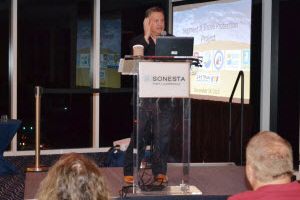 | | LAMARCA HOSTS BEACH FIX MEETING |
Upon taking the reins as Broward Beach Administrator, Nicole Sharp outlined a sea change in the County�s Shore Preservation protocols. Describing the historical �segmented� approach to beach management as �an outmoded and futile strategy,� Sharp adopted a long-term regional plan. Mindful of the accelerated rate that natural resources are degraded by climate change and rising sea levels, Sharp�s beach management program would proactively meet the growing risks while reducing the frequency and scope of future renourishments.
 Instead, occasional beach fills could address �hot spots� along a more stable County coastline. She explained, �It�s a cheaper way to put sand into the system.� Armed with Federal and State Permits that extend to 2020 and 2029, Sharp can unilaterally repair stretches of beach reduced by accelerated erosion or cyclonic weather events (hurricanes, tropical storms, etc.). She may soon realize this opportunity. Instead, occasional beach fills could address �hot spots� along a more stable County coastline. She explained, �It�s a cheaper way to put sand into the system.� Armed with Federal and State Permits that extend to 2020 and 2029, Sharp can unilaterally repair stretches of beach reduced by accelerated erosion or cyclonic weather events (hurricanes, tropical storms, etc.). She may soon realize this opportunity.
 A few days before the storm, Sharp dispatched her minions to survey the Broward coast. They returned the day after the storm, when they documented sand loss, dune impacts and �Hot Spots� crippled by acute erosion. On September 13, 2017, Sharpe sent evidence of the damage documented with photographs to the United States Army Corps of Engineers (USACE), along with a request for assistance with rehabilitating beaches widened via the county�s federal shore protection project. She plans to follow up the request with a detailed post-storm beach survey supporting the need to restore the Segment II and Segment III beaches to pre-storm conditions. A few days before the storm, Sharp dispatched her minions to survey the Broward coast. They returned the day after the storm, when they documented sand loss, dune impacts and �Hot Spots� crippled by acute erosion. On September 13, 2017, Sharpe sent evidence of the damage documented with photographs to the United States Army Corps of Engineers (USACE), along with a request for assistance with rehabilitating beaches widened via the county�s federal shore protection project. She plans to follow up the request with a detailed post-storm beach survey supporting the need to restore the Segment II and Segment III beaches to pre-storm conditions.
LaMarca Lobbies Lawmakers

 | | BROWARD COMMISSIONER CHIP LAMARCA |
As the sole Republican on the Broward Board, District 4 County Commissioner Chip LaMarca is annually charged with carrying the County�s legislative package to Republican Tallahassee, which typically includes a presentation designed to unlock resources for the next in a series of projects planned to stabilize the entire Broward shoreline. Anticipating election year chaos, lawmakers voted to schedule the 2018 legislative session a few months early. Since the 60-day span will run from January 9 through early March, the pre-session committee weeks began this fall.
 Beach projects in LaMarca�s 2018 wish list include the Port Everglades sand bypass project, which would transfer 50,000 to 80,000 cubic yards of sand annually from the north to the south side of the Port entrance channel, bridging a disruption in the littoral drift that starves South County beaches of sand. Once the inlet no longer impedes the natural southerly flow of sand along the Broward coast, the county plans to renourish the depleted South County shoreline with a $53.7 million truck haul project in 2020. Completing these projects will also realize Sharp�s vision for a stable Broward coast. Beach projects in LaMarca�s 2018 wish list include the Port Everglades sand bypass project, which would transfer 50,000 to 80,000 cubic yards of sand annually from the north to the south side of the Port entrance channel, bridging a disruption in the littoral drift that starves South County beaches of sand. Once the inlet no longer impedes the natural southerly flow of sand along the Broward coast, the county plans to renourish the depleted South County shoreline with a $53.7 million truck haul project in 2020. Completing these projects will also realize Sharp�s vision for a stable Broward coast.
By ghosting a 1998 mandate that annually delivered $30 million in documentary stamp tax funds to the Beach Management Funding Assistance Program (BMFA), lawmakers have allowed 410 miles of the State's shoreline to become critically eroded, almost half of the 825 miles of sandy beaches visited each year by millions of tourists who generate $billions for the state budget.
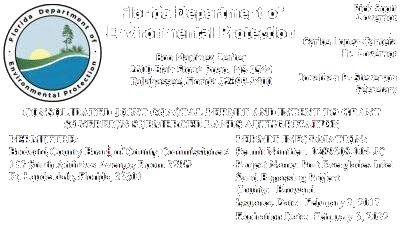 In recent years, LaMarca and Statehouse Representative George Moraitis have teamed with officials in coastal jurisdictions across Florida to replace an unworkable funding formula that has cost the State $billions in Tourism revenues. Environmental funds holstered in the Land Acquisition Trust Fund (LATF) are annually plundered by the Governor and Budget wonks to plug operational deficits � in violation of a 2014 Constitutional Amendment. The fiscal scraps are then distributed according to a skewed ranking system. In recent years, LaMarca and Statehouse Representative George Moraitis have teamed with officials in coastal jurisdictions across Florida to replace an unworkable funding formula that has cost the State $billions in Tourism revenues. Environmental funds holstered in the Land Acquisition Trust Fund (LATF) are annually plundered by the Governor and Budget wonks to plug operational deficits � in violation of a 2014 Constitutional Amendment. The fiscal scraps are then distributed according to a skewed ranking system.
FDEP Bungles Beach Wallet

 The Land Acquisition Trust Fund was supported by every Florida Administration since its 1963 inception � until Governor Rick Scott began gutting appropriations to virtually every State environmental program, and pinched off revenues to the LATF. When he quashed funding for the enforcement of safe drinking water standards, angry Florida voters approved Constitutional Amendment 1 in 2014, restoring a funding source for the State�s Land Acquisition Trust Fund that the Governor couldn�t molest. The Land Acquisition Trust Fund was supported by every Florida Administration since its 1963 inception � until Governor Rick Scott began gutting appropriations to virtually every State environmental program, and pinched off revenues to the LATF. When he quashed funding for the enforcement of safe drinking water standards, angry Florida voters approved Constitutional Amendment 1 in 2014, restoring a funding source for the State�s Land Acquisition Trust Fund that the Governor couldn�t molest.
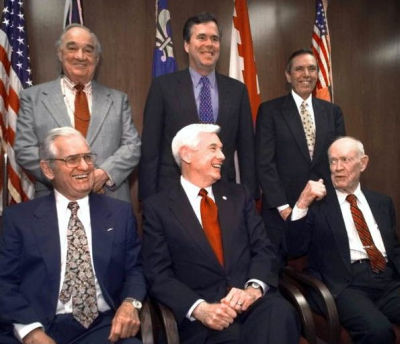 | PRO LATF GOVS CLAUDE R. KIRK, JEB BUSH, ROBERT MARTINEZ
SEATED: WAYNE MIXSON, REUBIN ASKEW AND FARRIS BRYANT |
Since Amendment 1 organized LATF as an environmental catch-all that included the aquifer, wetlands, drinking water, the Everglades, clean air, fish and wildlife habitat, rivers, lakes, beaches, forests and a panoply of other natural resources, as an unintended consequence, eroded beaches would have to compete with water quality projects, wetlands restoration, the Everglades and other environmental projects for funding. Although charged with crafting an equitable system for distributing the resources, the Florida Department of Environmental Protection (FDEP) instead devised the ranking system from hell.
 Each year, FDEP hosts an environmental smackdown for applicants in every category. To rank local beach projects for state support, FDEP assigns applicants up to 115 points among 29 criteria. In violation of its mandate, the ranking system favors big projects over smaller ones, prefers projects that receive federal money, rewards spans of beach that were previously renourished and buries communities that can�t afford to match the state allocation. Each year, FDEP hosts an environmental smackdown for applicants in every category. To rank local beach projects for state support, FDEP assigns applicants up to 115 points among 29 criteria. In violation of its mandate, the ranking system favors big projects over smaller ones, prefers projects that receive federal money, rewards spans of beach that were previously renourished and buries communities that can�t afford to match the state allocation.
 | | FDEP SAID - NO BEACH EROSION FROM HURRICANE SANDY |
FDEP is supposed to ascribe points to measure the impact of tidal erosion on a beach. When Hurricane Sandy washed out a stretch of State Road A1A in 2012, FDEP inexplicably decided the area didn�t merit points for erosion, ignoring a study by the Army Corps of Engineers that measured significant prior erosion as well as the huge volume of sand stripped away by Sandy. Incredibly, FDEP claimed the beach actually grew. �I can�t say I have a lot of confidence in how the list is produced,� said state Rep. George Moraitis (R-Fort Lauderdale). Broward Beach Administrator Nicole Sharp remarked �It�s hard to tell a city that had a road fall into the ocean that they don�t have erosion.�
 | | SENATE PRESIDENT JOE NEGRON |
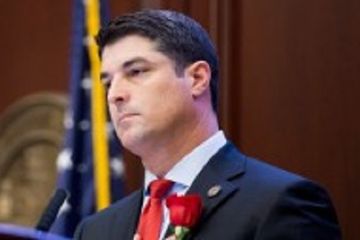 | | FORMER HOUSE SPEAKER STEVE CRISAFULLI |
The FDEP beach list also serves as a rubber duck for legislative leaders. From 2012 to 2016, $52 million of the $149.5 million that lawmakers approved for beaches went to the five counties represented by former House Speaker Steve Crisafulli (R - Merritt Island) and Senate President Joe Negron (R - Stuart). When asked if politics played a role in how he and Negron cornered one-third of the state's beach renourishment funds over four consecutive years, Crisafulli said �I wouldn�t say politics. I would say the push by local communities to lay out their case, the push by members of the Legislature to make their case.� YIKES!
Playground vs. Money Magnet

 In January 2015, the Office of Economic and Demographic Research (EDR � research arm of the Florida Legislature) released a study that focused primarily on the fiscal impact of beach renourishment. Entitled �Economic Evaluation of Florida�s Investment in Beaches�, the EDR report calculated the Return on Investment (ROI) of Beach Restoration, assessed the economic risk of disasters and concluded that beaches are the most important feature of Florida's �Brand�. During the study�s 3-year review period (covering FY 2011, 2012 and 2013), the state invested $44 million in the Beach and Management Restoration Program (roughly 30.5% of the total cost shared by Federal, State, and local sources). This investment directly increased State GDP an average $2.4 billion per year. In January 2015, the Office of Economic and Demographic Research (EDR � research arm of the Florida Legislature) released a study that focused primarily on the fiscal impact of beach renourishment. Entitled �Economic Evaluation of Florida�s Investment in Beaches�, the EDR report calculated the Return on Investment (ROI) of Beach Restoration, assessed the economic risk of disasters and concluded that beaches are the most important feature of Florida's �Brand�. During the study�s 3-year review period (covering FY 2011, 2012 and 2013), the state invested $44 million in the Beach and Management Restoration Program (roughly 30.5% of the total cost shared by Federal, State, and local sources). This investment directly increased State GDP an average $2.4 billion per year.
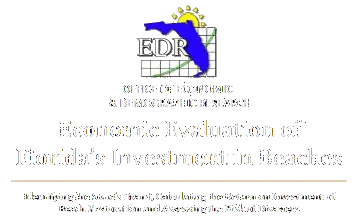 By identifying each revenue source and calculating its tax impact, the study tracked how the incremental GDP plumped state revenues by $237.9 million over the three year period. After crunching complex funding formulas to validate the raw data, the report concluded that $44 million invested in the State Beach Program �generated a positive return on investment of 5.4�, based solely on tangible financial gains or losses to state revenues. The study also uncovered another flaw in the FDEP ranking system. When calculating the economic impact on candidates for beach renourishment, the FDEP decided to omit the tax revenue they provide to a community and the State, thereby grossly understating the fiscal repercussions of neglecting beaches degraded by tidal erosion. By identifying each revenue source and calculating its tax impact, the study tracked how the incremental GDP plumped state revenues by $237.9 million over the three year period. After crunching complex funding formulas to validate the raw data, the report concluded that $44 million invested in the State Beach Program �generated a positive return on investment of 5.4�, based solely on tangible financial gains or losses to state revenues. The study also uncovered another flaw in the FDEP ranking system. When calculating the economic impact on candidates for beach renourishment, the FDEP decided to omit the tax revenue they provide to a community and the State, thereby grossly understating the fiscal repercussions of neglecting beaches degraded by tidal erosion.
 The study triggered two significant responses. Having repeatedly stripped tax dollars from Florida beaches, Governor Rick Scott suddenly asked lawmakers to approve a $50 million cash bucket for beach projects during the 2017 legislative session, doubling the negligible $25 million he proposed in each of the past four years. Secondly, lawmakers who were historically recalcitrant about subsidizing beach neighborhoods enthusiastically approved a beach funding boost once their in-house bean counters monetized the investment�s windfall dividend. The study triggered two significant responses. Having repeatedly stripped tax dollars from Florida beaches, Governor Rick Scott suddenly asked lawmakers to approve a $50 million cash bucket for beach projects during the 2017 legislative session, doubling the negligible $25 million he proposed in each of the past four years. Secondly, lawmakers who were historically recalcitrant about subsidizing beach neighborhoods enthusiastically approved a beach funding boost once their in-house bean counters monetized the investment�s windfall dividend.
Beach Funding Bill � Round I

 | | CHIP LAMARCA & REP. GEORGE MORAITIS |
 | | FSBPA PRESIDENT DEBBIE FLACK |
During the 2017 legislative session, LaMarca headed to Tallahassee with President Debbie Flack of the Florida Shore & Beach Preservation Association to once again lobby lawmakers to create a reliable funding source for beach projects. In order to file the relevant legislation, they met with Statehouse Representatives George Moraitis (R � Fort Lauderdale), Evan Jenne (D � Dania Beach), Broward Commissioner Steve Geller's brother Joe Geller (D � Aventura) - and other members of the County�s legislative delegation. Soliciting support for the proposed legislation, when they distributed copies of the EDR study to their peers, even inland lawmakers who disparage beach funds as coastal pork reversed course, and agreed to support reliable funding for beach and inlet cost-sharing projects.
 | | SENATOR JACK LATVALA |
 In the Senate, they had an ally in Chairman Jack Latvala (R-Clearwater) of the Senate Appropriations Committee, who said that he considers increasing annual beach funding to at least $50 million �a top priority�. Latvala said, �There is no doubt in my mind the impact of beaches on our Florida economy. They kind of define Florida. I mean, who goes to Texas to go to the beach?� On March 3, 2017, Latvala filed Senate Bill 1590, which would revise how Florida prioritizes beach and inlet projects while annually cloistering $50 million in the Land Acquisition Trust Fund to rehabilitate eroded beaches. In the Senate, they had an ally in Chairman Jack Latvala (R-Clearwater) of the Senate Appropriations Committee, who said that he considers increasing annual beach funding to at least $50 million �a top priority�. Latvala said, �There is no doubt in my mind the impact of beaches on our Florida economy. They kind of define Florida. I mean, who goes to Texas to go to the beach?� On March 3, 2017, Latvala filed Senate Bill 1590, which would revise how Florida prioritizes beach and inlet projects while annually cloistering $50 million in the Land Acquisition Trust Fund to rehabilitate eroded beaches.
On March 3, 2017, Representatives George Moraitis (R � Fort Lauderdale), Bill Hagar (R � Delray Beach), and Kathleen M. Peters (R � Treasure Island) co-filed the companion bill � House Bill 1213. On April 27, 2017, the full Senate unanimously approved Latvala's bill (37 Yeas vs. 0 Nays) before sending it to the House for consideration. After unanimously sailing through two of its three vetting committees, Moraitis' House Bill was throttled on the calendar while awaiting a hearing by the House Government Accountability Committee, where it died.
Beach Funding Bill � Round II

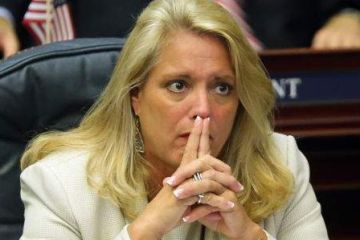 | | REPRESENTATIVE KATHLEEN M. PETERS |
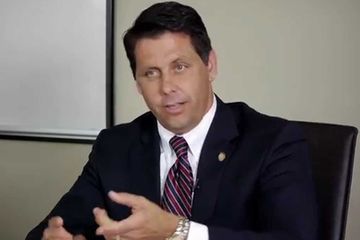 | | REPRESENTATIVE GEORGE MORAITIS |
During the Committee weeks prior to the early 2018 session, an undeterred Latvala refiled his legislation as Senate bill 174 on August 18, 2017. On October 9, it was unanimously approved in the Committee on Environmental Preservation and Conservation by 10 Yeas vs. 0 Nays. On October 25, it was unanimously found favorable by 7 Yeas vs. 0 Nays in the Appropriations Subcommittee on the Environment and Natural Resources and forwarded to its final committee stop - the Committee on Appropriations, which Latvala Chairs. In the Statehouse, Representatives George Moraitis and Kathleen M. Peters filed companion House Bill 131 on September 1, 2017.
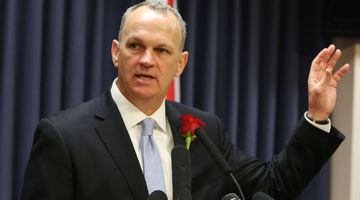 | | HOUSE SPEAKER RICHARD CORCORAN |
In assessing the bills� prospects, Latvala admonished that the legislation�s fate was in the hands of the powerful new House Speaker Richard Corcoran, exclaiming �I think there's a lot of people would like to see it passed. If (House Speaker) Richard Corcoran heeds the requests he gets, they will get it done. Or if we don�t get it done, he�ll be responsible.� With Corcoran�s recent ascendance, a substantial number of House votes have devolved into knee-jerk formalities.
In addition to $50 million in annual funding and a reasonable ranking system, Latvala said the bills will implement a three-year planning process that would enable communities to schedule these projects rather than what he called the year-to-year �grab bag� they face now. Since Nicole Sharp is sitting on long-term Federal and State cost-sharing agreements, this final piece of the puzzle should clear the way for a Segment II hot spot hunt at her discretion, which should make you smile.

Click To Top of Page


 | | SEGMENT II - GALT MILE BEACH REPLENISHED |
April 25, 2017 - The recently completed Segment II beach renourishment capped an 18-year struggle to salvage our shrinking beach. For many Galt Mile residents, nearly two decades of crushing disappointments replaced enthusiastic support for the project with a thinly veiled rage. When construction vehicles rolled into north Broward beachfront staging sites on January 4, 2016, the mind-numbing frustration began melting away.
Although virtually every Galt Mile resident and visitor is delighted with their reclaimed beach, few have forgotten nearly twenty years of bureaucratic abuse, an ordeal that provided hundreds of local residents with first-hand insight into the structural consequences of tidal erosion. While watching the new sand migrate south along the coast, many are understandably apprehensive about County intentions to maintain their newly widened beach � without revisiting the dilatory state and Federal regulatory meat grinders.
To this end, Broward beach boss Nicole Sharp is overhauling the County�s Beach maintenance protocols, while Broward Commissioner Chip LaMarca and Statehouse Representative George Moraitis probe a more reliable funding source in Tallahassee. For the benefit of recent arrivals to our neighborhood � some background...
Myers Picks Up the Promise

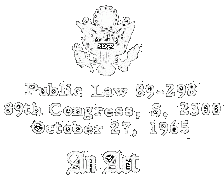 In 1965, the 89th U.S. Congress authorized funding to fortify Broward�s shrinking beaches (Section 301 of Public Law 89-298, October 27, 1965). Twenty years ago, former Broward Beach Administrator Stephen Higgins complied with the Congressional intent by designing the Broward County Shore Protection Project. In 1965, the 89th U.S. Congress authorized funding to fortify Broward�s shrinking beaches (Section 301 of Public Law 89-298, October 27, 1965). Twenty years ago, former Broward Beach Administrator Stephen Higgins complied with the Congressional intent by designing the Broward County Shore Protection Project.
 | | FORMER BROWARD BEACH ADMINISTRATOR STEVE HIGGINS |
After beating back unprecedented regulatory obstacles for 14 years, Higgins rehabilitated the Segment III South County beaches in 2005 and was preparing to fix the county�s Segment II northern shoreline. When Higgins retired in 2011 amid relentless bickering among Segment II stakeholders, it was mistakenly construed as the project�s death knell. A few weeks later, when Higgin's former boss - Eric Myers � asked Galt Mile officials if they would help revive the Segment II beach fix, they placed him on an upcoming meeting agenda.
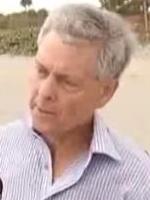 | BROWARD BEACH
ADMINISTRATOR ERIC MYERS |
At a February 7, 2011 Presidents Council meeting in Coral Ridge Towers (Original), Myers announced his intention to reorganize the dormant project. The project�s recovery hinged on two contingencies, a recrafted plan that eliminated the most egregious regulatory obstacles and unilateral cooperation by coastal jurisdictions and beachfront homeowners. A few months later, when Myers pitched the Segment II Beach renourishment at the May 17, 2011 Fort Lauderdale City Commission meeting, Commissioner Bruce Roberts backed his play.
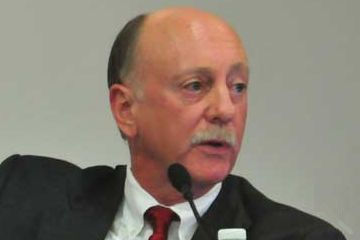 | | COMMISSIONER BRUCE ROBERTS |
Roberts told the Commission that Galt Mile residents � whose staunch project advocacy was grounded in the belief that a healthy beach was critical to the protection of beach neighborhoods, the area�s economy, and the lives of their families � have been waiting since 1998 for the County to make good on promises to renourish the Segment II beaches. As the newly appointed Broward Beach Administrator, Myers spent the next three years convincing stakeholder jurisdictions to merge their political capitol just long enough to accomplish this shared objective.
Dancing for Dollars

 | | BROWARD COMMISSIONER CHIP LAMARCA |
With the backing of Fort Lauderdale, Pompano Beach and Lauderdale-by-the-Sea, Myers recruited Chip LaMarca and headed to the State Capitol. After two years of dismantling bureaucratic opposition in Tallahassee, when Myers retired and passed the baton to Nicole Sharp, the fight moved to Washington DC.
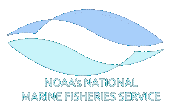 After a year of battling with the National Marine Fisheries Service (NOAA Fisheries) and an unresponsive Commerce Department, the Army Corps of Engineers Civil Works Committee finally gave Sharp the green light to negotiate Interlocal Agreements with Segment II Stakeholders and draft a Project Participation Agreement (PPA) that detailed the shared Federal, State and local fiscal obligations. After a year of battling with the National Marine Fisheries Service (NOAA Fisheries) and an unresponsive Commerce Department, the Army Corps of Engineers Civil Works Committee finally gave Sharp the green light to negotiate Interlocal Agreements with Segment II Stakeholders and draft a Project Participation Agreement (PPA) that detailed the shared Federal, State and local fiscal obligations.
 Once the project was farmed out, the PPA became a reimbursement blueprint - a Hefty Bag of open-ended promissory obligations. Funds laid out by the County on behalf of stakeholders were technically secured by the PPA. However, given the County�s skeletal leverage in Tallahassee and Washington DC, County officials are forced to discretely beg the respective funding agencies to loosen the State and Federal purse strings. The slow-moving Feds still haven�t reduced their $30 million Segment II obligation. Although Tallahassee already kicked in its $11.4 million share of Segment II, the County is still seeking $87,860 to monitor the beach fill�s impact on nearby coral reefs. Once the project was farmed out, the PPA became a reimbursement blueprint - a Hefty Bag of open-ended promissory obligations. Funds laid out by the County on behalf of stakeholders were technically secured by the PPA. However, given the County�s skeletal leverage in Tallahassee and Washington DC, County officials are forced to discretely beg the respective funding agencies to loosen the State and Federal purse strings. The slow-moving Feds still haven�t reduced their $30 million Segment II obligation. Although Tallahassee already kicked in its $11.4 million share of Segment II, the County is still seeking $87,860 to monitor the beach fill�s impact on nearby coral reefs.
 Since the County is also preparing to fund a long-awaited $19.2 million sand bypass at Port Everglades, wherein migrating sand accumulating on the north side of the Port�s entrance channel is trucked to sand-starved beaches in Hollywood, Hallandale and Dania, Broward bean counters plan to roll over funds due on the Segment II renourishment while tweaking the current legislative session for additional beach revenues. Since the County is also preparing to fund a long-awaited $19.2 million sand bypass at Port Everglades, wherein migrating sand accumulating on the north side of the Port�s entrance channel is trucked to sand-starved beaches in Hollywood, Hallandale and Dania, Broward bean counters plan to roll over funds due on the Segment II renourishment while tweaking the current legislative session for additional beach revenues.
 | | Beautiful Broward Beaches Thank You Photo Shoot |
Hoping to cajole the county�s State and Federal funding �partners� into paying their Segment II debt without dampening their predisposition to future projects, LaMarca decided to disguise a dunning notice as a love letter. Recruiting political beefcake from stakeholder jurisdictions (District 3 Broward Commissioner Michael Udine, Mayor Jack Seiler and Vice Mayor Bruce Roberts from Fort Lauderdale, Vice Mayor Mark Brown from Lauderdale-by-the-Sea, etc.), Broward officials merged an invoice and a supplication for future funding with a customized �Thank You� card � an aerial beach graphic generated at LaMarca�s March 4th �photo op�.
 LaMarca�s blended message also housed a request for a reliable funding source for beach projects that fuel the State�s tourism economy. LaMarca�s planned photo op was hatched in late February; about the same time that Governor Rick Scott asked lawmakers to approve a proposed $50 million cash bucket for beach projects, doubling the negligible $25 million he proposed in each of the past four years. Although the allocation is the largest proposed by Scott since he took office, it�s a pittance when compared to the resources needed to rescue more than 410 miles of Florida�s critically eroded coast. LaMarca�s blended message also housed a request for a reliable funding source for beach projects that fuel the State�s tourism economy. LaMarca�s planned photo op was hatched in late February; about the same time that Governor Rick Scott asked lawmakers to approve a proposed $50 million cash bucket for beach projects, doubling the negligible $25 million he proposed in each of the past four years. Although the allocation is the largest proposed by Scott since he took office, it�s a pittance when compared to the resources needed to rescue more than 410 miles of Florida�s critically eroded coast.
The Trust Fund Rollercoaster

 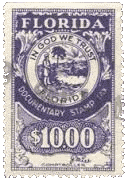 Created by the Florida Legislature in 1963 to offset damage by commercial polluters and urban creep, the Land Acquisition Trust Fund (LATF) was designed to fund the purchase of recreation and conservation lands that would otherwise fall prey to overdevelopment. Since the original funding mechanism, a five percent tax on outdoor clothing and equipment (like bathing suits), proved wildly unpopular with tourists (disparaged as the �bathing suit tax�), it was abandoned in 1968, when the legislature opted to fund LATF through the sale of recreation bonds paid for by a documentary stamp tax on real estate transactions and financial documents (i.e., mortgages and other loans, stocks, bonds, etc.). Created by the Florida Legislature in 1963 to offset damage by commercial polluters and urban creep, the Land Acquisition Trust Fund (LATF) was designed to fund the purchase of recreation and conservation lands that would otherwise fall prey to overdevelopment. Since the original funding mechanism, a five percent tax on outdoor clothing and equipment (like bathing suits), proved wildly unpopular with tourists (disparaged as the �bathing suit tax�), it was abandoned in 1968, when the legislature opted to fund LATF through the sale of recreation bonds paid for by a documentary stamp tax on real estate transactions and financial documents (i.e., mortgages and other loans, stocks, bonds, etc.).
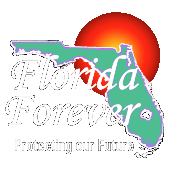 Having shifted the cost from the residents and visitors who benefit from conservation, to the polluters and developers who threatened the State�s natural resources, lawmakers would later adapt the income stream into a recurring funding mechanism for the 1979 Conservation and Recreation Lands (CARL) Program, and the 1999 Florida Forever Program, a conservation catch-all for natural resources. Since the parent legislation also mandated management of acquired conservation lands, a spectrum of management programs were developed to oversee compliance with environmental objectives. Trust funds were established to reverse ecological damage, either by polluters, encroaching development, or Mother Nature (as in the case of tidal erosion). Having shifted the cost from the residents and visitors who benefit from conservation, to the polluters and developers who threatened the State�s natural resources, lawmakers would later adapt the income stream into a recurring funding mechanism for the 1979 Conservation and Recreation Lands (CARL) Program, and the 1999 Florida Forever Program, a conservation catch-all for natural resources. Since the parent legislation also mandated management of acquired conservation lands, a spectrum of management programs were developed to oversee compliance with environmental objectives. Trust funds were established to reverse ecological damage, either by polluters, encroaching development, or Mother Nature (as in the case of tidal erosion).
 | PRO LATF GOVS CLAUDE R. KIRK, JEB BUSH, ROBERT MARTINEZ
SEATED: WAYNE MIXSON, REUBIN ASKEW AND FARRIS BRYANT |
In 1998, Florida lawmakers dedicated a portion of the Ecosystem Management and Restoration Trust Fund to restore the critically eroded coast. Funded by the documentary stamp tax, $30 million was annually allocated to the Beach Management Funding Assistance (BMFA) Program � for cost-sharing projects matched by federal and local contributions
 To safeguard an environmental legacy that fuels critical tourism revenues, the Land Acquisition Trust Fund was supported by every Florida Administration since its 1963 inception � until Governor Rick Scott took office in 2011. To balance the budget, Governor Scott annually gutted appropriations to virtually every State environmental program, including the enforcement of safe drinking water standards. Angry Florida voters approved Constitutional Amendment 1 in 2014, reinstating a funding source for the State�s Land Acquisition Trust Fund. To safeguard an environmental legacy that fuels critical tourism revenues, the Land Acquisition Trust Fund was supported by every Florida Administration since its 1963 inception � until Governor Rick Scott took office in 2011. To balance the budget, Governor Scott annually gutted appropriations to virtually every State environmental program, including the enforcement of safe drinking water standards. Angry Florida voters approved Constitutional Amendment 1 in 2014, reinstating a funding source for the State�s Land Acquisition Trust Fund.
 Although the fund was originally created to manage and restore natural systems while enhancing public access and recreational use of conservation lands � LATF conservation projects would now include the aquifer, wetlands, drinking water, the Everglades, clean air, fish and wildlife habitat, rivers, lakes, beaches, forests and a panoply of other natural resources. As an unintended consequence of Amendment 1, eroded beaches would have to compete with water quality projects, wetlands restoration, the Everglades and other environmental projects for funding. Although the fund was originally created to manage and restore natural systems while enhancing public access and recreational use of conservation lands � LATF conservation projects would now include the aquifer, wetlands, drinking water, the Everglades, clean air, fish and wildlife habitat, rivers, lakes, beaches, forests and a panoply of other natural resources. As an unintended consequence of Amendment 1, eroded beaches would have to compete with water quality projects, wetlands restoration, the Everglades and other environmental projects for funding.
EDR Study May Turn the Tables

Of the $50 million in beach revenues proposed by Scott, only $10 million would be annually disbursed from the trust fund. Since the remaining $40 million would come from general revenue, it is a one-time allocation. Jurisdictions would still need an annual source of State revenues for beach and inlet cost-sharing projects.
 As the sole Republican on the Broward Board, LaMarca is annually charged with carrying the County�s legislative wish list to Republican Tallahassee, which typically included a beach funding presentation that addressed its impact on tourism and the threat posed by storm surge to people and property. Last year, LaMarca bulked up his arsenal with a January 2015 study by the Office of Economic and Demographic Research (EDR � research arm of the Florida Legislature). As the sole Republican on the Broward Board, LaMarca is annually charged with carrying the County�s legislative wish list to Republican Tallahassee, which typically included a beach funding presentation that addressed its impact on tourism and the threat posed by storm surge to people and property. Last year, LaMarca bulked up his arsenal with a January 2015 study by the Office of Economic and Demographic Research (EDR � research arm of the Florida Legislature).
 Entitled �Economic Evaluation of Florida�s Investment in Beaches�, the EDR report calculated the Return on Investment (ROI) of Beach Restoration, assessed the economic risk of disasters and concluded that beaches are the most important feature of Florida's �Brand�. During the study�s 3-year review period (covering FY 2011, 2012 and 2013), the state invested $44 million in the Beach and Management Restoration Program (roughly 30.5% of the total cost shared by Federal, State, and local sources). This investment directly increased State GDP an average $2.4 billion per year. Entitled �Economic Evaluation of Florida�s Investment in Beaches�, the EDR report calculated the Return on Investment (ROI) of Beach Restoration, assessed the economic risk of disasters and concluded that beaches are the most important feature of Florida's �Brand�. During the study�s 3-year review period (covering FY 2011, 2012 and 2013), the state invested $44 million in the Beach and Management Restoration Program (roughly 30.5% of the total cost shared by Federal, State, and local sources). This investment directly increased State GDP an average $2.4 billion per year.
 By identifying each revenue source and calculating its tax impact, the study tracks how the incremental GDP plumped state revenues by $237.9 million over the three year period. After crunching complex funding formulas to validate the raw data, the report concluded that $44 million invested in the State Beach Program �generated a positive return on investment of 5.4�, based solely on tangible financial gains or losses to state revenues. Since in-state tourism was not included in the analysis, the actual ROI exceeds 5.4. Apparently, it worked. Even inland lawmakers who disparage beach funds as coastal pork were intrigued. In the 2017 legislative session, lawmakers filed bills that could reinstate reliable funding for beach and inlet cost-sharing projects. By identifying each revenue source and calculating its tax impact, the study tracks how the incremental GDP plumped state revenues by $237.9 million over the three year period. After crunching complex funding formulas to validate the raw data, the report concluded that $44 million invested in the State Beach Program �generated a positive return on investment of 5.4�, based solely on tangible financial gains or losses to state revenues. Since in-state tourism was not included in the analysis, the actual ROI exceeds 5.4. Apparently, it worked. Even inland lawmakers who disparage beach funds as coastal pork were intrigued. In the 2017 legislative session, lawmakers filed bills that could reinstate reliable funding for beach and inlet cost-sharing projects.
Legislating a New Beach Wallet


 | | FSBPA PRESIDENT DEBBIE FLACK |
Snatching the Photo and a legislative wish list, LaMarca headed to Tallahassee with President Debbie Flack of the Florida Shore & Beach Preservation Association to lobby lawmakers for a dedicated funding source for beach projects. In order to file the required legislation, they would meet with Statehouse Representatives George Moraitis (R � Fort Lauderdale), Evan Jenne (D � Dania Beach), Broward Commissioner Steve Geller's brother Joe Geller (D � Aventura) - and other members of the County�s legislative delegation.
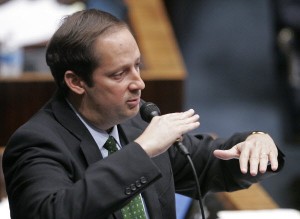 | | SENATOR JOE NEGRON |
In the Senate, they had an ally in Chairman Jack Latvala (R-Clearwater) of the Senate Appropriations Committee, who said that he considers increasing beach funding to at least $50 million �a top priority�. Although one-third of the annual stamp tax revenues were constitutionally allocated to LATF for conservation - less the debt sevice on specified environmental bonds (Florida Forever bonds, Everglades restoration bonds, etc.), budget wonks pilfered $millions for general expenses. In 2016, as polluted discharges from Lake Okeechobee triggered a state of emergency in Martin, St. Lucie and Lee counties, and Brown Tides caused a fish die-off in Brevard County, incoming Senate President Joe Negron spearheaded efforts to protect the water supply by filing legislation entitled "The Legacy Florida Act". Lawmakers enacted companion legislation in the other chamber House Bill 989, creating ch. 2016-201, Laws of Florida), which annually dedicates $200 million for Everglades restoration and $50 million for Florida springs. Beach fills and inlet sand by-passing would have to slug it out with scores of other environmental projects for funding table scraps.
 | | SENATOR JACK LATVALA |
On March 3, 2017, Latvala filed Senate Bill 1590, which revises how Florida prioritizes beach and inlet projects, and annually dedicates $50 million from the Land Acquisition Trust Fund to rehabilitate eroded beaches. On March 22, Latvala�s bill was unanimously approved by the Senate Committee on Environmental Preservation and Conservation (7 Yeas vs. 0 Nays). On April 13, it was unanimously approved by the Senate Appropriations Subcommittee on the Environment and Natural Resources (6 Yeas vs. 0 Nays). On April 20, the bill cruised to a 16 Yeas vs. 0 Nays approval in its final vetting committee - the Senate Committee on Appropriations - which Latvala chairs - before being sent to the floor for a vote by the full Senate. On April 27, 2017, the Senate unanimously approved the bill (37 Yeas vs. 0 Nays) before sending it to the House for consideration.
 | | REPRESENTATIVE GEORGE MORAITIS |
The companion bill, House Bill 1213, was filed by Representatives George Moraitis (R � Fort Lauderdale), Bill Hagar (R � Delray Beach), and Kathleen M. Peters (R � Treasure Island) on March 3, 2017. On March 20, it was unanimously approved by the House Natural Resources & Public Lands Subcommittee (15 Yeas vs. 0 Nays) and voted favorably by the House Agriculture & Natural Resources Appropriations Subcommittee on March 28 (14 Yeas vs. 0 Nays). The bill is currently under review by the House Government Accountability Committee, its final House Committee stop.
The beach bills have excellent prospects for enactment, and lame duck Governor Scott seems to have reversed his tenure-long aversion to salvaging the State�s natural resources, having indicated his support for a more stable source of beach funding. That said, Scott's desk is always a crap shoot.
Two More Turns at the Sand Bank

 At a December 16, 2015 pre-project public meeting in the Sonesta Hotel, when Galt Mile officials inquired about maintaining the beach after it was renourished, Broward Beach Administrator Nicole Sharp outlined a sea change in the County�s Shore Preservation protocols. Describing the historical �segmented� approach to beach management as �an anachronistic exercise in futility,� Sharp adopted a long-term regional plan. Mindful of the accelerated rate that natural resources are degraded by climate change and rising sea levels, Sharp�s beach management program proactively meets the growing risks. At a December 16, 2015 pre-project public meeting in the Sonesta Hotel, when Galt Mile officials inquired about maintaining the beach after it was renourished, Broward Beach Administrator Nicole Sharp outlined a sea change in the County�s Shore Preservation protocols. Describing the historical �segmented� approach to beach management as �an anachronistic exercise in futility,� Sharp adopted a long-term regional plan. Mindful of the accelerated rate that natural resources are degraded by climate change and rising sea levels, Sharp�s beach management program proactively meets the growing risks.
 The Port Everglades sand bypass should help stabilize the south county beaches. Sand that ordinarily migrates south along the coast collects at the north side of the Port Everglades inlet (adjacent to Point of Americas), where 85% is lost seaward to tidal erosion. As a result, when sand placed along south county beaches during the 2005 Segment III renourishment drifted south into Miami-Dade County, it was never replenished by sand migrating south from beaches in Fort Lauderdale and points north. The Port Everglades sand bypass should help stabilize the south county beaches. Sand that ordinarily migrates south along the coast collects at the north side of the Port Everglades inlet (adjacent to Point of Americas), where 85% is lost seaward to tidal erosion. As a result, when sand placed along south county beaches during the 2005 Segment III renourishment drifted south into Miami-Dade County, it was never replenished by sand migrating south from beaches in Fort Lauderdale and points north.
 | | PORT EVERGLADES INLET |
Within five years, south county beaches lost two-thirds of the sand received in 2005, as the ocean once again laps against Hollywood, Hallandale and Dania Beach seawalls. To preserve the $billions they generate in tourism revenues, and resurrect storm surge protection for infrastructure and inhabitants, a second Segment III renourishment is being planned. After installation of the Port Everglades Sand Bypass restores the coastal flow of sand that will naturally replenish those beaches, a $53.7 million truck haul project will salvage the depleted shoreline in 2020.
The Port Everglades sand bypass project would transfer 50,000 to 80,000 cubic yards of sand annually from the north to the south side of the Port entrance channel, restoring the currently disrupted littoral drift. It entails constructing an offshore sand trap to collect alongshore migrating sand for transport to the south side of the inlet. When adjacent Point of Americas residents opposed blasting the sea bottom, the plan was redesigned by raising the lower elevation above the hard rock and widening the trap to maintain sufficient storage capacity.
 | | HILLSBORO BBEACH INLET |
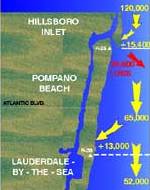 Just as the Port Everglades inlet impedes the flow of sand to South Broward beaches, sand migrating south from beaches in South Palm Beach and Deerfield would be blocked by the Hillsboro Inlet if not for the Hillsboro Beach Sand Bypass. A special taxing district created in 1957 oversees an FDEP management plan to perform regular maintenance dredging of the inlet�s navigational channel and sand bypassing to beaches downdrift of the inlet. Following expansion of the exterior inlet channel and sand trap in 2003, the District acquired a new hydraulic cutterhead dredge in 2008 to facilitate in-house maintenance. Without the Hillsboro Inlet sand bypass, newly expanded beaches in Pompano, L-B-T-S, the Galt Mile and Fort Lauderdale would also be back to square one within 5 years. Instead, approximately 120,000 cubic yards of sand will be transferred annually to replenish our Segment II beaches. Just as the Port Everglades inlet impedes the flow of sand to South Broward beaches, sand migrating south from beaches in South Palm Beach and Deerfield would be blocked by the Hillsboro Inlet if not for the Hillsboro Beach Sand Bypass. A special taxing district created in 1957 oversees an FDEP management plan to perform regular maintenance dredging of the inlet�s navigational channel and sand bypassing to beaches downdrift of the inlet. Following expansion of the exterior inlet channel and sand trap in 2003, the District acquired a new hydraulic cutterhead dredge in 2008 to facilitate in-house maintenance. Without the Hillsboro Inlet sand bypass, newly expanded beaches in Pompano, L-B-T-S, the Galt Mile and Fort Lauderdale would also be back to square one within 5 years. Instead, approximately 120,000 cubic yards of sand will be transferred annually to replenish our Segment II beaches.
Tweaking Hot Spots

 | BROWARD NATURAL RESOURCE
ADMINISTRATOR NICOLE SHARP |
Sharp outlined how re-establishing the natural southerly flow of sand along the coast would also substantially reduce the frequency and scope of future renourishments, explaining, �It�s a cheaper way to put sand into the system on the southern beaches.� Instead, occasional beach fills could address �hot spots� along a more stable County coastline. Armed with Federal and State Permits that extend to 2020 and 2029, Sharp can unilaterally repair stretches of beach reduced by accelerated erosion or cyclonic weather events. Federal, State and local parties to the cost-sharing agreements ultimately fund these projects with tax revenues. Taken together with the new energy-absorbing dune system crested with sea oats, Sharp�s stabilization plan to triage emerging �hot spots� with a few truckloads of sand would save taxpayers $hundreds of millions over the next decade.
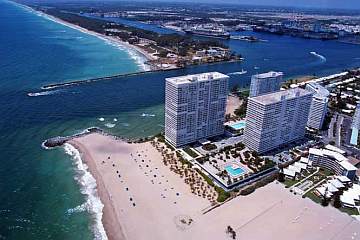 | | PORT EVERGLADES ENTRANCE CHANNEL |
The sand bypass was originally proposed by former Broward beach Guru Stephen Higgins, who observed �Unless the entire Broward coast is treated and maintained like a single structural entity, this project will fail. The stability of every segment depends on the stability of its adjacent segments.� In 2014, Eric Myers remarked �Every big deep-water inlet is a huge barrier to the drift of sand along the East Coast. It really starves beaches to the south.�
Myers� observation begs the question, �Why didn�t they first build the sand bypass at Port Everglades,� as Higgins� recommended? Since Point of Americas is home to some of the region�s �Masters of the Universe�, when they hinted to the Fort Lauderdale City Commission that the project would disrupt their Karma, the Sand Bypass was DOA. 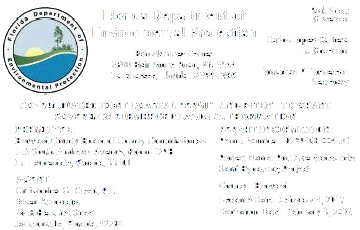 City officials shrugged off a threatened County legal action, until Myers later explained �Had we built the sand bypass at Port Everglades, beaches in South Broward County would still be healthy.� adding that Fort Lauderdale�s decision will cost taxpayers another $50 million. The City Commission sucked it up and relented, as long as the Segment II project preceded the bypass. After once again crawling through Tallahassee�s regulatory sewage dump, FDEP finally granted Sharp State Permit 0289308-004-JC on February 3, 2017, authorizing the elusive Port Everglades Sand Bypass. City officials shrugged off a threatened County legal action, until Myers later explained �Had we built the sand bypass at Port Everglades, beaches in South Broward County would still be healthy.� adding that Fort Lauderdale�s decision will cost taxpayers another $50 million. The City Commission sucked it up and relented, as long as the Segment II project preceded the bypass. After once again crawling through Tallahassee�s regulatory sewage dump, FDEP finally granted Sharp State Permit 0289308-004-JC on February 3, 2017, authorizing the elusive Port Everglades Sand Bypass.
If enacted, the new legislation will help facilitate Sharp�s plan. However, the bills could still wind up in the cornfield. Until Scott pockets his veto pen a few weeks after Sine Die, anything goes. For the endgame... clock in next month.

Click To Top of Page


 | | SEGMENT II - L'HERMITAGE BEACH REPLENISHED |
February 18, 2016 - When a brigade of construction vehicles rolled across Broward County on January 4, a time-hardened layer of skepticism was pealed from the Galt Mile - like a rancid Band-Aid. After seventeen years of rain-dancing in Tallahassee, Congressional foot-dragging and gridlock in Washington DC and nearly two decades of broken promises by Broward officials, back-hoe excavators, bulldozers, front end loaders and off-road trucks descended on several beachfront staging areas along the North Broward coast. The equipment belongs to bid-winning contractor Bernie Eastman, proprietor of Eastman Aggregate Enterprises. Having recently fleshed out 5 miles of beach in Lauderdale-by-the-Sea (LBTS), Eastman�s intimate familiarity with the Broward shoreline proved an insurmountable advantage during the October 2015 Segment II bidding process.
 | | SEGMENT II - 12 STREET IN POMPANO |
Of Broward County�s 24 miles of sandy beaches, 21.3 miles were originally declared �critically eroded� by the Coastal Engineering Section of the Florida Department of Environmental Protection (FDEP). Nearly half of these depleted beaches were replenished during the South Broward Segment III project completed in March of 2006, when 1.7 million cubic yards of sand dredged offshore Deerfield Beach was deposited along 6.2 miles of the 8.1-mile span from the Dade County line to John U. Lloyd Beach State Park. As originally conceived, the Segment II project was anticipated to do the same for 10 miles of North Broward beaches, adding 935,000 cubic yards of sand to the County shoreline from Hillsboro Inlet to just north of Port Everglades. The plan was scrapped after Hurricane Sandy.
 For years, beach and port projects underwritten by the Army Corps of Engineers (ACOE) were frozen as Congress played partisan political ping pong with the Water Resources Reform and Development Act, a multi-$Billion pork-fest and funding Pi�ata for the nation's ports, inland waterways and beaches. When Sandy turned picturesque East Coast cities and towns into post-apocalyptic wastelands, ACOE scooted around the Congressional shell game. For years, beach and port projects underwritten by the Army Corps of Engineers (ACOE) were frozen as Congress played partisan political ping pong with the Water Resources Reform and Development Act, a multi-$Billion pork-fest and funding Pi�ata for the nation's ports, inland waterways and beaches. When Sandy turned picturesque East Coast cities and towns into post-apocalyptic wastelands, ACOE scooted around the Congressional shell game.
 | | LBTS NEAR COMMERCIAL BOULEVARD |
To restore eligible East Coast beaches pulverized by Hurricane Sandy, the Corps triggered its Flood Control and Coastal Emergency program (FCCE) authorized by Public Law 84-99 (PL 84-99), which empowers the Corps to directly provide disaster relief on its own authority. Along with scores of Northeastern coastal communities, Lauderdale-by-the-Sea jumped on the FCCE bandwagon, severing dependence on the County�s then tenuous Segment II beach fix. From November 2013 through February 28, 2014, Corps contractor Eastman Aggregate Enterprises trucked 126,700 cubic yards of beach quality sand from the E.R. Jahan Ortona sand mine in Moore Haven to Lauderdale-by-the-Sea, where it was dispersed along 5.1 miles of eroded shoreline.
 | | SEGMENT II PLAN PROJECT LIMITS |
LBTS was no longer dependent on Segment II sand. Also, the ten miles of north county coast originally planned for renourishment was reduced by half. Instead of buying 935,000 cubic yards of sand, the remaining 4.9 miles of eroded beach would only require 750,000 cubic yards of sand. What remains of the Segment II project are two stretches of beach. About 170,000 cubic yards of sand is currently being spread along the 1.4 mile northern reach, which begins at SE 4th Street in Pompano Beach and extends south, ending about 700 feet into Lauderdale-by-the-Sea (behind the Ocean Colony Condominium). The longer 3.6 mile span from Commercial Boulevard - across the Galt Mile - to Terramar Street in Fort Lauderdale, will receive 550,000 cubic yards of sand.
 On January 4, the Broward Segment II project was launched from beachfront staging sites in each of the three municipalities. In Pompano Beach, Eastman cloistered a crew at SE 12th Street. For two weeks, beach fill operations moved north to SE 4th Street, after which the contractor turned south. Construction is expected to reach to the Ocean Colony Condominium in Lauderdale-by-the-Sea by late April. On January 4, the Broward Segment II project was launched from beachfront staging sites in each of the three municipalities. In Pompano Beach, Eastman cloistered a crew at SE 12th Street. For two weeks, beach fill operations moved north to SE 4th Street, after which the contractor turned south. Construction is expected to reach to the Ocean Colony Condominium in Lauderdale-by-the-Sea by late April.
 | | LBTS - PALM AVENUE STAGING AREA |
Another crew assembled at Palm Avenue in Lauderdale-by-the-Sea and initially headed north along the beach. After a few days (before reaching Commercial Boulevard), it turned south toward Galt Ocean Mile. A week later, construction along the Galt Mile Beach had proceeded past Plaza South.
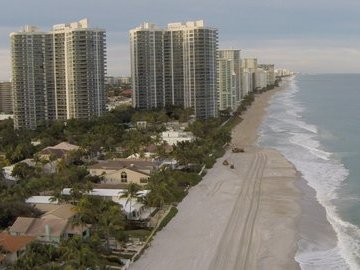 | | BEACH FILL SOUTH OF L'HERMITAGE |
In Fort Lauderdale, a third staging area was located just south of the Galt Mile at Vista Park in Lauderdale Beach. Moving north, Eastman�s crew built out the beach areas behind L�Hermitage and Southpoint within a few weeks. In pressing fill operations from two different directions, project planners hope to complete construction along the Galt Mile beach by the end of March (before Sea Turtle nesting season suspends the project), as Eastman�s converging crews are expected to meet behind either Playa del Mar, The Regency Tower or Galt Ocean Club.
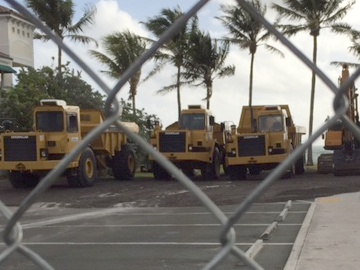 | | CONSTRUCTION VEHICLES AT VISTA PARK |
Following completion of the Galt Mile beach fill in late March, the staging areas will be vacated as Eastman�s crews move to NE 18th Street in Fort Lauderdale, a staging site for the southernmost project segment. After continuing operations through the end of April, Eastman will pack it in until Sea Turtle Nesting Season ends in November, when the crews will reoccupy the SE 18th Street staging area, along with a second launch point on Sunrise Boulevard. Nine to ten weeks later, the final curtain comes down on the Segment II project.
 At a December 16 public meeting convened by project planners at the Sonesta Hotel. Broward Beach Administrator Nicole Sharp, project contractor Bernie Eastman, and Broward Commissioner Chip LaMarca reviewed stakeholder concerns and invited questions from attending association officials and homeowners. Concerned about how their respective beaches would be impacted by the project, some Association officials asked about the size and location of dunes and how existing vegetation would be integrated with new flora. At a December 16 public meeting convened by project planners at the Sonesta Hotel. Broward Beach Administrator Nicole Sharp, project contractor Bernie Eastman, and Broward Commissioner Chip LaMarca reviewed stakeholder concerns and invited questions from attending association officials and homeowners. Concerned about how their respective beaches would be impacted by the project, some Association officials asked about the size and location of dunes and how existing vegetation would be integrated with new flora.
 | | LAMARCA HOSTS BEACH FIX MEETING |
 | BROWARD NATURAL RESOURCE
ADMINISTRATOR NICOLE SHARP |
Although Sharp had explained that areas allocated to dune restoration or vegetation would be balanced with adequate recreational space, homeowners inquired about how this would specifically apply to their respective beaches. More importantly, they wanted to know when each beach would be overrun by construction. Unable to accurately address inquiries about the existing condition of individual association beaches, Sharp invited attendees to contact her at [email protected].
 | | BEACHFRONT GALT MILE ASSOCIATIONS |
Over the next month, while Sharp visited a few associations that contacted her to discuss project issues, she still lacked a reliable vehicle for addressing the concerns of all 23 beachfront associations. Since she had no way of determining exactly when the contractor�s crews would arrive at each association beach, she was also stymied by inquiries into when the construction would impair beach access for each association�s homeowners and visitors.
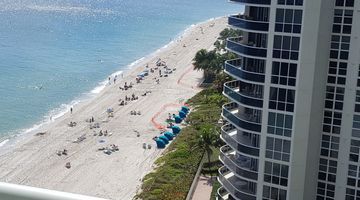 | | BEACH FILL BEHIND L'HERMITAGE |
After the January 21, 2016 Advisory Board meeting, Galt Mile officials and Sharp explored whether pictures of the beach adjacent to each association might assist with responding to these inquiries. To facilitate this option, L�Hermitage Advisory Board member Len Sanders offered a helicopter for snapping aerial shots of each beach. Forwarded to member associations on January 30, some of the resulting photographs provided a useful basis for discussing how to best balance dunes and vegetation with recreational space, although others did not. Also, Sharp was still unable to predict construction progress with sufficient specificity to provide association officials with a credible operational timetable.
 Sharp had informed Galt Mile officials that a scheduling conflict precluded her attending the February 1 Presidents Council meeting at Plaza South. Standing in for the Broward Beach Administrator was Beach Program Specialist Greg Ward, who works hand in glove with Sharp on Segment II issues. An official County contact for Beach Renourishment inquiries, Ward was instrumental in creating the Beach Project presentation at the December 16 introductory meeting, where these issues were first raised by association officials. Sharp had informed Galt Mile officials that a scheduling conflict precluded her attending the February 1 Presidents Council meeting at Plaza South. Standing in for the Broward Beach Administrator was Beach Program Specialist Greg Ward, who works hand in glove with Sharp on Segment II issues. An official County contact for Beach Renourishment inquiries, Ward was instrumental in creating the Beach Project presentation at the December 16 introductory meeting, where these issues were first raised by association officials.
 Following his introduction, Ward informed the Presidents Council that each association would be contacted shortly before the contractor rolls across its beach, thereby providing its officials with an opportunity to impact how their dunes and vegetation are configured. As such, association officials could only provide their members with a loosely estimated timetable until they receive the call from County planners. A few days before construction is planned for each property, the administration can provide unit owners with a more reliable start date. Following his introduction, Ward informed the Presidents Council that each association would be contacted shortly before the contractor rolls across its beach, thereby providing its officials with an opportunity to impact how their dunes and vegetation are configured. As such, association officials could only provide their members with a loosely estimated timetable until they receive the call from County planners. A few days before construction is planned for each property, the administration can provide unit owners with a more reliable start date.
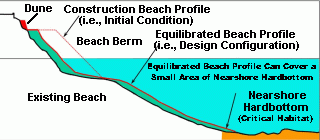 Addressing a security concern posed by Galt Mile officials, Ward explained that dunes needn�t be placed adjacent to a seawall, where they might be abused as springboards for trespassers. Speaking to fearful rumors about an 11-foot high mountain of sand blocking access to the beach, Ward assured attendees that the dune heights were modest and mildly graded (the State Permit defines a vertical/horizontal ratio of 1:2, yielding a gradient of about 26.5 degrees). When an association official observed that even modest-sized dunes might present an access impediment to elderly beachgoers, Ward described how dunes can be configured in a manner that doesn�t impair beach access, such as carving a downward slope toward the beach egress to provide a level pass-through. Addressing a security concern posed by Galt Mile officials, Ward explained that dunes needn�t be placed adjacent to a seawall, where they might be abused as springboards for trespassers. Speaking to fearful rumors about an 11-foot high mountain of sand blocking access to the beach, Ward assured attendees that the dune heights were modest and mildly graded (the State Permit defines a vertical/horizontal ratio of 1:2, yielding a gradient of about 26.5 degrees). When an association official observed that even modest-sized dunes might present an access impediment to elderly beachgoers, Ward described how dunes can be configured in a manner that doesn�t impair beach access, such as carving a downward slope toward the beach egress to provide a level pass-through.
Although Ward�s plan falls short of providing the kind of reliable notice that association officials and unit owners would have preferred, it does give associations a hand in shaping their beaches. Also, if fill operations continue to move at the current pace, beachfront Galt Mile Associations may be out of the woods by the end of March, ending our neighborhood�s twenty-year tenure as a regulatory pincushion. More to come...

Click To Top of Page


 | | SEGMENT II BROWARD BEACH PLAN ROLLS OUT |
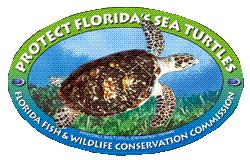 December 22, 2015 - For the past year, Galt Mile residents have been repeatedly assured that the Segment II beach renourishment would begin following the November conclusion of Sea Turtle nesting season. It didn�t. For some veteran Galt Mile residents, two decades of crushing disappointments replaced enthusiastic support for the project with a numbing cynicism � on a hair trigger. After 20 years of flimsy excuses, foot-dragging and bald faced lies, the delay was perceived as evidence that the project would once again be derailed. December 22, 2015 - For the past year, Galt Mile residents have been repeatedly assured that the Segment II beach renourishment would begin following the November conclusion of Sea Turtle nesting season. It didn�t. For some veteran Galt Mile residents, two decades of crushing disappointments replaced enthusiastic support for the project with a numbing cynicism � on a hair trigger. After 20 years of flimsy excuses, foot-dragging and bald faced lies, the delay was perceived as evidence that the project would once again be derailed.
The passionate blowback by frustrated residents wasn�t unreasonable, considering how protection of $4 billion in upland property � and the lives of our families � may ride on this project. Only a healthy beach can shield a coastal population from catastrophic storm surge. Also at stake are three local economies, a regional economy and a large slice of the State�s tax pie.
 Fortunately, the missed deadline didn�t veil another bureaucratic shell game, just the delays that ordinarily belabor complex infrastructure projects. To begin with, County and City officials will not casually forgo $41 million of federal & State sugar allocated to the $56 million project. Also, planners finally have their ducks in a row. After years of Congressional gridlock and partisan bickering, Congress restored the Army Corps of Engineers� lapsed funding for ports, waterways and beaches in the Water Resources Development Act of 2013. Fortunately, the missed deadline didn�t veil another bureaucratic shell game, just the delays that ordinarily belabor complex infrastructure projects. To begin with, County and City officials will not casually forgo $41 million of federal & State sugar allocated to the $56 million project. Also, planners finally have their ducks in a row. After years of Congressional gridlock and partisan bickering, Congress restored the Army Corps of Engineers� lapsed funding for ports, waterways and beaches in the Water Resources Development Act of 2013.
Pulling Permits

 Although Tallahassee loosened renourishment resources, before it could nail State funding, Broward had to revise the Segment II sand source to circumvent the regulatory obstacles that impair dredge projects. After negotiating project terms with the Florida Department of Environmental Protection (FDEP) throughout 2013, Broward beach officials landed State Permit Number 0314535-001-JC on January 31, 2014. Although Tallahassee loosened renourishment resources, before it could nail State funding, Broward had to revise the Segment II sand source to circumvent the regulatory obstacles that impair dredge projects. After negotiating project terms with the Florida Department of Environmental Protection (FDEP) throughout 2013, Broward beach officials landed State Permit Number 0314535-001-JC on January 31, 2014.
 | | JACKSONVILLE DISTRICT COMMANDER COL. ALAN M. DODD |
In 2014, the Federal permit process stumbled when a foot-dragging bureaucrat in NOAA Fisheries withheld an opinion letter required by the Army Corps of Engineers (ACOE). With the help of Corps officials from the Palm Beach Gardens Regulatory office, Broward beach boss Nicole Sharp secured the opinion letter and completed the remaining Permit requirements by April of 2015. A few days later, ACOE District Commander Colonel Alan Dodd issued Federal Permit Number SAJ-1999-05545(SP-GGL) in Jacksonville.
Parties to the Pacts

 | | SEGMENT II PLAN PROJECT LIMITS |
Since County officials were hard-pressed to complete project preparations before the anticipated late autumn 2015 start date, they simultaneously entered into cost-sharing talks with the Corps and the three municipal stakeholders � the City of Pompano Beach, the Town of Lauderdale-by-the-Sea and the City of Fort Lauderdale. The County began drafting a Project Participation Agreement (PPA) in April, which details the parties� project costs, responsibilities and objectives, and specifies how the County will meet environmental and financial benchmarks.
The pact also legally obligates the Corps to a negotiated cost-sharing formula. Since vendor agreements are subject to terms spelled out in the PPA, it had to be executed before the County could contract with prospective vendors. Any vendor agreements entered into by the County prior to official execution of the PPA (before it was signed by the Assistant Secretary of the Army) would be ineligible for federal reimbursement.
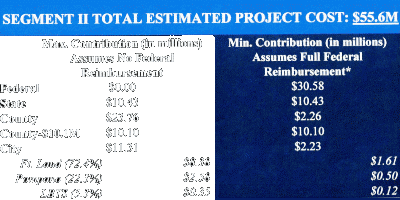 County PPA negotiations with ACOE would also determine how the County and cities budgeted for the $55.6 million project, although it would proceed whether or not the Feds chipped in the 55% ($30.58 million) reimbursable under a 2014 Limited Reevaluation Report. The State of Florida had already committed $10.43 million to the project, a healthy chunk of the non-federal share. Incremental to their regular share, the County also donated $10.1 million recently collected from the City of Hollywood for a previous project. Of that amount, the County credited 33% to help the cities meet their obligations while the remaining 67% was applied to the County�s costs. Since the remaining balance would be shared by the County and the three municipalities (on a 67% - 33% basis) with or without the Federal contribution, in July the County sent each municipality funding estimates for both scenarios. County PPA negotiations with ACOE would also determine how the County and cities budgeted for the $55.6 million project, although it would proceed whether or not the Feds chipped in the 55% ($30.58 million) reimbursable under a 2014 Limited Reevaluation Report. The State of Florida had already committed $10.43 million to the project, a healthy chunk of the non-federal share. Incremental to their regular share, the County also donated $10.1 million recently collected from the City of Hollywood for a previous project. Of that amount, the County credited 33% to help the cities meet their obligations while the remaining 67% was applied to the County�s costs. Since the remaining balance would be shared by the County and the three municipalities (on a 67% - 33% basis) with or without the Federal contribution, in July the County sent each municipality funding estimates for both scenarios.
 Without the $30.58 million in Federal funds, the County�s 67% share would come to $23.76 million, while the 33% due from the three municipalities would total $11.31 million. If the Feds signed the PPA and shouldered 55% of the $55.6 million project cost, the County share would drop to $2.26 million while the cities would collectively pay $2.23 million. The percentage cost to the municipalities is based on the volume of sand added to their respective beaches - 72.4% for Fort Lauderdale, 22.3% for Pompano Beach and 5.3% for Lauderdale-by-the-Sea (LBTS). However, if the LBTS share exceeded $350,000, the County agreed to make up the difference. As such, the projected costs to each municipality (with and without Federal Funds), were $1.61 - $8.38 million for Fort Lauderdale, $500K - $2.58 million for Pompano Beach and $120K - $350K for Lauderdale-by-the-Sea. Without the $30.58 million in Federal funds, the County�s 67% share would come to $23.76 million, while the 33% due from the three municipalities would total $11.31 million. If the Feds signed the PPA and shouldered 55% of the $55.6 million project cost, the County share would drop to $2.26 million while the cities would collectively pay $2.23 million. The percentage cost to the municipalities is based on the volume of sand added to their respective beaches - 72.4% for Fort Lauderdale, 22.3% for Pompano Beach and 5.3% for Lauderdale-by-the-Sea (LBTS). However, if the LBTS share exceeded $350,000, the County agreed to make up the difference. As such, the projected costs to each municipality (with and without Federal Funds), were $1.61 - $8.38 million for Fort Lauderdale, $500K - $2.58 million for Pompano Beach and $120K - $350K for Lauderdale-by-the-Sea.
2013 LBTS Beach Fix

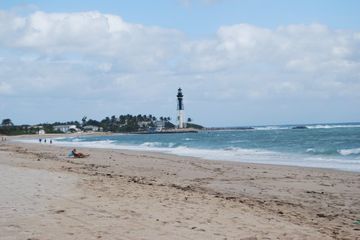 | | SOUTH POMPANO BEACH |
The LBTS cost cap was not a by-product of politically prompted preferential treatment. In 2013, the Army Corps of Engineers approved an LBTS emergency beach fill under its Flood Control and Coastal Emergency program (FCCE) authorized by Public Law 84-99 (PL 84-99), which empowers the Corps to directly provide disaster relief on its own authority, and was implemented to fortify eligible East Coast beaches shredded by Hurricane Sandy. The Corps approved reconstructing 5.1 miles of eroded shoreline in south Pompano Beach and LBTS.
 | | LBTS NEAR COMMERCIAL BOULEVARD |
In November 2013, Corps contractor Eastman Aggregate Enterprises began trucking 126,700 cubic yards of beach quality sand 106 miles from the E.R. Jahan Ortona sand mine in Moore Haven to Pompano and Lauderdale-by-the-Sea beaches. An average of 130 trucks per day made the two-hour trip from the mine to LBTS staging areas, where the sand was delivered for dispersal along the beach. Completed on February 28, 2014 (before the March 1st commencement of Sea Turtle nesting season), the project required about 10,000 deliveries.
 | | LBTS BEACH FIX |
Although the newly fleshed out LBTS beaches had little need for Segment II sand, the town�s shoreline served to connect beaches in Pompano and Fort Lauderdale that were targeted for renourishment. To structurally integrate the coast along all three north Broward municipalities, the County solicited town permission to taper the LBTS shoreline adjacent to beaches in Pompano and Fort Lauderdale that were planned to receive sand. Since the sand was being placed on LBTS beaches solely to stabilize newly renourished adjacent beaches in Pompano and Fort Lauderdale, the County agreed to limit the town�s financial exposure.
Bidding the Project

 As Sharp and ACOE negotiated the PPA cost-sharing terms, each of the three municipalities set about executing Interlocal Agreements (ILA) with the County. The ILAs detailed the parties� respective financial and regulatory responsibilities. On October 6, the County placed the Segment II project out to bid (on Bidsync), citing November 6 as the closing date for beach fill services and artificial reef construction vendor proposals. By starting the bidding process prior to execution of the PPA, County Beach officials would be ready to roll once the PPA was signed, avoiding delays due to vendor scheduling conflicts. As Sharp and ACOE negotiated the PPA cost-sharing terms, each of the three municipalities set about executing Interlocal Agreements (ILA) with the County. The ILAs detailed the parties� respective financial and regulatory responsibilities. On October 6, the County placed the Segment II project out to bid (on Bidsync), citing November 6 as the closing date for beach fill services and artificial reef construction vendor proposals. By starting the bidding process prior to execution of the PPA, County Beach officials would be ready to roll once the PPA was signed, avoiding delays due to vendor scheduling conflicts.
 In soliciting vendor proposals, the County split the project into two groups; the northern beach fill segment in Pompano Beach and part of LBTS was Group 1 and the southern segment for the rest of LBTS and Fort Lauderdale was bid out as Group 2. Dividing the project would allow each segment to move forward independently. By the November 6 deadline, bids were received from Eastman Aggregate Enterprises (the vendor selected by the Corps two years earlier for the emergency LBTS beach fill), MCM Construction, Phillips and Jordan, Inc., Ranger Construction Inc., and an incomplete proposal was filed by the Rio-Bak Corporation. In soliciting vendor proposals, the County split the project into two groups; the northern beach fill segment in Pompano Beach and part of LBTS was Group 1 and the southern segment for the rest of LBTS and Fort Lauderdale was bid out as Group 2. Dividing the project would allow each segment to move forward independently. By the November 6 deadline, bids were received from Eastman Aggregate Enterprises (the vendor selected by the Corps two years earlier for the emergency LBTS beach fill), MCM Construction, Phillips and Jordan, Inc., Ranger Construction Inc., and an incomplete proposal was filed by the Rio-Bak Corporation.
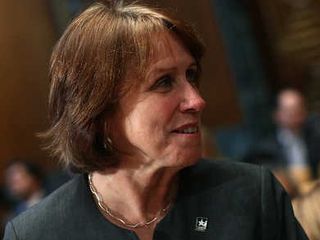 | | ASSISTANT SECRETARY JO-ELLEN DARCY |
On October 9, an elated Commissioner LaMarca notified the neighborhood association �The US Army Corps of Engineers has agreed to the financial terms of our project and they are in the process of signing off on the federal participation of 55% of the total project.� Later that day, Broward Beach boss Nicole Sharp cautioned that although the County had completed negotiating the terms of the Project Partnership Agreement (PPA); until it was signed by Assistant Secretary of the Army Jo-Ellen Darcy - projected for early November � it carried no legal weight.
Fort Lauderdale Balks


 | | CITY MANAGER LEE FELDMAN |
While addressing Galt Mile officials at the October 5th Presidents Council meeting at Ocean Club condominium, City Manager Lee Feldman enumerated City concerns with the draft ILA received from the County. Citing an unfair funding ratio, potential conflicts with City projects (i.e. Auberge, etc.) and prospective future liability for obligations not clearly defined in the agreement, Feldman also intimated that the County deliberately sent the draft ILA shortly before the projected November start date as a negotiating tactic, suggesting that the abbreviated time frame was meant to pressure City concessions to questionable pact provisions.
 | | COMMISSIONER BRUCE ROBERTS |
Having weathered decades of indefensible project postponements, when angry members inveighed against additional bureaucratic delays as intolerable and heatedly suggested that the City quickly settle any contract impediments, Commissioner Roberts and Feldman assured attendees that the obstacles were being addressed and would soon be resolved. After Feldman�s full list of Fort Lauderdale exceptions to the draft ILA was received by the County, a detailed response was returned by County Administrator Bertha Henry on October 30. City and County officials agreed to meet and hash out any remaining differences.
 Following the November 6 bid deadline, the $37,016,422.42 proposal submitted by low-bidder Eastern Aggregate Enterprises was �Recommended for Award� (RFA) by the County and placed on the Purchasing Division website for 5 business days for public review. Since no comments or protests were filed, the County was cleared to enter into a federally reimbursable contract with the Lake Worth-based vendor as soon as the PPA was signed by the Corps. Following the November 6 bid deadline, the $37,016,422.42 proposal submitted by low-bidder Eastern Aggregate Enterprises was �Recommended for Award� (RFA) by the County and placed on the Purchasing Division website for 5 business days for public review. Since no comments or protests were filed, the County was cleared to enter into a federally reimbursable contract with the Lake Worth-based vendor as soon as the PPA was signed by the Corps.
 On Monday, November 9, the Corps finally delivered a signed and executed PPA to exuberant County Beach officials, equipping the Federal cost-sharing commitment with legal teeth. The next day, the Pompano Beach City Commission passed a resolution approving their ILA with the County. Also on November 10th, the County Commission empowered Broward Administrator Bertha Henry to execute agreements integral to the Segment II renourishment, including the municipal ILAs, the PPA and the vendor agreement (Eastern Aggregates). On Monday, November 9, the Corps finally delivered a signed and executed PPA to exuberant County Beach officials, equipping the Federal cost-sharing commitment with legal teeth. The next day, the Pompano Beach City Commission passed a resolution approving their ILA with the County. Also on November 10th, the County Commission empowered Broward Administrator Bertha Henry to execute agreements integral to the Segment II renourishment, including the municipal ILAs, the PPA and the vendor agreement (Eastern Aggregates).
 Suddenly, a lawsuit was filed naming Sea Turtles as plaintiffs, whose right to peaceful enjoyment would be violated by a beach fill project, and named as defendants any entity with project standing, including the participating jurisdictions, their agencies, beachfront homeowners and the Galt Mile Community Association. Ironically, environmentalists and environmental agencies staunchly support salvaging severely eroded nesting habitat for endangered Sea Turtles and foraging habitat for scores of threatened species like the Piping Plover, as documented in the Army Corps� Final Environmental Impact Statement. The Broward Commission had also pumped up environmental protection for the project, adding $3,364,078 to their existing $11,155,077 contract with Nova Southeastern University for Segment II reef building and Biological Monitoring. Suddenly, a lawsuit was filed naming Sea Turtles as plaintiffs, whose right to peaceful enjoyment would be violated by a beach fill project, and named as defendants any entity with project standing, including the participating jurisdictions, their agencies, beachfront homeowners and the Galt Mile Community Association. Ironically, environmentalists and environmental agencies staunchly support salvaging severely eroded nesting habitat for endangered Sea Turtles and foraging habitat for scores of threatened species like the Piping Plover, as documented in the Army Corps� Final Environmental Impact Statement. The Broward Commission had also pumped up environmental protection for the project, adding $3,364,078 to their existing $11,155,077 contract with Nova Southeastern University for Segment II reef building and Biological Monitoring.
 While responsible legal actions occasionally improve a beach project, frivolous lawsuits are designed as a �Hail Mary� deterrent. In the past, project impediments were the brainchildren of lobbyists funded by the Scuba Industry (beach projects temporarily disrupt their members� offshore business venue), self-appointed environmental radicals hoping to return the barrier island to a pristine state by ejecting human beings, failed attorneys exploring a new practice field or a disgruntled resident with a personal agenda. While responsible legal actions occasionally improve a beach project, frivolous lawsuits are designed as a �Hail Mary� deterrent. In the past, project impediments were the brainchildren of lobbyists funded by the Scuba Industry (beach projects temporarily disrupt their members� offshore business venue), self-appointed environmental radicals hoping to return the barrier island to a pristine state by ejecting human beings, failed attorneys exploring a new practice field or a disgruntled resident with a personal agenda.
 On November 12, City and County staff met to negotiate final terms of the Fort Lauderdale beach project ILA with Broward County. Acknowledging that the City will receive 550,000 of the 750,000 cubic yards of sand placed on Segment II beaches, the City agreed to pay 72.4% of the $2.23 million still due from the three municipalities after the Federal, State and County contributions. Fort Lauderdale�s $1.61 million share is payable in three annual installments of less than $540,000. On November 12, City and County staff met to negotiate final terms of the Fort Lauderdale beach project ILA with Broward County. Acknowledging that the City will receive 550,000 of the 750,000 cubic yards of sand placed on Segment II beaches, the City agreed to pay 72.4% of the $2.23 million still due from the three municipalities after the Federal, State and County contributions. Fort Lauderdale�s $1.61 million share is payable in three annual installments of less than $540,000.
 | | COUNTY ADMINISTRATOR BERTHA HENRY |
Since Bertha Henry had already addressed Feldman�s more substantive concerns, most of the remaining items were less than earthshaking. For example, for cities to remain vested in future federally reimbursable beach projects, instead of coughing up �a minimum of 10%,� the County will retain a flat 10%. Also, if the City drives up costs by submitting a change order to the contract, instead of the County unilaterally deciding how much the City must pay, the cost �will be mutually determined by County and City.�
 While a few other tweaks were approved, the City did wangle a valuable �most favored� clause. In short, beach renourishment benefits or terms granted by the County to any Broward municipality would also accrue to Fort Lauderdale. Specifically, any financially preferable changes to the cost-sharing formula for the impending Segment III renourishment of South County beaches would be retroactively applied to Fort Lauderdale�s portion of Segment II. While a few other tweaks were approved, the City did wangle a valuable �most favored� clause. In short, beach renourishment benefits or terms granted by the County to any Broward municipality would also accrue to Fort Lauderdale. Specifically, any financially preferable changes to the cost-sharing formula for the impending Segment III renourishment of South County beaches would be retroactively applied to Fort Lauderdale�s portion of Segment II.
 Having hammered out bumpy provisions in the County pact, on December 1st, the City Commission passed a resolution approving the ILA with Broward County for the Segment II Shore Protection Project. Fort Lauderdale was officially on board. With contracts between the County and all three municipalities in hand, vendor Eastern Aggregates could finally begin drafting a schedule for delivering sand to the staging areas. Having hammered out bumpy provisions in the County pact, on December 1st, the City Commission passed a resolution approving the ILA with Broward County for the Segment II Shore Protection Project. Fort Lauderdale was officially on board. With contracts between the County and all three municipalities in hand, vendor Eastern Aggregates could finally begin drafting a schedule for delivering sand to the staging areas.
County Announces Kick-Off

 | | BROWARD COMMISSIONER CHIP LAMARCA |
On December 10, Lamarca notified Galt Mile officials that the vendor, while coordinating with the sand mines, would commence sand placement surveys on Monday, December 14. On December 11, LaMarca sent an email blast to stakeholders, announcing a 6 p.m. project presentation by Eastern Aggregates at the Sonesta Hotel (999 Fort Lauderdale Beach Boulevard) on Wednesday, December 16.
 | BROWARD NATURAL RESOURCE
ADMINISTRATOR NICOLE SHARP |
To host the meeting, LaMarca and Nicole Sharp were joined by contractor Bernie Eastman, founder and President of Eastern Aggregate Enterprises. Representatives from most of the Galt Mile beachfront associations attended the meeting with two major objectives. In addition to confirming the project start date, they sought to learn exactly when the construction team would flesh out the stretch of beach behind their respective properties, and how long it would impair member access to the beach.
 After announcing that the project would begin on Monday, January 4, 2016, Sharp did a two-step around the second query. She said that construction progress would be posted on the Broward County Beach Renourishment web page, and invited interested parties to first check the current location of the construction and then calculate how long it would take to reach their stretch of beach. After reading the perplexed faces in the audience, she suddenly blurted, �Please call or email me with questions that specifically relate to your beach.� After announcing that the project would begin on Monday, January 4, 2016, Sharp did a two-step around the second query. She said that construction progress would be posted on the Broward County Beach Renourishment web page, and invited interested parties to first check the current location of the construction and then calculate how long it would take to reach their stretch of beach. After reading the perplexed faces in the audience, she suddenly blurted, �Please call or email me with questions that specifically relate to your beach.�
Mining Sand


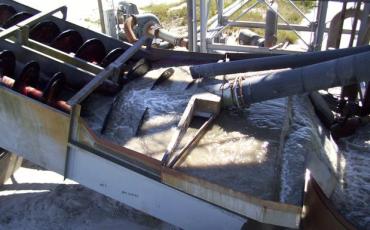 | | SAND PROCESSED AT ORTONA MINE |
According to Sharp, 750.000 cubic yards of sand harvested from the Ortona Sand Mine in La Belle, Florida (Glades County), an upland commercial mine north and northwest of Broward County, will be trucked 125 miles to Fort Lauderdale. Owned by E.R. Jahna Industries, Inc., a dredge sucks sand from the bottom of an artificial lake, filters out pebbles, extracts water, removes silt or clay and sorts the sand by grain size.
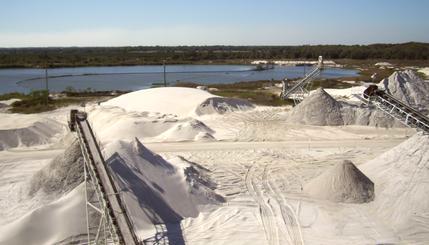 | | YELLOW SAND FROM ORTONA'S MAN-MADE LAKE |
This light yellow silica sand selected for the project typically has a larger average grain size and a smaller fines fraction than material found in offshore borrow areas. Due primarily to its imperceptibly larger grain size, the sand is more stable and produces less post placement turbidity in the nearshore environment. Originally deposited 5 million years ago when the shoreline ran up the spine of the state, it also more closely matches the color of our native beach sediments than the grey sand dredged from offshore borrow sites.
 The construction methodology for renourishing a beach using mined sand is significantly different from using sand dredged offshore. The sand must be delivered to the beach by truck, stockpiled, transferred to off-road equipment, and placed mechanically on the beach. Traffic on regional thoroughfares and local streets along the route will be temporarily affected by the hauling and placement of material during the construction process. The project will also require several accessible and sufficiently sized dedicated staging areas for the delivery, handling, transfer and temporary stockpiling of sand material. The construction methodology for renourishing a beach using mined sand is significantly different from using sand dredged offshore. The sand must be delivered to the beach by truck, stockpiled, transferred to off-road equipment, and placed mechanically on the beach. Traffic on regional thoroughfares and local streets along the route will be temporarily affected by the hauling and placement of material during the construction process. The project will also require several accessible and sufficiently sized dedicated staging areas for the delivery, handling, transfer and temporary stockpiling of sand material.
Staging Areas: Lockhart and the Beaches

 | | LOCKHART STADIUM - HOME OF THE STRIKERS |
To allay regulatory concerns about the variability of materials at the source, and enforce Quality Assurance and Quality Control (QA/QC) protocols throughout the construction period, Sharp explained that the trucks filled with sand will first stop at Lockhart Stadium, home field of the Fort Lauderdale Strikers of the North American Soccer League. Located at 1350 NW 55th Street (next to Fort Lauderdale Stadium and Executive Airport), Lockhart will serve as an initial staging area. When a truck rolls in, after a sample of the sand cargo is tested for consistency and compliance with project standards, the truck will be directed to one of 5 beachfront staging areas.
 | | SAND TRUCKED TO LOCKHART STAGING AREA |
Each day, trucks will make 120 trips from the mine to the staging areas, collectively carrying 2500 tons of sand. In Pompano, sand will be delivered to a beachfront staging site at SE 12th Street, and be dispersed along the beach north of the staging area. In Lauderdale-by-the-Sea, sand will be trucked to the beach at Palm Avenue, and offloaded by conveyer belt to the staging area. The beachfront staging areas in Fort Lauderdale are at Vista Park in Lauderdale Beach, NE 18th Street and E. Sunrise Boulevard. Here�s the bad news.
 Due to regulatory delays that shifted the project start date from November 1 to January 4, 2016, there isn�t sufficient time to complete the entire project before the onset of Sea Turtle Nesting Season, when State Law will temporarily freeze construction. Work along various segments will continue through mid-March or late April. Sharp observed that while the smaller northern project area will likely be completed before the regulatory deadline, the larger southern project limits will not. The Eastman crews will roll their equipment back to the company�s Lake Worth Headquarters until they return to southern staging sites (NE 18th Street and E. Sunrise Boulevard) and complete the beach fill after the October 31 conclusion of Sea Turtle Nesting Season. Due to regulatory delays that shifted the project start date from November 1 to January 4, 2016, there isn�t sufficient time to complete the entire project before the onset of Sea Turtle Nesting Season, when State Law will temporarily freeze construction. Work along various segments will continue through mid-March or late April. Sharp observed that while the smaller northern project area will likely be completed before the regulatory deadline, the larger southern project limits will not. The Eastman crews will roll their equipment back to the company�s Lake Worth Headquarters until they return to southern staging sites (NE 18th Street and E. Sunrise Boulevard) and complete the beach fill after the October 31 conclusion of Sea Turtle Nesting Season.
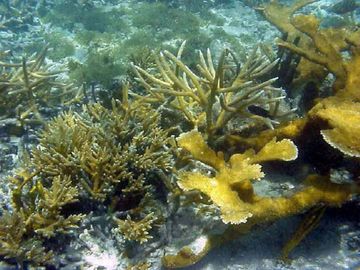 | | ELKHORN AND STAGHORN CORALS |
In Fort Lauderdale, beaches will be widened from 70 to 240 feet. Questioned why the project only included beaches north of Terramar Street in Fort Lauderdale, Sharp cited the need to protect fragile offshore coral beds just south of the project limits. Sharp explained that as construction proceeded along the coast, for the most part, it would not interfere with direct access to the beach from beachfront associations. In cases where the project impeded direct access, since the construction sites are anticipated to be roughly a few hundred feet in length, signs would direct unit owners around the roped off work sites to the beach.
 Since dune building is integral to stabilizing the coast, association officials inquired about the planned size, shape and placement of these structural buffers against tidal erosion. Dunes also mute storm surge damage by helping to absorb the energy created by storm waves. When asked if dunes might serve as obstacles for elderly beachgoers, Sharp assured attendees that the mild elevations wouldn�t block access. However, dunes located adjacent to a seawall create security concerns, as they would be abused as springboards for trespassers. Since dune building is integral to stabilizing the coast, association officials inquired about the planned size, shape and placement of these structural buffers against tidal erosion. Dunes also mute storm surge damage by helping to absorb the energy created by storm waves. When asked if dunes might serve as obstacles for elderly beachgoers, Sharp assured attendees that the mild elevations wouldn�t block access. However, dunes located adjacent to a seawall create security concerns, as they would be abused as springboards for trespassers.
 | PLAZA EAST PRESIDENT
GLENN ROLLO |
 Attendees also asked about beach vegetation, another project component included to blunt erosion. Describing how plants provided by the North Port-based Earth Balance Nursery will help protect the beach, Sharp said that beach grasses and other beach vegetation block the wind, as their roots grab the sand. At an earlier Presidents Council meeting, Plaza East President Glenn Rollo told sharp that the adjacent beach is paper thin, and observed that if the added sand were covered by dunes or vegetation, little or no room would be left for beachgoers. Attendees also asked about beach vegetation, another project component included to blunt erosion. Describing how plants provided by the North Port-based Earth Balance Nursery will help protect the beach, Sharp said that beach grasses and other beach vegetation block the wind, as their roots grab the sand. At an earlier Presidents Council meeting, Plaza East President Glenn Rollo told sharp that the adjacent beach is paper thin, and observed that if the added sand were covered by dunes or vegetation, little or no room would be left for beachgoers.
 Sharp assured Rollo that areas allocated to dune restoration or vegetation would be balanced with adequate recreational space. When an association official asked how existing beach vegetation would be preserved or integrated with new plantings, Sharp noted that questions about existing vegetation or prospective dune placement on a specific stretch of beach are more productively addressed individually with the property owner. In closing, she invited attendees to contact her with their concerns at [email protected] Sharp assured Rollo that areas allocated to dune restoration or vegetation would be balanced with adequate recreational space. When an association official asked how existing beach vegetation would be preserved or integrated with new plantings, Sharp noted that questions about existing vegetation or prospective dune placement on a specific stretch of beach are more productively addressed individually with the property owner. In closing, she invited attendees to contact her with their concerns at [email protected]
 After almost 20 years, this dog learned to hunt. Although we have never been so close to salvaging the beach, longtime Galt Mile residents will tell you, �Until I feel the sand in my toes, I don�t believe a word of this.� When the construction progress page is uploaded to the Broward County website, we will notify member associations about the construction schedule. Of course, every association can reach out to Nicole Sharp, and get the info directly from the Broward Beach boss. Punctuating her departure from the December 16 presentation, an incredulous Galt Mile official commented �Pinch me; sand is finally on the way.� After almost 20 years, this dog learned to hunt. Although we have never been so close to salvaging the beach, longtime Galt Mile residents will tell you, �Until I feel the sand in my toes, I don�t believe a word of this.� When the construction progress page is uploaded to the Broward County website, we will notify member associations about the construction schedule. Of course, every association can reach out to Nicole Sharp, and get the info directly from the Broward Beach boss. Punctuating her departure from the December 16 presentation, an incredulous Galt Mile official commented �Pinch me; sand is finally on the way.�
Broward Beach Renourishment Links

  At the meeting, Nicole Sharp said that the project could be tracked from the Broward County Beach Renousishment website, where the County Natural Resources staff plans to post current info about the project and its progress. The following links will help shed some light on the project, its environmental and fiscal impact, and how construction proceeds across the project limits. At the meeting, Nicole Sharp said that the project could be tracked from the Broward County Beach Renousishment website, where the County Natural Resources staff plans to post current info about the project and its progress. The following links will help shed some light on the project, its environmental and fiscal impact, and how construction proceeds across the project limits.
 CLICK HERE to the Broward County Beach Renousishment website. CLICK HERE to the Broward County Beach Renousishment website.
CLICK HERE to review regulatory documents relevant to Broward County Beach Renousishments.
CLICK HERE for insight into the economic value of Broward's beaches
CLICK HERE for Frequently Asked Questions about the Broward Beach Renourishment
CLICK HERE for a graphic summary of the December 16, 2015 Segment II Presentation


Click To Top of Page
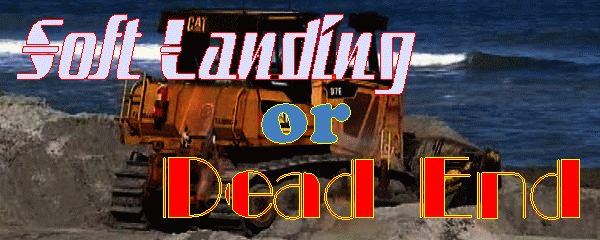

 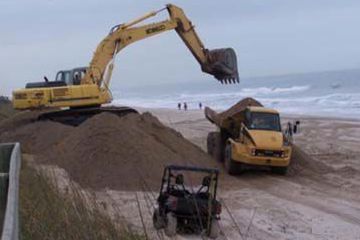 | | NEW SEGMENT II BROWARD BEACH PLAN |
October 15, 2015 - Once again, the Galt Mile community is anxiously awaiting the long-delayed Segment II Broward Beach Renourishment. Every non-comatose Galt Mile resident knows the project is scheduled to begin in November 2015 - just days away. Given the shrinking beach�s critical importance to the neighborhood�s economy and their quality of life, Galt Mile homeowners - and their associations - have passionately pursued its rescue for more than twenty years. 50 years - if you harken back to a 1965 entry in the Federal Register, when the 89th U.S. Congress appropriated a then whopping $1,093,000 to flesh out Broward�s severely eroded coast (Section 301 of Public Law 89-298, October 27, 1965).
 More importantly, Impact Statements filed by the Army Corps of Engineers confirm that a healthy beach is their only real protection against catastrophic Hurricane damage. In addition to saving thousands of lives, the Corps concluded that a renourished beach would preserve fast-eroding nesting and foraging habitat for a litany of species cited as endangered or threatened under the Endangered Species Act while buffering both public infrastructure and private property against the devastating impacts of cyclonic storm surge and high category windstorm events. Coastal engineers admonished that broadening Broward beaches would protect more than $4 billion in otherwise vulnerable upland property. More importantly, Impact Statements filed by the Army Corps of Engineers confirm that a healthy beach is their only real protection against catastrophic Hurricane damage. In addition to saving thousands of lives, the Corps concluded that a renourished beach would preserve fast-eroding nesting and foraging habitat for a litany of species cited as endangered or threatened under the Endangered Species Act while buffering both public infrastructure and private property against the devastating impacts of cyclonic storm surge and high category windstorm events. Coastal engineers admonished that broadening Broward beaches would protect more than $4 billion in otherwise vulnerable upland property.
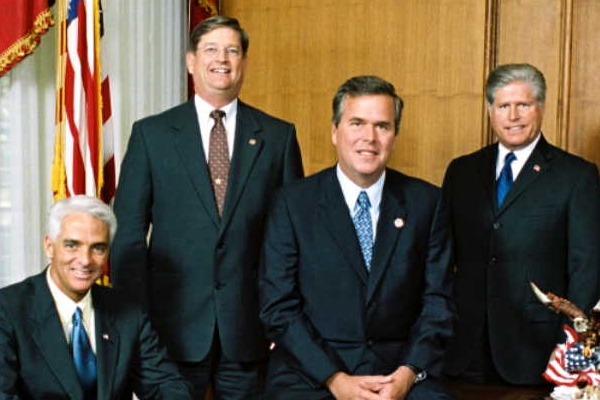 | | 2003 FLORIDA CABINET |
For decades, Broward officials annually assured Galt Mile residents that their disappearing beach would be renourished �next year.� As these promises systematically proved empty, enthusiasm for the project gave way to a numbing cynicism. Not surprisingly, Galt Mile residents are currently waiting for an all too familiar second shoe to drop. As the start date draws near, hundreds of residents who fought for the project both here and in Tallahassee, and thousands more who signed petitions and attended meetings to overturn political & regulatory roadblocks, grow increasingly apprehensive about the prospect of facing another crushing disappointment.
Stakeholder Preparations

 | | SOME SEGMENT II STAGING AREAS |
Following approval of the Federal Permit by the Army Corps of Engineers earlier this year, Galt Mile officials have been monitoring the project�s progress. Regular updates were solicited from District 4 Broward Commissioner Chip LaMarca, Broward Natural Resource Administrator Nicole Sharp and City of Fort Lauderdale officials. Although a County-managed project, since Fort Lauderdale�s beaches anchor its tourism economy, the City Commission and City Manager have ardently supported the project.
With State and Federal permits in hand, the County began drafting a Project Participation Agreement (PPA) in April, which will serve as a Federal reimbursement blueprint once the project is fully farmed out. While seeking Federal regulatory approval of their PPA (from the Army Corps of Engineers), the County also had to configure ILAs (Interlocal Agreements) with the three municipal stakeholders (the Cities of Fort Lauderdale and Pompano Beach and the Town of Lauderdale-by-the-Sea), optioning estimated funding formulas.
 | | TRUCKING SAND TO BEACH STAGING AREAS |
Last June, LaMarca remarked �The County is gearing up with the three cities to be ready for the procurement process so that we have a contractor and we are ready for November.� The County will outsource transporting 750,000 cubic yards of sand from the upstate mine to beachfront staging areas. Broward will also contract out the distribution of sand across the 5.2 mile project limits. The contract terms will provide the basis for a project timetable, useful for determining when each section of beach will be rehabilitated.
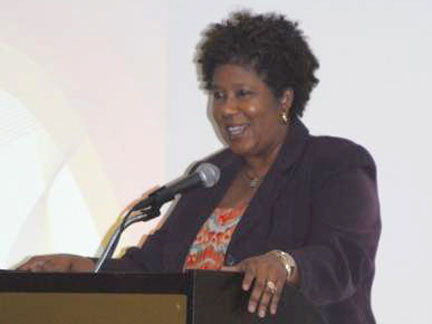 | | COUNTY ADMINISTRATOR BERTHA HENRY |
On September 22, 2015, County Administrator Bertha Henry observed in a Segment II Beach Renourishment Commission memo �Based on most recent conversations with Corps staff at various levels, receipt of the PPA is expected sometime in November. As stated previously, this document is required to award the project to a contractor.� Concerned about the incomplete PPA blocking a scheduled November project start, leery Galt Mile officials asked LaMarca if Henry�s comment cloaked a delay. LaMarca confirmed that the project would commence in November.
Fort Lauderdale & Broward County Tap Dance

 | | CITY MANAGER LEE FELDMAN |
At the October 5th Presidents Council meeting in Ocean Club Condominium, City Manager Lee Feldman announced having recently received a proposed ILA from the County. While lamenting a funding ratio which he characterized as unfair to the City, Feldman promised to support the project, as did City Commissioner Bruce Roberts. However, Feldman admonished that City Commissioners may opt to slug it out with their counterparts on the County Board. By waiting until the eleventh hour to distribute the municipal ILAs, Feldman intimated that the County had deliberately afflicted the cities with a negotiating deterrent, as the fast approaching November start date is anathematic to the siege mentality that often belabors negotiations between Fort Lauderdale and Broward County.
 | | ELKHORN AND STAGHORN CORALS |
Project costs for the Segment II renourishment were initially estimated at $45,343,805. In the past few years, the County spent an additional $6,886,719 circumventing heavily obstructed regulatory gauntlets while chasing the State & Federal Permits. To address concerns raised by environmental watchdog agencies with regulatory standing (i.e. FDEP, NOAA Fisheries, etc.), County planners agreed to enhance safeguards against adverse impacts to the nearshore hardbottom and protected species of coral (i.e. Elkhorn and Staghorn). These additional mitigation & monitoring measures are projected to cost $2,330,000 in 2016, and $500,000 annually in 2017 and 2018. As such, the total estimated cost of the Segment II project is actually $55,560,524.
 The municipal ILAs distributed by the County depicted funding scenarios with and without Federal participation. If the Federal Government snubbed the $55.6 million project, the State would ante $10.43 million; the County would pay $23.76 million, while the three municipalities would collectively chip in $11.31 million. In short, the County would pay a bit more than twice the cities� contribution, which Lee Feldman cited as less than the County share in past projects. However, the County also agreed to toss in an incremental $10.1 million recently collected by Broward from the City of Hollywood for a prior project. The municipal ILAs distributed by the County depicted funding scenarios with and without Federal participation. If the Federal Government snubbed the $55.6 million project, the State would ante $10.43 million; the County would pay $23.76 million, while the three municipalities would collectively chip in $11.31 million. In short, the County would pay a bit more than twice the cities� contribution, which Lee Feldman cited as less than the County share in past projects. However, the County also agreed to toss in an incremental $10.1 million recently collected by Broward from the City of Hollywood for a prior project.
As defined by a 2014 Limited Re-evaluation Report cost sharing formula, up to 55% of the project cost is federally reimbursable. If the Feds kicked in their anticipated 55% project reimbursement ($30.58 million), the County share would drop to $2.26 million (plus the $10.1 million reimbursed to the County by Hollywood), while the 3 municipalities would cough up $2.23 million (of which Fort Lauderdale would shoulder $1.61 million).
He Said, She Said

After the October 5th meeting, Galt Mile President Pio Ieraci contacted LaMarca about the proposed County-City cost-sharing formulas, and requested verification that the project would not be delayed by PPA negotiations between the Corps and Broward County. On October 9, 2015, LaMarca shot off the following response.
|
From: Lamarca, Chip [mailto:[email protected]]
Sent: Friday, October 09, 2015 7:23 AM
To: Ieraci, Pio '[email protected]'
Subject: Beach Renourishment Update
Pio,
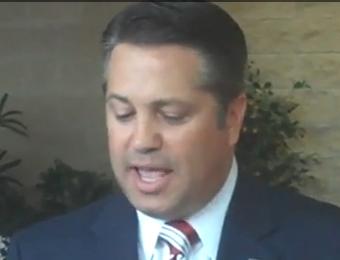 | | BROWARD COMMISSIONER CHIP LAMARCA |
I have very positive news about our beach renourishment project. The US Army Corps of Engineers has agreed to the financial terms of our project and they are in the process of signing off on the federal participation of 55% of the total project. This changes the financial cost for the local participation, requiring less money from the cities. As you can see, the City of Fort Lauderdale portion of the project is $1.61M in total. This will not be required until the year following completion of the project, and it can be paid over the next three years. I have included the breakdown of the federal, state and local funding so that you are able to see the details.
 We have already collected the state share listed, as well as the $10.1M from the previous Segment III project in Hollywood. The county will be contributing those dollars to the project to lower the overall cost to the cities and the county. We have already collected the state share listed, as well as the $10.1M from the previous Segment III project in Hollywood. The county will be contributing those dollars to the project to lower the overall cost to the cities and the county.
 The timing of the project is also still on track and we are getting bids for the work now in order to line up the contractor for the project. The kick off date for the project is still set for November 2015, and we will have a more precise date once we have the contractor ready to go. We will be able to provide an overall timeline for the project so that you can inform each building of the estimated timing of the impact of the project to their particular location. The timing of the project is also still on track and we are getting bids for the work now in order to line up the contractor for the project. The kick off date for the project is still set for November 2015, and we will have a more precise date once we have the contractor ready to go. We will be able to provide an overall timeline for the project so that you can inform each building of the estimated timing of the impact of the project to their particular location.
I hope that this information is helpful for the residents of the Galt Mile and I appreciate your work on this project.
Best regards,

Chip LaMarca
Commissioner, District 4
 Broward County Commission Broward County Commission
Governmental Center
115 South Andrews Avenue
Room 410
Fort Lauderdale, FL 33301
T: 954.357.7004 | F: 954.357.7798
E: [email protected]
|
|
When LaMarca�s message to Galt Mile officials was forwarded to the City of Fort Lauderdale, skeptical City officials thought it prudent to verify LaMarca�s missive. Fort Lauderdale Environmental Services Manager Todd Hiteshew contacted Broward Beach Administrator Nicole Sharp to assess LaMarca�s perspective. Sharp responded with the following message.
|
From: Sharp, Nicole [mailto:[email protected]]
Sent: Friday, October 09, 2015 3:58:47 PM EDT
To: 'Todd Hiteshew'[email protected]'
Cc: 'Nancy Gassman'[email protected]';"Jurado, Jennifer" mailto:[email protected], "Lamarca, Chip" mailto:[email protected]
Subject: RE: IMPORTANT! - Beach Renourishment Update
Todd,
 | BROWARD NATURAL RESOURCE
ADMINISTRATOR NICOLE SHARP |
The information provided below [sic � Above] is in need of clarification. The County has completed negotiating the terms of the Project Partnership Agreement (PPA); however, this does not ensure or commit the Corps to upfront reimbursement of 55%. Only until the PPA is executed can we confirm that the Corps has agreed to a cost-share ratio of 55% of project costs. In the meantime, the municipalities should budget for the no reimbursement column over the span of three years. As reimbursements are received, future payments will either be reduced, or if they are received after the payment period, they will be paid to the municipalities. As for the table, it was the same provided to all municipalities in our July meeting and is a current estimate of potential project cost scenarios.
Thanks,
Nicole
|
|
Budget Bilge

 | | ASSISTANT SECRETARY JO-ELLEN DARCY |
Having recently completed another agreement with the Corps � a measure to sufficiently deepen the Port Everglades channel to accommodate huge Post-Panamax shipping vessels � County negotiators know that any understanding is subsequently rubber-stamped by Jo-Ellen Darcy - Assistant Secretary of the Army. In her response, Sharp was unclear about whether the Feds said they would or would not participate, or if the agreement was simply awaiting Darcy�s signature. To demystify the negotiated outcome, and ascertain if the Corps had acceded to inclusion in the PPA, Sharp was asked point blank whether or not the Corps had agreed to the 55% cost-sharing ratio. The Broward beach boss responded �The PPA does include the 55% cost-share ratio, but we cannot confirm approval of the cost-share ratio until the document is signed off on by the Assistant Secretary of the Army and executed.� The Feds were on board.
Sharp�s admonitory suggestion that the City prepare for a worst-case funding scenario would mean appropriating $2.8 million annually for 3 years (total $8.38 million) � which would be reduced (or repaid) � by as much as $6.77 million when Federal reimbursements are recovered. If City planners decide against Sharp�s conservatively tentative budget gymnastics, the annual appropriation for 3 years would drop to $540,000 and the City�s net expense would be $1.61 million.
In the Works

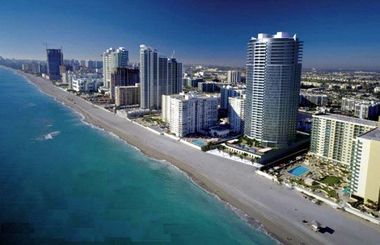 | | HOLLYWOOD BEACH - SEG III REPEAT |
While preparing to raise the curtain on Segment II, the County is in the design and engineering phase of another Segment III project to renourish South County beaches. The $53.7 million plan will combine sand dredged from the ocean bottom with sand trucked in from upstate mines. An estimated 980,000 cubic yards of sand will be distributed across the beaches of John U. Lloyd State Park, Dania, Hollywood, and Hallandale
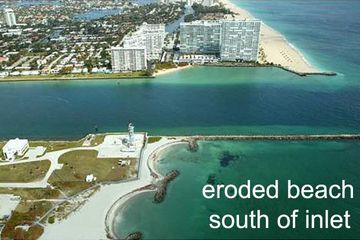 | | PORT EVERGLADES CHANNEL ENTRANCE |
Also on the menu is the Port Everglades Sand Bypassing Project. Since 85% of the tidal erosion in Florida occurs at coastal inlets like Port Everglades, sand that naturally migrates south along the coast detours seaward at the Port, and never replenishes the sand-starved South County beaches. The project is intended to pass along 50,000 to 80,000 cubic yards of sand annually from the north to the south sides of the Port Entrance, re-establishing the disrupted sand migration, diminishing the need for future renourishments.
As observed by legendary beach Guru Stephen Higgins, �Unless the entire Broward coast is treated and maintained like a single structural entity, this project will fail. The stability of every segment depends on the stability of its adjacent segments.� � simple � but elegant.

Click To Top of Page



 | | NEW SEGMENT II BROWARD BEACH PLAN |
 | BROWARD BEACH
ADMINISTRATOR ERIC MYERS |
June 1, 2015 - After reviving the dormant Segment II beach project in 2011, former Broward Beach Administrator Eric Myers spent the next 3 years chasing the required State and Federal permits. When he retired after a bitter, yet successful struggle for the State permit, Broward Natural Resource Administrator Nicole Sharp donned Myers� mantle as beach boss. Joined by District 4 Broward Commissioner Chip LaMarca, Sharp hunted the remaining regulatory brass ring � a Federal Permit to reclaim vanishing Segment II beaches � until she ran into a bureaucratic brick wall.
NOAA Fisheries Shell Game


 | | BROWARD COMMISSIONER CHIP LAMARCA |
Last year, LaMarca asked his District 4 constituents for help circumventing a federal beach renourishment roadblock. NOAA Fisheries (AKA the National Marine Fisheries Service - or NMFS), an agency in Penny Pritzker�s Commerce Department, was intransigently sitting on a key puzzle piece required for a Federal Permit � an �opinion letter� featuring recommendations to minimize collateral damage to the marine environment.
 For more than a year, agency bureaucrats ignored County requests for the opinion letter, although every other major State and Federal environmental watchdog agency endorsed the beach project as critically important to salvaging fast-diminishing nesting and foraging habitat for a laundry list of species deemed endangered or threatened under the Endangered Species Act (ESA). As cited in the Army Corps of Engineers� original Final Environmental Impact Statement (FEIS), Leatherback, Green, Kemp�s Ridley, Hawksbill and Loggerhead Sea Turtles, the Piping Plover and scores of other threatened species rely on the shrinking beach ecosystem for their survival. Ironically, NMFS bureaucrats blew off as �irrelevant� the Corps conclusion that a fortified beach will also save thousands of lives at risk from cyclonic storm surge while shielding more than $4 billion in upland property. As spun by an arrogant NMFS policy wonk in St. Petersburg, �Human survival is not our problem.� For more than a year, agency bureaucrats ignored County requests for the opinion letter, although every other major State and Federal environmental watchdog agency endorsed the beach project as critically important to salvaging fast-diminishing nesting and foraging habitat for a laundry list of species deemed endangered or threatened under the Endangered Species Act (ESA). As cited in the Army Corps of Engineers� original Final Environmental Impact Statement (FEIS), Leatherback, Green, Kemp�s Ridley, Hawksbill and Loggerhead Sea Turtles, the Piping Plover and scores of other threatened species rely on the shrinking beach ecosystem for their survival. Ironically, NMFS bureaucrats blew off as �irrelevant� the Corps conclusion that a fortified beach will also save thousands of lives at risk from cyclonic storm surge while shielding more than $4 billion in upland property. As spun by an arrogant NMFS policy wonk in St. Petersburg, �Human survival is not our problem.�
 While shrugging off public officials from Broward County, Fort Lauderdale, Lauderdale-by-the-Sea and Pompano Beach, the agency also ignored supplications by Statehouse Representative George Moraitis, Florida Senator Jeremy Ring and other members of the Broward Legislative Delegation. Anticipating that our Federal representatives might more effectively access a heavily cloistered federal agency, LaMarca and the Galt Mile Community Association recruited Senators Bill Nelson and Marco Rubio along with Congresswoman Lois Frankel to help pierce the seemingly impenetrable bureaucratic membrane. When the agency finally responded with an enigmatic claim that they lacked the resources to meet the County request (i.e. write an opinion letter), an incredulous Chip LaMarca visited the NOAA Fisheries Southeast Regional office in St. Petersburg, where he found the Broward request under a pile of unopened documents collecting dust at an empty desk. While shrugging off public officials from Broward County, Fort Lauderdale, Lauderdale-by-the-Sea and Pompano Beach, the agency also ignored supplications by Statehouse Representative George Moraitis, Florida Senator Jeremy Ring and other members of the Broward Legislative Delegation. Anticipating that our Federal representatives might more effectively access a heavily cloistered federal agency, LaMarca and the Galt Mile Community Association recruited Senators Bill Nelson and Marco Rubio along with Congresswoman Lois Frankel to help pierce the seemingly impenetrable bureaucratic membrane. When the agency finally responded with an enigmatic claim that they lacked the resources to meet the County request (i.e. write an opinion letter), an incredulous Chip LaMarca visited the NOAA Fisheries Southeast Regional office in St. Petersburg, where he found the Broward request under a pile of unopened documents collecting dust at an empty desk.
Running the Roadblock

 Since the agency is openly disdainful of local politicians and only marginally more responsive to members of Congress (unless, of course, they sit on a budget committee charged with pulling agency purse strings), Broward officials realized they were spitting into the wind. Reconsidering their options, County officials turned to another federal agency for help. To further its agenda, NOAA Fisheries needs a functional relationship with the Army Corps of Engineers (ACOE). Also, nobody can navigate the federal regulatory labyrinth like local Corps personnel, who consider it their back yard. LaMarca contacted the Army Corps of Engineers Palm Beach Gardens Regulatory office, where Supervisory Biologist and office chief Susan Kaynor and Project Manager Garett Lips agreed to help pinwheel NOAA Fisheries � and push the beach project to fruition. Since the agency is openly disdainful of local politicians and only marginally more responsive to members of Congress (unless, of course, they sit on a budget committee charged with pulling agency purse strings), Broward officials realized they were spitting into the wind. Reconsidering their options, County officials turned to another federal agency for help. To further its agenda, NOAA Fisheries needs a functional relationship with the Army Corps of Engineers (ACOE). Also, nobody can navigate the federal regulatory labyrinth like local Corps personnel, who consider it their back yard. LaMarca contacted the Army Corps of Engineers Palm Beach Gardens Regulatory office, where Supervisory Biologist and office chief Susan Kaynor and Project Manager Garett Lips agreed to help pinwheel NOAA Fisheries � and push the beach project to fruition.
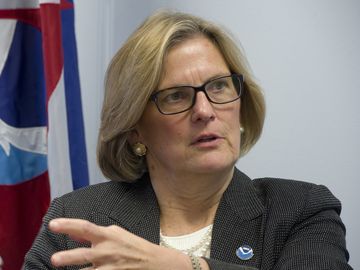 | | UNDER SECRETARY KATHRYN D. SULLIVAN |
 | | ASSISTANT SECRETARY JO-ELLEN DARCY |
NOAA Fisheries could have milked their dilatory tactics for years; fortunately, this wasn�t the first dance for ACOE Project Manager Garett Lips. When a NOAA Fisheries bureaucrat continued stonewalling the project after the February 20th response deadline mandated by federal law, Lips drew down on his intimate familiarity with the Federal playbook. A 1992 Memorandum of Agreement between the Department of Commerce and the Department of the Army spells out a procedure for breaking an impasse created when NMFS casually blocks a permit approved by the Corps; specifically, it kicks the problem upstairs to the Under Secretary for Oceans and Atmosphere (USOA - former astronaut Dr. Kathryn D. Sullivan - the first woman to walk in space) and the Assistant Secretary of the Army for Civil Works (ASA/CW - currently Jo-Ellen Darcy), a forum reserved for aquatic resources of national importance.

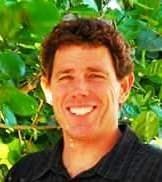 | | PROJECT MANAGER GARETT LIPS |
Lips sent a �3c� letter, forcing the agency bureaucrat to either rescind or elevate the objections by March 9. Since elevating borderline specious objections would expose the agency to crushing public and internal criticism for its willingness to arbitrarily eviscerate one of the world�s major Sea Turtle nesting habitats, scuttle a regional economy, and leave the entire beachfront population unprotected from cataclysmic storm surge, they threw in the towel. Having finally fleshed out the Corps� regulatory dance card with the NOAA Fisheries opinion letter, ACOE District Commander Colonel Alan Dodd issued Permit Number SAJ-1999-05545(SP-GGL) in Jacksonville a few days later.
 | | JACKSONVILLE DISTRICT COMMANDER COL. ALAN M. DODD |
Lips� timing was providential. After 3 years as District Commander of the of the U.S. Army Corps of Engineers, Jacksonville District, and 32 years in scores of domestic and overseas commands (including combat commends in Kuwait, Iraq and Afghanistan) where he earned countless citations and awards, West Point graduate Colonel Alan M. Dodd is preparing to retire from active service. Had he done so before signing off on the Broward permit, a new Commander might have required the County to revisit specific regulatory issues or re-navigate the entire gauntlet, prospectively adding years of additional delays. Before officials in Fort Lauderdale and the Galt Mile had an opportunity to thank Lips for sewing up the big win, the 45-year old biologist suddenly passed away on April 28.
As a parting shot, NOAA Fisheries salted the permit with a conditional requirement. The permit does not authorize the �taking� of an endangered species, in particular Acropora and other listed corals. Buried in their opinion letter, NOAA Fisheries specifies a set of �reasonable and prudent measures� when navigating the hardbottom environment. If implemented, responsibility for an �incidental taking� would be mitigated, leaving Broward off the hook.
Debunking Permit Myths � What Really Happened?

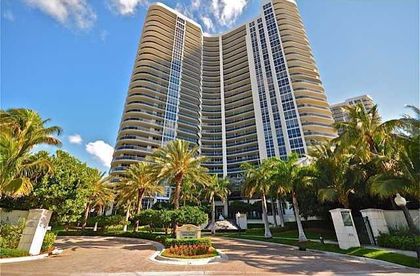 | | L'HERMITAGE I CONDOMINIUM |
When news of the Federal authorization spread through the neighborhood, pool talk fueled speculative misconceptions about the State and Federal permits. At a recent Presidents Council Meeting in L�Hermitage I, a veteran GMCA Advisory Board member � understandably angered by years of frustrating delays � took a potshot at those who worked to secure the Federal Permit, contending that a federal permit issued in 2004 was blown when irresponsible County officials sat on their thumbs - and allowed it to expire on July, 16, 2009. Another official held that the original permit hadn�t expired, obviating the need for a new permit. Like most urban legends, these myths were built on grains of truth. A Federal permit was received 11 years ago, although it did not authorize a Segment II beach fix.
 | | DREDGED SAND PUMPED ONTO HOLLYWOOD BEACH |
Issued on July 16, 2004, Federal Permit No. SAJ-1999-5545(IP-SLN) was limited to bulking south county Segment III beaches in Hollywood, Hallandale and Dania Beach. Since Galt Mile officials have been playing �Where�s Waldo� with State and Federal Beach Permits for almost two decades, the mix-up comes as no surprise, especially since a State permit that expired during a prolonged episode of bureaucratic foot-dragging fell prey to a countywide battle over replacement sand.
Initially issued by the Florida Department of Environmental Protection (FDEP), State Permit No. 0163435-001-JC authorizing Segment II on May 12, 2003 was reissued a year later (June 4, 2004) as Permit No. 0163435-005-JC following an administrative hearing convened to address a project challenge by a longtime local beach renourishment opponent.
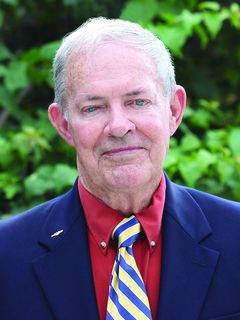 | ENVIRONMENTALIST
ROY ROGERS |
 | | 2003 - 2004 FLORIDA CABINET |
A few months earlier, scientists from the County�s Biological Resources Division addressed the Florida Cabinet at a May 13, 2003 Tallahassee public hearing, along with officials from Broward beachfront municipalities, renowned environmentalist (and former head of the Nature Conservancy, the Audubon Society and Florida Ethics Commission panelist) Roy Rogers and a contingent of Galt Mile residents. When project opponents � many funded by the scuba industry � informed former Governor Jeb Bush�s Cabinet members that Broward�s beachfront homeowners opposed the beach renourishment, the baseless spin was refuted by beachfront residents from the Galt Mile, whose testimony convinced the Cabinet to approve the project.
 | | ELKHORN AND STAGHORN CORALS |
 To avoid the appearance of environmental impropriety, the Cabinet added a permit provision requiring an 18-month monitoring period following the Segment III renourishment. Data collected about environmental impacts would be used to enhance safety mitigations applied to the Segment II project. When monitors from Nova Southeast University Oceanographic Center and a coalition of outside engineers (Olsen Associates, Inc., Coastal Planning and Engineering, Inc. - absorbed by CB&I in 2013, CECOS Environmental Consulting Services, Milian, Swain & Associates, Inc., etc.) joined county scientists in submitting the anticipated report in early 2008, among the scores of coral species listed in their findings were small colonies of endangered Staghorn (Acropora cervicornis) and Elkhorn (Acropora palmata) coral. To avoid the appearance of environmental impropriety, the Cabinet added a permit provision requiring an 18-month monitoring period following the Segment III renourishment. Data collected about environmental impacts would be used to enhance safety mitigations applied to the Segment II project. When monitors from Nova Southeast University Oceanographic Center and a coalition of outside engineers (Olsen Associates, Inc., Coastal Planning and Engineering, Inc. - absorbed by CB&I in 2013, CECOS Environmental Consulting Services, Milian, Swain & Associates, Inc., etc.) joined county scientists in submitting the anticipated report in early 2008, among the scores of coral species listed in their findings were small colonies of endangered Staghorn (Acropora cervicornis) and Elkhorn (Acropora palmata) coral.
 | FORMER FDEP SECRETARY MICHAEL SOLE
AND FORMER GOVERNOR CHARLIE CRIST |
A few years after the 2008 monitoring report was submitted � just before the State permit expired � former Broward Beach boss Steve Higgins sent a letter to former FDEP Secretary Michael Sole on April 3, 2009, requesting that Sole extend State authorization of Segment II for another 5 years � through June 4, 2014. Sole had roots in Broward. When he was recruited by former Governor Charlie Crist to run the FDEP, Sole was working as a Marine Biologist for Broward County � arms akimbo with Steve Higgins and Eric Myers.
After indicating his intention to extend the State permit, and providing Higgins with a Notice of Completeness for his application, Sole informed Higgins that a Notice to Proceed would not be forthcoming until he received a Segment II mitigation plan protecting the endangered species of coral, in compliance with the Endangered Species Act (ESA).
Sand Civil War

Observing that the Broward project was �The most heavily regulated Beach reourishment in the history of Florida,� Higgins began fashioning an Acropora addendum that would pass muster with Sole�s FDEP and ESA regulations. When the project�s State permit expired on June 4, 2009, all hell broke loose.
 | | HOLLYWOOD HOTELS COVET SEG II SAND |
Despite that testimony from Galt Mile residents and Fort Lauderdale City officials were the deciding factors in winning Cabinet approval for the south county�s Segment III renourishment, when Segment II approval lapsed, Hollywood and Hallandale hoteliers and politicians colluded in launching a stealth campaign to hijack the sand earmarked for Fort Lauderdale�s beaches.
 Enraged by the south county attempt to usurp Segment II renourishment resources, incredulous north county municipal officials went ballistic. The Fort Lauderdale City Commission immediately passed City Resolution No. 09-11, �strongly opposing� a sand bypass at Port Everglades that would replenish sand stripped from south county beaches by tidal erosion. A page was posted on the City web site entitled �Help Save Fort Lauderdale Beach,� which provided the email addresses of the County Commissioners and asked that residents �Help to make sure that Fort Lauderdale is not pushed to the back of the line� by demanding that Broward first complete the promised Segment II renourishment of Fort Lauderdale�s beaches. Waves of invective for south county politicians were echoed in Lauderdale-by-the-Sea and Pompano Beach. Enraged by the south county attempt to usurp Segment II renourishment resources, incredulous north county municipal officials went ballistic. The Fort Lauderdale City Commission immediately passed City Resolution No. 09-11, �strongly opposing� a sand bypass at Port Everglades that would replenish sand stripped from south county beaches by tidal erosion. A page was posted on the City web site entitled �Help Save Fort Lauderdale Beach,� which provided the email addresses of the County Commissioners and asked that residents �Help to make sure that Fort Lauderdale is not pushed to the back of the line� by demanding that Broward first complete the promised Segment II renourishment of Fort Lauderdale�s beaches. Waves of invective for south county politicians were echoed in Lauderdale-by-the-Sea and Pompano Beach.
 | | FORMER BROWARD BEACH ADMINISTRATOR STEVE HIGGINS |
Higgins is a scientist, not a politician. Caught in a political dogfight between north county City officials who were promised the sand, and south county politicians who coveted the Segment II sand to bulk up their newly fattened Segment III beaches, Higgins was relentlessly pummeled by both sides. Stupefied by this deteriorating political rats� nest, the County�s unique environmental wizard �closed down,� dropping the beach project into a black hole.
 | | HOLLYWOOD MAYOR PETER BOBER |
Until Higgins announced that he would retire in 2011, the beach project remained dormant. Although he would continue as a consultant, his primary duties would be assumed by his boss, Deputy Director Eric Myers of Broward�s Environmental Protection and Growth Management Department. With Broward back in the business of fixing beaches, Hollywood Mayor Peter Bober wanted in. Extending an olive branch to Fort Lauderdale, Bober announced �Hollywood is not interested in doing anything that would give us any unfair advantage or cause any detriment to Fort Lauderdale residents or the City�s reputation.�
 | | TRUCKING SAND TO BEACH STAGING AREAS |
At a February 7, 2011 Presidents Council meeting in Coral Ridge Towers (Original), Myers announced that the project�s revival hinged on two contingent benchmarks, crafting a new plan that eliminated the most egregious regulatory obstacles and unilateral cooperation by coastal jurisdictions and beachfront homeowners. Myers� redesigned project no longer called for using sand dredged from the ocean floor by vessels dragging pipes and hoses across the hardbottom. By truncating prospective damage to the marine ecosystem, he also quashed the project�s greatest source of environmental blowback.
 | BROWARD NATURAL RESOURCE
ADMINISTRATOR NICOLE SHARP |
 | | MINED STOCKPILES OF COMPATIBLE BEACH SAND |
Instead, sand from upstate mines will be trucked to beachfront staging areas via a route approved by the Florida Department of Transportation (FDOT) before being spread across each Segment II beach. To authorize this revised Segment II project, FDEP issued Permit Number 0314535-001-JC on January 31, 2014. In contrast with the 5-year lifespan of previous State Permits, the current authorization expires on January 31, 2029. As explained by Broward Natural Resource Administrator Nicole Sharp, the extended authorization will enable the County to expeditiously fill �hot spots� carved by coastal storms, without spending years wandering through another regulatory House of Horrors. Thanks to the late Garett Lips, federal authorities are also on board.
Final Preparations


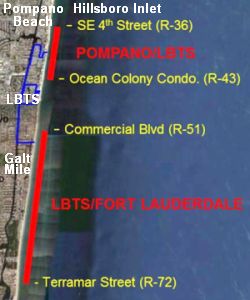 | | SOME SEGMENT II STAGING AREAS |
With the State and Federal permits in hand, the County began drafting a Project Participation Agreement (PPA), which will serve as a Federal reimbursement blueprint once the project is fully farmed out. Truckloads of sand will begin arriving after the staging areas are prepared in November, 2015, following Sea Turtle nesting season. Given the abbreviated construction window annually imposed by the eight-month nesting season (March � October), project duration was initially projected at two to three years.
However, at the February 2, 2015 Presidents Council meeting in Fountainhead Condominium, LaMarca agreed to explore an alternative timetable suggested by association officials. Instead of selecting an initial staging site and sending the construction crew either up or down the coast, attending GMCA officials proposed coordinating a project launch from several beachfront staging areas, with multiple construction teams operating simultaneously. This expedited plan would abandon the multi-year timetable in favor of a single season completion. Nicole Sharp gave assurances that each association will be notified about when its respective beach will be closed in order to receive sand.
 At several subsequent GMCA Advisory Board meetings, officials stressed the importance of conveying the construction schedule to Galt Mile residents as soon as possible. Unit owners who expect visiting friends and family after the project begins need to know when beach access will be restricted by construction. As such, county and/or FDOT beach updates will be immediately forwarded to member associations by email blast, posted on the Galt Mile website and detailed in the monthly Galt Mile News. For expanded status reports, unit owners can also check with their association's Advisory Board Representatives. More to come... At several subsequent GMCA Advisory Board meetings, officials stressed the importance of conveying the construction schedule to Galt Mile residents as soon as possible. Unit owners who expect visiting friends and family after the project begins need to know when beach access will be restricted by construction. As such, county and/or FDOT beach updates will be immediately forwarded to member associations by email blast, posted on the Galt Mile website and detailed in the monthly Galt Mile News. For expanded status reports, unit owners can also check with their association's Advisory Board Representatives. More to come...

Click To Top of Page



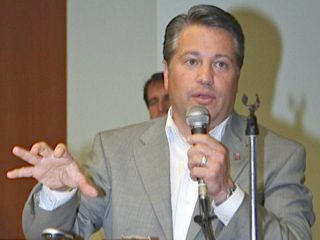 | | BROWARD COMMISSIONER CHIP LAMARCA |
June 22, 2014 - A bureaucratic blood blister that threatened the chronically delayed Segment II Broward beach project with an added 18-month freeze has been excised. To help quash one of the more asinine impediments faced by this snake-bit project, District 4 Broward Commissioner Chip LaMarca scripted major roles for the entire Broward Congressional delegation, both of Florida�s U.S. Senators, the Galt Mile Community Association and an army of Galt Mile residents. With officials in Pompano, Lauderdale-by-the-Sea and Fort Lauderdale playing bit parts, the eerie plan placed the beach fix back on track for its post-Halloween kickoff.
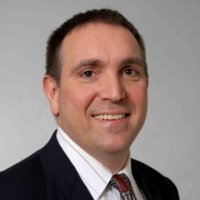 | DIRECTOR MARK THOMASSON
WATER RESOURCE MNGT |
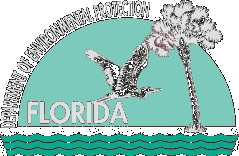 At the December 19, 2013 GMCA Advisory Board meeting, County Commissioner Chip LaMarca reported the status of the long awaited Segment II beach renourishment. While navigating myriad regulatory landmines with retiring Broward Beach boss Eric Myers, LaMarca had to circumvent a scam in Tallahassee and penetrate a bureaucratic blockade in Washington DC. In Tallahassee, FDEP Division of Water Resource Management Director Mark Thomasson booby trapped Broward�s Draft Permit with �31 d. In the event additional impact from the project is documented, the Applicant shall be required to mitigate for the impacts, through compliance and enforcement action, with the amount of mitigation determined according to the Department�s Uniform Mitigation Assessment Method (UMAM).� At the December 19, 2013 GMCA Advisory Board meeting, County Commissioner Chip LaMarca reported the status of the long awaited Segment II beach renourishment. While navigating myriad regulatory landmines with retiring Broward Beach boss Eric Myers, LaMarca had to circumvent a scam in Tallahassee and penetrate a bureaucratic blockade in Washington DC. In Tallahassee, FDEP Division of Water Resource Management Director Mark Thomasson booby trapped Broward�s Draft Permit with �31 d. In the event additional impact from the project is documented, the Applicant shall be required to mitigate for the impacts, through compliance and enforcement action, with the amount of mitigation determined according to the Department�s Uniform Mitigation Assessment Method (UMAM).�

 | BROWARD BEACH
ADMINISTRATOR ERIC MYERS |
While ostensibly bureaucratic blather, the language was actually a legal funding hook. In effect, it would have required Broward taxpayers to mitigate marine impacts that were outside the scope of the Segment II Beach Renourishment - at the sole discretion of Florida Department of Environmental Protection (FDEP) - and in perpetuity. Beating back this bald-faced blackmail, Eric Myers responded �Following issuance of the permit we would apply for a modification to address the quantification of liability which the County believes should have been a part of the original permit. Specifically, we are requesting that Specific Condition 31 d. be struck in its entirety.� Thomasson grudgingly relented, and excised the extortion attempt. Having forged an understanding with Tallahassee regulators, LaMarca and Myers turned their attention to Washington DC.
 Last November, LaMarca was part of a contingent of Broward business leaders and politicians - including Fort Lauderdale Mayor Jack Seiler - who met with Broward�s Congressional delegation in Washington to lobby for passage of H.R. 3080, The Water Resources Reform & Development Act (WRRDA). Five months earlier, the U.S. Army Corps of Engineers finally released its Draft Environmental Impact Statement for �Navigational Improvements to the Port Everglades Harbor,� the inexplicably elusive regulatory prerequisite for hosting Post-Panamax ships. Last November, LaMarca was part of a contingent of Broward business leaders and politicians - including Fort Lauderdale Mayor Jack Seiler - who met with Broward�s Congressional delegation in Washington to lobby for passage of H.R. 3080, The Water Resources Reform & Development Act (WRRDA). Five months earlier, the U.S. Army Corps of Engineers finally released its Draft Environmental Impact Statement for �Navigational Improvements to the Port Everglades Harbor,� the inexplicably elusive regulatory prerequisite for hosting Post-Panamax ships.
 | COMMISSIONER CHIP LAMARCA THANKS BROWARD PUBLIC
OFFICIALS AND CIVIC LEADERS FOR LOBBYING WRDA |
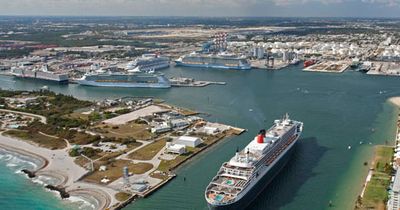 | | PORT EVERGLADES |
When the project to expand the Panama Canal is completed in the next few years, managing these huge ocean going monsters will provide a huge windfall to the handful of east coast ports configured to accommodate the wider, longer vessels with 50-foot drafts (AKA post-Panamax). The project will ultimately deepen Port Everglades� channel from 42 feet to 50 feet. Widening the channel entrance will allow entering and departing ships to safely pass cargo and cruise ships docked along the Intracoastal Waterway inside the Port. The cost of the expansion project is estimated at $313 million, funded by a combination of federal funds, port user fees and � if fortune smiles � state funds. As with expansion of the Southport Turning Notch and completion of the Intermodal Container Transfer Facility, Broward taxpayers won�t have to cough up a dime.
 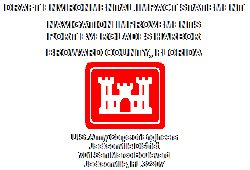 After weathering 17 years of delays from bureaucratic foot-dragging and Congressional gridlock, Port Everglades officials were about to hit the Lottery. The WRRDA will authorize and financially flesh out the U.S. Army Corps of Engineers� civil works program, which constructs critical navigation and water infrastructure projects across the nation. Specifically, the WRRDA will provide long-awaited access to roughly $7 billion squirreled away in a legislative lock box � the Harbor Maintenance Trust Fund. After weathering 17 years of delays from bureaucratic foot-dragging and Congressional gridlock, Port Everglades officials were about to hit the Lottery. The WRRDA will authorize and financially flesh out the U.S. Army Corps of Engineers� civil works program, which constructs critical navigation and water infrastructure projects across the nation. Specifically, the WRRDA will provide long-awaited access to roughly $7 billion squirreled away in a legislative lock box � the Harbor Maintenance Trust Fund.
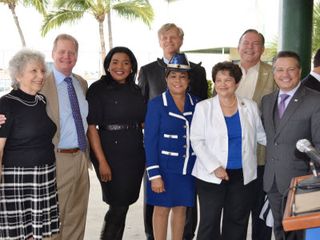 | BROWARD COMMS. SUE GUNZBURGER, TIM RYAN, BARBARA
SHARIEF, CONGRESSWOMEN FREDERICA WILSON, LOIS FRANKEL
COMM. CHIP LAMARCA. (In back:) PORT EVERGLADES CEO STEVE
CERNAK, GREATER FT LAUD ALLIANCE CEO BOB SWINDELL |
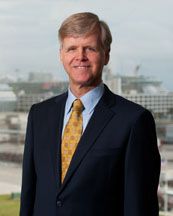 | | PORT DIRECTOR STEVE CERNAK |
Funding the Corps� newly approved competitive improvements to the Port will insure its future as a regional economic powerhouse. After watching the Water Bill succumb to partisan bickering for 7 consecutive years, contingents from jurisdictions with stalled water infrastructure projects across the country, including our ad hoc Broward group, pushed the bill over the hump. As the Conference Committee began back-loading the bill with pork, Port Everglades Director Steven Cernak flipped the Port�s Master Plan into high gear. As the 3 major projects near completion, the Port's $26 billion in annual economic activity will serve as a baseline for future growth, as incremental taxes from thousands of new jobs fill County coffers. While celebrating their hard-won victory, LaMarca was oblivious to how soon he would need to rely on the bonds he forged during the struggle.
 In January, LaMarca faced a new regulatory stumbling block. Despite having diligently submitted mountains of mandated documentation while timely responding to redundant agency inquiries, Eric Myers informed LaMarca that the Segment II Beach project hit a wall. Among the oceans of regulatory minutia required to complete the Federal permit is a boilerplate biological opinion by the National Oceanic and Atmospheric Administration Marine Fisheries (NOAA Fisheries). With green lights across the board from every other Federal Agency with standing, Myers� repeated attempts to call, email and officially correspond with NOAA Fisheries - a line office in the Department of Commerce - were roundly ignored. Shortly thereafter, Myers and LaMarca learned that the documentation sent months earlier to NOAA Fisheries (AKA - National Marine Fisheries Service) was collecting dust on a bureaucrat�s desk. Finally, a Commerce Department spin-monkey stunned the two Broward officials with a fairy tale about a shortage of Federal resources!!! In January, LaMarca faced a new regulatory stumbling block. Despite having diligently submitted mountains of mandated documentation while timely responding to redundant agency inquiries, Eric Myers informed LaMarca that the Segment II Beach project hit a wall. Among the oceans of regulatory minutia required to complete the Federal permit is a boilerplate biological opinion by the National Oceanic and Atmospheric Administration Marine Fisheries (NOAA Fisheries). With green lights across the board from every other Federal Agency with standing, Myers� repeated attempts to call, email and officially correspond with NOAA Fisheries - a line office in the Department of Commerce - were roundly ignored. Shortly thereafter, Myers and LaMarca learned that the documentation sent months earlier to NOAA Fisheries (AKA - National Marine Fisheries Service) was collecting dust on a bureaucrat�s desk. Finally, a Commerce Department spin-monkey stunned the two Broward officials with a fairy tale about a shortage of Federal resources!!!
 Soliciting input from incredulous project stakeholders in Pompano, Lauderdale-by-the-Sea and Fort Lauderdale (including the Galt Mile Community Association), LaMarca conceived a plan to penetrate the cloistered agency. Since the Federal obstacle was unresponsive to County political efforts, LaMarca reached out to Broward members of Congress, whose standing in the Federal food chain could rouse snoozing Commerce Department bureaucrats, expedite the long-delayed biological opinion and kick-start the Beach Project. Soliciting input from incredulous project stakeholders in Pompano, Lauderdale-by-the-Sea and Fort Lauderdale (including the Galt Mile Community Association), LaMarca conceived a plan to penetrate the cloistered agency. Since the Federal obstacle was unresponsive to County political efforts, LaMarca reached out to Broward members of Congress, whose standing in the Federal food chain could rouse snoozing Commerce Department bureaucrats, expedite the long-delayed biological opinion and kick-start the Beach Project.
 However, given the agency�s intransigent resistance to altering snail-paced protocols, LaMarca questioned whether a request from a hometown politician would adequately motivate our federal lawmakers to close the deal. It would be far more effective to recruit Congressional assistance the old fashioned way. If the same request for help came from thousands of voters, fixing Broward�s disappearing beach would quickly become a political priority for Broward's Congressional delegation. To accomplish this, all he needed was a community filled with hotheads who predictably react poorly to unreasonable bureaucrats who step on their necks. However, given the agency�s intransigent resistance to altering snail-paced protocols, LaMarca questioned whether a request from a hometown politician would adequately motivate our federal lawmakers to close the deal. It would be far more effective to recruit Congressional assistance the old fashioned way. If the same request for help came from thousands of voters, fixing Broward�s disappearing beach would quickly become a political priority for Broward's Congressional delegation. To accomplish this, all he needed was a community filled with hotheads who predictably react poorly to unreasonable bureaucrats who step on their necks.
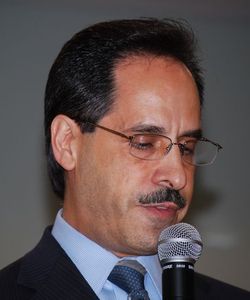 | GMCA PRESIDENT
PIO IERACI |
 | | CONGRESSWOMAN LOIS FRANKEL |
On January 28, 2014, an enraged LaMarca sent an email to GMCA President Pio Ieraci that detailed the problem and suggested his �resolution�. In February, notices were sent to Galt Mile member associations for distribution to unit owners. The notices described the dilemma, listed the contact data for our Congressional officeholders and requested help with conveying the critical need to shake loose the Federal malaise that was holding the project hostage. The information was also posted on the Galt Mile website and in LaMarca�s March 2014 constituent newsletter.
 | | SENATOR BILL NELSON |
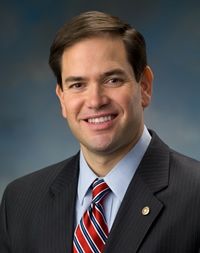 | | SENATOR MARCO RUBIO |
Within weeks, hundreds of letters, phone calls, faxes and emails flooded the local and Washington D.C. offices of Congresswoman Lois Frankel (who represents Galt Mile residents on �The Hill�), Senator Bill Nelson and Senator Marco Rubio. The shared message in these correspondences was a simple request, �Please urge the Secretary of Commerce to ensure that the biological opinion of the Segment II Beach Project is completed as soon as possible.� By mid-February, Congresswoman Frankel and Senators Nelson and Rubio had all expressed an intention to help circumvent the Federal roadblock and salvage Broward�s shrinking beaches.
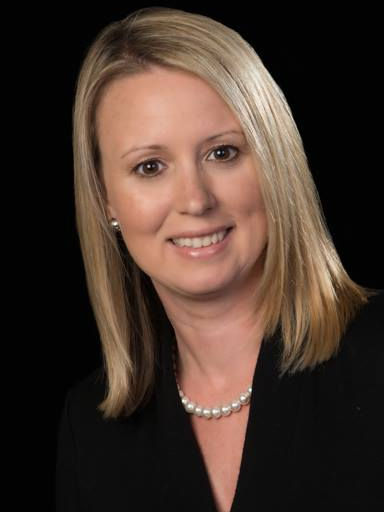 | | COMMISSION AIDE KATE WESNER |
At the February 20, 2014 Advisory Board meeting, LaMarca�s Commission Aide Kate Wesner explained the importance of maintaining the political pressure. Carefully burrowing into agency infrastructure, Wesner learned which projects preceded the Broward Beach plan for review and discovered the name of the infamous Commerce Department staffer (heretofore referred to as �The Bottleneck�). Absent intervention by our Federal Lawmakers, agency delays could persist for up to 18 months. On April 17, 2014, after revealing the staffer�s name to the Advisory Board, a disgusted LaMarca expressed his intention to pass it to the Sun-Sentinel if the delay continued. LaMarca also confirmed that preparations for the Segment II procurement process were underway (bids for trucking sand to staging areas, etc.).
 | | COMMERCE SECRETARY PENNY SUE PRITZKER |
By mid-May, more than 4,000 messages had been sent from email links on the Galt Mile website to Senators Nelson and Rubio, U.S. House members Lois Frankel, Alcee Hastings, Ted Deutch, Debbie Wasserman-Schultz, Frederica Wilson and Mario Diaz-Balart. Another 437 were sent to Secretary of Commerce Penny Sue Pritzker (of the Hyatt Hotel �Pritzkers�). These requests were incremental to those prompted by the individual building notices and LaMarca�s March newsletter.
The plan worked. Serial probes by two U.S. Senators and half dozen angry U.S. Representatives eroded the arrogance of this mid-level bureaucrat. As �The Bottleneck� grew increasingly uncomfortable, months were �coincidentally� shaved from the projected date for stamping out the opinion letter. On May 15, Kate Wesner informed the Advisory Board that since the Segment II Project was suddenly �next in line for review by NOAA Fisheries,� the Biological Opinion would soon be addressed.
 | | PLAYA DEL SOL CONDOMINIUM |
At the December 2, 2013 Presidents Council meeting at Playa del Sol, after declaring that Broward�s economic survival depends on the health of its beaches, LaMarca said �I make this pledge, I will do whatever is necessary to get sand on our beach.� After decades of similar promises by public officials, attendee consensus was �We�ll see.� Events since then bought LaMarca a boatload of credibility, although many veteran Galt Mile officials understandably plan to reserve judgment until their toes are covered in new sand. We also owe a debt of gratitude to Kate Wesner, whose carrot and stick helped penetrate agency lethargy. At the end of the day, it was the sleepy retirees who live between Commercial and Oakland Park Boulevards who made the difference� as usual. On June 10, 2014, LaMarca sent the following message to the Galt Mile Community Association:

 | | TRUCKING SAND TO BEACH STAGING AREAS |
While preparations for the Segment II Beach Renourishment are already underway, the first of 50,000 truckloads of sand will reach project staging sites in November, after the turtle nesting season. Not surprisingly, the same radical local environmental group that has bean-bagged the project for decades launched a few curious pot shots prior to the June 13, 2014 project deadline for recording public comments.

 | | NEW BEACH CONSTRUCTION PLAN |
Since the original county project was first federally authorized by the 89th Congress in 1965 (Section 301 of Public Law 89-298, October 27, 1965), it has been environmentally vetted almost annually for 49 years. Despite being the most thoroughly scrutinized and mitigated beach project in Florida history, the complainant condemned the Florida Department of Environmental Protection for prematurely issuing a permit. In contrast with his claim that the project would bury much of the 5000-acre reef tract with sand, an impact assessment drafted by the Army Corps of Engineers � and vetted by Federal, State and County Environmental agencies � affixes the loss at 4.9 acres - .less than one tenth of 1%. Although miniscule, even this marginal damage will be mitigated by a newly installed concrete substrate promoting algae regrowth.
 | BROWARD NATURAL RESOURCE
ADMINISTRATOR NICOLE SHARP |
 | | MINED STOCKPILES OF COMPATIBLE BEACH SAND |
Defending the County�s environmental diligence, Broward Natural Resource Administrator Nicole Sharp (who filled the position vacated by recently retired Eric Myers) remarked �We worked with our engineers and we put forward a very environmentally sensitive project.� Heeding input from environmental agencies, coastal engineers and reputable advocacy groups, project planners decided to avoid the adverse nearshore hardbottom impacts at risk when large maritime vessels snake pipelines shoreward around coral reefs to pump out light grey carbonate sand dredged from offshore borrow sites. Instead, they will harvest 750,000 cubic yards of significantly more compatible light yellow silica sand from upland mines roughly 125 miles north and northwest of the County along the site of Florida�s shoreline � about 5 million years ago. After verification that the sand meets the size, shape and color parameters defined by county scientists, it will be trucked to oceanfront staging areas and carefully spread across the beach. To avoid disturbing our shared coastal habitat during Sea Turtle nesting season, the project is expected to span several years.
A top engineer from renowned Boca Raton-based marine consultants Coastal Planning and Engineering (a subsidiary of construction and consulting Juggernaut CB&I), Sharp perceives an added benefit to using the mined sand. Due primarily to its typically larger average grain size and smaller fines fraction, Sharp explained that the sand is more stable and produces less post placement turbidity. In other words, the sand will stack more like building blocks than volleyballs due to the granules� size and shape.
PLEASE NOTE  We suggest that GMCA member association Carib�, which is also eligible for the Lauderdale-by-the-Sea dune restoration project, investigate participation. The dunes will help stabilize the beach and stave off tidal erosion � prolonging the benefit of the impending Beach Renourishment. Think about it!!! We suggest that GMCA member association Carib�, which is also eligible for the Lauderdale-by-the-Sea dune restoration project, investigate participation. The dunes will help stabilize the beach and stave off tidal erosion � prolonging the benefit of the impending Beach Renourishment. Think about it!!!
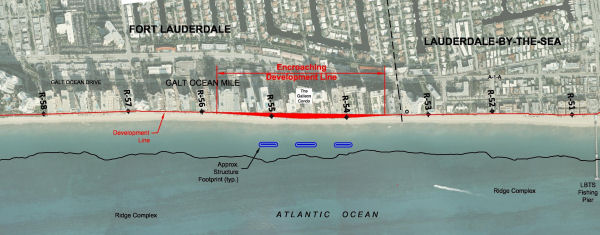 | | BROWARD BEACH RENOURISHMENT - SEGMENT II |

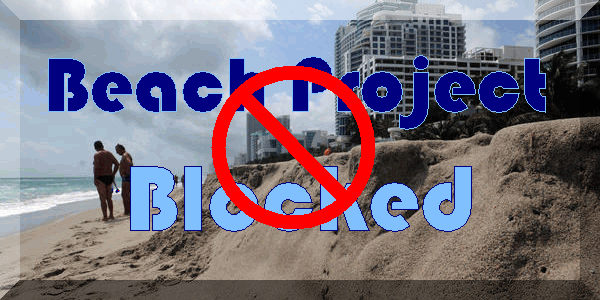

THE GALT MILE NEEDS YOU!


 | | BROWARD COMMISSIONER CHIP LAMARCA |
February 9, 2014 - At the December 19, 2013 GMCA Advisory Board meeting, County Commissioner Chip LaMarca reported the status of the long awaited Segment II beach renourishment. LaMarca said that the County is currently working through permitting obstacles in Tallahassee. In short, the Florida Department of Environmental Protection (FDEP) baited a draft permit agreement with language that would box Broward into assuming responsibility for mitigating unanticipated problems that are outside the scope of the renourishment effort - in perpetuity. In short, FDEP attempted to extort a blank check funded by Broward taxpayers - US! Later that week, LaMarca forwarded documentation supporting his beach renourishment disclosures, including hard evidence of the war of nerves playing out between FDEP and the County. Over the next month, this - and other obstacles - were mitigated by the concerted efforts of LaMarca and Broward Beach Administrator Eric Myers.
 | GMCA PRESIDENT
PIO IERACI |
 | BROWARD BEACH
BOSS ERIC MYERS |
By the end of January, one obstacle remained. The Broward Beach project demands regulatory-mandated approvals from myriad Federal, State and local agencies. As such, during the past year, Myers has diligently submitted the required documentation while timely responding to seemingly endless agency inquiries. In turn, each agency approved the project... except one. Despite having received all the required documentation from Myers, the National Marine Fisheries Service (NOAA Fisheries) remained silent. Phone calls, emails and official correspondences went unanswered. It was soon learned that the documentation Myers sent to National Marine Fisheries Service - a NOAA line office agency in the Department of Commerce) was sitting on a bureaucrat's desk - collecting dust.
Following a discussion with Galt Mile officials, on January 28, 2014, Commissioner LaMarca sent Galt Mile Community Association (GMCA) President Pio Ieraci the following explanation - along with his assent to a plan for circumventing the Federal malaise that's currently holding the project hostage:
|
From: Lamarca, Chip [mailto:[email protected]]
Sent: Tuesday, January 28, 2014 5:38 PM
To: '[email protected]'; Wesner, Kate; Reiter, Ryan; Pryde, Mary
Subject: Segment II Beach Renourishment Project Push
Pio,
 Per our conversation this afternoon and due to the time-sensitive nature of this effort, I suggest that we ask all willing and interested parties to contact the Broward Members of Congress and both U.S. Senators. Per our conversation this afternoon and due to the time-sensitive nature of this effort, I suggest that we ask all willing and interested parties to contact the Broward Members of Congress and both U.S. Senators.
A short history and the status of the permits for the beach renourishment project are as follows:
 As you are aware, beach renourishment has been my top priority since entering this office. The project was on track to be permitted in early October 2013. This was a critical date that I monitored through visits with Eric Myers with Broward County�s Environmental Protection and Growth Management Department. As we came close to that date, we experienced three significant events that affected the progress of the permits. First, there were concerns over the liability of any future storm events where the State of Florida Department of Environmental Protection (FDEP) wanted to require Broward County to be responsible for any storm damage in the renourished areas. This could have had a serious fiscal impact to Broward County residents (in the tens of millions of dollars). Second, the shutdown of the Federal Government stopped and delayed progress on obtaining the required federal permit from the U.S. Army Corps of Engineers. Third, the National Marine Fisheries Services (NOAA) is delaying the required biological opinion of the project due to a lack of federal resources. As you are aware, beach renourishment has been my top priority since entering this office. The project was on track to be permitted in early October 2013. This was a critical date that I monitored through visits with Eric Myers with Broward County�s Environmental Protection and Growth Management Department. As we came close to that date, we experienced three significant events that affected the progress of the permits. First, there were concerns over the liability of any future storm events where the State of Florida Department of Environmental Protection (FDEP) wanted to require Broward County to be responsible for any storm damage in the renourished areas. This could have had a serious fiscal impact to Broward County residents (in the tens of millions of dollars). Second, the shutdown of the Federal Government stopped and delayed progress on obtaining the required federal permit from the U.S. Army Corps of Engineers. Third, the National Marine Fisheries Services (NOAA) is delaying the required biological opinion of the project due to a lack of federal resources.
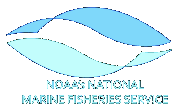 I have taken steps to get this project back on track at each phase of this process by meeting with the director of the FDEP in Tallahassee and the Governor�s Office regarding the liability issues with the State of Florida. This issue was successfully resolved in early December. I have traveled to Washington, DC with our county staff on numerous occasions throughout this process to meet with officials from the Army Corps of Engineers to advocate on behalf of our community for the environmental permits. I have taken steps to get this project back on track at each phase of this process by meeting with the director of the FDEP in Tallahassee and the Governor�s Office regarding the liability issues with the State of Florida. This issue was successfully resolved in early December. I have traveled to Washington, DC with our county staff on numerous occasions throughout this process to meet with officials from the Army Corps of Engineers to advocate on behalf of our community for the environmental permits.
 We now need your help by contacting all of our federal elected officials in Washington, DC. Please contact each of their offices listed below and respectfully urge our representatives to do the following: We now need your help by contacting all of our federal elected officials in Washington, DC. Please contact each of their offices listed below and respectfully urge our representatives to do the following:
�Please urge the Secretary of Commerce to ensure that the biological opinion of the Segment II Beach Project is completed as soon as possible.�
 Best regards, Best regards,
Chip LaMarca
Broward County Commissioner
115 South Andrews Avenue
Fort Lauderdale, FL 33301
T: 954.357.7004 | F: 954.357.7798
E: [email protected]
|
|
 After thanking Commissioner LaMarca for clearly identifying a crushingly assinine and unacceptable bureaucratic obstacle to the Segment II Beach Renourishment, GMCA President Pio Ieraci forwarded the message to every member association and their representatives on the Advisory Board, strongly recommending its circulation to all unit owners. After thanking Commissioner LaMarca for clearly identifying a crushingly assinine and unacceptable bureaucratic obstacle to the Segment II Beach Renourishment, GMCA President Pio Ieraci forwarded the message to every member association and their representatives on the Advisory Board, strongly recommending its circulation to all unit owners.
 Attached to LaMarca's email was the contact information for Broward's Congressional representatives. Below each head shot were addresses, telephone numbers, Fax numbers - both locally and in Washington DC - and their Congressional websites. Although I added the Contact Pages on their respective websites, the Congressmen and Congresswomen generally only accept messages from their constituents (FYI - LOIS FRANKEL is the Congresswoman representing Galt Mile residents). As such most of you will only be able to use the email pages to contact Congresswoman Lois Frankel and Senators Bill Nelson and Marco Rubio. However, you can still write, call or Fax the others - as we need them all on board. Please - write a letter - send a Fax - don't hesitate to pick up the phone and call - local numbers are listed below. Unless we motivate our Broward representatives in Washington to kick some tires in the Commerce Department, we can kiss our beach goodbye!!! Attached to LaMarca's email was the contact information for Broward's Congressional representatives. Below each head shot were addresses, telephone numbers, Fax numbers - both locally and in Washington DC - and their Congressional websites. Although I added the Contact Pages on their respective websites, the Congressmen and Congresswomen generally only accept messages from their constituents (FYI - LOIS FRANKEL is the Congresswoman representing Galt Mile residents). As such most of you will only be able to use the email pages to contact Congresswoman Lois Frankel and Senators Bill Nelson and Marco Rubio. However, you can still write, call or Fax the others - as we need them all on board. Please - write a letter - send a Fax - don't hesitate to pick up the phone and call - local numbers are listed below. Unless we motivate our Broward representatives in Washington to kick some tires in the Commerce Department, we can kiss our beach goodbye!!!
I took the liberty of adding Secretary of Commerce Penny Sue Pritzker (of the Hyatt Hotel "Pritzkers") to the list. Unlike our understandably paranoid friends in Congress, I was able to find her email address (see below). If you decide to contact her, don't forget to appropriately adapt the message. Feel free to write anything you please - as long as you include LaMarca's one-line exhortation to our Broward Members of Congress - who must reach out to the Secretary of Commerce. Tell them:
�Please urge the Secretary of Commerce to ensure that the biological opinion of the Segment II Beach Project is completed as soon as possible.�
|
|
 | Senator Bill Nelson [D]
716 Hart Senate Office Building
Washington, D.C. 20510
Phone: 202-224-5274,
FAX: 202-228-2183
WEBSITE
BROWARD OFFICE:
3416 S. University Drive
Fort Lauderdale, FL 33328
Phone: 954-693-4851
Fax: 954-693-4862
EMAIL PAGE |
|
 | Senator Marco Rubio [R]
317 Hart Senate Office Building
Washington D.C., 20510
Phone: 202-224-3041
Fax: 202-228-5171
WEBSITE
MIAMI OFFICE:
8669 N.W. 36 Street,
Suite 110
Doral, FL 33166
Phone: 305-418-8553
EMAIL PAGE |
|
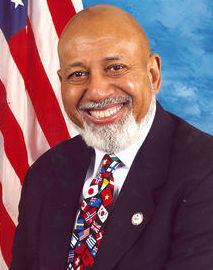 | Cong. Alcee Hastings [D]
District 20
2353 Rayburn HOB
Washington, D.C. 20515
Phone: 202-225-1313
Fax: 202-225-1171
WEBSITE
DISTRICT OFFICE:
2701 W. Oakland Park Boulevard
Suite 200
Oakland Park, FL 33311
Phone: 954-733-2800
Fax: 954-735-9444
EMAIL PAGE |
|
| | | |
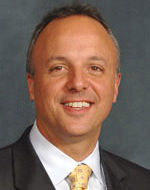 | Cong. Ted Deutch [D]
District 21
1024 Longworth HOB
Washington, D.C. 20515
Phone: 202-225-3001
Fax 202-225-5974
WEBSITE
DISTRICT OFFICE:
2500 N. Military Trail, Suite 490
Boca Raton, FL 33431
Phone: 561-988-6302
Fax: 561-988-6423
EMAIL PAGE |
|
 | Cong. Lois Frankel [D]
District 22
1037 Longworth HOB
Washington, DC 20515
Phone: 202-225-9890
WEBSITE
DISTRICT OFFICE:
2500 N. Military Trail
Suite 490
Boca Raton, FL 33431
Phone: 561-998-9045
EMAIL PAGE |
|
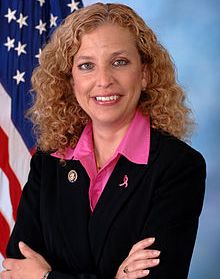 | Congresswoman Debbie
Wasserman-Schultz [D]
District 23
118 Cannon HOB
Washington, D.C. 20515
Phone: 202-225-7931
FAX: 202-226-2052
WEBSITE
DISTRICT OFFICE:
10100 Pines Boulevard,
Pembroke Pines, FL 33026
Phone: 954-437-3936
Fax: 954-437-4776
EMAIL PAGE |
|
|
|
 | Cong. Frederica Wilson
[D] District 24
208 Canon HOB
Washington, DC 20515
Phone: 202-225-4506
FAX: 202-226-0777
WEBSITE
DISTRICT OFFICE:
18425 N.W. 2 Avenue
Miami Gardens, FL 33169
Phone: 305-690-5905
Fax: 305-690-5951
EMAIL PAGE |
|
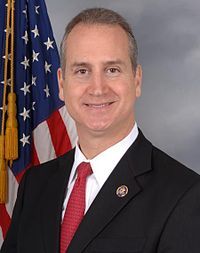 | Cong. Mario Diaz-Balart
[R] District 25
436 Cannon HOB
Washington, D.C. 20515
Phone: 202-225-4211
Fax: 202-226-8576
WEBSITE
DISTRICT OFFICE:
8669 N.W. 36 Street, #100
Doral, FL 33166
Phone: 305-470-8555
Fax: 305-470-8575
EMAIL PAGE |
|
|
| | | |
Our Beach is in Your Hands!!!!

Well - what are you waiting for? Stop reading this and find a pen or pick up the phone. Chop Chop!
 | | BROWARD BEACH RENOURISHMENT - SEGMENT II |

The City Decides to Act


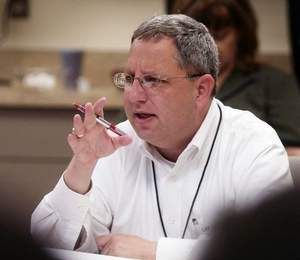 | | CITY MANAGER LEE FELDMAN |
August 19, 2013 - On October 30, 2012, City Manager Lee Feldman convened a round table meeting to examine the City�s Sea Turtle policies. Joining Feldman in City Hall - around a score of utility tables - were officials from the Galt Mile Community Association, the Central Beach Alliance and other beachfront neighborhoods, District 1 City Commissioner Bruce Roberts, Assistant City Manager Susanne Torriente (the City Manager�s liaison to Sustainable Development - parent agency to the building and code enforcement departments), Building Department chief Terry Burgess, Director Greg Brewton of Sustainable Development, Code Enforcement Manager Skip Margerum, Assistant City Attorney Carrie Sarver, Director Al Carbon from Public Works as well as a half dozen departmental and divisional support staffers. Problems stemming from the City�s 2003 Beach Lighting Ordinance and Florida Fish and Wildlife Conservation Commission (FWC) nest marking policies had soured neighborhoods, stigmatized tourism and devolved the City�s beaches into demilitarized zones.
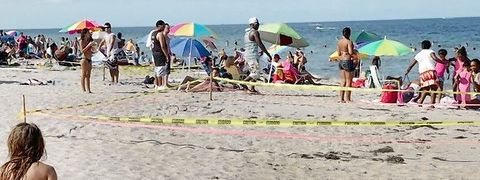 | | 2012 - KING SIZE NEST SITE ON FORT LAUDERDALE BEACH |
For decades, thousands of visitors and resident beachgoers enjoyed sharing the beach with nest sites enveloped in 10-foot square protective zones. In 2012, the Florida Fish and Wildlife Conservation Commission (FWC) made an insipid decision to expand each site by a factor of ten, exploding 100 square-foot nest sites to 1000 square feet. Coupled with an unanticipated 50% increase in nesting activity throughout the 9-month season, residents and vacationers in coastal communities across Florida complained bitterly about being functionally ousted from their beaches. After meeting with Galt Mile officials, former manager Lou Fisher of Broward County�s Sea Turtle program contacted FWC and elicited a revised ruling for future nest sites. Thanks to Fisher, nest sites were returned to an average 5-foot radius, allowing the beach to once again become a shared resource.
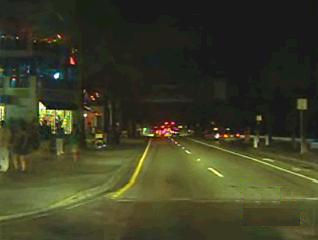 | | A1A AT NIGHT - FORT LAUDERDALE GHOST TOWN |
While pleased about Fisher�s successful initiative, Fish and Wildlife directives fall outside the City�s purview. Officials at the October meeting were primarily focused on mitigating unintended consequences of the City�s poorly drafted 2003 Beach Lighting Ordinance. In addition to wreaking havoc on the City�s tourism industry, a policy that forced the entire beach area into darkness for 75% of the year was fatally crippling the beach neighborhood�s viability as an economic engine, imperiling drivers and pedestrians along A1A and opening serious security and safety breaches in beachfront residential communities.
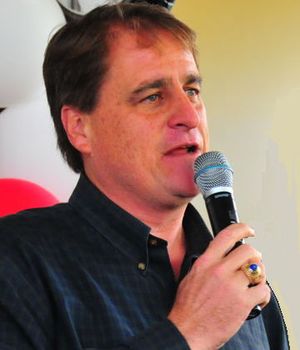 | | MAYOR JACK SEILER |
In beachfront hotels, management personnel reported complaints by scores of visiting tourists that �fear of crossing the street� would preclude their return. Equally frightened local residents don�t have the option of not returning. As observed by Mayor Jack Seiler, �The problem is there's a safety issue down there. It�s gotten too dark. As much as I think every one of us has been very involved in trying to protect the sea turtles, you can't do that at the expense of human life. You�ve got traffic, pedestrian issues, cycling issues.� Since consequences of the ordinance that were marginalized when passed in 2003 have since mushroomed into significant threats, officials would have to reshape the ordinance to promote Sea Turtle survival without crippling the City or endangering its residents.
As the meeting progressed, it became clear that the public safety pitfalls were exacerbated by the City�s enigmatic enforcement policies. Representatives from the city�s beach neighborhoods complained about the cost of satisfying inconsistent and ever-changing enforcement protocols, regulatory conflicts between the beach lighting ordinance and building code-mandated lighting requirements for resident safety and security (on parking decks, public access areas, fire exits, etc.), enigmatic violations for reflected light (or cloudlight) and confusion over security lighting, whether insurer-required or in response to the increasing number of assaults on association residents and property launched from the beach.
Enforcement Dilemmas

 Although the current ordinance was passed in 2003, enforcement was postponed until after the City recovered from the serial hurricanes of 2004 and 2005. In March of 2007, the first violation notices awoke perplexed neighborhoods to its existence. Following a late 2010 upheaval in the building department, one of the casualties of a turnover in the department�s administration was an agreement hammered out in 2007 between the Galt Mile neighborhood and the City. A balanced set of code enforcement protocols for beach lighting enabled the Galt Mile to achieve more than 90% compliance within the first two years of the agreement. Associations worked closely with Code officials to create a series of specific objectives en route to full compliance with the lighting ordinance. Although the current ordinance was passed in 2003, enforcement was postponed until after the City recovered from the serial hurricanes of 2004 and 2005. In March of 2007, the first violation notices awoke perplexed neighborhoods to its existence. Following a late 2010 upheaval in the building department, one of the casualties of a turnover in the department�s administration was an agreement hammered out in 2007 between the Galt Mile neighborhood and the City. A balanced set of code enforcement protocols for beach lighting enabled the Galt Mile to achieve more than 90% compliance within the first two years of the agreement. Associations worked closely with Code officials to create a series of specific objectives en route to full compliance with the lighting ordinance.
 After 2010, enforcement officials began waffling about infractions. The open two-way communication that facilitated compliance lapsed overnight. Code officers would issue violations for lighting plans approved as compliant one year earlier. Instead of working with associations to resolve possible violations, they made general suggestions, albeit with a caveat that following their suggestions would not assure compliance. After 2010, enforcement officials began waffling about infractions. The open two-way communication that facilitated compliance lapsed overnight. Code officers would issue violations for lighting plans approved as compliant one year earlier. Instead of working with associations to resolve possible violations, they made general suggestions, albeit with a caveat that following their suggestions would not assure compliance.
 Only after an association expended resources to implement the officer�s suggestion, student volunteers from NOVA University would assess corrected violations during evening patrols of the shoreline. NOVA students recruited by the Broward County Sea Turtle program - a licensee of Florida Fish and Wildlife - would note perceived lighting violations from an ATV traveling across the beach. Based on the few minutes they flew by each building at night, they would submit complaints to the City�s Code Enforcement Department. Included in their complaints were lights previously deemed compliant by a Code Officer, such as lamps fitted with motion detectors that toggle on and off automatically when a resident needs to safely navigate a walkway or a trespasser invades association property from the darkened beach. Only after an association expended resources to implement the officer�s suggestion, student volunteers from NOVA University would assess corrected violations during evening patrols of the shoreline. NOVA students recruited by the Broward County Sea Turtle program - a licensee of Florida Fish and Wildlife - would note perceived lighting violations from an ATV traveling across the beach. Based on the few minutes they flew by each building at night, they would submit complaints to the City�s Code Enforcement Department. Included in their complaints were lights previously deemed compliant by a Code Officer, such as lamps fitted with motion detectors that toggle on and off automatically when a resident needs to safely navigate a walkway or a trespasser invades association property from the darkened beach.
 To mitigate the perception that the City�s Code Enforcement Administration ceded their enforcement responsibilities to NOVA students, they provided a loophole. Any association that was actively working with a code enforcement officer would temporarily be spared a violation notice. As associations grew leery of funding code officer-recommended lighting solutions that were subsequently and systematically rejected, �working with a code officer� became spin for funneling scarce association resources into a black hole. To mitigate the perception that the City�s Code Enforcement Administration ceded their enforcement responsibilities to NOVA students, they provided a loophole. Any association that was actively working with a code enforcement officer would temporarily be spared a violation notice. As associations grew leery of funding code officer-recommended lighting solutions that were subsequently and systematically rejected, �working with a code officer� became spin for funneling scarce association resources into a black hole.
 When association officials investigated this counterproductive �Catch-22� scenario, two frustrated code officers admitted that they lacked the authority to guide property owners seeking to comply with the City�s ordinance. Agreements they hashed out with homeowners or associations that were approved by supervisors were later abrogated by Code managers leery of political missteps. Instead, officers were told to suggest that the property owner contact Fish and Wildlife � a state agency - about correcting a City violation. When association officials investigated this counterproductive �Catch-22� scenario, two frustrated code officers admitted that they lacked the authority to guide property owners seeking to comply with the City�s ordinance. Agreements they hashed out with homeowners or associations that were approved by supervisors were later abrogated by Code managers leery of political missteps. Instead, officers were told to suggest that the property owner contact Fish and Wildlife � a state agency - about correcting a City violation.
 Given its inherent ambiguities, depending on how an Enforcement Officer elects to interpret the current ordinance, virtually anything visible from the beach is arguably evidence of a violation. Meant to deter illumination of the beach, the ordinance prohibits either direct or reflected artificial light from reaching the beach. Since visibility requires light that emanates from or bounces off an object to register an impression on an observer�s eye (retina), anything visible to an observer on the beach is technically evidence that light is reaching the beach. When this unintended standard is applied, a property can only achieve compliance when an observer on the beach looks westward toward the City and sees a pitch black horizon. By creatively misinterpreting the ordinance, a Code officer with an �agenda� can penalize property owners for any artificial light, whether or not it illuminates the beach. Given its inherent ambiguities, depending on how an Enforcement Officer elects to interpret the current ordinance, virtually anything visible from the beach is arguably evidence of a violation. Meant to deter illumination of the beach, the ordinance prohibits either direct or reflected artificial light from reaching the beach. Since visibility requires light that emanates from or bounces off an object to register an impression on an observer�s eye (retina), anything visible to an observer on the beach is technically evidence that light is reaching the beach. When this unintended standard is applied, a property can only achieve compliance when an observer on the beach looks westward toward the City and sees a pitch black horizon. By creatively misinterpreting the ordinance, a Code officer with an �agenda� can penalize property owners for any artificial light, whether or not it illuminates the beach.
GMCA & Code Enforcement

 | | VICE MAYOR BRUCE ROBERTS |
While discussing enforcement dilemmas in beachfront neighborhoods at the October 30th meeting, Vice Mayor Bruce Roberts asked how these problems might be specifically resolved in the Galt Mile neighborhood. When he suggested a meeting with GMCA and Code Enforcement officials, GMCA President Pio Ieraci and Code Manager Skip Margerum agreed.
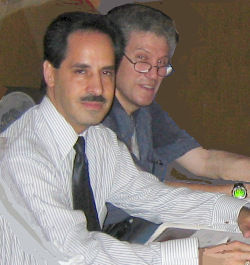 | GMCA OFFICIALS PIO IERACI
& ERIC BERKOWITZ |
On November 27, Ieraci and GMCA Vice President Eric Berkowitz met with Margerum and his two senior Code officers assigned to beach lighting enforcement. At the outset, both sides agreed to revive an understanding critical to associations. If a violation involves a major fixture, such as a security or parking deck lamp, the officer would recommend an inexpensive shield to temporarily block light from reaching the beach. To achieve permanent compliance without unnecessarily burdening association budgets or creating a gauntlet of dangerous tripping hazards, when the fixture approached the end of its useful life and was budgeted for replacement, the association would incorporate a turtle-safe substitute into its new lighting plan.
 | CODE BOSS
SKIP MARGERUM |
Having agreed to reopen unfettered communication, the Department and the neighborhood association would otherwise work together to identify and cure violations. The discussion then turned to why the Code Department issues violations for lighting plans recommended by their own officers. Apologizing for any confusion, Margerum said that even if an association corrects the problem; due to how the ordinance is worded, it may technically remain in violation. Conceding that many of its provisions are unclear and open to interpretation, Margerum declared that he must enforce the ordinance as he understands it. He said that his officers would work with any association to find an acceptable and reasonable solution, adding that associations could always request guidance from Fish and Wildlife. In closing, Margerum announced that unless the City changes the law, we would just have to work together to make the best of it.
Shaping a New Law

 Convinced that the law should protect both people and turtles, Feldman closely scrutinized the Fort Lauderdale ordinance. In 1993, the state of Florida developed a model lighting ordinance (62B-55, F.A.C.) to guide local governments in creating turtle-safe lighting laws. Broward County adopted Chapter 39, Article IX, Sec 39-107 in 1989. Ten years later, Pompano Beach followed their lead (Title XV, Chapter 155, Section 155.139), Deerfield Beach in 2000 (Chapter 34, Article V, Sec 34-96), Hallandale Beach in 2001 (Ch. 6, Art. I, Sec 6-10), Lauderdale-by-the-Sea in 2002 - Chapter 30 Article V Division 2 Subdivision L Sec. 30-313 (o), Fort Lauderdale in 2003 (Chapter 6, Article III, Div. 2, Sec. 6-51), Hillsboro Beach in 2007 (Ord 232), and Hollywood in 2011 (Title IX, Chapter 108). Convinced that the law should protect both people and turtles, Feldman closely scrutinized the Fort Lauderdale ordinance. In 1993, the state of Florida developed a model lighting ordinance (62B-55, F.A.C.) to guide local governments in creating turtle-safe lighting laws. Broward County adopted Chapter 39, Article IX, Sec 39-107 in 1989. Ten years later, Pompano Beach followed their lead (Title XV, Chapter 155, Section 155.139), Deerfield Beach in 2000 (Chapter 34, Article V, Sec 34-96), Hallandale Beach in 2001 (Ch. 6, Art. I, Sec 6-10), Lauderdale-by-the-Sea in 2002 - Chapter 30 Article V Division 2 Subdivision L Sec. 30-313 (o), Fort Lauderdale in 2003 (Chapter 6, Article III, Div. 2, Sec. 6-51), Hillsboro Beach in 2007 (Ord 232), and Hollywood in 2011 (Title IX, Chapter 108).
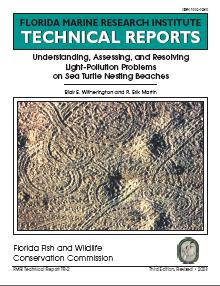 The State template was based on research by FWS scientists. State environmentalists realized that every beachfront jurisdiction experiences a unique blend of economic, social, structural, environmental and political problems. Commercial beachfront neighborhoods face different structural lighting challenges than communities where high-rise buildings shield the beach from street lights. Cities also had to avoid inadvertently undermining the municipal economies that fuel their survival. Most importantly, municipalities had to guard against implementing provisions that placed city residents and/or visitors at risk. The State template was based on research by FWS scientists. State environmentalists realized that every beachfront jurisdiction experiences a unique blend of economic, social, structural, environmental and political problems. Commercial beachfront neighborhoods face different structural lighting challenges than communities where high-rise buildings shield the beach from street lights. Cities also had to avoid inadvertently undermining the municipal economies that fuel their survival. Most importantly, municipalities had to guard against implementing provisions that placed city residents and/or visitors at risk.
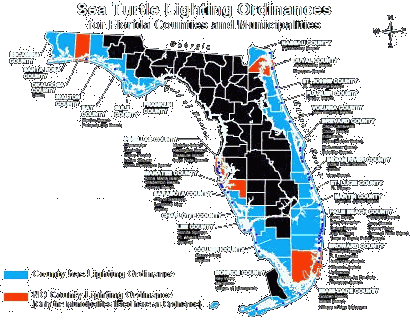 After examining the original state template, Feldman reviewed the Broward County Ordinance, variations enacted by other Broward municipalities and the local beach lighting laws of coastal communities throughout Florida. Most jurisdictions treated the State Template like a supermarket, selecting those provisions that best suited their needs. Some deployed all or most of the provisions while others chose one or two. Certain cities and counties dumped the State model and created their own homegrown regulations while others � like Miami-Dade � refused to pass a lighting law. Since most of Florida�s coastal cities and towns depend on their beach economy to survive, many performed an economic impact study to minimize unintended consequences. After examining the original state template, Feldman reviewed the Broward County Ordinance, variations enacted by other Broward municipalities and the local beach lighting laws of coastal communities throughout Florida. Most jurisdictions treated the State Template like a supermarket, selecting those provisions that best suited their needs. Some deployed all or most of the provisions while others chose one or two. Certain cities and counties dumped the State model and created their own homegrown regulations while others � like Miami-Dade � refused to pass a lighting law. Since most of Florida�s coastal cities and towns depend on their beach economy to survive, many performed an economic impact study to minimize unintended consequences.
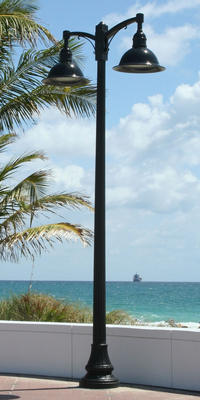 | | FWC APPROVED LAMP |
Fort Lauderdale was not among them. To prove their environmental commitment, 2003 City Commissioners aggressively expanded on the State model, randomly piling on additional regulations thought to enhance its effectiveness or enlist homeowner support. Unfortunately, the ill-defined hand waving additions created enforcement dogma. Commissioners mistakenly believed that Code Enforcement would compensate for safety and security pitfalls, inadvertently forcing the Department to walk a tightrope between conflicting enforcement objectives. The sycophantic mission statement was a poor substitute for clear enforcement protocols.
 The 2003 City Commission never anticipated the adverse impacts currently facing the City. In 2007, when FWC decided to stop relocating nests from well-lit �donor zones� to darkened recipient beaches, the City Commission unexpectedly came face to face with the untenable terms in an ordinance they foisted on residents. For example, canvas bags were temporarily fitted to city-owned acorn-style fixtures along the east side of A1A to shield the beach. Cobra-style lights owned by FDOT and FPL on the west side of the road were retrofitted with shielded fixtures. The City retained consultant Chen Moore & Associates to devise a compliant permanent fixture that was subsequently approved by FWC on October 15, 2008. The 2003 City Commission never anticipated the adverse impacts currently facing the City. In 2007, when FWC decided to stop relocating nests from well-lit �donor zones� to darkened recipient beaches, the City Commission unexpectedly came face to face with the untenable terms in an ordinance they foisted on residents. For example, canvas bags were temporarily fitted to city-owned acorn-style fixtures along the east side of A1A to shield the beach. Cobra-style lights owned by FDOT and FPL on the west side of the road were retrofitted with shielded fixtures. The City retained consultant Chen Moore & Associates to devise a compliant permanent fixture that was subsequently approved by FWC on October 15, 2008.
 | FORMER BROWARD TRAFFIC ENGINEER JIHAD EL EID
GOT $150,000, A NEW CAR AND A JOB FOR HIS NEPHEW |
 In 2011, the City gave Southeast Underground Utilities Corp. � a Davie company � $1.7 million to replace 110 acorn-style lamps along 2 miles of A1A with the FWC-approved recessed fixtures (The company was simultaneously being sued by Broward County for for defective work after padding a $4.4 million low-bid contract into a $21.3 million windfall. On February 13, 2013, owner and President Anthoneel Allen pled guilty to Federal charges for bribery, highway fraud, mail fraud, extortion under color of official right, tax fraud, and Disadvantaged Business Enterprise fraud � for greasing former Broward Traffic Engineer Jihad El Eid and gaming the system to land dozens of State, County and local municipal contracts). Although FWC approved the interim shields for 150 FDOT and FPL owned lamps on the west side of A1A, they were extinguished throughout the nine-month 2012 nesting season, transforming the world-renowned Ocean Highway into a potential death trap. In 2011, the City gave Southeast Underground Utilities Corp. � a Davie company � $1.7 million to replace 110 acorn-style lamps along 2 miles of A1A with the FWC-approved recessed fixtures (The company was simultaneously being sued by Broward County for for defective work after padding a $4.4 million low-bid contract into a $21.3 million windfall. On February 13, 2013, owner and President Anthoneel Allen pled guilty to Federal charges for bribery, highway fraud, mail fraud, extortion under color of official right, tax fraud, and Disadvantaged Business Enterprise fraud � for greasing former Broward Traffic Engineer Jihad El Eid and gaming the system to land dozens of State, County and local municipal contracts). Although FWC approved the interim shields for 150 FDOT and FPL owned lamps on the west side of A1A, they were extinguished throughout the nine-month 2012 nesting season, transforming the world-renowned Ocean Highway into a potential death trap.
 | | TURTLE-SAFE LAMPS INSTALLED ALONG A1A |
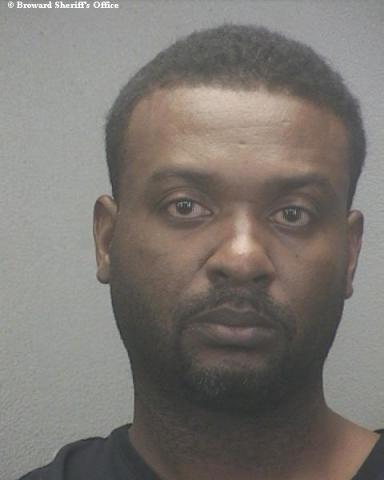 | | ANTHONEEL ALLEN |
To protect residents and visitors, insure that drivers and pedestrians don�t wind up in the morgue, salvage threatened beachfront neighborhood economies and provide the Code Department with a less ambiguous set of enforcement guidelines, the City Commission would have to clean up the beach lighting ordinance. Having investigated how other coastal communities tempered the State model, Feldman decided to trim most of the whimsical text added by predecessors in City Hall. He also elicited input from Broward Sea Turtle Program Manager Lou Fisher and FWC Beach Lighting expert Karen Schanzle. To secure sea turtle survival without gutting public safety, the revised City Beach Lighting ordinance would adapt standards contained in the State Model to the City�s current needs.
Public Input

 Trawling for public opinion on the City Website, Feldman posted a copy of the current ordinance, the State model and a redlined version that distinguishes the proposed changes. To collect additional feedback, the City scheduled town hall style meetings on June 10th at the Beach Community Center and on June 26th at the International Swimming Hall of Fame. Trawling for public opinion on the City Website, Feldman posted a copy of the current ordinance, the State model and a redlined version that distinguishes the proposed changes. To collect additional feedback, the City scheduled town hall style meetings on June 10th at the Beach Community Center and on June 26th at the International Swimming Hall of Fame.
 Although organized to solicit public input about the proposed ordinance revision, those with radical views about sea turtle policies drooled over a perceived opportunity to vent. Residents and public officials who arrived at the Beach Community Center before the 6:30 PM kickoff expected an ideological prizefight pitting the life safety needs of city residents against the survival of a species. Attendees registered to speak upon entering the auditorium. Since a division that split the audience wasn�t where expected, conflict junkies were disappointed. Although organized to solicit public input about the proposed ordinance revision, those with radical views about sea turtle policies drooled over a perceived opportunity to vent. Residents and public officials who arrived at the Beach Community Center before the 6:30 PM kickoff expected an ideological prizefight pitting the life safety needs of city residents against the survival of a species. Attendees registered to speak upon entering the auditorium. Since a division that split the audience wasn�t where expected, conflict junkies were disappointed.
In Round One, members of sea turtle support groups lashed out at the City for embracing changes to the ordinance. One accused public officials of breaking Federal and State laws. Not to be �theatrically trumped� by her companion, another announced that they were �initiating environmental genocide.� An angry Coral Ridge resident retorted that insufficient lighting along A1A �is an invitation to disaster� for both drivers and neighborhood residents. A resident from the Birch Park Finger Streets exclaimed �I�m afraid to walk one block from my house to the beach at night, and so are all of my neighbors.�
  Blurring the agenda, an employee at the FAU astronomical observatory proceeded to make an evolutionary case against all artificial lighting. Insisting that we are a diurnal species ill-adapted to productive post-sundown behavior, he concluded that man-made lighting is anathema to human health (actually, the pineal gland produces cancer-fighting melatonin in the absence of blue wavelength light (500 nm) - whether from the sun or a light bulb). It was unclear how he planned to detoxify civilization from its dependence on electric lights. Blurring the agenda, an employee at the FAU astronomical observatory proceeded to make an evolutionary case against all artificial lighting. Insisting that we are a diurnal species ill-adapted to productive post-sundown behavior, he concluded that man-made lighting is anathema to human health (actually, the pineal gland produces cancer-fighting melatonin in the absence of blue wavelength light (500 nm) - whether from the sun or a light bulb). It was unclear how he planned to detoxify civilization from its dependence on electric lights.
 | | LAUDERDALE BEACH ATTORNEY STEVE LANGE |
While hardliners on either side dramatically embellished their two minutes with visions of holocaust, most speakers favored a reasonable solution. A beachfront merchant complained that after installing turtle friendly lighting recommended by a Code Officer, he received another warning. �I want to do the right thing, but turning neighborhoods into ghost towns isn�t the answer.� A Bermuda Riviera resident said �I have been an environmental activist all my life, and I agree that we need to turn down the beach lighting, but we must also protect people.� Lauderdale Beach Attorney Steve Lange commented �We want to balance sea turtle life with human life, but not at the expense of human life.� Another woman who said she regularly checks on nest sites agreed that both people and nesting beaches must be protected. �It will never be perfect, but with planning and education we can have both.�

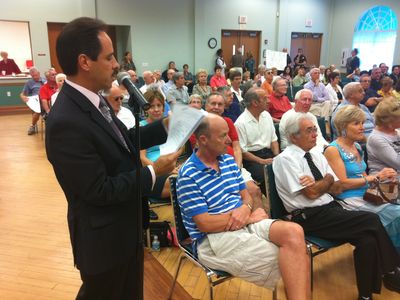 | | GMCA PRESIDENT PIO IERACI |
GMCA President Pio Ieraci told the audience �Every beach resident understands the need to preserve our endangered Sea Turtles.� Ieraci said that when kids vandalize turtle nests, they aren�t chased off by members of turtle support groups or the police, but by people living on the beach. Citing their contribution to the huge explosion in nest sites last year, Ieraci remarked �Although many of our residents bought their homes twenty or thirty years ago and live on fixed incomes, they�ve already spent hundreds of thousands of dollars for new lighting plans to protect sea turtles.� Ieraci insisted �Like every other city resident and visiting tourist, they deserve to be safe and secure. There must be a balance.�
Learning from Our Mistakes

 | RETIRED BROWARD SEA TURTLE
PROGRAM ARCHITECT LOU FISHER |
By adapting or replacing selected lamps with turtle-safe fixtures, the revised beach lighting ordinance will allow the City to reasonably illuminate coastal roads and neighborhoods. During the meeting, City Commissioner Dean Trantalis and Sea Turtle Aficionado Lou Fisher discussed how to best illuminate A1A while District 1 Commissioner Bruce Roberts explained the proposed ordinance revisions to constituents.
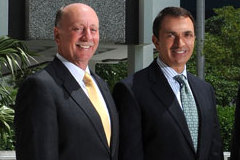 | | COMMS. BRUCE ROBERTS & DEAN TRANTALIS |
Commissioner Roberts assured residents that lamps are compliant under the new ordinance as long as the �point source of light� (bulb) and reflecting surfaces of a fixture are not visible from the beach. Unfortunately, other provisions in the ordinance appear to contradict this attempted clarification. In fact, unless they are addressed before the new law is finalized; every lamp in beach neighborhoods could be targeted for violation, whether or not it illuminates the beach.
While a step in the right direction, some of the new public safety standards apply exclusively to City properties; and not those of its citizens. As the City continues to collect input over the next month or two, homeowners in beachfront neighborhoods will have an opportunity to insure that reasonable enforcement protocols apply to their homes as well.
  For instance, the compliance glide path for an association�s major lighting fixtures � although agreed to by Code Enforcement � should be spelled out in the ordinance. The ordinance should also provide for security lighting � whether affixed to motion detectors and/or integrated into a home�s video surveillance protection. Additionally, some of the proposed provisions should be adequately clarified and/or better defined. For instance, a provision mandating costly upgrades to nearly a half million windows throughout the city (some more than a quarter mile from the beach) needs to be �better tailored� to its intended purpose. More to Come... For instance, the compliance glide path for an association�s major lighting fixtures � although agreed to by Code Enforcement � should be spelled out in the ordinance. The ordinance should also provide for security lighting � whether affixed to motion detectors and/or integrated into a home�s video surveillance protection. Additionally, some of the proposed provisions should be adequately clarified and/or better defined. For instance, a provision mandating costly upgrades to nearly a half million windows throughout the city (some more than a quarter mile from the beach) needs to be �better tailored� to its intended purpose. More to Come...

Click To Top of Page

 | SAND PILED ALONG BEACH AND FLOODED A1A
(GREAT SHOT BY ART SEITZ) |
 | | PRESIDENTS COUNCIL MEET AT PLAZA EAST |
December 17, 2012 - On December 3, 2012, the Galt Mile Community Association convened a 7:30 PM Presidents Council Meeting at Plaza East Condominium. As is customary, the meeting was preceded by a brief introduction of a well-reputed local vendor (Custom Air Designs). After thanking Plaza East President Glenn Rollo for hosting the final meeting in 2012, Presidents Council Chair Pio Ieraci announced that the agenda was predominated by two issues that are critically important to Galt Mile residents and their associations. To address a growing community anger stemming from abusive and enigmatic Sea Turtle policies, an authoritative forum was configured to explain how these concerns will be resolved going forward. Since our future, both individually and as a community, is inextricably tied to the fate of our beach, we needed to know what remedies were being considered to restore Fort Lauderdale�s collapsed coast, 4 blocks of A1A and our Galt Mile beach.
Sea Turtle Forum � Monster Nests


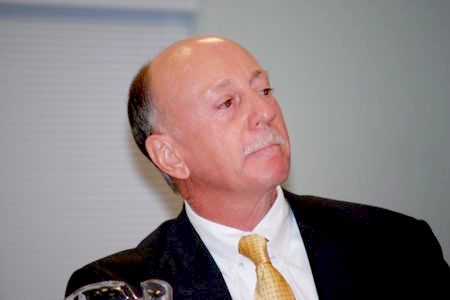 | | CITY COMMISSIONER BRUCE ROBERTS |
At the meeting�s outset, GMCA President Pio Ieraci introduced City Commissioner Bruce Roberts, City Manager Lee Feldman and Broward Beach Administrator Eric Myers. Roberts was integral to assembling the Sea Turtle forum. Along with Feldman, he is examining the City�s current Sea Turtle policies in hopes of resolving adverse citywide consequences of the 2003 beach lighting ordinance. He has also committed to addressing the growing anger among his Galt Mile constituents over imbalanced Sea Turtle policies. Given the recent decimation of Broward�s beaches, Myers� status as the County�s beach renourishment sparkplug has catapulted his importance to beachfront municipalities that desperately need his skills and his sand. Wearing two hats, Feldman was also expected to shed light on the crushing devastation suffered by area beaches and the tidal damage to A1A. They were all in for a bumpy night.
 | BROWARD SEA TURTLE PROGRAM
MANAGER LOU FISHER |
Instead of asking participants to prepare presentations that drew on their respective areas of expertise, Ieraci opted for a Town Hall style panel that would interactively engage attending association officials. After introducing the panel members and outlining the format, Ieraci called on Broward County Natural Resource Specialist III Lou Fisher to tackle the nest size anathema. Founder of the Broward County Sea Turtle program, Fisher told members that a Florida Fish and Wildlife Conservation Commission (FWC) approved attempt to collect hatchling behavioral data required roping off the nest area and much of the hatchlings� projected postnatal route to the ocean. �We were overwhelmed by the unexpected 50% increase in nesting events,� admitted Fisher, �We weren�t prepared for more than 700 nests on local beaches.� According to Fisher, when FWC realized the adverse impact of the enormous nest sizes, they changed their directive to roping off one large nest zone and 4 smaller ones. In the confusion that followed, Nova student volunteers who were marking the nests bungled the new orders, and continued cushioning nests with huge parcels of beach through the end of the nesting season.
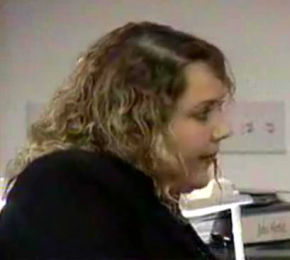 | | L�HERMITAGE I MANAGER PAT QUINTERO |
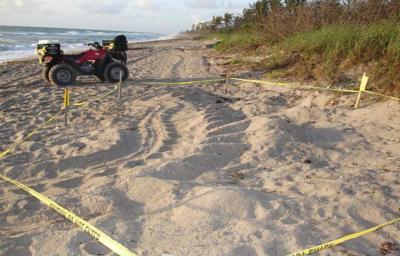 | | THIS YEAR'S TURTLE NEST SIZE |
Apologizing for the garbled communication, Fisher revealed the Agency�s directive for next year�s nests, �FWC has ordered that nests be encircled by a 3-foot radius (6-foot diameter).� Instead of 30-foot square fortifications built around 900 to 1000 sq. ft. of beach, next year�s nests will consume only 28 sq. ft. In view of what happened this year, Fisher added �FWC plans to closely monitor the beaches next year.� L�Hermitage I Manager and Advisory Board member Pat Quintero asked Fisher, �What will happen if the number of nests explodes again, so that the smaller nests still take up most of the beach?� Fisher told her that they (FWC) would meet and adjust the marking rules as needed, remarking �One idea is to mark off an outer perimeter with posts identifying individual nest sites.�
 | | FORT LAUDERDALE BUILDING DEPARTMENT |
As the Broward permit holder, Lou Fisher administers nest management throughout the county. However, the only agency empowered to enforce beach lighting regulations on the Galt Mile is City of Fort Lauderdale Code Enforcement. Among the forum�s City participants were Code Enforcement Supervisor Skip Margerum and the two Code officers who specialize in beach lighting compliance, Dick Eaton and Ingrid Gottlieb. While Eaton monitors compliance in the City�s southern beach neighborhoods, Gottlieb is assigned to the northern City beaches, including the Galt Mile. Representing the State was FWC lighting expert Karen Schanzle (Environmental Specialist II with the Marine Turtle subsection of Imperiled Species Management at Florida FWC).
Galt Mile Sea  Turtle Lighting Turtle Lighting

 | CODE BOSS
SKIP MARGERUM |
When Southpoint Director Michael Katz complained about shifting lighting requirements, Ieraci directed his question to Skip Margerum. The City Code Enforcement Manager explained that a turnover in Code officers in the past few years created an unfortunate lack of continuity. Ieraci commented that the same thing occurs annually in associations, as new board members or a new manager will notice a dark area behind the building and install new lights without verifying compliance. An attendee interjected that his association was violated for a lamp that was approved by the building department for a permit and subsequently passed inspection.
 When an association applies for a permit, its approval by the Building Department is based on the application�s conformity with the Florida Building Code, which local governments are empowered by statute to interpret and enforce. Since the turtle-safe lighting ordinance is a city law, and not part of the State building code, compliance is not considered when vetting an application for a building permit. Unfortunately, when homeowners or associations are awarded a permit, they often mistakenly believe that the project also complies with the City�s beach lighting ordinance. When an association applies for a permit, its approval by the Building Department is based on the application�s conformity with the Florida Building Code, which local governments are empowered by statute to interpret and enforce. Since the turtle-safe lighting ordinance is a city law, and not part of the State building code, compliance is not considered when vetting an application for a building permit. Unfortunately, when homeowners or associations are awarded a permit, they often mistakenly believe that the project also complies with the City�s beach lighting ordinance.
 | GALLEON PRESIDENT
BOB KORN |
 | LIGHTING GURU
KAREN SCHANZLE |
Margerum said �Before making changes to your exterior lighting, contact us. If you meet with your Code officer at that stage, achieving compliance with the City ordinance will often cost little or nothing.� When Katz asked if there existed some �certification� that would protect an association from future violations, Ieraci called on the FWC lighting expert Karen Schanzle. While FWC does approve comprehensive association lighting plans, they will not approve individual fixtures or partial plans since compliance also depends on how and where the lamps are installed. Schanzle also said that FWC maintains a list of turtle friendly lighting fixtures and manufacturers on its website. However, for a vast majority of lighting situations, pre-approval by the local Code Officer will suffice. President Bob Korn of Galleon said that his association had retained lighting experts to devise a compliant lighting strategy. Margerum suggested that Korn contact Ingrid Gottlieb before spending additional funds on a turtle-safe lighting plan.
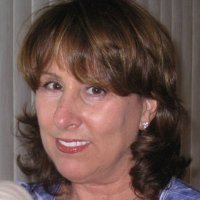 | | SOUTHPOINT PRESIDENT LISA LAMARCA |
Currently amid a balcony replacement project, President Lisa LaMarca of Southpoint asked if the Code officer would attend a meeting with their contractor. Gottlieb explained that while she isn�t qualified to make technical lighting decisions, she can provide an association with free access to FWC lighting experts like Karen Schanzle. Schanzle added that she would be glad to examine any association�s lighting needs and provide free guidance.
 | | BLAIR WITHERINGTON |
Intimating that FWC may be perpetuating some elaborate hoax, one suspicious association official questioned whether there was any research supporting FWC claims about what turtles can and can�t see. Schanzle named several renowned FWC researchers, including Blair Witherington, whose work with Marine Turtles is voluminous and nationally acclaimed.
 | | PDM's FRED NESBITT |
Playa del Mar Treasurer and GMCA Board Member Fred Nesbitt told Margerum �Lamps on our pool deck approved only last year were recently cited as non-compliant.� Margerum suggested that the current deck plan may have been approved subject to changes in the future. It is not unusual for a code officer to authorize a long term plan to achieve compliance in which the interim steps are approved although still non-compliant. Admitting that he didn�t know who supposedly approved the 15 lamps in Playa�s pool area, Nesbitt couldn�t confirm what transpired.
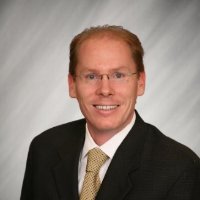 | | CONTINENTAL V.P. BILL WORRALL |
 | BEACH RAKER PROPRIETOR
TIMOTHY GREENER |
A half dozen unfamiliar faces in the audience belonged to association officials from other neighborhoods (who requested / received permission to attend). Burdened by the same skewed Sea Turtle policies that afflict the Galt Mile, the revisions will also impact their communities. Also in the audience was Continental Group Vice President Bill Worrall, who planned to impart what he learned to the property managers and board members of coastal associations managed by his company. Attending Beachraker proprietor Tim Greener was awaiting a new nest marking policy, since they spent the past year driving through the surf to circumvent the often impassable blockade of nest zones.
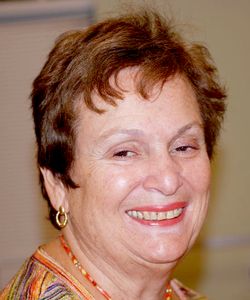 | PLAZA SOUTH CIVIC
ACTIVIST TERRY CLAIRE |
During the Sea Turtle forum, an underlying current of anxiety about the second part of the meeting agenda � our nearly non-existent beaches � surfaced several times. While Ieraci was taking questions for panelists, Plaza South Membership Committee Co-Chair and civic activist Terry Claire said that she was far more concerned by the devastation wrought by Hurricane Sandy, asserting that a neighborhood capable of expelling the Calypso gasworks could also somehow restore the lost beach. Pointing out the difference between fending off French megacartel �Suez� and recreating a beach, Ieraci announced that the beach dilemma will be addressed later in the agenda. When two other members similarly expressed impassioned concern for their diminished beach, they, too, were assured that the issue would be undertaken a few minutes later.
Upon adjourning the Sea Turtle Forum, Ieraci turned the meeting focus to reconstituting our skeletal beach and exploring recovery efforts. Pio stated that we are all fearful about the lost beaches and damage to A1A - whether rattled by the threat it poses to our lifestyle and/or the economic underpinnings of the City and the whole region. He observed that every Galt Mile resident is understandably spitting blood �over damage that could � and should � have been avoided.� He told attendees �Before we can reasonably discuss our options, we need to know what the City and County are planning, the extent of the damage, what recovery resources are available, recovery time frames and how this may impact the planned Segment II renourishment.�
Where�s the Beach?

 | | CITY MANAGER LEE FELDMAN |
An Advisory Board member asked City Manager Lee Feldman how Fort Lauderdale planned to mitigate the damaged shoreline and adjacent infrastructure. Before effecting repairs to the 4 blocks of A1A (from Northeast 14th to 18th Street) that was reduced to soggy rubble, Feldman said they must decide between rebuilding the 4-lane Ocean Highway or possibly add an oft-discussed greenway to the 2-lane thoroughfare that was hastily reconfigured from the roadway�s former southbound lanes.
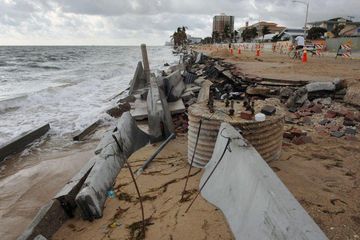 | CONCRETE WALL BARRIERS ALONG A1A
(PIC BY ART SEITZ) |
With concrete wall barriers installed as temporary breakwaters piled along the east side of the street and parking spaces next to a 6-foot pedestrian path lining the west, Feldman added that FDOT wants some �guarantee� that the reconstructed road will be protected from future storm surge. The only coastal engineering capable of shielding A1A (as well as $billions in upland property and infrastructure and thousands of lives) is a healthy beach. Instead of just adding more sand to the eroded shoreline, Feldman said �We need to find a more long term solution.� The City is currently exploring features that will resist increasing tidal erosion, including construction of an offshore reef. Ironically, this sustainable approach had been proposed by both Myers and predecessor Steve Higgins for decades.
 | STEPHEN HIGGINS
BEACH WIZZARD |
Higgins insisted on treating the entire Broward coast as a single ecosystem wherein the health of every segment depends on the stability of adjacent segments. Since 80% of the sand lost to tidal erosion occurs at coastal inlets like Port Everglades, fitting them with sand bypasses and implementing other erosion control architecture will serve to stabilize the beach. Instead of scheduling an endless series of expensive full scale renourishments, performing smaller, more frequent sand placements at a few easily identifiable erosion hot-spots would only require a fraction of the sand at a comparably reduced cost.
 | BROWARD BEACH
ADMINISTRATOR ERIC MYERS |
Broward Beach Administrator Eric Myers announced that State and Federal permits required for the Segment II renourishment are continuing through the approval process. One veteran Advisory Board member asked Myers what everyone was thinking, �With various short term and long term plans under consideration, can someone grab our sand to fix the beach where A1A is damaged? Is the Segment II renourishment still planned for next year?� 50 attendees breathed a collective sigh of relief when Myers retorted, �The major renourishment is still scheduled for December 2013.� Before the meeting, when asked if there was anything we could do to speed up our beach fix, Myers said that the county needed to collect money owed by the Federal government for the previous renourishment. He asked if the GMCA could coax our new Congress person (Lois Frankel?) to facilitate delivery of those funds. When asked about unused beach renourishment funds that former Congressman Alan West claimed to have diverted to Broward, Myers said that West never delivered. In short, the cash was snatched.
 | | FLORIDA GOVERNOR RICK SCOTT |
 | FEMA ADMINISTRATOR
CRAIG FUGATE |
When asked about Federal funds, Feldman warned that we should not expect help from the Federal government (since the Federal Emergency Management Agency (FEMA) rejected our eligibility for Federal resources) - and that any prospective solutions will be wholly dependent on local efforts and resources. On November 1, Governor Rick Scott requested Federal aid for Broward and six other Florida Counties where Super Storm Sandy cannibalized coastal infrastructure after stripping away protective beaches. Since Scott cleverly decided to spend the next five days before the presidential election firing a battery of non-stop pot shots at the Obama Administration, it came as no surprise when FEMA administrator Craig Fugate sent Scott a letter stating �Based on our review of all the information available, it has been determined that the damage to the infrastructure from this event was not of such severity and magnitude as to be beyond the capabilities of the state and affected local governments.� Jacksonville native Fugate, who currently lives in Gainesville, apparently forgot that he formerly served as Director of Florida Division of Emergency Management.
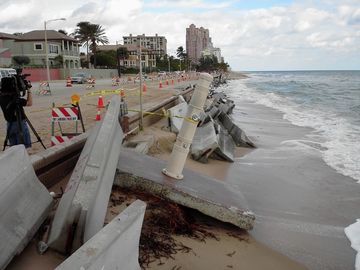 | | CONCRETE BARRIERS INSTALLED ALONG A1A (Thanks Art!) |
According to Feldman, a $3 million metal sheet pile installation and sand placement plan is the best shot at fixing A1A. The cost of building the sheet metal wall between the beach and the road would be split among the County, the City and FDOT. Despite the Federal snub, money is not expected to be a problem. Funds are available through a variety of sources, including the county�s tourism fund. While every long term plan is fitted with an 18-month timetable, post-planning construction for the short term fix will begin in January and should be completed by March.
To residents who hunger for fast-tracking a Galt Mile beach fix, here�s a nutshell version of reality - the only sand available in sufficient quantities for a long-term solution is vested in the planned Segment II renourishment. Expediting the timetable would require moving sand from staging areas to placement sites during the sea turtle nesting season. Since FDEP and FWC have a stranglehold on the County permit currently under application, the chances of busting a move are comparable to that of a snowball in hell. The same �roadblock� exists on the Federal level. The Army Corps of Engineers is answerable to EPA. Do the math.

Click To Top of Page




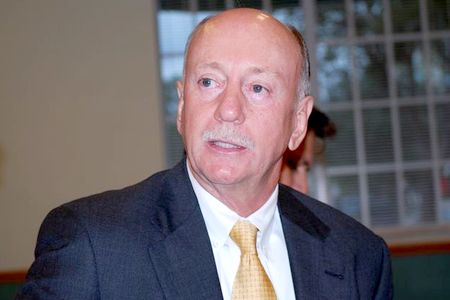 | | CITY COMMISSIONER BRUCE ROBERTS |
August 29, 2012 - At the May 17, 2012 GMCA Advisory Board meeting, among the community issues that City Commissioner Bruce Roberts pledged to address over the summer was an inconsistent and imbalanced enforcement policy for beachfront turtle-safe lighting. For 140 million years, nesting female sea turtles have been laying their eggs on our beaches. Their hatchling turtles were guided to the ocean by an instinct to travel away from the dark silhouettes of dune vegetation and toward the moonlight-illuminated open ocean.
 | | TURTLE HATCHLING DEATH TRAP |
In many highly populated coastal areas, artificial lights near the beach are brighter than the moonlit ocean, reversing the turtles� biological compass. Nesting females seeking the darkened shore instead head out to sea where they cannot lay their eggs. If they find the shore and successfully deposit their eggs, the disoriented hatchlings travel inland, toward the artificial lights, where they often die from dehydration or predation by fire ants and ghost crabs. They also become �road kill� on local thoroughfares.
 Sea turtles are either endangered or threatened (the loggerhead is the only species that has sufficient population to be classified as threatened in Florida). They are protected under the Federal Endangered Species Act of 1973 and Florida�s Marine Turtle Protection Act (379.2431, Florida Statutes). Florida Law (F.A.C. Rule 68E-1) also restricts molestation or harassment of marine turtles, nests or eggs as well as the marine turtle habitat. The Florida Department of Environmental Protection (FDEP) and the Florida Fish and Wildlife Conservation Commission (FWC) together review permits for coastal construction under Chapter 62B, F.A.C. (Florida Administrative Code) that affects Marine Turtles. The state of Florida developed a model lighting ordinance (62B-55, F.A.C.) to guide local governments in creating turtle-safe lighting ordinances. Sea turtles are either endangered or threatened (the loggerhead is the only species that has sufficient population to be classified as threatened in Florida). They are protected under the Federal Endangered Species Act of 1973 and Florida�s Marine Turtle Protection Act (379.2431, Florida Statutes). Florida Law (F.A.C. Rule 68E-1) also restricts molestation or harassment of marine turtles, nests or eggs as well as the marine turtle habitat. The Florida Department of Environmental Protection (FDEP) and the Florida Fish and Wildlife Conservation Commission (FWC) together review permits for coastal construction under Chapter 62B, F.A.C. (Florida Administrative Code) that affects Marine Turtles. The state of Florida developed a model lighting ordinance (62B-55, F.A.C.) to guide local governments in creating turtle-safe lighting ordinances.
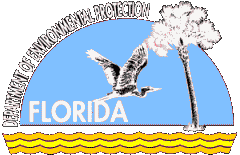 Broward County adopted Chapter 39, Article IX, Sec 39-107 in 1989. Ten years later, Pompano Beach followed their lead (Ords 99-18, 2000-64), Deerfield Beach in 2000 (Chapter 34, Article V, Sec 34-96), Hallandale Beach in 2001 (Ch. 6, Art. I, Sec 6-10), Lauderdale-by-the-Sea in 2002 (CH 30 Article V Div 2 Subdiv L Sec 30-313 [27]), Fort Lauderdale in 2003 (Chapter 6, Article III, Div. 2, Sec. 6-51), Hillsboro Beach in 2007 (Ord 232), and Hollywood in 2011 (Chapter 108). Despite enacting its ordinance in 2003, Fort Lauderdale postponed enforcement until 2007, after recovering from the serial hurricanes of 2004 and 2005. Every jurisdiction that passed a local variation of the State template assigned a liaison to the Florida Fish and Wildlife Conservation Commission. Fort Lauderdale�s official contact in 2007 was a code compliance officer named Al Lovingshimer. Broward County adopted Chapter 39, Article IX, Sec 39-107 in 1989. Ten years later, Pompano Beach followed their lead (Ords 99-18, 2000-64), Deerfield Beach in 2000 (Chapter 34, Article V, Sec 34-96), Hallandale Beach in 2001 (Ch. 6, Art. I, Sec 6-10), Lauderdale-by-the-Sea in 2002 (CH 30 Article V Div 2 Subdiv L Sec 30-313 [27]), Fort Lauderdale in 2003 (Chapter 6, Article III, Div. 2, Sec. 6-51), Hillsboro Beach in 2007 (Ord 232), and Hollywood in 2011 (Chapter 108). Despite enacting its ordinance in 2003, Fort Lauderdale postponed enforcement until 2007, after recovering from the serial hurricanes of 2004 and 2005. Every jurisdiction that passed a local variation of the State template assigned a liaison to the Florida Fish and Wildlife Conservation Commission. Fort Lauderdale�s official contact in 2007 was a code compliance officer named Al Lovingshimer.
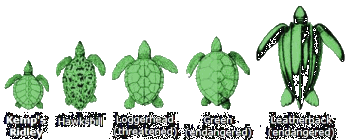 In May of 2007, Lovingshimer and Galt Mile officials negotiated a process that balanced the needs of sea turtles with those of local residents and their associations. By respecting the security concerns of unit owners and the financial constraints of their common interest communities, the mutually conceived plan cured 90% of the Galt Mile code violations by the following November. In May of 2007, Lovingshimer and Galt Mile officials negotiated a process that balanced the needs of sea turtles with those of local residents and their associations. By respecting the security concerns of unit owners and the financial constraints of their common interest communities, the mutually conceived plan cured 90% of the Galt Mile code violations by the following November.
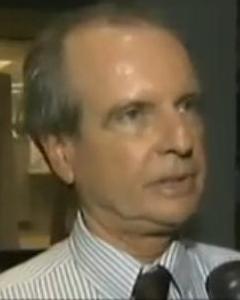 | | MICHAEL MALONEY |
 | | CATE MCCAFFREY |
Although Lovingshimer was claimed by cancer a few weeks later and posthumously named �2007 Code Enforcement Officer of the Year� by his Building Department peers and the City Commission, the understanding was upheld by then Code Compliance Manager Cate McCaffrey, who initially approved the agreement when first negotiated by Lovingshimer. When McCaffrey was later named Director of Business Enterprises, new Code Compliance Manager Mike Maloney also perpetuated a balanced enforcement policy.
 An open communication channel between the Galt Mile Community Association and code compliance officials successfully addressed turtle-safe lighting issues over the next three years. As a rule, when a violation was reported, the compliance officer would work with the association to cure the infraction inexpensively and in a manner that didn�t compromise resident safety. If a violation involved a major fixture, such as a parking deck lamp, the officer would recommend an inexpensive shield to temporarily deflect light from the beach. When the fixture approached the end of its useful life and was budgeted for replacement, the association would incorporate a turtle-safe substitute into its lighting plan. By blending short and long term solutions, associations achieved compliance without incrementally burdening budgets or creating a gauntlet of dangerous tripping hazards. An open communication channel between the Galt Mile Community Association and code compliance officials successfully addressed turtle-safe lighting issues over the next three years. As a rule, when a violation was reported, the compliance officer would work with the association to cure the infraction inexpensively and in a manner that didn�t compromise resident safety. If a violation involved a major fixture, such as a parking deck lamp, the officer would recommend an inexpensive shield to temporarily deflect light from the beach. When the fixture approached the end of its useful life and was budgeted for replacement, the association would incorporate a turtle-safe substitute into its lighting plan. By blending short and long term solutions, associations achieved compliance without incrementally burdening budgets or creating a gauntlet of dangerous tripping hazards.
 In late 2010, personnel changes in City government left a vacuum in city policy that crippled the process. With no guidance from the City, when newly elected board members and/or new managers evaluated their associations� lighting needs, they applied for and received City approval for lighting elements that once again endangered sea turtles. As compliance unraveled over the next year, no attempt was made by the City to revive the process they unilaterally slammed shut a year earlier. In late 2010, personnel changes in City government left a vacuum in city policy that crippled the process. With no guidance from the City, when newly elected board members and/or new managers evaluated their associations� lighting needs, they applied for and received City approval for lighting elements that once again endangered sea turtles. As compliance unraveled over the next year, no attempt was made by the City to revive the process they unilaterally slammed shut a year earlier.
 Code Compliance officers were also awash in confusion. Until the 2011 nesting season, when a compliance officer realized that an alleged violation was �overreaching� or baseless, it would be tossed. If it had merit, the officer would negotiate a resolution that was acceptable to the association. With no viable guidance from their supervisors, when handed a list of alleged lighting violations by Nova University volunteers who video beachfront light sources during evening patrols of the shoreline, instead of objectively evaluating the infraction and productively interacting with an association official, they could only confirm the violation and threaten repercussions for non-compliance. Code Compliance officers were also awash in confusion. Until the 2011 nesting season, when a compliance officer realized that an alleged violation was �overreaching� or baseless, it would be tossed. If it had merit, the officer would negotiate a resolution that was acceptable to the association. With no viable guidance from their supervisors, when handed a list of alleged lighting violations by Nova University volunteers who video beachfront light sources during evening patrols of the shoreline, instead of objectively evaluating the infraction and productively interacting with an association official, they could only confirm the violation and threaten repercussions for non-compliance.
 When association representatives asked compliance officers whether a particular solution was acceptable, they would respond, �I�m not supposed to comment on that. We can only tell you whether a solution is acceptable after it�s implemented.� Aware that they were burdening associations with irresolvable Catch-22 dogmas, enforcement visits were often concluded with a frustrated apology. When association representatives asked compliance officers whether a particular solution was acceptable, they would respond, �I�m not supposed to comment on that. We can only tell you whether a solution is acceptable after it�s implemented.� Aware that they were burdening associations with irresolvable Catch-22 dogmas, enforcement visits were often concluded with a frustrated apology.
 | | GMCA's IERACI AND BERKOWITZ |
New Senior Compliance Officer Ingrid Gottlieb lamented that they were in an impossible situation. �I�m very frustrated by this,� exclaimed Gottlieb. Code compliance official Mario Sotolongo - a party to the original agreement - while addressing an April 25th Regency Tower violation, admitted that the City had a huge problem - and his bosses didn�t know how to address it. After discussing the violation, the two officers met with GMCA President Pio Ieraci and V.P. Eric Berkowitz. Mario explained that the city�s erratic enforcement policies were making things worse. He said that we should revive the understanding that allowed them to work constructively with associations. When Pio asked how to best go about doing that, Mario recommended asking our City Commissioner for help. At the May 17th Advisory Board meeting, Commissioner Bruce Roberts agreed to help reinstate the lapsed format.
 | ASSISTANT CITY MANAGER
SUZANNE TORRIENTE |
At the June 6th Presidents Council meeting two weeks later, Roberts was accompanied by management personnel from Building Services and Code Compliance, now part of Director Greg Brewton�s Department of Sustainable Development. Also attending was Assistant City Manager Susan Torriente, their liaison with City Manager Lee Feldman�s office. After Code Compliance Officer Mario Sotolongo discussed the department�s environmental objectives and Building Services Manager Terry Burgess expressed an intention to address the enforcement dilemma with GMCA representatives, attending association officials were given the floor for questions. It soon became evident that the enforcement issue veiled a Pandora�s Box of frustration and animosity that had grown exponentially over the nesting season. An acrimonious nest marking policy hatched in the State Capitol similarly antagonized beachfront communities all over Florida.
 | | TURTLE NEST ON FORT LAUDERDALE BEACH |
The attending City officials were pummeled by complaints that rightfully should have been directed at Tallahassee. Specifically, two State Environmental Agencies that use the City - and its beachfront neighborhoods - as ant farms. The complaints were familiar to City Officials, having also heard them from every other beachfront neighborhood and hundreds of vacationing tourists. In short, beaches that serve as home to thousands of local residents and annually attract 11.1 million tourists to the City had devolved into demilitarized zones.
 During the day, both residents and visitors are forced to search for a small patch of beach that hadn�t yet been declared off limits by student volunteers from Nova University. If they arrived at the beach early enough, they might find enough space to spread a blanket between 30 foot square exclusion zones cordoned off around 3-foot turtle nest sites. In the evening, visitors walking on or near the beach were accosted by self-proclaimed �environmental warriors� who either chastised them for �committing genocide� or ordered them off the beach. The federal and state laws that protect sea turtles, nests, eggs and hatchlings have never barred people from strolling on the beach. During the day, both residents and visitors are forced to search for a small patch of beach that hadn�t yet been declared off limits by student volunteers from Nova University. If they arrived at the beach early enough, they might find enough space to spread a blanket between 30 foot square exclusion zones cordoned off around 3-foot turtle nest sites. In the evening, visitors walking on or near the beach were accosted by self-proclaimed �environmental warriors� who either chastised them for �committing genocide� or ordered them off the beach. The federal and state laws that protect sea turtles, nests, eggs and hatchlings have never barred people from strolling on the beach.
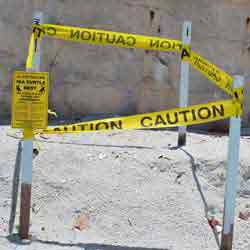 | | LAST YEAR'S TURTLE NEST SIZE |
In past years, nest sites were adequately cushioned by small protected zones measuring 5 feet from the center of the nest (10 foot diameter). The thousands of visitors and resident beachgoers enjoyed sharing the beach with these curious emoluments to environmental responsibility. The modestly-sized zones prevented interference with the nest sites while providing a constructive reminder that the beach is a shared bioniche. In 2012, a blazingly asinine decision was made by the Florida Fish and Wildlife Conservation Commission (FWC) to expand each protected zone by a factor of ten. Nest sites that used to take up 100 square feet of beach now each consumed nearly 1000 square feet.
 | | THIS YEAR'S TURTLE NEST SIZE |
This inexplicably invasive statewide policy was mirrored in every community on the Florida coast. In each jurisdiction, the ludicrously large exclusion zones hampered municipal beach maintenance. When nest site numbers exploded in June and July, the tractors and surf rakes used to mechanically clean and smooth public beaches were blocked by the extensive nest armoring, forcing beach maintenance personnel to manually harvest large waste while leaving tons of less wieldy residual trash to rot on the beach. As a result, the small patches of beach still open to beachgoers were rife with garbage and rotting seaweed.
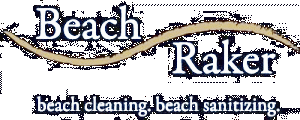 Since Fort Lauderdale beach maintenance ends at Oakland Park Boulevard, Galt Mile residents pay Pompano vendor �Beach Raker� for that service. In May, the contiguous construction sprawl encircling 4 adjacent 3-foot nests formed a 110-foot barrier that rendered the Galt Mile beach impassable, forcing the company�s rake-pulling All-Terrain Vehicle (ATV) to skirt the blockade by driving through the surf. Since Fort Lauderdale beach maintenance ends at Oakland Park Boulevard, Galt Mile residents pay Pompano vendor �Beach Raker� for that service. In May, the contiguous construction sprawl encircling 4 adjacent 3-foot nests formed a 110-foot barrier that rendered the Galt Mile beach impassable, forcing the company�s rake-pulling All-Terrain Vehicle (ATV) to skirt the blockade by driving through the surf.
 | | SEAWEED ON FORT LAUDERDALE BEACH |
 | | PROF. BRIAN LAPOINTE |
Another problem faced by Beach Raker, which also cleans beaches in Lauderdale-by-the-Sea, Pompano and Hillsboro Beach, is an anomalous plague of seaweed. Thousands of tons of a species of floating algae called sargassum have clogged regional beaches this year. FAU researcher Brian LaPointe faults heightened levels of plant nutrients from farm runoff or the bacterial breakdown of oil from the BP disaster. Beach Raker has always buried the dense vegetation, which helps anchor dunes that slow the effects of tidal erosion. This year, after admitting that the decomposing vegetation will generate toxic concentrations of bacteria and fungi, FWC biologist Robbin Trindell prohibited coastal communities from burying the potential health hazard since it might harm the nested eggs and deprive seabirds of a foraging source.
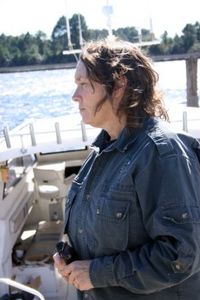 | FWC BIOLOGICAL ADMINISTRATOR
DR. ROBBIN TRINDELL |
 | | BEACH WASTE BETWEEN OCEAN SUMMIT AND OCEAN CLUB |
Lauderdale-by-the-Sea Commissioner Stuart Dodd responded �We�ve been burying seaweed for 30 years to try to allow sea turtles the best routes to the ocean. It�s better to get the seaweed buried rather than piled up and rotting. I can�t understand Dr. Trindell�s attitude on this one.� Evidently, the Florida Department of Environmental Protection disagrees with Trindell, having given Boca Raton a permit to bury their seaweed, albeit shoreward of the nest sites. Since the Fort Lauderdale Beach boarders A1A, this year�s 300% increase in seaweed (over 1000 tons) is trucked to a compost pit in Snyder Park. However, a lack of access points precludes this for beaches along the Galt Mile, L-B-T-S, Pompano Beach and Hillsboro Beach. When local officials were denied permission to follow Boca Raton�s seemingly acceptable solution, Trindell said �If you live on the beach, what is there to eat? This material forms the basis for the food chain. Juvenile fish, birds � they�re dependent on that material being present and accessible. I recognize that on a recreational urban beach that�s not likely.�
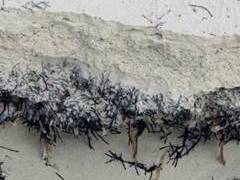 | | SEAWEED MIXED WITH SAND |
 Since the bacterial proliferation from decomposing vegetation also poses a threat to people, officials in North Broward and South Palm Beach County beach neighborhoods are ignoring the questionable FWC mandate to leave the rotting mounds of seaweed in place. Prohibited from burying the vegetation, even in areas safely shoreward of nest sites, Beach Raker is manually mixing the seaweed with the top layer of sand and quietly hoping that the State doesn�t object. Since the bacterial proliferation from decomposing vegetation also poses a threat to people, officials in North Broward and South Palm Beach County beach neighborhoods are ignoring the questionable FWC mandate to leave the rotting mounds of seaweed in place. Prohibited from burying the vegetation, even in areas safely shoreward of nest sites, Beach Raker is manually mixing the seaweed with the top layer of sand and quietly hoping that the State doesn�t object.
 | BEACH RAKER PROPRIETOR
TIMOTHY GREENER |
Concerned about the consequences of Beach Raker�s blocked access to the Galt Mile beach, GMCA President Pio Ieraci met with Beach Raker proprietor Timothy Greener. Having risen through the $2.2 billion Canadian First Services Conglomerate (corporate parent of Continental Management) before taking the reins at Beach Raker, Greener is familiar with how common interest communities carefully maintain the beach. In an effort to resolve the maintenance impediment, Greener reached out to Lou Fisher, Broward�s Natural Resources Guru and the local Turtle Nesting program permit holder.
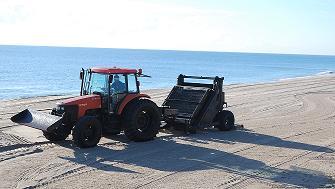 | | BEACH RAKER CLEANS BEACH |
After Fisher called Tallahassee and questioned why Fish and Wildlife mandated a 30-foot zone to protect a 3-foot nest, Greener emailed Ieraci, explaining that FWC �agreed to a 15 ft. radius for one-in-five nests to comply with FWCC�s lighting survey requirements, the remainder of the nests will be marked as they have done in previous years by a 3 ft. radius.� In short, after cordoning off one large nest area, the nest markers would create four smaller ones. Galt Mile officials were perplexed. Following months of arrogant intransigence, why did Fish and Wildlife suddenly succumb to a supplication by a local vendor? The mystery faded over the next few weeks as nest markers never implemented the new mandate.
 | | BLAIR WITHERINGTON |
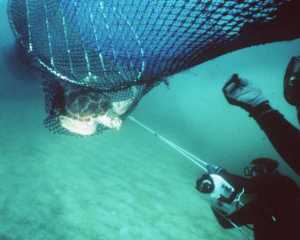 | | LOGGERHEAD ESCAPING THROUGH TED |
With the onset of summer, association officials watched the Nova students continue to delimit nest areas with 30-foot protective zones. To inflame the problem, FWC scientist Blair Witherington reported that nest events increased by 50% in 2012. Researchers ascribe the unexpected spike to a 1992 federal ban on poorly designed shrimp nets that ensnared and killed large marine reptiles, including sea turtles (nets have since been fitted with Turtle Excluder Devices � TEDs � which act as an escape hatch). Delighted by evidence of improved turtle survival prospects yet concerned with its impact on beachfront communities, Project Manager Laura Wright of Nova�s sea turtle conservation program observed �The beaches look like they�re blanketed in nests, basically.�

 | | LAURA WRIGHT |
Throughout June and July, local association beaches were perpetually hosting 6 to 7 nests that each claimed from 700 to 1000 square feet. At public beaches in Fort Lauderdale, crowding caused by the 30-foot nest zones fueled a growing rancor among Broward residents and visiting tourists. By August, Tallahassee was flooded with complaints from coastal communities all across the state. On discovering that the gigantic nest zones didn�t enhance hatchling survival rates, local public officials and State lawmakers asked FWC officials to revise their nest marking directives to local permit holders. Ironically, Galt Mile residents and other Broward beachgoers who were among the program�s most ardent supporters were being systematically alienated by the ill-conceived 30-foot nest marking mandate.
 On Friday, August 17, a GMCA official contacted Broward Sea Turtle Program Director Lou Fisher. A longtime voice of moderation, Fisher uses education to earn the cooperation of residents and merchants most impacted by demanding and costly survival measures. Lamenting how the huge 2012 exclusion zones made a majority of Florida�s beach areas �off limits� to people while providing nesting sea turtles with little or no ostensible benefit, Fisher confirmed that FWC officials finally agreed to revise their failed nest marking mandate. On Friday, August 17, a GMCA official contacted Broward Sea Turtle Program Director Lou Fisher. A longtime voice of moderation, Fisher uses education to earn the cooperation of residents and merchants most impacted by demanding and costly survival measures. Lamenting how the huge 2012 exclusion zones made a majority of Florida�s beach areas �off limits� to people while providing nesting sea turtles with little or no ostensible benefit, Fisher confirmed that FWC officials finally agreed to revise their failed nest marking mandate.
 | | BROWARD NAT RES SPEC LOU FISHER |
He said that since there was no need to surround nests with more than a 5-foot protective radius, this would be FWC�s new standard for next year�s statewide nest marking policy. Not surprisingly, this epiphany didn�t bubble up from the State agency�s impressive research resources. Fisher confirmed that the FWC leadership in Tallahassee was reacting to a veritable mountain of blowback. Swamped by thousands of complaints from every beachfront community in the State and thousands more from disappointed visiting tourists, FWC officials were also pressured by local tourism agencies and travel industry representatives, who reminded them that the Sea Turtle program was supposed to boost �ecotourism�, not kill it.
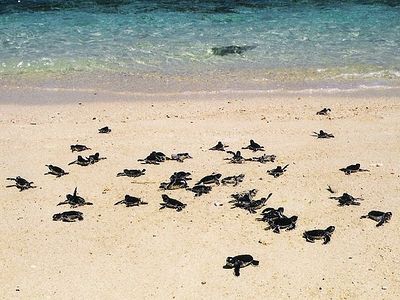 | | TURTLE HATCHLINGS HEAD FOR OCEAN |
When asked why the Nova nest markers continued to cordon off 30-foot zones after being told to make them smaller, Fisher admitted that this was done in error. Exclaiming �They are student volunteers,� Fisher asserted that the FWC follow-up directive was initially overlooked by many of the Nova nest markers. When informed that this �oversight� had enraged and alienated neighborhood residents and visitors - including supporters of turtle survival measures - he said, �This season is almost over. Since the current nests will soon be hatched out, next year the smaller zones will go into effect all over the State.� Fisher added that he would willingly participate in any effort to mollify problems stemming from the Sea Turtle program.
 Unlike some of his colleagues in Tallahassee, Fisher knows that the outcome of this campaign will be decided in these beach communities. Notwithstanding the infantile polemics by spotlight-hungry radicals on both sides of this issue, the program�s success depends largely on the voluntary cooperation of those living at ground zero. Unlike some of his colleagues in Tallahassee, Fisher knows that the outcome of this campaign will be decided in these beach communities. Notwithstanding the infantile polemics by spotlight-hungry radicals on both sides of this issue, the program�s success depends largely on the voluntary cooperation of those living at ground zero.
 Along with the 20-year old federal ban on deadly shrimp nets, this year�s record nesting activity is equally attributable to beachfront homeowners who reduced the impact of artificial lighting on nesting sea turtles while preserving code compliant resident safety � at their own expense. If Tallahassee does succeed in unnecessarily alienating Florida�s beachfront communities, and turns their natural allies into enemies, they may opt to spend their resources on lawyers instead of lighting. After all, the Constitution frowns on non-wartime local laws that mandate when people can turn the lights on or off in their own homes. Along with the 20-year old federal ban on deadly shrimp nets, this year�s record nesting activity is equally attributable to beachfront homeowners who reduced the impact of artificial lighting on nesting sea turtles while preserving code compliant resident safety � at their own expense. If Tallahassee does succeed in unnecessarily alienating Florida�s beachfront communities, and turns their natural allies into enemies, they may opt to spend their resources on lawyers instead of lighting. After all, the Constitution frowns on non-wartime local laws that mandate when people can turn the lights on or off in their own homes.

Click To Top of Page

  | | NEW BEACH CONSTRUCTION PLAN |
April 21, 2012 - It�s no revelation that our beach has been rapidly dwindling from the effects of tidal erosion. Since Broward County�s beaches are uniformly under attack, the Broward County Shore Protection Project was authorized in 1965 for county-wide federal participation in beach erosion control (Section 301 of Public Law 89-298, October 27, 1965). Not a bad deal for the projected cost of $1,093,000 in 1965. The Project divided the County�s deteriorating shoreline into three zones. The North Zone (Segment I) is about three miles of coast from the Palm Beach County line to the Hillsboro Inlet. The Middle Zone (Segment II) includes the roughly 10 miles of beach running from the Hillsboro Inlet to just north of Port Everglades. The South Zone (Segment III) ranges from John U. Lloyd Beach State Recreation area for 8.1 miles through Dania, Hollywood Beach, and Hallandale Beach to the Dade County Line.
 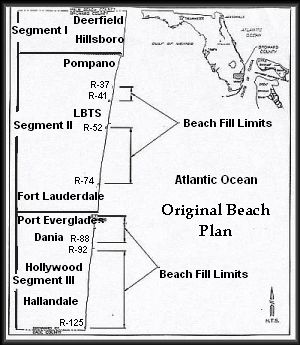 The original plan engaged the Army Corps of Engineers to supervise the pumping of sand dredged from five �borrow� sites north of Pompano Beach in Segment I and transported by ship to the coastal zones awaiting renourishment. This comprehensive effort would add in excess of 2.5 million cubic yards of sand to our shrinking beaches and widen them by 50 feet to 100 feet depending on the degree of need. The county anticipated recovering almost half of its outlay from the Federal Government, whose primary objective is the protection of $4 billion in upland property from storm damage. Alternatively, we relish that visitors spend $9 billion annually to roll in the retreating sand. The original plan engaged the Army Corps of Engineers to supervise the pumping of sand dredged from five �borrow� sites north of Pompano Beach in Segment I and transported by ship to the coastal zones awaiting renourishment. This comprehensive effort would add in excess of 2.5 million cubic yards of sand to our shrinking beaches and widen them by 50 feet to 100 feet depending on the degree of need. The county anticipated recovering almost half of its outlay from the Federal Government, whose primary objective is the protection of $4 billion in upland property from storm damage. Alternatively, we relish that visitors spend $9 billion annually to roll in the retreating sand.
 Renourishment of the South Zone (Segment III) was completed in March 2006 using 1,700,000 cubic yards of sand from the offshore borrow sites. Since 21.3 miles of Broward County�s 24 miles of beaches were originally declared �critically eroded� by the Coastal Engineering Section of the FDEP, 13.5 miles have either been restored and/or are currently under maintenance. Renourishment of the South Zone (Segment III) was completed in March 2006 using 1,700,000 cubic yards of sand from the offshore borrow sites. Since 21.3 miles of Broward County�s 24 miles of beaches were originally declared �critically eroded� by the Coastal Engineering Section of the FDEP, 13.5 miles have either been restored and/or are currently under maintenance.
Sand Plan Sinks

 | | AT RISK ELKHORN AND STAGHORN CORALS |
Following completion of the Segment III renourishment, monitors from Nova Southeast University Oceanographic Center and a coalition of outside engineers joined county scientists to examine the environmental impact of the south county beach fix and use the data to enhance environmental mitigations for the next stage (Segment II) of the County�s coastal rescue plan. After an 18-month monitoring period (as mandated by the Florida Cabinet), their report documented finding two new species of coral federally designated as �threatened� in 2006.
 While noting some deterioration of the nearshore hardbottom environment during the Segment III renourishment, the report laments an inability to determine whether its cause was the project or Hurricanes Dennis, Katrina, Ophelia, Rita, Wilma and two nor�easters, which pummeled the site in 2005 and any of which may have been responsible for the damage in its entirety. While noting some deterioration of the nearshore hardbottom environment during the Segment III renourishment, the report laments an inability to determine whether its cause was the project or Hurricanes Dennis, Katrina, Ophelia, Rita, Wilma and two nor�easters, which pummeled the site in 2005 and any of which may have been responsible for the damage in its entirety.
 | STEPHEN HIGGINS
BEACH WIZZARD |
When FDEP notified the Broward Biological Resources Division that these new corals should be added to the list of protected marine organisms prior to the upcoming Segment II project, communications inexplicably broke down. When asked by GMCA officials about the Segment II project, County beach officials were largely non-responsive throughout 2008 and 2009, focusing instead on additional erosion control devices, a nondescript hunt for sand and other puerile distractions.
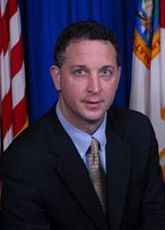 | FORMER FDEP SECRETARY
MICHAEL W. SOLE |
Enigmatically, former beach boss and project Guru Stephen Higgins also never responded when FDEP requested a mitigation plan for the endangered coral and sat idly by as the project�s State permit expired on June 4, 2009 and the Federal permit expired a few weeks later on July 16, 2009. Although former FDEP Secretary Michael Sole, who worked with Stephen Higgins in Broward when he was tagged by Charlie Crist to run FDEP, collegially extended the lapsed Segment II State permit for an additional five years, the County would have to renegotiate the regulatory minefield prerequisite to a new federal permit before pulling the stalled renourishment project out of limbo.
 | | HOLLYWOOD HOTELS COVET SAND |
Shortly after Higgins fell asleep at the wheel, a municipal conflict threatened the project. Despite the fact that the Galt Mile Community Association played a critical role in actualizing the south county�s Segment III renourishment by winning Cabinet approval in 2003, Hollywood and Hallandale hoteliers and politicians later colluded in a stealth campaign to hijack the sand earmarked for Fort Lauderdale�s beaches while the Segment II approval languished.
 Enraged by the south county attempt to usurp Segment II renourishment resources and leery of County�s incredibly irresponsible gaffe, when Broward County asked the City of Fort Lauderdale for permission to perform a sand bypass at Port Everglades on January 6, 2009, a frustrated City Commission immediately passed City Resolution No. 09-11, �strongly opposing� the project and insisting that Broward first complete the promised Segment II renourishment of Fort Lauderdale�s beaches Enraged by the south county attempt to usurp Segment II renourishment resources and leery of County�s incredibly irresponsible gaffe, when Broward County asked the City of Fort Lauderdale for permission to perform a sand bypass at Port Everglades on January 6, 2009, a frustrated City Commission immediately passed City Resolution No. 09-11, �strongly opposing� the project and insisting that Broward first complete the promised Segment II renourishment of Fort Lauderdale�s beaches
To underscore their anger, City officials posted a page on their web site entitled �Help Save Fort Lauderdale Beach,� which provides the email addresses of the County Commissioners and states �The Fort Lauderdale City Commissioners need your help to make sure that Fort Lauderdale is not pushed to the back of the line. Let Broward County know that you oppose the proposed Port Everglades Sand Bypass Project and that you want them to implement the Segment II Beach Renourishment Project as promised.�
Eric Myers Revives Renourishment

 | BROWARD BEACH
ADMINISTRATOR ERIC MYERS |
The Project lacked a palpable pulse when Deputy Director Eric Myers of Broward�s Environmental Protection and Growth Management Department stepped up in 2011 and rescued the plan from oblivion. Working with County Commissioner Chip LaMarca, the FDEP, the Galt Mile Community Association and participating north and south county beachfront municipalities, Myers elicited an agreement to cooperate from every party with standing.
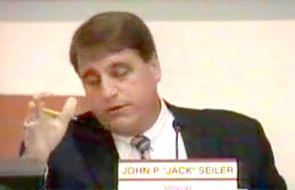 | | MAYOR JACK SEILER |
Myers� argument was simple. The project�s overall engineering success depends upon the segments being accomplished in concert. Addressing Segments II or III alone is akin to fixing three of four broken legs on a chair. The Broward County Department of Environmental Protection and the Army Corps of Engineers agreed that the project�s ultimate success is contingent on the problem being addressed unilaterally. Each segment contributes to the overall stability of the shoreline. Unless Segment II was completed, the entire enterprise would fail.
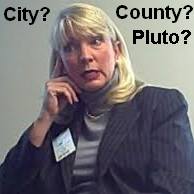 | | FIX BEACH... and WAVE WALL...and |
In a February 3, 2012 letter to Fort Lauderdale Mayor Jack Seiler, Myers explains how a new upland source of sand could enable a Segment II renourishment in 2013. On March 6th, he presented project details to the City Commission. A long time coming, his presentation was music to the Commission, despite Commissioner Charlotte Rodstrom�s eccentric notion that a higher roadside wave wall would better protect the marine environment (Myers politely explained was it was atypical for a renourishment project). Mayor Jack Seiler answered with a March 13th letter to Broward Mayor John Rodstrom supporting Myers� plan to renourish Segment II with upland sand. On April 2, 2012, Myers outlined the plan to association officials attending a Galt Mile Community Association Presidents Council meeting at the Galleon.
 | | BROWARD COMMISSIONER CHIP LAMARCA |
Two months earlier, angry Galt Mile officials suddenly blasted Broward Commissioner Chip LaMarca when he began delivering an update about beach renourishment. Given the shrinking beach�s critical importance to the neighborhood�s economy and its residents� quality of life, Galt Milers and their associations have been passionately vested in its rescue for more than a decade. Annually since before the Millennium, Galt Mile residents had been repeatedly assured by Broward officials that their severely eroded beach would be renourished �next year�. Enthusiasm was slowly replaced by a numbing cynicism as frustrated residents increasingly reacted to empty county promises like rats on a shock plate. A protective veneer of hopeless disbelief veiled an explosive anger. While attempting to impart some good news about the project�s revival, LaMarca inadvertently pulled off an emotional scab and loosed a decade of disappointment. Ironically, LaMarca had been working with Myers to salvage the frozen project. Immediately after the outburst, LaMarca and GMCA officials agreed that Myers should personally bring the neighborhood up to speed.
 While running through the revised project�s planning, design, and implementation for association officials, Myers addressed its scope, sand source, cost and the Segment II timetable. The following is a blended summary of the two presentations made to the neighborhood association and the City Commission. While running through the revised project�s planning, design, and implementation for association officials, Myers addressed its scope, sand source, cost and the Segment II timetable. The following is a blended summary of the two presentations made to the neighborhood association and the City Commission.
New Sand Source for Segment II

 | | NEW SEGMENT II BEACH PLAN |
Myers explained that he is submitting a Joint Coastal Permit (JCP) application for the placement of 750,000 cubic yards of sand mined from an upland sand source along two separate portions of the Segment II shoreline. The plan to rehabilitate 5.2 miles of beach is based upon a shoreline condition and change analyses, sand source investigations, environmental considerations and expected regulatory hurdles. The northern section runs from SE 4th Street in Pompano Beach to the Ocean Colony Condominium in Lauderdale-by-the-Sea. The southern section extends from Commercial Boulevard to Terramar Street in Fort Lauderdale (and includes the Galt Mile). Marketing itself as the �Dive Capitol of Florida,� Lauderdale-by-the-Sea has been conflicted about participating in a project that interferes with the Scuba industry�s agenda. He pegs the combined cost of construction and nearshore hardbottom mitigation at roughly $33 million. Indirect costs for planning, design, permitting, construction management and environmental monitoring are estimated at $12.5 million for a total project cost of $45.5 million.
 In addition to a beach berm � the above water material that comprises the active shoreline (i.e. sand, shingles, shells, jetsam, flotsam) - the project will include construction of a back beach dune to fortify areas where shorefront development is most vulnerable to erosion (wind and coastal storm effects), such as the Galt Ocean Mile, the beachfront single family home community in Lauderdale Beach, and the area seaward of the Hugh Taylor Birch State Park finger streets. The initially wide sand berm constructed on the heavily eroded upper portion of the beach profile will gradually �equilibrate� and flatten to a shape more consistent with the natural beach. In addition to a beach berm � the above water material that comprises the active shoreline (i.e. sand, shingles, shells, jetsam, flotsam) - the project will include construction of a back beach dune to fortify areas where shorefront development is most vulnerable to erosion (wind and coastal storm effects), such as the Galt Ocean Mile, the beachfront single family home community in Lauderdale Beach, and the area seaward of the Hugh Taylor Birch State Park finger streets. The initially wide sand berm constructed on the heavily eroded upper portion of the beach profile will gradually �equilibrate� and flatten to a shape more consistent with the natural beach.
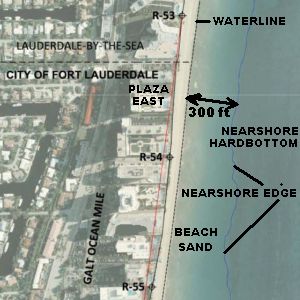 | | GALT WATERLINE CLOSE TO NEARSHORE HARDBOTTOM |
As the berm face flattens and sand travels down the slope, it could reach and perhaps directly cover and degrade nearshore hardbottom areas immediately adjacent to the beach system. Along the Segment II shoreline, these highly sensitive ecosystems are intermittently located relatively close to the waterline. For example, the hardbottom behind the Plaza East Condominium beach is just 300 feet from the waterline. To minimize damage to this protected ecosystem, regulations will require construction of a significantly narrower beach than at Broward coastal sites where the hardbottom is farther offshore.
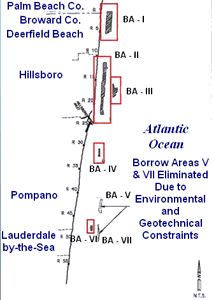 The bellwether change in Myers� plan is the sand source. Every scrap of relevant project documentation, from the Army Corps of Engineers Final Environmental Impact Statement to the original plan that was permitted by the State, targeted Segment I (the waters off Deerfield Beach) as a sand �borrow site� adequate for both Segment III and Segment II renourishments. In May of 2007, former Broward Beach Administrator Stephen Higgins reported �Since borrow area No. 1, which has enough material with which to construct Segment II, now has a higher percentage of rock in it after removing sand for Segment III, we will have to explore an alternative sand source.� To swallow this whopper, one must believe that a team of county and private sector world-class marine engineers was intellectually ambushed by the third grade hypothesis that if one removes a certain material; the percentage of other materials will increase. Higgins� statement didn�t explain what happened. In fact, Deerfield Beach informed the County that it wanted to conserve the offshore sand for its own use and told Higgins to take a hike. The bellwether change in Myers� plan is the sand source. Every scrap of relevant project documentation, from the Army Corps of Engineers Final Environmental Impact Statement to the original plan that was permitted by the State, targeted Segment I (the waters off Deerfield Beach) as a sand �borrow site� adequate for both Segment III and Segment II renourishments. In May of 2007, former Broward Beach Administrator Stephen Higgins reported �Since borrow area No. 1, which has enough material with which to construct Segment II, now has a higher percentage of rock in it after removing sand for Segment III, we will have to explore an alternative sand source.� To swallow this whopper, one must believe that a team of county and private sector world-class marine engineers was intellectually ambushed by the third grade hypothesis that if one removes a certain material; the percentage of other materials will increase. Higgins� statement didn�t explain what happened. In fact, Deerfield Beach informed the County that it wanted to conserve the offshore sand for its own use and told Higgins to take a hike.
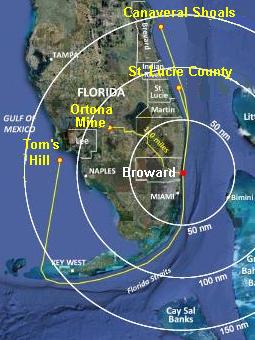 | | WIDESPREAD SEARCH FOR SAND |
This unanticipated stumbling block subsequently drove an intensive search for sand. County engineers and project planners explored other local offshore deposits, remote sources of domestic sand (e.g. offshore central Florida at Canaveral Shoals in Brevard County and in the Gulf of Mexico at Tom�s Hill off Lee County), non-domestic sand sources like Bahamian aragonite and recycled glass cullet (finely-ground scrap glass). To his credit, Myers turned this project lemon into lemonade.
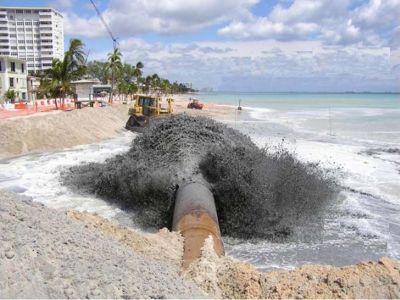 | | DARK GRAY DREDGED SAND TURNS LIGHT GRAY |
Sand located offshore in Broward County generally consists of between 50% and 80% calcium carbonate material, is slightly finer than the native beach sediments, and have between 1% and 3% fines, by weight. The sand is generally dark gray in color when first placed of the beach, but lightens to a medium gray within a few days. Using sand extracted from an offshore borrow area requires a dredge operating between offshore reefs; the deployment of pipelines that extend from an offshore offloading area and navigate through coral reefs to the target beach; and staged hydraulic pumps to distribute the sand over the beach. Large maritime vessels that dredge sand and lay pipeline can wreak havoc on the marine environment while steaming across a coral reef; exponentially inflaming the renourishment�s expensive and dilatory regulatory nightmares.

 | | SAND PROCESSED AT ORTONA MINE |
Instead of running this painful regulatory gauntlet to cover a Segment II beach with gray sand, Myers decided to buy compatible sand harvested from upland commercial mines north and northwest of the county and truck it 125 miles to Fort Lauderdale. To buttress their newly renourished beach, Hollywood recently trucked in 87,000 tons of sand from the Ortona Sand Mine in La Belle, Florida (Glades County). Owned by E.R. Jahna Industries, Inc., a dredge sucks sand from the bottom of an artificial lake, filters out pebbles, extracts water, removes silt or clay and sorts the sand by grain size.
Galt Mile Beach: Segment II Plan Protocols

 | | YELLOW SAND DREDGED FROM ORTONA'S MAN-MADE LAKE |
Sand products from these upland sand mines are almost exclusively silica sand, typically have larger average grain sizes and a smaller fines fraction than material found in the offshore borrow areas, and are generally light yellow in color. Due primarily to their imperceptibly larger grain size, these sources are more stable and produce less post placement turbidity in the nearshore environment. Originally deposited 5 million years ago when the shoreline ran up the spine of the state, they also more closely match the color of our native beach sediments than sand dredged from offshore borrow sites.
 | | TRUCKING SAND TO BEACH STAGING AREAS |
Since the construction methodology for renourishing a beach using mined sand is significantly different from using sand dredged offshore, certain new challenges must be addressed. The sand must be delivered to the beach by truck, stockpiled, transferred to off-road equipment, and placed mechanically on the beach. Traffic on regional thoroughfares and local streets along the route will be temporarily affected by the hauling and placement of material during the construction process. The project will also require several accessible and sufficiently sized dedicated staging areas for the delivery, handling, transfer and temporary stockpiling of sand material.
 For the Segment II project, Myers surmised �One access point will be required for the Pompano Beach/LBTS portion and three or four sites for the Fort Lauderdale renourishment.� Myers told the Presidents Council that it would be optimal if access points were located north and south of Galt Ocean Mile - possibly Palm Avenue in LBTS and near Oakland Park Boulevard in Fort Lauderdale, respectively. Another access point located in the vicinity of NE 18th Street and A1A in Fort Lauderdale could service the southernmost beach fill. For the Segment II project, Myers surmised �One access point will be required for the Pompano Beach/LBTS portion and three or four sites for the Fort Lauderdale renourishment.� Myers told the Presidents Council that it would be optimal if access points were located north and south of Galt Ocean Mile - possibly Palm Avenue in LBTS and near Oakland Park Boulevard in Fort Lauderdale, respectively. Another access point located in the vicinity of NE 18th Street and A1A in Fort Lauderdale could service the southernmost beach fill.
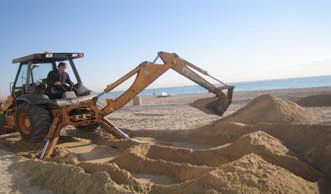 | | SAND OFFLOADED TO BEACH |
While moving the sand overland instead of stomping through delicate hardbottom should eliminate many environmental pitfalls, the Segment II project will still elicit high levels of regulatory and public scrutiny. Federal permit applications will have to address 1) the project�s purpose, 2) the amount of sand fill required, 3) the sand placement areas and 4) the type of sand that will be placed. Compared to the problems threatened by offshore dredging, pipeline damage to the reef and high turbidity levels from stirred sand at the borrow sites and the beach, muting the environmental impacts of spreading the upland sand should be a cakewalk. Instead, project planners will have to allay regulatory concerns about the variability of materials at the source, and enforce Quality Assurance and Quality Control (QA/QC) protocols throughout the construction period. Myers assured attendees �Using the upland sand sources for the Segment II project will be viewed more favorably by the regulatory agencies and public environmental protection interests than sand dredged from offshore.�
 There are two downsides to this revised renourishment plan, cost and scheduling. Delivering mined sand to the beach is estimated to cost 20% more than sand dredged offshore. Although the price of the upland sand is $15.2 million more than sand harvested offshore, the combined cost of equipment, mitigation and Environmental Monitoring is $7.9 million less. Since the costs of planning/engineering/permitting/etc. and contingency funds remain the same, the overall project price will jump from $38.3 million to $45.6 million, a $7.3 million increase. There are two downsides to this revised renourishment plan, cost and scheduling. Delivering mined sand to the beach is estimated to cost 20% more than sand dredged offshore. Although the price of the upland sand is $15.2 million more than sand harvested offshore, the combined cost of equipment, mitigation and Environmental Monitoring is $7.9 million less. Since the costs of planning/engineering/permitting/etc. and contingency funds remain the same, the overall project price will jump from $38.3 million to $45.6 million, a $7.3 million increase.
 Myers said that construction should commence in the fall of 2013. Regulatory land mines and/or possible Administrative Challenges to project permits could delay the schedule. Given the time required to load, transport, unload, stockpile and mechanically disburse sand pulled from the mine, using the upland sand source may require up to three seasons to place 750,000 cubic yards along the Segment II shoreline. Since renourishment activities are precluded during turtle nesting season, sand placement may only occur during the winter seasons of 2013-2014, 2014-2015, and (if necessary) 2015-2016. In comparison, if offshore sand were used, the 750,000 cubic yards of sand could be placed within 2 to 4 months, enabling completion of the entire project during the 2013-2014 winter season. Myers said that construction should commence in the fall of 2013. Regulatory land mines and/or possible Administrative Challenges to project permits could delay the schedule. Given the time required to load, transport, unload, stockpile and mechanically disburse sand pulled from the mine, using the upland sand source may require up to three seasons to place 750,000 cubic yards along the Segment II shoreline. Since renourishment activities are precluded during turtle nesting season, sand placement may only occur during the winter seasons of 2013-2014, 2014-2015, and (if necessary) 2015-2016. In comparison, if offshore sand were used, the 750,000 cubic yards of sand could be placed within 2 to 4 months, enabling completion of the entire project during the 2013-2014 winter season.
 When asked how the project would roll out, given the Galt Mile Community�s longstanding investment in the project�s survival, Myers exclaimed that he favors renourishing the Galt Mile beach at the project�s outset. When asked where the beach fix will start, Myers indicated that it would begin below Anglin�s Pier on Commercial Boulevard and work its way south to Terramar Street in Fort Lauderdale before returning north to address the Pompano Beach/LBTS section of beach. According to Commissioner LaMarca, project funding is intact and available. When asked how the project would roll out, given the Galt Mile Community�s longstanding investment in the project�s survival, Myers exclaimed that he favors renourishing the Galt Mile beach at the project�s outset. When asked where the beach fix will start, Myers indicated that it would begin below Anglin�s Pier on Commercial Boulevard and work its way south to Terramar Street in Fort Lauderdale before returning north to address the Pompano Beach/LBTS section of beach. According to Commissioner LaMarca, project funding is intact and available.
 Since the benefits of Myers� plan far outweigh the drawbacks, GMCA officials consider it a no-brainer. While Myers has managed to get the involved jurisdictions pulling in the same direction and chill much of the animosity that flared when Broward dropped the ball, he also understands that many Galt Mile residents who�ve been repeatedly burned in the past won�t buy into this plan until they see trucks filled with sand in the staging area. After all, this isn�t the first time we�ve been told that the beach will be renourished �next year�. Since the benefits of Myers� plan far outweigh the drawbacks, GMCA officials consider it a no-brainer. While Myers has managed to get the involved jurisdictions pulling in the same direction and chill much of the animosity that flared when Broward dropped the ball, he also understands that many Galt Mile residents who�ve been repeatedly burned in the past won�t buy into this plan until they see trucks filled with sand in the staging area. After all, this isn�t the first time we�ve been told that the beach will be renourished �next year�.

Click To Top of Page



 | GMCA PRESIDENTS COUNCIL CHAIR PIO IERACI
APPLAUDS PROJECT KICKOFF - Broward Comms
SUE GUNZBERGER & KRISTIN JACOBS
& former Hollywood Mayor MARA GIULIANTI |
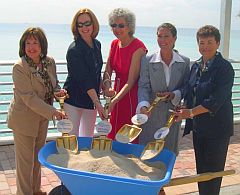 | FORMER HOLLYWOOD MAYOR MARA GIULIANTI
BROWARD COMMISSIONER KRISTIN JACOBS
BROWARD COMMISSIONER SUE GUNZBERGER
HALLANDALE BEACH MAYOR JOY COOPER
AND DANIA BEACH VICE MAYOR PAT FLURY |
August 9, 2011 - Six years after the Army Corps of Engineers finalized its environmental impact statement for Broward�s beach renourishment, the Mayors of Hollywood, Hallandale and Dania Beach threw a celebratory event marking commencement of the long delayed South Broward part of the Broward Shore Preservation project (Segment III) on May 6, 2005.
 Following completion of the Segment III renourishment in March of 2006, monitors from Nova Southeast University Oceanographic Center and a coalition of outside engineers joined county scientists to begin examining the environmental effects of repairing the County�s shoreline from the Dade County line to John U. Lloyd State Park Beach. After an 18-month monitoring period, their report documented two species of coral Federally designated as �threatened� in 2006. Following completion of the Segment III renourishment in March of 2006, monitors from Nova Southeast University Oceanographic Center and a coalition of outside engineers joined county scientists to begin examining the environmental effects of repairing the County�s shoreline from the Dade County line to John U. Lloyd State Park Beach. After an 18-month monitoring period, their report documented two species of coral Federally designated as �threatened� in 2006.
 | | PORT EVERGLADES SAND BYPASS PLAN |
A May 2007 project summary that reviewed the environmental and fiscal fallout of Segment III (south Broward beaches) and the outlook for Segment II (north Broward beaches) also touched on the Port Everglades Inlet Sand Bypassing Project � a separate but related adjunct to the County�s overall shore preservation strategy.
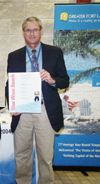 | STEPHEN HIGGINS
BEACH WIZZARD |
Broward�s former Beach Administrator Stephen Higgins reported, �The County is investigating the feasibility of moving between 50,000 and 90,000 cubic yards of excess sand from the upland beach north of Port Everglades to a hot-spot location along south Hollywood and north Hallandale Beach.� Performing smaller, more frequent sand placements at erosion hot-spots would only require what he called �sands of opportunity,� relieving pressure on thinning dredge sites. Higgins also anticipated using erosion control structures to slow erosion along other coastal hot-spots. He said, �The County is currently monitoring the equilibration of the beach fill to ascertain any impacts that might occur to the nearshore hardbottoms from migrating sand.�
 | | T-GROINS EXPOSED SOUTH OF PORT INLET |
The sand bypass had a larger purpose. In contrast with past beach projects that were largely neglected once completed, the County planned a maintenance component to ensure the extended health of the rehabilitated beaches, thereby postponing the need for (and expense of) future renourishments. Although sand naturally migrates south along the coast, intermittent special attention to certain �erosion hot spots� that evacuate at an accelerated rate could slow the need for future full scale renourishments.
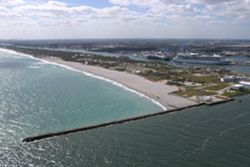 | | PORT EVERGLADES INLET SAND COVERS GROINS |
By interrupting the alongshore movement of sand, stabilized inlets such as the Hillsboro Inlet and the Port Everglades entrance channel are responsible for 85% of beach erosion in Florida. Sand bypassing is a process by which sand is artificially captured on the updrift side of the inlet and transferred to downdrift beaches. The Port Everglades Sand Bypass Project will modify the Port Everglades inlet by constructing a 7.1-acre sand trap on the north side of the Port entrance channel to a depth of � 49 feet (below mean sea level), a depth comparable to that of the existing Port channel.
The purpose of the project is to reduce sand accumulation in the federal navigational channel and provide an opportunity to transport the sand to the beach south of the Port Everglades inlet by dredging the sand trap at 2 to 4 year intervals. After being transferred to the John U. Lloyd State Park beach, the sand would continue migrating down the coast.
Hollywood & Hallandale Covet Segment II Sand
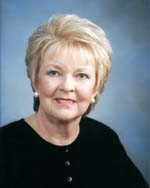 | FORMER COMMISSIONER
CHRISTINE TEEL |
In November of 2008, former District 1 Commissioner Christine Teel forwarded an email to GMCA officials about an agenda item from the November 13, 2008 Broward County Commission meeting. Entitled �Beach Erosion,� it divulged 1) how a sand shortage could delay the Fort Lauderdale (Segment II) renourishment, 2) the need to �reevaluate the Segment II project in the context of current economic and environmental conditions� and 3) a study update about �erosion control structures to be employed along the County�s shoreline to reduce the rates of erosion and help sustain our beach nourishment projects.�
 One month earlier, Higgins attended an unpublicized meeting in Hollywood. Complaining that their recently renourished beaches had lost a few feet of sand, powerful South Broward business leaders and politicians pressed Higgins to leapfrog the project schedule and give their marginal erosion deficit priority over the Segment II renourishment. When Galt Mile residents learned that their sand was covertly coveted by Hollywood officials, they went ballistic. One month earlier, Higgins attended an unpublicized meeting in Hollywood. Complaining that their recently renourished beaches had lost a few feet of sand, powerful South Broward business leaders and politicians pressed Higgins to leapfrog the project schedule and give their marginal erosion deficit priority over the Segment II renourishment. When Galt Mile residents learned that their sand was covertly coveted by Hollywood officials, they went ballistic.
 | | MARA GIULIANTI, ELEANOR SOBEL AND SUE GUNZBURGER |
In 2002, the south county Segment III part of the project was facing fierce opposition from pseudo-environmental groups hastily recruited by the Scuba Industry (which stood to lose $millions during the project�s planned temporary reef closures). Former Hollywood Mayor Mara Giulianti, District 6 Broward Commissioner Sue Gunzburger and Hollywood legislator Eleanor Sobel (former Statehouse Representative now in the Florida Senate) pleaded with Barrier Island beach communities to help them convince Tallahassee of the project�s necessity.
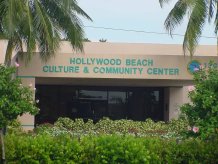 | | HOLLYWOOD BEACH COMMUNITY CENTER |
The only substantial response came from the Galt Mile Community Association. On April 30, 2002, more than 150 residents of the Galt Ocean Mile (2 busloads) descended on a public hearing at the Hollywood Beach Community Center in support of the Army Corps of Engineers plan to renourish the County�s shrinking beaches. On May 13, 2003 (one year later), a contingent of eight Galt Mile residents flew to Tallahassee and testified at a Florida Cabinet hearing convened to ascertain whether the project should include Fort Lauderdale�s eroded beaches and if beach community homeowners supported the County plan. Their overwhelmingly favorable testimony elicited the Cabinet�s unanimous approval.
 Indebted to their Galt Mile neighbors for the impending rescue of their eroded beaches, grateful South County officials promised to return the favor by pledging their support for Segment II (in Fort Lauderdale). In a bald-faced act of betrayal, these same politicians later launched a stealth campaign to hijack the sand earmarked for Fort Lauderdale�s beaches. Indebted to their Galt Mile neighbors for the impending rescue of their eroded beaches, grateful South County officials promised to return the favor by pledging their support for Segment II (in Fort Lauderdale). In a bald-faced act of betrayal, these same politicians later launched a stealth campaign to hijack the sand earmarked for Fort Lauderdale�s beaches.
 Anger over the attempt to usurp Segment II renourishment resources was exacerbated by its perpetration by the community�s supposed �allies�. Empathetic with Galt Mile civic leaders, on January 6, 2009, the Fort Lauderdale City Commission passed Resolution 9-11, Section 2 of which �requests that construction of the Segment II beach renourishment project be completed prior to any permit being issued for the construction of the Port Everglades Entrance Sand Bypass Project.� Anger over the attempt to usurp Segment II renourishment resources was exacerbated by its perpetration by the community�s supposed �allies�. Empathetic with Galt Mile civic leaders, on January 6, 2009, the Fort Lauderdale City Commission passed Resolution 9-11, Section 2 of which �requests that construction of the Segment II beach renourishment project be completed prior to any permit being issued for the construction of the Port Everglades Entrance Sand Bypass Project.�
Beach Project Derailed
 | FORMER FDEP SECRETARY
MICHAEL W. SOLE |
Things soon got worse. When Higgins failed to respond to inquiries about Segment II delays in 2008 and 2009, GMCA officials contacted then Florida Department of Environmental Protection (FDEP) Secretary Michael Sole, who confirmed that Higgins� Broward Biological Resources Division hadn�t responded to State Departmental inquiries for more than a year. While the two agencies were locked in this eerie limbo, the Federal and State permits authorizing the project expired.
 Prior to proceeding with Segment II, Broward beach officials would first have to repeat the environmental testing required for a new federal permit. Since Michael Sole � by training an accredited Marine Biologist � worked with Higgins in Broward County prior to his FDEP appointment, he was familiar with the project�s scientific and engineering parameters. While a painful repetition of the federal permit process was unavoidable, Secretary Sole granted Higgins a 5-year State permit extension through June 4, 2014, saving County beach officials months of bureaucratic tedium. The extension proved to be a parting gift. A year later, Sole stepped down as FDEP chief while overseeing the State�s response to the Deepwater Horizon fiasco and accepted an offer from Florida Power & Light to serve as Vice President of their Governmental Affairs Department. Welcome to Florida! Prior to proceeding with Segment II, Broward beach officials would first have to repeat the environmental testing required for a new federal permit. Since Michael Sole � by training an accredited Marine Biologist � worked with Higgins in Broward County prior to his FDEP appointment, he was familiar with the project�s scientific and engineering parameters. While a painful repetition of the federal permit process was unavoidable, Secretary Sole granted Higgins a 5-year State permit extension through June 4, 2014, saving County beach officials months of bureaucratic tedium. The extension proved to be a parting gift. A year later, Sole stepped down as FDEP chief while overseeing the State�s response to the Deepwater Horizon fiasco and accepted an offer from Florida Power & Light to serve as Vice President of their Governmental Affairs Department. Welcome to Florida!
 | BROWARD Administrator
BERTHA HENRY |
When public officials in Fort Lauderdale, Lauderdale-by-the-Sea, Pompano Beach and other Segment II project stakeholders learned that the County fell asleep at the wheel, they went looking for scalps. Hoping to quell the exploding rancor, Broward County Administrator Bertha Henry sent a beach renourishment update to former Fort Lauderdale City Manager George Gretsas on May 27, 2010. She concluded her summary of beach project issues with the comment �Broward County-conducted beach construction in Segment II is targeted for November of 2011, pending completion of the engineering/design and permitting processes in a timely fashion.� Shortly afterwards, Beach Administrator Higgins announced that he would retire in 2011. Although he would continue as a consultant, his primary duties would be assumed by his boss, Deputy Director Eric Myers of Broward�s Environmental Protection and Growth Management Department.
Enter Eric Myers
 | | ERIC MYERS |
Apologizing for his predecessor�s enigmatic behavior, Myers twice told GMCA officials attending the February and May Presidents Council meetings �I understand that you have repeatedly been told that the project is scheduled for late 2011. I don�t believe that�s possible. Since we must first complete the Federal permit process and collect the State and Federal funds allocated to the project, a far more realistic target date is late 2013.�
 Myers has also worked to diffuse local animosities and refocus the feuding parties� objectives to rehabilitating the County�s beaches. Since 2008, City officials have repeatedly stonewalled County requests to implement the bypass project. With time, the angry reaction by Galt Mile officials to south county duplicity took a back seat to our shared objective - restoring the beach. Myers has also worked to diffuse local animosities and refocus the feuding parties� objectives to rehabilitating the County�s beaches. Since 2008, City officials have repeatedly stonewalled County requests to implement the bypass project. With time, the angry reaction by Galt Mile officials to south county duplicity took a back seat to our shared objective - restoring the beach.
 Rather than repeatedly relocate mountains of sand whenever tidal erosion shrinks the beach, planners engineered the project around sustainability. Designed to mesh with the natural southerly migration of sand along the shore, each of the interdependent plan segments lends stability to the overall shoreline. The soundness of each segment depends on the integrity of adjacent segments with special attention to �erosion hot spots�. In short, since Hollywood sand migrates from Fort Lauderdale, delaying Segment II also threatens Hollywood�s beaches. Rather than repeatedly relocate mountains of sand whenever tidal erosion shrinks the beach, planners engineered the project around sustainability. Designed to mesh with the natural southerly migration of sand along the shore, each of the interdependent plan segments lends stability to the overall shoreline. The soundness of each segment depends on the integrity of adjacent segments with special attention to �erosion hot spots�. In short, since Hollywood sand migrates from Fort Lauderdale, delaying Segment II also threatens Hollywood�s beaches.
The Bottom Line
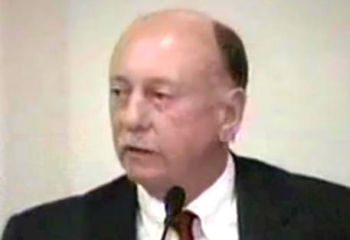 | | CITY COMMISSIONER BRUCE ROBERTS |
When Myers pitched the bypass at the May 17, 2011 Fort Lauderdale City Commission meeting, Commissioners salted some additional factors into the County formula. Commissioner Bruce Roberts told Myers that Galt Mile residents � whose staunch project advocacy was grounded in the belief that a healthy beach was critical to the area�s economy � have been waiting since 1998 for the County to make good on promises to renourish the Segment II beaches. Roberts insisted that its economic impact on both tourism and area businesses be incorporated into project protocols for cost effectiveness. Recalling that the last load of sand was deposited on the Diplomat Hotel beach, Commissioner Romney Rogers concluded that Fort Lauderdale should receive the next available infusion of sand.
 | FSBPA PRESIDENT
DEBBIE FLACK |
 According to President Debbie Flack of the Florida Shore and Beach Preservation Association, Commissioner Bruce Roberts is on the money. Flack confirms that every dollar spent on beach restoration yields an $8 return in tourism income. Roberts� recommendation recognizes that beach-driven tourism is one of the healthiest sectors of the State�s unstable economy. According to President Debbie Flack of the Florida Shore and Beach Preservation Association, Commissioner Bruce Roberts is on the money. Flack confirms that every dollar spent on beach restoration yields an $8 return in tourism income. Roberts� recommendation recognizes that beach-driven tourism is one of the healthiest sectors of the State�s unstable economy.
 And then came Charlotte. Instead of locating a sand catchment devise north of the inlet, Commissioner Rodstrom suggested using the Port�s entrance channel as a sand trap - which could be dredged when shipping began piling up in the increasingly impacted channel. Senior Engineer and Vice President Christopher Creed of Olsen Associates, Inc., a specialty engineering firm retained by Broward County, diplomatically exclaimed �I am not aware of any federal navigation channels that are used in that way.� And then came Charlotte. Instead of locating a sand catchment devise north of the inlet, Commissioner Rodstrom suggested using the Port�s entrance channel as a sand trap - which could be dredged when shipping began piling up in the increasingly impacted channel. Senior Engineer and Vice President Christopher Creed of Olsen Associates, Inc., a specialty engineering firm retained by Broward County, diplomatically exclaimed �I am not aware of any federal navigation channels that are used in that way.�
 | HOLLYWOOD MAYOR
PETER BOBER |
After almost four years of infighting, it appears that north and south county beach municipalities finally realize that the alternatives to working together are unacceptable. Since the initial rift in 2008, Hollywood Mayor Peter J.M. Bober offered two reasons why Hollywood won�t benefit from placing their interests above those of Fort Lauderdale. While admitting that there are places in Hollywood where the ocean abuts the seawall, sand conserved from the bypass wouldn�t reach them for years. Stressing the importance of maintaining municipal collegiality, he added �Hollywood is not interested in doing anything that would give us any unfair advantage or cause any detriment to Fort Lauderdale residents or the City�s reputation.� The politically correct rhetoric aside, Bober knows that if the project is frozen by another conflict, everyone loses.
 If the parties fail to reunite behind assurances from Eric Myers, Fort Lauderdale and Pompano beaches will remain skeletal and beaches in Hollywood and Hallandale will quickly surrender their newly infused sand to tidal erosion. Accessing ever-tightening Federal funds and circumventing a Tallahassee Administration that wiped renourishment funds from the State budget will require the combined political muscle of every stakeholder. In addition to rehabilitating Broward�s muddied credibility and coalescing coastal municipalities behind the project, Myers is actively lobbying support from every beachfront neighborhood. If the parties fail to reunite behind assurances from Eric Myers, Fort Lauderdale and Pompano beaches will remain skeletal and beaches in Hollywood and Hallandale will quickly surrender their newly infused sand to tidal erosion. Accessing ever-tightening Federal funds and circumventing a Tallahassee Administration that wiped renourishment funds from the State budget will require the combined political muscle of every stakeholder. In addition to rehabilitating Broward�s muddied credibility and coalescing coastal municipalities behind the project, Myers is actively lobbying support from every beachfront neighborhood.
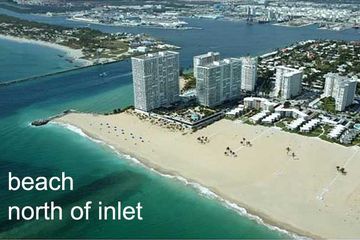
 | | SAINT SEBASTIAN CHURCH |
His next informational meeting about the sand bypass is scheduled for 7 PM on August 17th in the St. Sebastian Parish Hall at 2000 SE 25th Avenue in Fort Lauderdale. While Myers details the project�s overview, construction methods and environmental protections, attendees will likely be focused on the oversized storyboards behind the speaker. They dramatically contrast the healthy beach north of the inlet with the limp ribbon of sand to the south. The stated purpose of the meeting is �to review the current status of the project and ongoing efforts of determining the best way to construct the sand trap and jetty improvements.�
 When Mayor Seiler opened the May 17th Commission meeting to public comment, Point of Americas resident Ina Lee (associate publisher of the Fort Lauderdale/Hollywood edition of Travelhost magazine) rattled off a spate of disparate reasons for the Commission to refute Myers� advocacy of the sand bypass, culminating with an exhortation against �interfering with mother nature,� a strange admonition from someone who openly supports Broward�s beach renourishment. Not surprisingly, the Point of Americas Condominium sits directly on the �healthy beach north of the inlet.� Welcome to the world of NIMBY (not in my back yard). When Mayor Seiler opened the May 17th Commission meeting to public comment, Point of Americas resident Ina Lee (associate publisher of the Fort Lauderdale/Hollywood edition of Travelhost magazine) rattled off a spate of disparate reasons for the Commission to refute Myers� advocacy of the sand bypass, culminating with an exhortation against �interfering with mother nature,� a strange admonition from someone who openly supports Broward�s beach renourishment. Not surprisingly, the Point of Americas Condominium sits directly on the �healthy beach north of the inlet.� Welcome to the world of NIMBY (not in my back yard).

Click To Top of Page
Eric Myers to the Rescue

A Day at the Beach!

 | 2003 FLORIDA CABINET - AG CHARLIE CRIST
SEC. OF AGRICULTURE CHARLES BRONSON
GOV JEB BUSH, CFO TOM GALLAGHER |
 | THE HOLLYWOOD BEACH
COMMUNITY CENTER |
March 6, 2011 - On April 30, 2002, two busloads of Galt Mile residents attended a public hearing at the Hollywood Beach Community Center in support of the Army Corps of Engineers plan to renourish our shrinking beaches. On May 13, 2003, a contingent of eight Galt Mile residents flew to Tallahassee to refute allegations by vested interests in the Real Estate and Scuba lobbies that coastal residents �don�t want their beaches renourished.� Upon hearing our neighbors� testimony, the Florida Cabinet decided to include beaches from Fort Lauderdale to Pompano in the Broward County Shore Protection Project. To enhance environmental protections for the upcoming Segment II (Fort Lauderdale) stage of the County�s coastal rescue plan, the Florida Cabinet mandated an 18-month monitoring period following the renourishment of South Broward�s Segment III beaches.
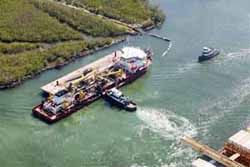 | HOPPER DREDGE LIBERTY ISLAND AT
JOHN U. LLOYD BEACH STATE PARK |
 When the hopper dredge �Liberty Island� pumped a last load of sand onto the beach at John U. Lloyd Beach State Park on February 8, 2006, it marked an end to the South County portion (Segment III) of the project and triggered the 18-month monitoring countdown. In late August of 2007, a report compiled by academicians from the Nova Oceanographic Center, a joint venture of coastal engineering consulting firms (Coastal Planning and Engineering, Inc., Olsen Asssociates, Inc., etc.) and Broward staff scientists arrived at the Tallahassee headquarters of the Florida Department of Environmental Protection (FDEP). When the hopper dredge �Liberty Island� pumped a last load of sand onto the beach at John U. Lloyd Beach State Park on February 8, 2006, it marked an end to the South County portion (Segment III) of the project and triggered the 18-month monitoring countdown. In late August of 2007, a report compiled by academicians from the Nova Oceanographic Center, a joint venture of coastal engineering consulting firms (Coastal Planning and Engineering, Inc., Olsen Asssociates, Inc., etc.) and Broward staff scientists arrived at the Tallahassee headquarters of the Florida Department of Environmental Protection (FDEP).
 | | THREATENED ELKHORN AND STAGHORN CORALS |
Noticing that the report documented two species of coral Federally designated as �threatened� in 2006, FDEP advised their Broward counterpart to add these new corals to the list of protected marine organisms prior to the upcoming Segment II project. Since Broward Beach Administrator Stephen Higgins built an impeccable reputation compiling scientifically bulletproof responses to similar modification requests, FDEP officials were understandably perplexed when Higgins seemingly fell off the map.
 | STEPHEN HIGGINS
BEACH WIZZARD |
For decades, Higgins spearheaded the County�s world class beach maintenance policy. He won staunch support for the renourishment program by addressing scientific concerns expressed by a formidable gauntlet of Federal, State and NGO (Non-Governmental Organizations) environmental watchdogs. His authoritative environmental treatises satisfied the Environmental Protection Agency (EPA), the National Marine Fisheries Service (NMFS) and the U.S. Fish and Wildlife Service (USFWS) in the Federal government. On the State level, his comprehensive reports made the Florida Fish and Wildlife Conservation Commission (FWCC) and the Florida Department of Environmental Protection (FDEP) into allies. Higgins� landmark environmental impact statements earned the respect of the Florida Audubon Society, the Nature Conservancy, Florida Communities Trust and prominent environmentalists like Roy Rogers.
 | FORMER FDEP SECRETARY
MICHAEL W. SOLE |
Suddenly, when asked by GMCA officials about the Segment II project, County beach officials responded with a series of irrelevant diversions throughout 2008 and 2009, focusing instead on additional erosion control devices and a nondescript search for sand. Concerned about the lack of progress, the Galt Mile Community Association contacted Michael Sole, who served as FDEP Secretary under former Governor Charlie Crist. Sole informed GMCA President Pio Ieraci that Broward Beach officials hadn�t responded to Departmental inquiries for more than a year. While the two agencies were locked in this dilatory two-step, the Federal and State permits authorizing the project expired.
 Prior to proceeding with Segment II, Broward beach officials would first have to repeat the environmental testing required for a new federal permit. Since Michael Sole, a Marine Biologist, worked with Higgins in Broward County before his appointment to FDEP, he was familiar with the project�s scientific and engineering parameters. While a painful repetition of the federal permit process was unavoidable, Sole granted Higgins a 5-year State permit extension through June 4, 2014, saving the Broward Beach Administrator months of bureaucratic tedium. The extension proved to be a parting gift. A year later, Sole stepped down as FDEP Secretary while overseeing the State�s response to the Deepwater Horizon fiasco and accepted an offer from Florida Power & Light to serve as Vice President of their Governmental Affairs Department. Prior to proceeding with Segment II, Broward beach officials would first have to repeat the environmental testing required for a new federal permit. Since Michael Sole, a Marine Biologist, worked with Higgins in Broward County before his appointment to FDEP, he was familiar with the project�s scientific and engineering parameters. While a painful repetition of the federal permit process was unavoidable, Sole granted Higgins a 5-year State permit extension through June 4, 2014, saving the Broward Beach Administrator months of bureaucratic tedium. The extension proved to be a parting gift. A year later, Sole stepped down as FDEP Secretary while overseeing the State�s response to the Deepwater Horizon fiasco and accepted an offer from Florida Power & Light to serve as Vice President of their Governmental Affairs Department.
 | BROWARD Administrator
BERTHA HENRY |
When public officials in Fort Lauderdale, Lauderdale-by-the-Sea, Deerfield Beach, Pompano and other project stakeholders learned about the County�s monumental misstep, they went ballistic. Hoping to quell the exploding enmity, Broward County Administrator Bertha Henry sent a beach renourishment update to former Fort Lauderdale City Manager George Gretsas on May 27, 2010. She concluded her summary of beach project issues with the comment �Broward County-conducted beach construction in Segment II is targeted for November of 2011, pending completion of the engineering/design and permitting processes in a timely fashion.� Shortly afterwards, Beach Administrator Higgins announced that he would retire in 2011. Although he would continue as a consultant, his primary duties would be assumed by Deputy Director Eric Myers of Broward�s Environmental Protection and Growth Management Department. Myers was Higgins� boss.

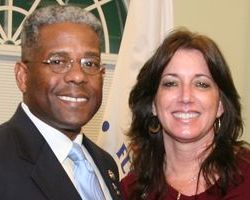 | CONGRESSMAN ALLEN WEST AND
STATE SENATOR ELLYN BOGDANOFF |
On February 3, 2011, Myers attended the Town Hall meeting convened to introduce newly elected Congressman Allen West and Florida State Senator Ellyn Bogdanoff. Since the beach renourishment project is a joint federal, state and county effort, he was soliciting Allen West�s assistance in securing promised federal reimbursement for funds advanced by the County. After offering an unqualified apology for Broward�s gaffe, Myers asked attending GMCA officials what he could do to help �make things right.� Myers would have to accept responsibility for his agency�s breakdown prior to resurrecting its ruptured reputation. He was invited to attend the February 7th Presidents Council meeting at Coral Ridge Towers, where he would have an opportunity to confront flustered constituents.
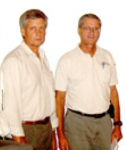 | | ERIC MYERS AND STEVE HIGGINS |
At the meeting, Myers shared the floor with City Commissioner Bruce Roberts and County Commissioner Chip LaMarca. Admitting to the County�s exasperating lapse, he told association officials that he would hereon in provide regular updates about the renourishment project. He also promised to avoid sugar coating reports with political spin. Exclaiming that he wants to build a relationship based on mutual trust, Myers said that he will need community support to achieve our common objectives.
 When irate attendees roasted Myers for his predecessor�s dereliction, he conceded their right to be angry. Myers then lowered the boom, stating �I understand that you have repeatedly been told that the project is scheduled for late 2011. I don�t believe that�s possible. Since we must first complete the Federal permit process and collect the State and Federal funds allocated to the project, a far more realistic target date is late 2013.� Roughly 80 attending association officials groaned in unison. When irate attendees roasted Myers for his predecessor�s dereliction, he conceded their right to be angry. Myers then lowered the boom, stating �I understand that you have repeatedly been told that the project is scheduled for late 2011. I don�t believe that�s possible. Since we must first complete the Federal permit process and collect the State and Federal funds allocated to the project, a far more realistic target date is late 2013.� Roughly 80 attending association officials groaned in unison.
 For the past decade, increasingly frustrated Galt Mile residents have been anxiously awaiting promised repairs to what the Florida Department of Environmental Protection characterized as �Broward�s severely eroded beaches.� Given the County�s cosmic blunder, beach officials must now also address its residents� severely eroded nerves. After offering an olive branch to the Galt Mile community, Myers said that he assigned himself that task. For the past decade, increasingly frustrated Galt Mile residents have been anxiously awaiting promised repairs to what the Florida Department of Environmental Protection characterized as �Broward�s severely eroded beaches.� Given the County�s cosmic blunder, beach officials must now also address its residents� severely eroded nerves. After offering an olive branch to the Galt Mile community, Myers said that he assigned himself that task.
 | | ERIC MYERS |
True to his word, Myers returned to address the May 2nd Presidents Council meeting at Ocean Manor. He reported some success with collecting funds reimbursed to Broward for the completed south county segment of the renourishment project. He estimated that the federal permitting hurdles for Segment II (Fort Lauderdale � Galt Mile) would consume the next 18 to 20 months, after which the county can begin accepting contractor bids. He further refined the projected start date to October 2013.
 Myers explained that the Army Corps of Engineers, an agency whose Final Environmental Impact Statement (FEIS), General Reevaluation Report (GRR) and Record of Decision (ROD) are prerequisites to the Federal permit, will be performing tests along the entire Segment II oceanfront, including the Galt Mile beach. Since beach ownership is shared by the associations lining the shore, the agency�s engineers must request access before they can proceed with fulfilling the terms of the permit. Reminding attendees that he promised to expedite the project whenever possible, Myers said, �If each beachfront association would sign an easement providing beach access to the Corps of Engineers, it would speed things up. I will send a copy of the easement to Pio (Ieraci) and Eric (Berkowitz), who can then distribute the document.� Myers explained that the Army Corps of Engineers, an agency whose Final Environmental Impact Statement (FEIS), General Reevaluation Report (GRR) and Record of Decision (ROD) are prerequisites to the Federal permit, will be performing tests along the entire Segment II oceanfront, including the Galt Mile beach. Since beach ownership is shared by the associations lining the shore, the agency�s engineers must request access before they can proceed with fulfilling the terms of the permit. Reminding attendees that he promised to expedite the project whenever possible, Myers said, �If each beachfront association would sign an easement providing beach access to the Corps of Engineers, it would speed things up. I will send a copy of the easement to Pio (Ieraci) and Eric (Berkowitz), who can then distribute the document.�
 Following Myers� update, the two GMCA officials asked member associations to have their respective attorneys review and approve the easement prior to signing off. The legal review will insure that the easement is strictly limited to construction-related renourishment efforts, precluding any unintended concession of general access rights. Yes, boys and girls, we do own our beaches (subject to public riparian rights � of course). Following Myers� update, the two GMCA officials asked member associations to have their respective attorneys review and approve the easement prior to signing off. The legal review will insure that the easement is strictly limited to construction-related renourishment efforts, precluding any unintended concession of general access rights. Yes, boys and girls, we do own our beaches (subject to public riparian rights � of course).

Click To Top of Page


How Turtle-Safe Lighting Hit the Galt Mile

  January 22, 2011 - At the onset of the Sea Turtle nesting Season, Galt Mile residents notice a change in how the seaward side of their homes is illuminated at night. Lamps are suddenly fitted with yellow bulbs or turned off altogether. Others fixtures sprout strange shields or screens. While saving electricity is a prominent association budget objective, it doesn�t explain this seasonal phenomenon. January 22, 2011 - At the onset of the Sea Turtle nesting Season, Galt Mile residents notice a change in how the seaward side of their homes is illuminated at night. Lamps are suddenly fitted with yellow bulbs or turned off altogether. Others fixtures sprout strange shields or screens. While saving electricity is a prominent association budget objective, it doesn�t explain this seasonal phenomenon.
 In April, 2007, the City of Fort Lauderdale sent violation notices to every beachfront Galt Mile association. The blank notice area was footnoted with �6-51 Artificial Lighting Violation.�. The footnote referred to a little known city ordinance governing turtle-safe lighting requirements for beachfront communities. 14 days were allotted to cure the mysterious infraction. In a nutshell, it required associations to turn off lights illuminating the east side of each building during the eight-month turtle nesting season. In April, 2007, the City of Fort Lauderdale sent violation notices to every beachfront Galt Mile association. The blank notice area was footnoted with �6-51 Artificial Lighting Violation.�. The footnote referred to a little known city ordinance governing turtle-safe lighting requirements for beachfront communities. 14 days were allotted to cure the mysterious infraction. In a nutshell, it required associations to turn off lights illuminating the east side of each building during the eight-month turtle nesting season.
 Within 48 hours, confused and irate managers and association officials from fourteen Galt Mile Community Association (GMCA) members contacted the neighborhood association with questions about the surprise violation notice. The obscure 2003 ordinance was shelved when the 2004 and 2005 hurricane seasons made enforcement impossible. The notice was a ham-handed attempt to revive the dormant regulation. The ordinance opens with �It is the policy of the City of Fort Lauderdale that no artificial light shall illuminate any area of the incorporated beaches of Fort Lauderdale, Florida.� Any light source visible from the beach triggered a violation. Within 48 hours, confused and irate managers and association officials from fourteen Galt Mile Community Association (GMCA) members contacted the neighborhood association with questions about the surprise violation notice. The obscure 2003 ordinance was shelved when the 2004 and 2005 hurricane seasons made enforcement impossible. The notice was a ham-handed attempt to revive the dormant regulation. The ordinance opens with �It is the policy of the City of Fort Lauderdale that no artificial light shall illuminate any area of the incorporated beaches of Fort Lauderdale, Florida.� Any light source visible from the beach triggered a violation.
 Darkening the rear of every building within two weeks would produce intolerable insurance and security repercussions. Legal liability for trip and fall incidents on darkened association property would be unquestionably dumped onto the City. The wholesale subrogation of medical claims for injuries, especially from elderly victims, would become a line item in the municipal budget. It also threatened beachfront homeowners with serious security consequences. When the neighborhood association informed the compliance officer that the member associations would see him in court, he requested a meeting. Darkening the rear of every building within two weeks would produce intolerable insurance and security repercussions. Legal liability for trip and fall incidents on darkened association property would be unquestionably dumped onto the City. The wholesale subrogation of medical claims for injuries, especially from elderly victims, would become a line item in the municipal budget. It also threatened beachfront homeowners with serious security consequences. When the neighborhood association informed the compliance officer that the member associations would see him in court, he requested a meeting.
 | | TURTLE HATCHLING DEATH TRAP |
A few days later, GMCA officials met with Al Lovingshimer, the City of Fort Lauderdale Code Inspector who signed the notices. Addressing the heavy-handed manner in which associations were notified, Lovingshimer said �I regret any confusion caused by the threatening tone of the notices, we simply wanted to improve the survival rates for turtle hatchlings and their nesting mothers. It is unfortunate that half the boilerplate notice was devoted to non-compliance penalties. That was not the message we wanted to get across.� He was charged with enforcing an ordinance that few residents were familiar with and fewer understood. Lovingshimer said that he simply wanted to explain the ordinance to Galt Mile residents. After admitting, �I don�t know where to start,� he asked for help.
Riparian Road Kill

 | | TURTLE HATCHLINGS LEAVING NEST |
For millions of years, nesting female sea turtles have been laying their eggs on our beaches. Their hatchling turtles were guided to the ocean by an instinct to travel away from the dark silhouettes of dune vegetation and toward the moonlight-illuminated open ocean. In many highly populated coastal areas, artificial lights near the beach are brighter than the moonlit ocean, reversing the turtles� biological compass. Nesting females seeking the darkened shore instead head out to sea where they cannot lay their eggs. If they find the shore and successfully deposit their eggs, the disoriented hatchlings travel inland, toward the artificial lights, where they often die from dehydration or predation by fire ants and ghost crabs. They also become �road kill� on local thoroughfares.
 Sea turtles are either endangered or threatened (the loggerhead is the only species that has sufficient population to be classified as threatened in Florida). They are protected under the Federal Endangered Species Act of 1973 and Florida�s Marine Turtle Protection Act (379.2431, Florida Statutes). Florida Law (F.A.C. Rule 68E-1) also restricts molestation or harassment of marine turtles, nests or eggs as well as the marine turtle habitat. The Florida Department of Environmental Protection (FDEP) and the Florida Fish and Wildlife Conservation Commission (FWC) together review permits for coastal construction under Chapter 62B, F.A.C. (Florida Administrative Code) that affects Marine Turtles. The state of Florida developed a model lighting ordinance (62B-55, F.A.C.) to guide local governments in creating turtle-safe lighting ordinances. Sea turtles are either endangered or threatened (the loggerhead is the only species that has sufficient population to be classified as threatened in Florida). They are protected under the Federal Endangered Species Act of 1973 and Florida�s Marine Turtle Protection Act (379.2431, Florida Statutes). Florida Law (F.A.C. Rule 68E-1) also restricts molestation or harassment of marine turtles, nests or eggs as well as the marine turtle habitat. The Florida Department of Environmental Protection (FDEP) and the Florida Fish and Wildlife Conservation Commission (FWC) together review permits for coastal construction under Chapter 62B, F.A.C. (Florida Administrative Code) that affects Marine Turtles. The state of Florida developed a model lighting ordinance (62B-55, F.A.C.) to guide local governments in creating turtle-safe lighting ordinances.
 Broward County adopted Chapter 39, Article IX, Sec 39-107 in 1989. Ten years later, Pompano Beach followed their lead (Ords 99-18, 2000-64), Deerfield Beach in 2000 (Chapter 34, Article V, Sec 34-96), Hallandale Beach in 2001 (Ch. 6, Art. I), Lauderdale-by-the-Sea in 2002 and Fort Lauderdale in 2003 (Chapter 6, Article III, Div. 2, Sec. 6-51). Every jurisdiction that passed a local variation of the State template assigned a liaison to the Florida Fish and Wildlife Conservation Commission. Fort Lauderdale�s official contact in 2007 was Al Lovingshimer. Broward County adopted Chapter 39, Article IX, Sec 39-107 in 1989. Ten years later, Pompano Beach followed their lead (Ords 99-18, 2000-64), Deerfield Beach in 2000 (Chapter 34, Article V, Sec 34-96), Hallandale Beach in 2001 (Ch. 6, Art. I), Lauderdale-by-the-Sea in 2002 and Fort Lauderdale in 2003 (Chapter 6, Article III, Div. 2, Sec. 6-51). Every jurisdiction that passed a local variation of the State template assigned a liaison to the Florida Fish and Wildlife Conservation Commission. Fort Lauderdale�s official contact in 2007 was Al Lovingshimer.
Environmental Spooks

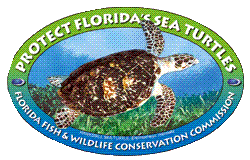 Lovingshimer complained that the City was being pressured by Tallahassee to achieve results at the expense of public safety. As the City�s liaison officer with Florida Fish & Wildlife�s (FWC) Sea Turtle program, he was summoned to Tallahassee for workshops organized to prepare local �representatives� for their duties. While most of the FWC personnel openly advocated diplomacy, restraint, education and good sense when enforcing a turtle-safe lighting ordinance, several oversight program officials attempted to enlist code officers to an agenda that deliberately fueled controversy with coastal residents. Postulating that the State�s coastal environment could only be salvaged by purging beachfront residents, these bureaucrats were considerably more interested in fomenting a protracted environmental litigation than saving hatchlings. Lovingshimer complained that the City was being pressured by Tallahassee to achieve results at the expense of public safety. As the City�s liaison officer with Florida Fish & Wildlife�s (FWC) Sea Turtle program, he was summoned to Tallahassee for workshops organized to prepare local �representatives� for their duties. While most of the FWC personnel openly advocated diplomacy, restraint, education and good sense when enforcing a turtle-safe lighting ordinance, several oversight program officials attempted to enlist code officers to an agenda that deliberately fueled controversy with coastal residents. Postulating that the State�s coastal environment could only be salvaged by purging beachfront residents, these bureaucrats were considerably more interested in fomenting a protracted environmental litigation than saving hatchlings.
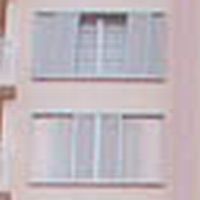 | WINDOWS SHUTTERED FOR
8-MONTH NESTING SEASON??? |
 | FWC BIOLOGICAL ADMINISTRATOR
DR. ROBBIN TRINDELL |
When Lovingshimer asked why he should follow their advice and risk a reprimand or suspension, they told him that this was a war, requiring �whatever it takes� to win. Lovingshimer described an incident wherein he was approached by two FWC officials who asked if he would be willing to order the shuttering of all windows overlooking the beach for the turtle nesting season (a mitigation strategy described in the ordinance). Another asked if he could disable (vandalize) lamps on private property (not part of the ordinance). He characterized them as a small but vocal clique of �dangerous CIA wannabes� who promote a radical agenda from within the State�s environmental bureaucracy. Emphasizing that they do not reflect official FWC policy, Lovingshimer commented, �It�s too bad, Dr. Trindell (FWC Marine Turtle Program Biological Administrator Dr. Robbin Trindell) has done so much to rescue these species from extinction while these loose cannons are undermining her efforts.� He assured GMCA officials that their efforts to recruit local compliance personnel failed, stating, �Professional code compliance officers are dedicated to resident safety, not declaring war on the residents they are supposed to protect.�
 | | CITY DARKENS A!A |
 GMCA officials were initially concerned that Lovingshimer�s anecdote was laced with paranoid overtones. However, when the City later turned off street lights along A1A before installing turtle-safe replacement lighting � virtually blackening the entire downtown beach area for months � it became evident that Lovingshimer was not only lucid, but dead on target. GMCA officials were initially concerned that Lovingshimer�s anecdote was laced with paranoid overtones. However, when the City later turned off street lights along A1A before installing turtle-safe replacement lighting � virtually blackening the entire downtown beach area for months � it became evident that Lovingshimer was not only lucid, but dead on target.
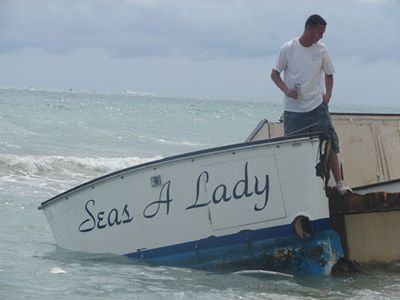 | | SEAS A LADY - NO IDENTIFICATION OR ENGINES |
The City got another dose of the State�s environmental schizophrenia when huge sections of the abandoned 50-foot fishing vessel �Seas a Lady� washed up on the Galt Mile beach on September 28, 2008. Despite complaints by hundreds of residents, former City Commissioner Christine Teel and Broward officials, the Florida Department of Environmental Protection refused to authorize cleanup of the admittedly hazardous wreck site, citing the proximity of a turtle nests � some hundreds of feet away. When the City Manager contacted FDEP weeks later, the agency still hadn�t scheduled an inspection of a nest they knew to be non-viable. When a health alert was released by municipal and county health authorities, Commissioner Teel and former City Manager George Gretsas finagled a jurisdictional loophole and managed the cleanup. Fearing a threatened class action lawsuit by residents, the State backed off.
 | | HUGE HAZARDOUS HULL SECTION |
Ironically, the coastal Armageddon planned by Lovingshimer�s �CIA wannabes� has seen a modicum of local traction. Repeatedly chaffed by the State�s callous treatment of Galt Mile residents, some of our irate neighbors began crusading against environmental issues they historically supported. Local blogs became filled with anti- and pro-Sea Turtle rantings. Emails sent to newspapers and the GMCA by otherwise environmentally conscientious people suddenly expressed a level of hate for turtles that is usually reserved for mass murderers. At the height of last year�s nesting season, when scores of residents sent admiring pictures of nest sites and hatchlings to the neighborhood association, less affable correspondences suggested opening seasonal �turtle bars� specializing in fried hatchlings or fresh soup.
  Responding to GMCA safety concerns for suddenly darkening the beach side of every association, Lovingshimer stressed the importance of finding a viable balance between residents� safety and survival prospects for the endangered species. He said that using motion detectors, screens, shields, downlights and fixtures incorporating light-management techniques could expedite compliance while minimizing many of the adverse safety impacts. Lovingshimer remarked �Since the ordinance was first passed, research has provided inexpensive new lighting options to address the problems for both people and turtles.� Lovingshimer confided that he would consider his efforts successful if he could deliver a 50% improvement within two to three years. Responding to GMCA safety concerns for suddenly darkening the beach side of every association, Lovingshimer stressed the importance of finding a viable balance between residents� safety and survival prospects for the endangered species. He said that using motion detectors, screens, shields, downlights and fixtures incorporating light-management techniques could expedite compliance while minimizing many of the adverse safety impacts. Lovingshimer remarked �Since the ordinance was first passed, research has provided inexpensive new lighting options to address the problems for both people and turtles.� Lovingshimer confided that he would consider his efforts successful if he could deliver a 50% improvement within two to three years.
  Months earlier, academicians from Nova Southeast University patrolled the entire Fort Lauderdale coast to evaluate light sources illuminating the beach. As they passed each building, a camera operator videotaped the structure�s ocean-facing east side while a colleague scripted relevant observations. They documented the placement and intensity of every light visible from the beach. Their report formed the basis for the violation notices later received by Galt Mile associations. Months earlier, academicians from Nova Southeast University patrolled the entire Fort Lauderdale coast to evaluate light sources illuminating the beach. As they passed each building, a camera operator videotaped the structure�s ocean-facing east side while a colleague scripted relevant observations. They documented the placement and intensity of every light visible from the beach. Their report formed the basis for the violation notices later received by Galt Mile associations.
Negotiating Ingredients


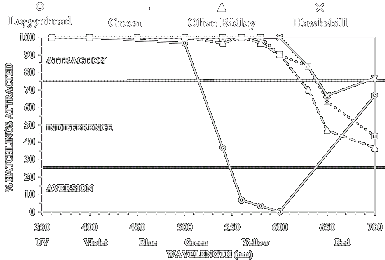 | | HOW COLOR (WAVELENGTH) OF LIGHT IMPACTS TURTLE BEHAVIOR |
Using data recorded by the Nova team, Lovingshimer and GMCA officials opened a good faith negotiation. Lighting violations were first graded by their degree of impact on Sea Turtle behavior. The factors included color, brightness, proximity to the beach, and broadcast characteristics. The brightest lights that were closest to the beach were assigned an �A� rating while ambient or indirect light sources (much dimmer reflected light) were assigned �D� ratings. With the help of a lighting contractor, infractions were cross-classified by mitigation cost.
 There are minor variations in how the 5 local species (Loggerhead, Green, Leatherback, Kemp�s Ridley, Hawksbill) of Sea Turtles react to color, although they are all sensitive to colors with short wavelengths. Ranging into the ultraviolet, their color perception is strongest for short wavelength spectral violets, purples, blues and greens. The relatively high sensitivity of turtles to short wavelengths is not surprising considering that they live in a medium � the ocean � which selectively filters out long wavelength colors (to see brightly colored red, yellow or orange marine life, you�d better sign up for a shallow dive). There are minor variations in how the 5 local species (Loggerhead, Green, Leatherback, Kemp�s Ridley, Hawksbill) of Sea Turtles react to color, although they are all sensitive to colors with short wavelengths. Ranging into the ultraviolet, their color perception is strongest for short wavelength spectral violets, purples, blues and greens. The relatively high sensitivity of turtles to short wavelengths is not surprising considering that they live in a medium � the ocean � which selectively filters out long wavelength colors (to see brightly colored red, yellow or orange marine life, you�d better sign up for a shallow dive).
  As such, replacing standard white light sources (which include the entire visible spectrum) with monochromatic yellow, orange or red lights is one acceptable compliance option. The average commercially available �yellow bulb� is actually a full spectrum white light source encased in a glass bulb with a yellow coating. This is functionally identical to an ordinary white light source. To achieve compliance, the light source within the bulb must emit monochromatic (single wavelength) yellow light. While the two bulbs appear the same to us, not so for turtles! As such, replacing standard white light sources (which include the entire visible spectrum) with monochromatic yellow, orange or red lights is one acceptable compliance option. The average commercially available �yellow bulb� is actually a full spectrum white light source encased in a glass bulb with a yellow coating. This is functionally identical to an ordinary white light source. To achieve compliance, the light source within the bulb must emit monochromatic (single wavelength) yellow light. While the two bulbs appear the same to us, not so for turtles!
  After reviewing the crunched data, GMCA officials determined that a vast majority of the violations could be easily resolved by in-house maintenance staffers inserting aluminum/composite shields or screens into or next to existing fixtures. When properly applied, these devices blocked light that would otherwise illuminate the beach without darkening deck surfaces. In fact, installing shields fitted with reflective coatings actually increased deck illumination. Unfortunately, roughly 10% of the violations could only be addressed by completely replacing heavy duty deck lamps costing $thousands. This was a problem. After reviewing the crunched data, GMCA officials determined that a vast majority of the violations could be easily resolved by in-house maintenance staffers inserting aluminum/composite shields or screens into or next to existing fixtures. When properly applied, these devices blocked light that would otherwise illuminate the beach without darkening deck surfaces. In fact, installing shields fitted with reflective coatings actually increased deck illumination. Unfortunately, roughly 10% of the violations could only be addressed by completely replacing heavy duty deck lamps costing $thousands. This was a problem.
  Associations were still reeling from the huge fiscal battering suffered from storm damage repairs, skyrocketing windstorm insurance rates and installation costs of impact rated hurricane windows and/or shutters. The recession was already taking a toll on property values and assessment obligations were inflated by non-contributing units frozen in foreclosure. Elderly residents on fixed incomes were often forced to decide between filling a prescription and eating dinner. Any lighting adaptation plan would have to be accomplished on a shoestring. Given that most deck lamps last about ten years, when an offending lamp reached the end of its serviceable life, the association could install a turtle-safe replacement without placing an early burden on the budget. Associations were still reeling from the huge fiscal battering suffered from storm damage repairs, skyrocketing windstorm insurance rates and installation costs of impact rated hurricane windows and/or shutters. The recession was already taking a toll on property values and assessment obligations were inflated by non-contributing units frozen in foreclosure. Elderly residents on fixed incomes were often forced to decide between filling a prescription and eating dinner. Any lighting adaptation plan would have to be accomplished on a shoestring. Given that most deck lamps last about ten years, when an offending lamp reached the end of its serviceable life, the association could install a turtle-safe replacement without placing an early burden on the budget.
  In a proposal to Lovingshimer, we offered to guarantee voluntary mitigation for 90% of the violations within two to three months if the City would allow associations with deck lamp violations to postpone any action until the need for replacement was imminent. Moreover, since these high intensity deck lamps were installed on association parking decks - a substantial distance from the beach - none of them fell into the �A� (most threatening) category. After consulting with former Inspections Manager Cate McCaffrey, Lovingshimer agreed. Going forward, instead of automatically citing associations for violations, code inspectors would work with associations to insure that compliance didn�t sacrifice resident safety or blast holes in the association budget. In a proposal to Lovingshimer, we offered to guarantee voluntary mitigation for 90% of the violations within two to three months if the City would allow associations with deck lamp violations to postpone any action until the need for replacement was imminent. Moreover, since these high intensity deck lamps were installed on association parking decks - a substantial distance from the beach - none of them fell into the �A� (most threatening) category. After consulting with former Inspections Manager Cate McCaffrey, Lovingshimer agreed. Going forward, instead of automatically citing associations for violations, code inspectors would work with associations to insure that compliance didn�t sacrifice resident safety or blast holes in the association budget.
The Meeting

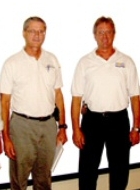 | STEPHEN HIGGINS
AND LOU FISHER |
 Following approval of the arrangement by the Galt Mile Advisory Board a few weeks later, former Code Compliance chief McCaffrey offered to address association concerns by participating in a joint presentation by City and County environmental officials. At the May 7, 2007 Presidents Council meeting in Playa del Mar, after Lovingshimer summarized the general agreement, Natural Resource Specialist Lou Fisher from the Beach and Marine Section of Broward County�s Natural Resources Planning and Management Division described how various types of lighting affect Sea Turtle nesting habits and hatchling behavior � the scientific rationale for the ordinance. Fisher works with retiring Broward Beach Administrator Stephen Higgins, a primary engineer of the Broward County Beach Renourishment Project. Following approval of the arrangement by the Galt Mile Advisory Board a few weeks later, former Code Compliance chief McCaffrey offered to address association concerns by participating in a joint presentation by City and County environmental officials. At the May 7, 2007 Presidents Council meeting in Playa del Mar, after Lovingshimer summarized the general agreement, Natural Resource Specialist Lou Fisher from the Beach and Marine Section of Broward County�s Natural Resources Planning and Management Division described how various types of lighting affect Sea Turtle nesting habits and hatchling behavior � the scientific rationale for the ordinance. Fisher works with retiring Broward Beach Administrator Stephen Higgins, a primary engineer of the Broward County Beach Renourishment Project.
 | BROWARD NAT RES
SPEC LOU FISHER |
After Fisher congratulated Galt Mile Associations for voluntarily creating a vehicle that balanced resident safety with Sea Turtle survival, Lovingshimer introduced a series of discourses by McCaffrey, Building Department Director Valerie Bohlander, Public Works Facilities Manager Tom Terrell and Environmental Services� Kris McFadden.
 | | VAL BOHLANDER |
Within the next three months, every association kept its commitment, addressing more than 90% of the lighting violations along the Galt Mile beach. Shortly after Lovingshimer declared the project a great success, the Galt Mile suddenly lost a good friend in Code Compliance � Al Lovingshimer passed away. On November 20, 2007, Lovingshimer was posthumously named �2007 Code Enforcement Officer of the Year� by Building Department chief Valerie Bohlander. Since then, several associations with deck lamp violations corrected those as well.
What Now?

  Following Al Lovingshimer�s untimely demise, Mike Maloney replaced Cate McCaffrey as Manager of the Code Compliance Division when Cate was named Director of Business Enterprises. GMCA officials met with Mr. Maloney at the Regency Tower to confirm our understanding with the City. By 2010, Lovingshimer�s �turtle-safe lighting� hat was passed to Code Compliance officer Mario Sotolongo. Not only is Sotolongo familiar with the neighborhood and experienced with helping member associations explore frugal compliance options - like Lovingshimer - he assigns a higher priority to resident safety than racking up numbers for depopulation spooks in Tallahassee. Following Al Lovingshimer�s untimely demise, Mike Maloney replaced Cate McCaffrey as Manager of the Code Compliance Division when Cate was named Director of Business Enterprises. GMCA officials met with Mr. Maloney at the Regency Tower to confirm our understanding with the City. By 2010, Lovingshimer�s �turtle-safe lighting� hat was passed to Code Compliance officer Mario Sotolongo. Not only is Sotolongo familiar with the neighborhood and experienced with helping member associations explore frugal compliance options - like Lovingshimer - he assigns a higher priority to resident safety than racking up numbers for depopulation spooks in Tallahassee.
 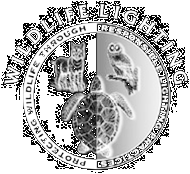 Since beachfront buildings first adapted seaward fixtures with shields and screens to quickly and inexpensively comply with City Law, the oceanfront evening environment of many associations has been noticeably darker for the past three years. Some association residents miss the brighter pool deck and patio walkway during evening constitutionals. As lamps that were hastily jury-rigged with blocking devices a few years ago give up the ghost, they can be replaced with high intensity bollards and other directional fixtures � preferably as part of a professional lighting plan � that will brighten the deck without illuminating the adjacent beach. Since beachfront buildings first adapted seaward fixtures with shields and screens to quickly and inexpensively comply with City Law, the oceanfront evening environment of many associations has been noticeably darker for the past three years. Some association residents miss the brighter pool deck and patio walkway during evening constitutionals. As lamps that were hastily jury-rigged with blocking devices a few years ago give up the ghost, they can be replaced with high intensity bollards and other directional fixtures � preferably as part of a professional lighting plan � that will brighten the deck without illuminating the adjacent beach.
A Heads Up

 A few months ago, several associations reported receiving telephone threats from someone claiming membership in an organization with enforcement authority for the City lighting ordinance. The caller threatened the associations with punitive consequences unless certain lighting elements were immediately altered. After investigating the incidents and contacting Fort Lauderdale�s Code Compliance Division, the claim was found to be fraudulent. A few months ago, several associations reported receiving telephone threats from someone claiming membership in an organization with enforcement authority for the City lighting ordinance. The caller threatened the associations with punitive consequences unless certain lighting elements were immediately altered. After investigating the incidents and contacting Fort Lauderdale�s Code Compliance Division, the claim was found to be fraudulent.
 The caller actually belonged to a group with a permit to rescue endangered hatchlings and document disorientation events. They have no authority to issue violation notices or exact penalties. Evidently, the calls were made by an overzealous volunteer who seemingly overstepped the bounds of her organization�s mandate. Since the incident isn�t reflective of how the organization ordinarily operates, the parties shall remain nameless. The caller actually belonged to a group with a permit to rescue endangered hatchlings and document disorientation events. They have no authority to issue violation notices or exact penalties. Evidently, the calls were made by an overzealous volunteer who seemingly overstepped the bounds of her organization�s mandate. Since the incident isn�t reflective of how the organization ordinarily operates, the parties shall remain nameless.
 | | FORT LAUDERDALE BUILDING DEPARTMENT |
Inasmuch, the only authority empowered to enforce the City�s lighting ordinance is the Code Compliance Division of the Fort Lauderdale Building Department. To avoid headaches and save money, associations planning to alter or upgrade their lighting should contact Mario Sotolongo at 954-828-6326. While keeping the neighborhood association up to speed, Mario spent the past few years working directly with member associations to remedy legitimate violations or reject baseless or unreasonable complaints. In November, 2010, while assisting four Galt Mile associations upgrade or modify beachfront lighting, Sotolongo said �In this neighborhood, most people and their associations want to do the right thing. However, they want lighting solutions that are right for both people and turtles.� Words of wisdom!

Click To Top of Page
Bungled Beach Project Back on Track

County Administrator Releases Renourishment Report
 | THE HOLLYWOOD BEACH
COMMUNITY CENTER |
July 24, 2010 - On April 30, 2002, two busloads of Galt Mile residents attended a public hearing at the Hollywood Beach Community Center in support of the Army Corps of Engineers plan to renourish our shrinking beaches.  On May 13, 2003, a contingent of eight Galt Mile residents flew to Tallahassee to refute contentions by outside interests from the Real Estate and Scuba lobbies that coastal residents �don�t want their beaches renourished.� Our neighbors� testimony to the Florida Cabinet resulted in the inclusion of beaches from Fort Lauderdale to Pompano in the Broward Shore Protection Project. For the past decade, increasingly frustrated Galt Mile residents have been anxiously awaiting promised repairs to what the Florida Department of Environmental Protection characterized as their �severely eroded beach.� Although the project was temporarily derailed by events blending elements of �Waiting for Godot� with �The Three Stooges Meet Alice in Wonderland,� County Administrator Bertha Henry assures us that our sand is on the way. On May 13, 2003, a contingent of eight Galt Mile residents flew to Tallahassee to refute contentions by outside interests from the Real Estate and Scuba lobbies that coastal residents �don�t want their beaches renourished.� Our neighbors� testimony to the Florida Cabinet resulted in the inclusion of beaches from Fort Lauderdale to Pompano in the Broward Shore Protection Project. For the past decade, increasingly frustrated Galt Mile residents have been anxiously awaiting promised repairs to what the Florida Department of Environmental Protection characterized as their �severely eroded beach.� Although the project was temporarily derailed by events blending elements of �Waiting for Godot� with �The Three Stooges Meet Alice in Wonderland,� County Administrator Bertha Henry assures us that our sand is on the way.
 | HOPPER DREDGE LIBERTY ISLAND AT
JOHN U. LLOYD BEACH STATE PARK |
When the hopper dredge �Liberty Island� pumped out a last load of sand onto the beach at John U. Lloyd Beach State Park on February 8, 2006, it marked an end to the South Broward portion (Segment III) of the Broward Beach Renourishment Project. Unlike previous beach renourishment efforts, wherein sand was simply dredged offshore and dumped onto eroded beaches, Broward Beach Administrator Steve Higgins delivered a plan based on sustainability. While adding 100 to 150 feet of sand to beaches in Hollywood, Hallandale Beach and Dania Beach, his plan also provided for construction of three boulder mound erosion control structures at the northern end of John U. Lloyd Beach State Park.
 | SAND BYPASS EROSION CONTROL
AT PORT EVERGLADES INLET |
Coastal inlets, such as the entrance to Port Everglades, disrupt the natural southerly migration of sand along the shore. This erosion control architecture will serve to stabilize the beach at that very dynamic location without adverse down drift impacts. In addition to protecting the Port, these structures will extend the effective life of the renourishment. Higgins foresees replacing the need for future full scale renourishments with a series of small fills targeting the hot spots primarily responsible for sand expunged from the system.
 At the May 13, 2003 meeting of the Florida Cabinet, representatives of every major grass roots and governmental environmental organization stressed the importance of preserving the beach habitat by implementing the Beach Renourishment plan approved by the U.S. Army Corps of Engineers and further adapted by every Federal and State Environmental Agency. To better protect the surrounding marine environment, the Florida Cabinet mandated an 18-month monitoring period following the renourishment of South Broward�s beaches. Data included in a subsequent report to the Florida Department of Environmental Protection (DEP) would be used to enhance environmental mitigations for the next stage (Segment II) of the County�s comprehensive coastal rescue plan. At the May 13, 2003 meeting of the Florida Cabinet, representatives of every major grass roots and governmental environmental organization stressed the importance of preserving the beach habitat by implementing the Beach Renourishment plan approved by the U.S. Army Corps of Engineers and further adapted by every Federal and State Environmental Agency. To better protect the surrounding marine environment, the Florida Cabinet mandated an 18-month monitoring period following the renourishment of South Broward�s beaches. Data included in a subsequent report to the Florida Department of Environmental Protection (DEP) would be used to enhance environmental mitigations for the next stage (Segment II) of the County�s comprehensive coastal rescue plan.
 After the monitoring period ended in late August of 2007, a report was compiled by the official monitors from Nova Southeastern University and a joint venture of coastal engineering consulting firms, including Coastal Planning and Engineering, Inc. and Olsen Asssociates, Inc. When it arrived in Tallahassee, the Florida Department of Environmental Protection (DEP) analyzed their observations. Along with an evaluation of the post-renourishment beach environment, the report documented two species of coral in the catchment area that the federal government designated as �threatened� in 2006. DEP notified their Broward counterpart that these new corals should be added to the list of protected marine organisms prior to the upcoming Segment II project. After the monitoring period ended in late August of 2007, a report was compiled by the official monitors from Nova Southeastern University and a joint venture of coastal engineering consulting firms, including Coastal Planning and Engineering, Inc. and Olsen Asssociates, Inc. When it arrived in Tallahassee, the Florida Department of Environmental Protection (DEP) analyzed their observations. Along with an evaluation of the post-renourishment beach environment, the report documented two species of coral in the catchment area that the federal government designated as �threatened� in 2006. DEP notified their Broward counterpart that these new corals should be added to the list of protected marine organisms prior to the upcoming Segment II project.
 Following several housekeeping correspondences addressing port inlet maintenance, communications between the Broward Biological Resources Division and the Florida Department of Environmental Protection inexplicably broke down. When asked by GMCA officials about the Segment II project, the County beach officials responded with a series of irrelevant diversions throughout 2008 and 2009, focusing instead on additional erosion control devices and a nondescript hunt for sand. When the County applied to the City of Fort Lauderdale for permission to enhance erosion control at Port Everglades on January 6, 2009, a frustrated City Commission refused access to the County, insisting that they first complete the promised Segment II renourishment of Fort Lauderdale�s beaches. Following several housekeeping correspondences addressing port inlet maintenance, communications between the Broward Biological Resources Division and the Florida Department of Environmental Protection inexplicably broke down. When asked by GMCA officials about the Segment II project, the County beach officials responded with a series of irrelevant diversions throughout 2008 and 2009, focusing instead on additional erosion control devices and a nondescript hunt for sand. When the County applied to the City of Fort Lauderdale for permission to enhance erosion control at Port Everglades on January 6, 2009, a frustrated City Commission refused access to the County, insisting that they first complete the promised Segment II renourishment of Fort Lauderdale�s beaches.
 Soon after, the City posted a page on their web site entitled �Help Save Fort Lauderdale Beach,� which provides the email addresses of the County Commissioners and states �The Fort Lauderdale City Commissioners need your help to make sure that Fort Lauderdale is not pushed to the back of the line. Let Broward County know that you oppose the proposed Port Everglades Sand Bypass Project and that you want them to implement the Segment II Beach Renourishment Project as promised.� Their inclusion of Commissioner Keechl on the contact list wasn�t necessary, since he had previously emailed the City Commission expressing those same sentiments. Soon after, the City posted a page on their web site entitled �Help Save Fort Lauderdale Beach,� which provides the email addresses of the County Commissioners and states �The Fort Lauderdale City Commissioners need your help to make sure that Fort Lauderdale is not pushed to the back of the line. Let Broward County know that you oppose the proposed Port Everglades Sand Bypass Project and that you want them to implement the Segment II Beach Renourishment Project as promised.� Their inclusion of Commissioner Keechl on the contact list wasn�t necessary, since he had previously emailed the City Commission expressing those same sentiments.
 | FDEP SECRETARY
MICHAEL W. SOLE |
 Enraged by a two-year runaround, the GMCA Advisory Board launched its own investigation. Asked to ascertain the status of resources allocated to renourish the beach, Broward Commissioner Ken Keechl reported that the project�s Federal and State funding was intact. Upon contacting Secretary Michael Sole of the Florida Department of Environmental Protection, the GMCA learned that Broward Beach officials hadn�t responded to Departmental inquiries for the past year. While the two agencies were locked in a mysterious bureaucratic limbo, the Federal permit authorizing the project expired. When the GMCA reported this unfathomable stupidity to City officials and Commissioner Keechl, they went ballistic. Ordinarily restrained and imperturbable, Keechl promised someone�s �head on a platter.� Enraged by a two-year runaround, the GMCA Advisory Board launched its own investigation. Asked to ascertain the status of resources allocated to renourish the beach, Broward Commissioner Ken Keechl reported that the project�s Federal and State funding was intact. Upon contacting Secretary Michael Sole of the Florida Department of Environmental Protection, the GMCA learned that Broward Beach officials hadn�t responded to Departmental inquiries for the past year. While the two agencies were locked in a mysterious bureaucratic limbo, the Federal permit authorizing the project expired. When the GMCA reported this unfathomable stupidity to City officials and Commissioner Keechl, they went ballistic. Ordinarily restrained and imperturbable, Keechl promised someone�s �head on a platter.�
 | STEPHEN HIGGINS
BEACH WIZZARD |
Prior to proceeding with Segment II, Broward beach officials would first have to repeat the environmental testing required for a new federal permit. Fortunately, since DEP Chief Mike Sole came to Tallahassee via Broward County, he is intimately familiar with the project�s scientific and engineering parameters. While an arduous repetition of the federal permit process is unavoidable, in July of 2009, Sole had Beaches & Coastal Systems Environmental Administrator Martin Seeling grant Higgins a 5-year State permit extension through June 4, 2014, saving the Broward Beach Administrator months of additional paper shuffling.
The GMCA elicited an agreement from Sole to personally oversee future interagency communications and another from Keechl to closely follow the County�s progress. Factoring in the additional time required for permitting exigencies and statutory delays attendant to turtle nesting season, the Segment II starting date is projected for late 2011.
 Since the plan to rehabilitate our Segment II beaches was initially developed by the County and approved by the U.S. Army Corps of Engineers, the Broward coast has subsequently experienced severe incremental storm damage, predominantly from the serial hurricanes of 2004 and 2005. While all of the Segment II beaches were affected, several beach areas in Pompano and Lauderdale-by-the Sea suffered nearly full displacement. Prior to implementing the planned beach renourishment, a County-conceived interim effort is expected to return these beaches to their pre-storm (2004) condition - while providing a serendipitous benefit to the Galt Ocean Mile beach. Since the plan to rehabilitate our Segment II beaches was initially developed by the County and approved by the U.S. Army Corps of Engineers, the Broward coast has subsequently experienced severe incremental storm damage, predominantly from the serial hurricanes of 2004 and 2005. While all of the Segment II beaches were affected, several beach areas in Pompano and Lauderdale-by-the Sea suffered nearly full displacement. Prior to implementing the planned beach renourishment, a County-conceived interim effort is expected to return these beaches to their pre-storm (2004) condition - while providing a serendipitous benefit to the Galt Ocean Mile beach.
 The U.S. Army Corps of Engineers, Jacksonville District, has allocated $4.5 million to initiate the planning, engineering and design of an approved storm reclamation effort entitled �Flood Control and Coastal Emergencies Project� (FCCE). In a nutshell, before commencing the Segment II beach renourishment, the county plans to dump huge volumes of sand on compromised beach areas just north of Anglin�s Pier. Project engineers confirm that the sand will naturally drift south, providing a near-immediate benefit to the northernmost Galt Ocean Mile beach. Within months, the continually migrating sand will similarly enhance beach footage along the entire Galt Mile. Ultimately, along with roughly 100 to 150 feet of sand from the Segment II beach renourishment, the Galt Ocean Mile Beach should realize an additional 15 to 30 feet of beach area from the FCCE project. Former Director Steve Somerville of the Broward County Department of Planning and Environmental Protection (DPEP) offered this less than memorable observation at the 2003 Florida Cabinet hearing, �You can never have too much sand on the beach.� The U.S. Army Corps of Engineers, Jacksonville District, has allocated $4.5 million to initiate the planning, engineering and design of an approved storm reclamation effort entitled �Flood Control and Coastal Emergencies Project� (FCCE). In a nutshell, before commencing the Segment II beach renourishment, the county plans to dump huge volumes of sand on compromised beach areas just north of Anglin�s Pier. Project engineers confirm that the sand will naturally drift south, providing a near-immediate benefit to the northernmost Galt Ocean Mile beach. Within months, the continually migrating sand will similarly enhance beach footage along the entire Galt Mile. Ultimately, along with roughly 100 to 150 feet of sand from the Segment II beach renourishment, the Galt Ocean Mile Beach should realize an additional 15 to 30 feet of beach area from the FCCE project. Former Director Steve Somerville of the Broward County Department of Planning and Environmental Protection (DPEP) offered this less than memorable observation at the 2003 Florida Cabinet hearing, �You can never have too much sand on the beach.�
 | BROWARD Administrator
BERTHA HENRY |
On May 27, 2010, Broward County Administrator Bertha Henry compiled a correspondence for Fort Lauderdale City Manager George Gretsas entitled �Beach Nourishment Activities Quarterly Report�. The report is a status update of the two beach projects that affect every Galt Ocean Mile resident. Since the Broward Beach Renourishment Project and the Flood Control and Coastal Emergencies Project are both exercises in coastal engineering, Gretsas copied City Engineer Al Carbon as well as the City Commission on June 14th.
In addition to updates relating to Segments I and III of the Beach Renourishment Project, Bertha Henry�s notice to the City contained the following data about the General Information and Segment II project components. Read on...
|


Bertha W. Henry, County Administrator
115 S. Andrews Avenue, Room 409  Fort Lauderdale, Florida 33301 Fort Lauderdale, Florida 33301
PHONE: 954-357-7362  FAX: 954-357-7360 FAX: 954-357-7360

Broward County Beach Erosion Control Program
Status as of May 12, 2010
Beach Erosion Control, General:
 Structure Study: Staff is finalizing review of the draft study. Following revision by the consultants, copies of the final report will be coordinated with shorefront municipalities. Structure Study: Staff is finalizing review of the draft study. Following revision by the consultants, copies of the final report will be coordinated with shorefront municipalities.
Sand Search: The investigation located approximately 2.8 million cubic yards of sand offshore of the northern portion of the County, of which approximately 1.4 million cubic yards could be of adequate quality for use on our beaches, pending more detailed evaluations of sand quality and the potential for impacts to coral reef resources from use of the material.
Bahamian Sand: County staff is awaiting a response from the Bahamian Government to a request to purchase and import 200,000 cubic yards of Bahamian sand for a pilot project.
Funding Advocacy: Staff continues to work with state and national beach preservation associations, elected officials and agencies to advocate for continuation of state and federal funding for beach erosion control projects.
Segment II Beach Renourishment, Hillsboro Inlet to Port Everglades
 Project Reformation: The County is evaluating the design of the Segment II beach renourishment project in the context of current physical, economic and environmental conditions. The not-yet-formulated beach fill project could include material from one or more sand sources, and may involve sand brought in by truck. An agenda item for a consultant contract amendment to continue engineering/design and permitting will be coming before the Board of County Commissioners before summer break. The project could potentially result in sand placement on portions of beach in Fort Lauderdale, Lauderdale-by-the-Sea, and Pompano Beach. Project Reformation: The County is evaluating the design of the Segment II beach renourishment project in the context of current physical, economic and environmental conditions. The not-yet-formulated beach fill project could include material from one or more sand sources, and may involve sand brought in by truck. An agenda item for a consultant contract amendment to continue engineering/design and permitting will be coming before the Board of County Commissioners before summer break. The project could potentially result in sand placement on portions of beach in Fort Lauderdale, Lauderdale-by-the-Sea, and Pompano Beach.
Primary Issues:
 | | HARDBOTTOM MONITOR |
Increased regulation due to federal listing of two coral species found offshore of Broward County and the designation as critical of all hardbottom habitat;
Limited opportunity for dramatic widening of the beaches due to proximity of nearshore hardbottoms;
Increased regulatory emphasis on sand quality;
Costs for beach renourishment have increased while potential local, state, and federal funds have diminished.
Permitting: DEP has extended the formerly issued permit for nourishment of Segment II for five years while project reformulation is conducted. There is no equivalent draft federal permit, which means a new Corps of Engineers permit will be required for a nourishment of Segment II beaches.
 Federal Hurricane Beach Rehabilitation: The County has requested that the U.S. Army Corps of Engineers implement the approved Flood Control and Coastal Emergencies (FCCE) Project. The Jacksonville District Corps has allocated about $4.5 million to initiate planning, engineering and design of a project restore to pre-storm conditions the previously constructed (Hillsboro inlet to the Fort Lauderdale/Lauderdale-by-the-Sea border) Segment II nourishment project. The Corps calculated that approximately 330,000 cubic yards of material would be placed on those beaches. The schedule for construction and exact placement areas are to be determined. Federal Hurricane Beach Rehabilitation: The County has requested that the U.S. Army Corps of Engineers implement the approved Flood Control and Coastal Emergencies (FCCE) Project. The Jacksonville District Corps has allocated about $4.5 million to initiate planning, engineering and design of a project restore to pre-storm conditions the previously constructed (Hillsboro inlet to the Fort Lauderdale/Lauderdale-by-the-Sea border) Segment II nourishment project. The Corps calculated that approximately 330,000 cubic yards of material would be placed on those beaches. The schedule for construction and exact placement areas are to be determined.
Schedule: Broward County-conducted beach construction in Segment II is targeted for November of 2011, pending completion of the engineering/design and permitting processes in a timely fashion.

Bertha Henry
Broward County Administrator

|
|
While �heads on a platter� are a poor substitute for a healthy beach, Advisory Board members are sufficiently irate to take a cue from Mayor Keechl and �raise hell� if project progress is again victimized by ineptitude. As future notices are reviewed by the GMCA Advisory Board, they will also be posted on the Galt Mile web site. More to come...
Click To Top of Page
 Beach Project Stirs Suspicion Beach Project Stirs Suspicion 

Do South County  Pols Covet North County Sand? Pols Covet North County Sand?
November 25, 2008 - Most Galt Mile residents understand that the impending beach renourishment project is the single most critical improvement impacting the future of this neighborhood. According to a 2007 report by Broward beach administrator Steven Higgins, the Segment II beaches along Fort Lauderdale and the Galt Ocean Mile should start seeing new sand by the late fall of 2009. Since that announcement, inhabitants of north Broward beachfront neighborhoods have patiently anticipated the reclamation of their shrinking shoreline.
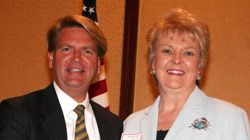 | BROWARD COMMISSIONER KEN KEECHL
AND CITY COMMISSIONER CHRISTINE TEEL |
For the past decade, the Galt Mile Community Association has battled misdirected attempts to subvert this project while continuously monitoring its progress. Broward Commissioner Ken Keechl and City Commissioner Christine Teel notify us when city or county issues threaten the renourishment project. Congressman Ron Klein similarly reports on prospective federal funding roadblocks. When some of their overambitious colleagues in Tallahassee try to hijack the dedicated state funding, new Senate President Jeffrey Atwater and Statehouse Majority Whip Ellyn Bogdanoff nail the strongbox shut. As we head into the home stretch, this multi-level oversight by our public officials has intensified. After enduring 10 years of delays and dozens of politically motivated attempts to undermine the project, when a new obstacle arises, community leaders become understandably frustrated and angry.
 | SENATE PRESIDENT JEFFREY ATWATER
HOUSE MAJ WHIP ELLYN BOGDANOFF |
On November 8, 2008, while enjoying Saturday morning breakfast, City Commissioner Christine Teel was reading the November 13th Broward County Commission meeting agenda. After noticing an agenda item entitled �Beach Erosion� and perusing 5 pages of an attached exhibit, she popped off emails to GMCA officials Pio Ieraci and Eric Berkowitz, attaching the following statement that she perceived as a potential project pitfall.
 �A sand search is being conducted to discover new sources of beach-compatible sand for placement onto Broward County beaches, including those of the City of Fort Lauderdale, the Town of Lauderdale-By-The-Sea, and the City of Pompano Beach. These beaches comprise Segment II of the Broward County Shore Protection Project. The search for sand will include not only the seafloor offshore of Broward County, but also areas offshore of other Florida counties and areas outside of US waters. In addition to finding new sand sources for Segment II, the County will reevaluate the Segment II project in the context of current economic and environmental conditions, and will propose a project appropriate to those updated conditions. Finally, a high-resolution study is being undertaken to ascertain whether erosion control structures can be employed along the County�s shoreline to reduce the rates of erosion and help sustain our beach nourishment projects.� �A sand search is being conducted to discover new sources of beach-compatible sand for placement onto Broward County beaches, including those of the City of Fort Lauderdale, the Town of Lauderdale-By-The-Sea, and the City of Pompano Beach. These beaches comprise Segment II of the Broward County Shore Protection Project. The search for sand will include not only the seafloor offshore of Broward County, but also areas offshore of other Florida counties and areas outside of US waters. In addition to finding new sand sources for Segment II, the County will reevaluate the Segment II project in the context of current economic and environmental conditions, and will propose a project appropriate to those updated conditions. Finally, a high-resolution study is being undertaken to ascertain whether erosion control structures can be employed along the County�s shoreline to reduce the rates of erosion and help sustain our beach nourishment projects.�
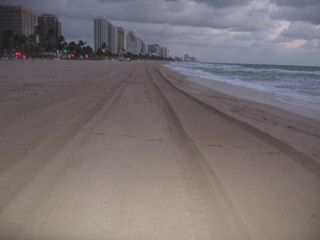 | | FORT LAUDERDALE BEACH BEFORE STORM |
Of immediate interest was the county�s intention to �reevaluate the Segment II project in the context of current economic and environmental conditions,� and to �propose a project appropriate to those updated conditions.� Since current economic conditions border on the bizarre, Ieraci sent an email to Broward Commissioner Ken Keechl asking about the significance of the agenda blurb while exhorting �If any change is made that will adversely effect this project, the mobilization of beach area constituents will be tantamount to a major revolt.� Verifying that the statement was not bureaucratic county spin for defunding the project, Keechl allayed Ieraci�s concern, �The �reevaluation� is nothing more than a required response to the environmental monitoring report for the earlier southern segment. It shouldn�t affect the Galt in any significant way.�
 | | OCTOBER 31st STORM ERODES 4 FEET OF SAND |
Commissioner Keechl was referring to an environmental impact report summarizing observations made during the mandated 18-month monitoring period following the Segment III beach renourishment in Hollywood and Hallandale. Although the funding fears were quickly dispelled by our Broward Commissioner, the statement still embodied two very real problems facing the Beach project. While circumstances surrounding the sand shortage remain murky, this obstacle was first revealed over a year ago. Secondly, by stating his intention to incorporate aspects of Segment III erosion control into the Segment II renourishment plans, Higgins has fueled concern by coastal residents and public officials from Fort Lauderdale to Pompano Beach. To date, he�s neglected to adequately explain whether or how this would adversely impact the resources and timetable for the north Broward beach renourishment.
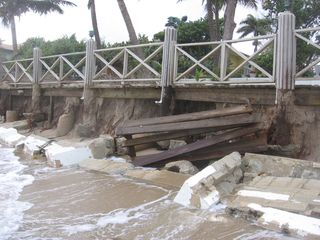 | | OCTOBER 31st STORM UNDERMINES SEAWALL DECK |
Two days later (November 10th), Commissioner Teel distributed some pictures taken of the beach before and after an ordinary rainstorm on October 31st. They demonstrate the extreme vulnerability of the critically eroded Segment II beaches. She also copied some emails among City officials questioning the actual scope of the Segment II beach rehabilitation. Among these correspondences was an email from Assistant City Attorney Carrie Sarver informing City Attorney Harry Stewart that beach administrator Higgins is considering additional areas for inclusion in Segment II based on the report�s findings. Officials from Parks, Legal and Engineering attempting to assess the degree of deterioration for which they had to prepare all seemed surprised to find themselves �outside the loop� with regard to such an important issue.
 | | SEAWALL DECK BECOMES STRUCTURALLY UNSOUND |
When asked about requesting that our county beach administrator convene an informational event for both residents and public officials in the Segment II jurisdiction, City Commissioner Christine Teel said that a meeting with Mr. Higgins and City officials was already being arranged. Unless that meeting is expanded to include local residents, a second �open� meeting should follow the City�s initiative. In particular, Mr. Higgins needs to quell rumors portending additional Segment II delays, especially if they result from political pressure to benefit constituents in Segment III. For the last decade, officials and civic leaders from both areas cooperated closely with county officials to promote the southern renourishment with the understanding that the northern Segment would subsequently enjoy the same unilateral support.
 | THE HOLLYWOOD BEACH
COMMUNITY CENTER |
In 2002, the south county Segment III part of the project was facing fierce opposition from pseudo-environmental groups hastily recruited by the Scuba Industry (which stood to lose $millions during the project�s planned temporary reef closures). Former Hollywood Mayor Mara Giulianti, Broward Commissioner Sue Gunzburger from Hollywood and former Hollywood Statehouse Representative Eleanor Sobel (who was recently elected to the Florida Senate) pleaded with Barrier Island beach communities to join them in convincing Tallahassee of the project�s necessity. In a testament to irony, the only substantial response came from the Galt Mile Community Association. On April 30, 2002, more than 150 residents of the Galt Ocean Mile (2 busloads) attended a hearing at the Hollywood Beach Community Center in support of the Army Corps of Engineers plan to renourish our shrinking beaches.
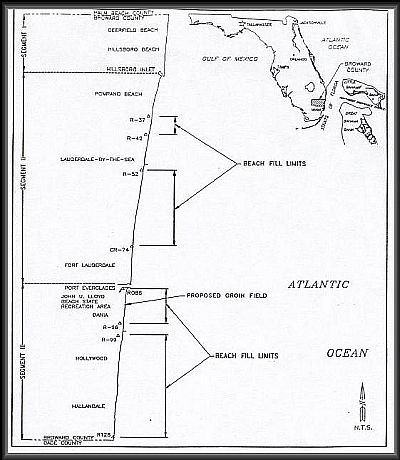 | BROWARD COUNTY SHORE PROTECTION PROJECT
SEGMENTS II & III BEACH FILL LIMITS |
As the least observant of us were already keenly aware, our beach was rapidly dwindling from the effects of tidal erosion in the form of high winds (hurricanes) and wave action. Many of the buildings on the Galt had already lost large portions of beach to this onslaught. Broward County�s 24 miles of beach are uniformly under attack as the State of Florida has declared 21 miles of the county�s beaches to be �critically eroded�. The nearly 50 million dollars that Broward County initially pledged to help mollify this impending disaster has doubled due to politically motivated delays.
The county�s plan divided the critical target area into three zones. The North Zone (Segment I) is about a mile of shoreline off Deerfield Beach. The Middle Zone (Segment II) includes the roughly 5 miles of beach running from the Hillsboro Inlet to John U. Lloyd State Park Beach. The South Zone (Segment III) ranges from John U. Lloyd Beach State Recreation area for 6 miles through Dania, Hollywood Beach, and Hallandale Beach to the Dade County Line. The plan entailed the Army Corps of Engineers to supervise the pumping of sand dredged from seven �borrow� areas north of Pompano Beach and transported by ship to target zones awaiting renourishment. This herculean effort would add in excess of 2.5 million cubic yards of sand to our shrinking beaches while widening them by an additional 50 feet to 150 feet depending on the degree of need. The county anticipates recovering almost half of its outlay from the Federal Government.
 A contentious propaganda campaign by project opponents claiming that beach residents were opposed to the beach renourishment was thwarted at the Hollywood meeting. Having failed to stop the southern Segment III part of the project, supposedly local anti-renourishment elements (who were subsequently identified in the Federal Register as scuba industry lobbyists from Cleveland, Boston and the Bahamas) revised their dilatory tactics to instead derail the Segment II component that includes Fort Lauderdale and the Galt Ocean Mile. A contentious propaganda campaign by project opponents claiming that beach residents were opposed to the beach renourishment was thwarted at the Hollywood meeting. Having failed to stop the southern Segment III part of the project, supposedly local anti-renourishment elements (who were subsequently identified in the Federal Register as scuba industry lobbyists from Cleveland, Boston and the Bahamas) revised their dilatory tactics to instead derail the Segment II component that includes Fort Lauderdale and the Galt Ocean Mile.
 | Crist, Bronsen, Bush, Gallagher
THE 2003 FLORIDA CABINET |
In preparation for the Segment II licensing hearing in Tallahassee, Galt Mile residents sent hundreds of letters and thousands of emails to former Governor Jeb Bush, former Attorney General Charlie Crist, former Florida CFO Tom Gallagher, and Agriculture Commissioner Charles Bronson in support of the project. On May 13, 2003, the Florida cabinet met to hear testimony about the Segment II renourishment.
 | ENVIRONMENTALIST
ROY ROGERS |
Former Director Steve Somerville of the Broward County Department of Planning and Environmental Protection (DPEP) � precursor to today�s Environmental Protection Department (EPD) � described to the Cabinet members the county�s plan to safely replace sand lost to Broward beaches from tidal erosion, tropical storms, and hurricanes. After Somerville summarized salient aspects of the County�s plan, former Broward County Commissioner Jim Scott, former Hollywood Representative Eleanor Sobel (now in the Florida Senate), and Fort Lauderdale City Commissioner Christine Teel all voiced strong support for the project�s implementation.
 | FORMER FDEP SECRETARY
DAVID STRUHS |
Unable to assert that local officials were opposed to the project, an anti-renourishment Golden Beach resident who identified himself as �a friend of the environment� instead told the Cabinet that Galt Ocean Mile residents were opposed to reclaiming the Fort Lauderdale and Galt Mile beaches �on environmental grounds.� He was unprepared for the contingent of Galt Mile Community Association homeowners that traveled to Tallahassee and uniformly testified that saving local beaches was of paramount priority � for them and their neighbors. Adorned in tee shirts emblazoned with �Save Broward Beaches�, Rose Guttman from the Ocean Club, Fern McBride, Iris and Joe Anastasi, and Eric Peter Berkowitz from Regency Tower, Ron Gresser from Playa del Mar, Kathleen Freismuth from Regency South and Pio Ieraci from the Galt Ocean Club presented the Cabinet members with a 220-page pro-project petition signed and addressed by more than 9,000 area residents. Opponents were equally surprised when prominent environmentalist Roy Rogers of the Nature Conservancy and the Audubon Society along with other esteemed naturalists explained the need to repair the shoreline and opined that Broward�s plan was environmentally sound. Following the successful Cabinet Meeting, Former Secretary David B. Struhs of the Florida Department of Environmental Protection expressed his appreciation to the GMCA in a televised interview, crediting �community members in their red t-shirts� with salvaging the beach project.
As a result, the Cabinet voted unanimously to maintain Fort Lauderdale�s status as a renourishment target and license Segment II with the proviso that an 18-month monitoring period be implemented to review the impacts of the Segment III renourishment and use the data to refine permit requirements for the Segment II beach construction.
 | | Brigadier General RANDAL R. CASTRO |
On January 2, 2004, the US Army Corps of Engineers published its Final Environmental Impact Statement (FEIS) for the Broward County Shore Protection Project, Segments II and III, in the Federal Register. In May, Brigadier General Randal R. Castro, former South Atlantic Division Commander of the Army Corps of Engineers, sent notification that the official Record of Decision (ROD) stated that every major environmental agency and organization supported project implementation �as soon as possible.� In the ROD, the General also proclaimed, �I find that the plan recommended in the GRR (General Reevaluation Report) and FEIS (Final Environmental Impact Statement) by the District Engineer, Jacksonville District, U.S. Army Corps of Engineers (Corps), is economically justified, technically feasible, in compliance with environmental statutes, and in the overall public interest.�
 | GMCA PRESIDENTS COUNCIL CHAIR PIO IERACI
CREDITS SUCCESSFUL COMMUNITY EFFORT
Broward County Commissioner SUE GUNZBERGER
Broward County Mayor KRISTIN JACOBS and
Hollywood Mayor MARA GIULIANTI |
On May 6, 2005, a long-awaited celebration took place in Hollywood. The first beneficiaries of the Broward County Shore Protection Project � the Segment III municipalities of Hollywood, Hallandale Beach and Dania Beach � joined Broward County in throwing a party to highlight the project�s kickoff. Over the next year, the Segment III beaches would be salvaged. The Hollywood, Hallandale and Dania shorelines, where waves previously lapped against the sea wall, would enjoy 150 feet of new sand. The Mayors of the three cities and Broward Commissioner Sue Gunzburger again thanked the Galt Mile Association residents for their critical contribution to project approval and promised to reciprocate by supporting the northern renourishment.
 | | HARDBOTTOM MONITOR |
Following completion of the Segment III beaches in March of 2006, monitors from Nova Southeast University Oceanographic Center, Coastal Planning and Engineering, Inc. and Olsen Associates, Inc. (a joint venture of coastal engineering consulting firms) joined county scientists to examine the environmental effects of repairing Broward�s shoreline from the Dade County line to John U. Lloyd State Park. During the mandated 18-month monitoring period, County officials addressed project housekeeping issues in preparation for the upcoming Segment II construction. When the monitoring period was concluded in September 2007, the accrued data was collated and forwarded to the Florida Department of Environmental Protection (FDEP).
 | SAND BYPASS EROSION CONTROL
AT PORT EVERGLADES INLET |
In contrast to past projects that were largely neglected once completed, the County�s strategy included a maintenance component to ensure the ongoing health of the rehabilitated beaches, thereby postponing the need for (and curbing the expense of) future renourishments. Although sand naturally migrates south along the coast, intermittent special attention to certain �erosion hot spots� that evacuate at a heightened level could preclude the need for future full scale renourishments.
 | STEVE HIGGINS
GIVES REPORT |
In his 2007 report, Broward Beach Administrator Stephen Higgins described the new maintenance concept, stating, �The County is investigating the feasibility of moving between 50,000 and 90,000 cubic yards of excess sand from the upland beach north of Port Everglades to a hot-spot location along south Hollywood and north Hallandale Beach.� Performing smaller, more frequent sand placements at erosion hot-spots only require what he called �sands of opportunity,� avoiding additional pressure on dredge sites. Higgins also studied the viability of using erosion control structures to slow erosion along Segment III hot-spots. Higgins said, �The County is currently monitoring the equilibration of the beach fill to ascertain any impacts that might occur to the nearshore hardbottoms from migrating sand.�
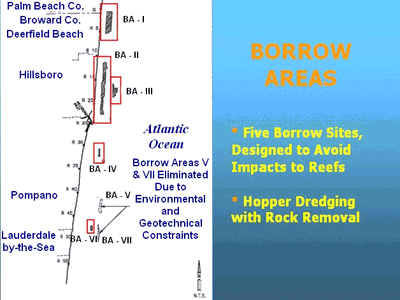 Higgins then revealed two previously undisclosed project impacts. His report continued, �In the meanwhile, we are close to executing an amendment with our consultants to undertake several tasks in preparation for resuming the Segment II engineering/design/permitting. One important task is to find sand.� Until that moment, every scrap of relevant documentation, from the Draft Environmental Impact Statement to the plan that was finally permitted by the State, targeted the waters off Deerfield Beach as sand �borrow sites� adequate for both Segment III and Segment II renourishments. The plan refers to that particular patch of beach as �Segment I�. Why was it suddenly necessary to scavenge for sand in other locations? Higgins then revealed two previously undisclosed project impacts. His report continued, �In the meanwhile, we are close to executing an amendment with our consultants to undertake several tasks in preparation for resuming the Segment II engineering/design/permitting. One important task is to find sand.� Until that moment, every scrap of relevant documentation, from the Draft Environmental Impact Statement to the plan that was finally permitted by the State, targeted the waters off Deerfield Beach as sand �borrow sites� adequate for both Segment III and Segment II renourishments. The plan refers to that particular patch of beach as �Segment I�. Why was it suddenly necessary to scavenge for sand in other locations?
 | STEPHEN HIGGINS
BEACH WIZZARD |
He said, �Borrow area No. 1, which has enough material with which to construct Segment II, now has a higher percentage of rock in it after removing sand for Segment III. We�ll need to investigate that. We�ll also look for additional sand offshore, but I�m not confident that we�ll find any significant new deposits. Accordingly, we will also be looking for more remote sources of domestic sand (e.g. offshore central FL and in the Gulf of Mexico) and for non-domestic sand, with emphasis on Bahamian aragonite. When we find the sand we�re going to use, if it�s different from the sand we had proposed to use in our previous plans, we will have to do some re-engineering of the project and redo some of the permitting.�
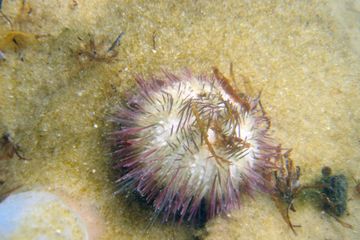 | | VARIABLE SEA URCHIN ON RECYCLED GLASS CULLET SUBSTRATE |
It is difficult to believe that Higgins was ambushed by the fact that removing large amounts of sand from the borrow area would increase the ratio of rock to sand. While the simplistic characterization he offered to define this new dilemma wasn�t a paragon of credibility, the sand shortage is evidently real. Higgins is diligently investigating alternative sources of sand for use in Segment II, including the possible utilization of recycled �glass sand� since glass and sand are both composed primarily of Silicon Dioxide. The County hired Coastal Planning and Engineering, Inc. (CPE) to compile a report about the advantages and disadvantages of artificial sand. However, his belated revelation about the sand shortage casts a shadow on his contention that the south county �hot spots� could be addressed with �sands of opportunity�. Admittedly, there are no �sands of opportunity!� The bottom line is simple; any sand that�s used to address erosion shortages in Segment III would likely be hijacked from Segment II.
 | STEPHEN HIGGINS
AT GMCA MEETING |
Make no mistake. Stephen Higgins is largely responsible for the continued viability of this project. A unique blend of scientist and technocrat, he successfully nursed it through a minefield of antipathetic scrutiny, responding to literally thousands of agency questions over a decade. His familiarity with the issues surrounding the project is unparalleled. That�s why his explanation for the sudden surfacing of a sand shortage so late in the game was enigmatic.
 | | HOLLYWOOD BEACHFRONT HOTELS HAVE NEW SHORELINE |
Last month, Higgins attended a meeting in Hollywood. South County politicians have been pressing Higgins to leapfrog the project schedule and give their erosion deficit priority over the Segment II renourishment. Certain Fort Lauderdale officials and Galt Mile civic leaders suspect that vested interests are placing Higgins in an untenable position by coveting resources earmarked to save our nearly non-existent beaches in order to add a few more feet of sand to their beaches. While Higgins is a magician when addressing technical issues, as an unelected county official, he is susceptible to political pressure.
 | FORT LAUDERDALE'S RAPIDLY
SHRINKING RIBBON OF BEACH |
Galt Mile Community residents rescued the project from political oblivion in Hollywood and Tallahassee, passionately entreating regulatory authorities to support the threatened project at every critical crossroads. Officials representing the south county municipalities that were the immediate beneficiaries of these efforts exclaimed that we were �partners and allies in this enterprise.�
 | SOUTH COUNTY POLITICIANS
HOLLYWOOD MAYOR MARA GIULIANTI
BROWARD COUNTY MAYOR KRISTIN JACOBS
COUNTY COMMISSIONER SUE GUNZBERGER
HALLANDALE BEACH MAYOR JOY COOPER
AND DANIA BEACH VICE MAYOR PAT FLURY |
There is no mystery as to why our supposed allies in Hollywood and Hallandale are eying the sand earmarked to enlarge Fort Lauderdale�s beaches. As in Fort Lauderdale, beaches in Hollywood and Hallandale are lined with hotels that help fuel the tourism economies of those municipalities. These resorts also contribute heavily to the campaigns of their local officials. Key tourism venues such as the Westin Diplomat Resort & Spa haven�t forgotten how tough it was to fill their rooms prior to the beach renourishment. They also know that each beach is an integral part of the coastal system. Any weakness in the system threatens the entire shoreline. The �hot spots� are sources of sand loss that the hotels want to address at any cost. If they lay claim to the sand that would otherwise nourish the Segment II shoreline, they will have accrued an insurance policy for which we will pay the premium.
To address any attempt to surreptitiously alter the project�s focus, Fort Lauderdale residents and officials must be equally passionate in demanding that the Segment II timetable is scrupulously followed and its renourishment resources are fully dedicated. The correct forum to insure these objectives is a meeting at which Mr. Higgins will hopefully identify these sources of controversy as �rumors� and confirm the late 2009 Segment II start date.
Click To Top of Page
FDEP Fouls Galt Mile Beach Fix

City Breaks State Malaise - Dumps Ship Wreck
 | | MECHANICAL BEACH RAKING SUSPENDED |
October 23, 2008 - During the September 18th Galt Mile Community Association Advisory Board meeting, several members reported a sudden cessation of the City�s beach maintenance activities. The mechanical rake that ordinarily lumbers across the beach shortly after each dawn has been conspicuously absent. Two members said that while enjoying the beach, some of their residents encountered some beach maintenance personnel and inquired why the service was stopped. They were told that a suspension was instituted to �protect Sea Turtle nests.� Confused by the inexplicable change, the residents never received an explanation clarifying why the previously acceptable standard cleanup procedures suddenly constituted a threat to the endangered Sea Turtles. Association representatives also expressed confusion over whether this policy extended to our individual beachfront associations, all of which perform similar daily beach maintenance activities.
 Following up on the issue, GMCA President Pio Ieraci contacted the city to elicit a rationale for the service cutback. On Monday, September 22, 2008, He received a digital �multi-mail� that was sent to beachfront neighborhood associations as well as relevant County and City officials. The email was sent by Donald Morris, the City�s Beach Community Director of Development. The emailed letter�s content is as follows: Following up on the issue, GMCA President Pio Ieraci contacted the city to elicit a rationale for the service cutback. On Monday, September 22, 2008, He received a digital �multi-mail� that was sent to beachfront neighborhood associations as well as relevant County and City officials. The email was sent by Donald Morris, the City�s Beach Community Director of Development. The emailed letter�s content is as follows:
|
City of  Fort Lauderdale Fort Lauderdale

Dear Beach Resident:
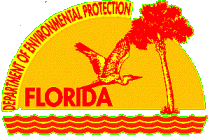 The City of Fort Lauderdale has made a concerted effort to improve the appearance of the beach by expanding our daily cleaning activities. These daily cleaning activities include mechanically raking and smoothing the sand, hand-raking and hand-picking debris not caught by the mechanical rake, sweeping and cleaning sidewalks and shower stalls and promptly emptying trash cans. The City of Fort Lauderdale has made a concerted effort to improve the appearance of the beach by expanding our daily cleaning activities. These daily cleaning activities include mechanically raking and smoothing the sand, hand-raking and hand-picking debris not caught by the mechanical rake, sweeping and cleaning sidewalks and shower stalls and promptly emptying trash cans.
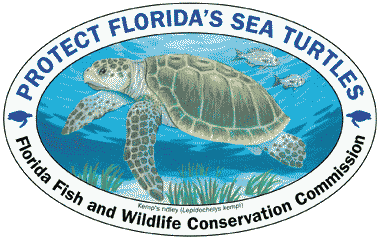 During sea turtle nesting season (March - October), the Department of Environmental Protection (DEP) and the Florida Fish and Wildlife Commission (FWC) restrict our cleaning activities to mechanically raking the sand up to the mean high water line (MHL) and hand-cleaning the remainder of the beach. During sea turtle nesting season (March - October), the Department of Environmental Protection (DEP) and the Florida Fish and Wildlife Commission (FWC) restrict our cleaning activities to mechanically raking the sand up to the mean high water line (MHL) and hand-cleaning the remainder of the beach.
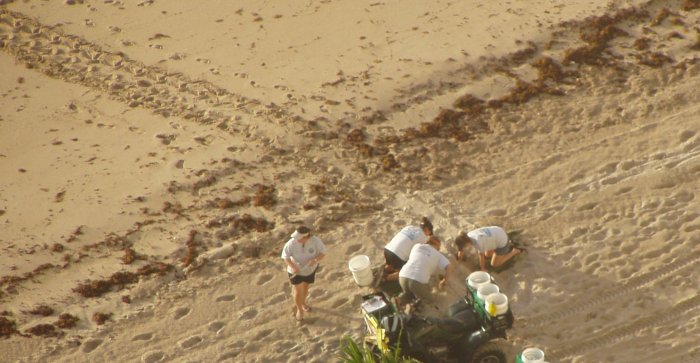 | | TURTLE TEAM PREPARES NEST MARKERS |
Recently, the remnants of Tropical Storms Fay and Hanna, and Hurricanes Gustav and Ike severely impacted our beach by washing or blowing away turtle nest markers and causing beach erosion. As a result, the FDEP and FWC prohibited mechanical beach cleaning until all turtle nest markers are replaced. The City is in frequent contact with the FDEP and FWC to closely monitor the progress of this initiative. When all of the markers are in place, we expect to once again be able to mechanically rake and clean the beach.
 In the meantime, City cleaning crews are hand-picking debris (excluding seaweed) for the entire beach from the Yankee Clipper to Oakland Park Boulevard (approximately 4 miles). We will continue hand-picking debris until we are given permission by the FDEP and FWC to resume mechanized cleaning. In the meantime, City cleaning crews are hand-picking debris (excluding seaweed) for the entire beach from the Yankee Clipper to Oakland Park Boulevard (approximately 4 miles). We will continue hand-picking debris until we are given permission by the FDEP and FWC to resume mechanized cleaning.
If you have any questions or need additional information, please feel free to contact me at (954) 468-1516 or at [email protected].
We apologize for the inconvenience.
Sincerely,
Donald Morris, AICP
Beach Community Development Director

|
|
Beach Waste Ripens
 | | RIPENING BEACH WASTE |
Within several days, mounds of seaweed piled up along the beach. Waste from Cruise ships and other vessels soon became entangled in the rotting kelp, peppering the beach with organic incubators for bacterial communities. The net result was a mixture of unidentifiable mush oozing from what appeared to be decomposing marine skeletal material adorned with rotting flesh, plastic wrap, rusting construction materials, glass chards and broken bottles, multi-colored prophylactics, decomposing vegetation, broken wooden doweling and planks, tin cans, a rubber glove, cigarette filters, a license plate from Quebec, an oar, rubber hosing, batteries and a bicycle seat.
 | | WASTE ALONG GALT MILE BEACH |
On September 25th, former President Justin Henry of the Royal Ambassador Condominium expressed his disgust with the repugnant wall of organic waste behind his home. He sent an email to Broward Commissioner Ken Keechl � copying Governor Crist � stating that in the 7 years since he moved here, �I have never seen our beach in worse condition.� Following a graphic description of the festering detritus mounds, he complained, �Not only is this an eyesore and a deterrent for anyone to purchase or rent property along our beach, but it also has to constitute some sort of health hazard....with everything from glass bottles to used birth control devices mangled in the mess.� Mr. Henry asks the Commissioner, �How much more do we have to give up for the sea turtles? How much to we have to endanger ourselves and our children to protect these animals?�
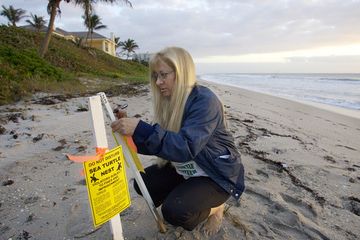 | | VOLUNTEER MARKS NEST EARLY ON |
Justin Henry�s email joined scores of others sent to City, County and State officials questioning the State policy. �Why was it taking so long to mark the nests? Why did the cleanup have to await marking nests containing eggs destroyed weeks earlier by storm surge?� As the passage of time intensified the waste problem, the emails and letters became increasingly bitter, asking why the State changed the nesting policy last year. Until 2006, after marking the nests, trained teams would move the viable eggs to a deserted beach where they would be reinterred. The hatchlings would then set their nesting instincts to return to a dedicated nesting grounds free of man-made beach obstacles (beach furniture, etc), coastal armoring (seawalls, bulkheads, etc), beachgoers and the artificial lighting that disrupts a Sea Turtle�s nesting instincts and a hatchling�s biological compass.
 | BROWARD BIOLOGICAL RESOURCES DIV
STEPHEN HIGGINS AND LOU FISHER |
At a May 7, 2007 Galt Mile Community Association Presidents Council meeting organized to inform participating association officials about the new turtle-safe lighting ordinance, Broward County marine biologist Lou Fisher explained the rationale for the revised nesting policy which left turtles to hatch on heavily populated beaches. Fisher said that State Fish and Wildlife Commission officials were concerned about the eggs that don�t survive the transfer. Apparently, a certain number of eggs sacrifice viability when handled. FWC aficionados decided to leave the nests in place and instead, try to mandate a safe nesting environment along the populated beaches.
 | | SEAS A LADY - NO IDENTIFICATION OR ENGINES |
When the city claimed that they were precluded from evacuating an abandoned 50-foot fishing vessel called �Seas a Lady� that washed up on the shore behind the Galt Ocean Mile condos on September 28th, tempers flared. Ordinarily, this would be considered a serious danger to beachgoers and removed immediately. Within days, tidal action started dismantling the boat, distributing large sections of hull and interior equipment south along the shoreline. A demolished refrigerator rolled almost a dozen blocks south before finally embedding itself in the sand just south of Northeast 23rd Street. Sporting an 8-year old Delaware registration, authorities said that since the vessel was intentionally stripped of identification and its engines, they have determined that it was deliberately cut free of its anchor at the Port Everglades sea buoy. When residents realized that the state edict placed the statistical value of non-viable turtle eggs above their safety, the communications began reflecting indignant rage.
Tempers Flare
 | | HUGE HAZARDOUS HULL SECTION |
Galt Mile residents who advocated cooperating with the turtle safe lighting mandate and were willing to patiently await completion of the nest marking procedures suddenly exploded. Regency Tower�s Jim Rigney, a level-headed former New York City Detective, sent out articles about the beach waste to neighbors, objecting to the State having elevated concern for turtles� safety above that for people. Emails took on an �it�s us or them� tone, framing a threatened �battle of the species� with Sea Turtles or political retribution for those State officials behind the mandate. Local blogs started filling with pro and anti-Sea Turtle comments, recommendations, death threats and other monuments to stupidity. Participating geniuses jockeyed to affix blame on State, County and City officials, FDEP, FWC, radical environmentalists, anti-environmentalists, manatees, Sea Turtles, Condo Boards, Saddam Hussein, Karl Rove and Lee Harvey Oswald.
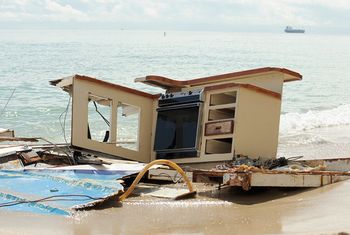 | | KITCHEN EQUIPMENT ROLLED 10 TO 12 BLOCKS |
Several enigmatic decisions by officials served to inflame the controversy. Although the nest sites were all identified, Nova Oceanographic Institute volunteers hadn�t completed marking them. Since officials knew where the eggs were located, the large equipment required to remove the dissipated sections of hull could be guided to avoid the nest sites and safely evacuate the beach hazards. However, beach operations foreman Mark Almy said �We can�t take a tractor out there without state and county authorization.� In a strange twist of what appeared to be jurisdictional confusion, Almy also stated in a newspaper article that the city isn�t responsible for removing most of the wreckage from the �Seas A Lady� because it lies north of Oakland Park Boulevard. Galt Mile residents that read the article attacked city officials, threatening to sue and/or withhold taxes. Mr. Almy neglected to explain that responsibility for beach maintenance north of Oakland Park Boulevard falls to a private contractor operating under a different permit, leaving readers to mistakenly surmise they were being abandoned.
Turtle-Safe Lighting Cooperation
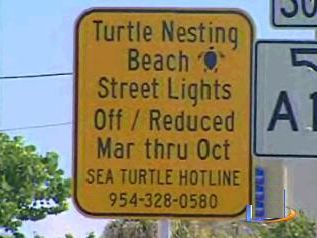 Galt Mile residents are largely supportive of contributing to the survival of the endangered Sea Turtle species. When the city first decided to enforce its version of the State�s turtle-safe lighting ordinance model, it sent out violation notices to every beachfront association in the neighborhood. Attached were copies of the ordinance, which contained confusing language that appeared to require a comprehensive darkening of every property. When the neighborhood association called the City Code Compliance officer in charge of the project to notify him that no building would risk the safety and security of their unit owners by complying with such an insupportable demand, he requested a meeting to discuss the issue. At the meeting, Code Compliance Officer Al Lovingsheimer apologized for sending out the violation notices and quickly affirmed that the city would never require residents to compromise their own safety. Galt Mile residents are largely supportive of contributing to the survival of the endangered Sea Turtle species. When the city first decided to enforce its version of the State�s turtle-safe lighting ordinance model, it sent out violation notices to every beachfront association in the neighborhood. Attached were copies of the ordinance, which contained confusing language that appeared to require a comprehensive darkening of every property. When the neighborhood association called the City Code Compliance officer in charge of the project to notify him that no building would risk the safety and security of their unit owners by complying with such an insupportable demand, he requested a meeting to discuss the issue. At the meeting, Code Compliance Officer Al Lovingsheimer apologized for sending out the violation notices and quickly affirmed that the city would never require residents to compromise their own safety.
 At the request of then Code Enforcement Manager Cate McCaffrey, a presentation by City, County and State environmental officials to explain their turtle-safe lighting objectives was scheduled at a GMCA Presidents Council meeting. They all agreed to work with associations to maintain safe environments for residents while implementing a plan for appropriate lighting along the beach. During a subsequent meeting with the Code Compliance officer Al Lovingsheimer, a viable working plan was developed. Each association would address the most egregious lighting violations immediately. Instead of trying to force people living in units overlooking the beach to live in the dark for nine months each year, every association would post a notice on their community bulletin board or newsletter asking residents to please turn off their lights when they retire from any room overlooking the beach. If one or more of an association�s main deck lamps was in violation, a permanent change-out would be postponed until the association implemented a new deck lighting plan as part of a scheduled upgrade. At the request of then Code Enforcement Manager Cate McCaffrey, a presentation by City, County and State environmental officials to explain their turtle-safe lighting objectives was scheduled at a GMCA Presidents Council meeting. They all agreed to work with associations to maintain safe environments for residents while implementing a plan for appropriate lighting along the beach. During a subsequent meeting with the Code Compliance officer Al Lovingsheimer, a viable working plan was developed. Each association would address the most egregious lighting violations immediately. Instead of trying to force people living in units overlooking the beach to live in the dark for nine months each year, every association would post a notice on their community bulletin board or newsletter asking residents to please turn off their lights when they retire from any room overlooking the beach. If one or more of an association�s main deck lamps was in violation, a permanent change-out would be postponed until the association implemented a new deck lighting plan as part of a scheduled upgrade.
 | | GALT MILE COMMUNITY ASSOCIATION PRESIDENTS COUNCIL |
The plan ran without a hitch. The city worked with each association to develop a reasonable set of objectives which were expeditiously met. Al Lovingsheimer later reported that the Galt Mile neighborhood delivered the greatest turtle-safe lighting improvement of any Fort Lauderdale beachfront community. He also expressed concern about some of his counterparts in Tallahassee. Al met intermittently with officials in other municipalities that were implementing turtle-safe lighting plans. He also met with State officials that provided guidelines to assist jurisdictions with this effort.
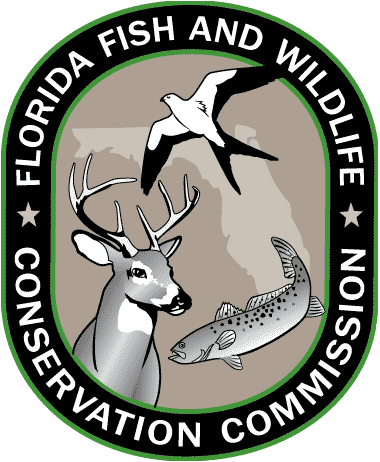 Lovingsheimer described being disturbed about a potential problem. He told GMCA officials that while most of the FDEP and FWC personnel were reasonable people that aspired to balance the needs of residents with the needs of sea turtles, a cadre of radical project participants in Tallahassee had a different agenda. Several officials in the State oversight program blatantly admitted that their goal is to clear the barrier islands of residents. Privately characterizing this group as �crazy�, Al said that once the association lighting was fully compliant, they wanted the local jurisdictions to wage a campaign against unit owners with windows overlooking the beach. Al said he was approached by two FWC personnel who asked if he would be willing to require unit owners to install �one-way� windows or enforce the shuttering of windows overlooking the beach during turtle nesting season. Lovingsheimer�s concern derived of actual language in the City ordinance that he didn�t consider enforceable � Chapter 6, Article 3, Sec. 6-51. Lighting standards for existing development, (2) �Within one (1) year of the effective date of this division: Window treatments shall be installed in windows and glass doors in rooms in single and multi-story structures with windows or glass doors facing the beach so that lights are not visible from the beach, or filming in compliance with this division shall be installed on the exterior of all such windows and glass doors, so that internal lights are not visible from the beach. Shade screens can be substituted for this requirement.� Describing members of this group as �CIA wannabees,� Al complained that they opposed the City�s successful policy of eliciting cooperation to protect the turtles, instead advocating strong-arm tactics and a series of �sting� operations. Al repeatedly pointed out that most of the State oversight personnel were reasonable and this group was a small, but vocal, minority. He also assured us that the City would only enforce those recommendations that they deemed reasonable. Lovingsheimer described being disturbed about a potential problem. He told GMCA officials that while most of the FDEP and FWC personnel were reasonable people that aspired to balance the needs of residents with the needs of sea turtles, a cadre of radical project participants in Tallahassee had a different agenda. Several officials in the State oversight program blatantly admitted that their goal is to clear the barrier islands of residents. Privately characterizing this group as �crazy�, Al said that once the association lighting was fully compliant, they wanted the local jurisdictions to wage a campaign against unit owners with windows overlooking the beach. Al said he was approached by two FWC personnel who asked if he would be willing to require unit owners to install �one-way� windows or enforce the shuttering of windows overlooking the beach during turtle nesting season. Lovingsheimer�s concern derived of actual language in the City ordinance that he didn�t consider enforceable � Chapter 6, Article 3, Sec. 6-51. Lighting standards for existing development, (2) �Within one (1) year of the effective date of this division: Window treatments shall be installed in windows and glass doors in rooms in single and multi-story structures with windows or glass doors facing the beach so that lights are not visible from the beach, or filming in compliance with this division shall be installed on the exterior of all such windows and glass doors, so that internal lights are not visible from the beach. Shade screens can be substituted for this requirement.� Describing members of this group as �CIA wannabees,� Al complained that they opposed the City�s successful policy of eliciting cooperation to protect the turtles, instead advocating strong-arm tactics and a series of �sting� operations. Al repeatedly pointed out that most of the State oversight personnel were reasonable and this group was a small, but vocal, minority. He also assured us that the City would only enforce those recommendations that they deemed reasonable.
 Earlier this year, the Code Enforcement Department accidentally repeated last year�s foul-up, sending out violation notices to every association along the beach. Ironically, Cate McCaffrey had been promoted to Director of Business Enterprise and was replaced by Mike Maloney to manage Code Enforcement. Al Lovingsheimer became very ill and passed away, leaving no one in Code Enforcement familiar with the turtle-safe lighting arrangements between the City and the Galt Mile. Maloney discovered last year�s notices lying on a desk and inadvertently sent them out again, unaware that everything cited on those notices had already been addressed. Upon receiving the bogus notices, GMCA officials contacted Maloney to arrange another meeting. Once up to speed, Mike Maloney agreed to continue the cooperative effort that successfully surpassed our mutual goals last year. Earlier this year, the Code Enforcement Department accidentally repeated last year�s foul-up, sending out violation notices to every association along the beach. Ironically, Cate McCaffrey had been promoted to Director of Business Enterprise and was replaced by Mike Maloney to manage Code Enforcement. Al Lovingsheimer became very ill and passed away, leaving no one in Code Enforcement familiar with the turtle-safe lighting arrangements between the City and the Galt Mile. Maloney discovered last year�s notices lying on a desk and inadvertently sent them out again, unaware that everything cited on those notices had already been addressed. Upon receiving the bogus notices, GMCA officials contacted Maloney to arrange another meeting. Once up to speed, Mike Maloney agreed to continue the cooperative effort that successfully surpassed our mutual goals last year.
 Not surprisingly, Maloney repeated some of the concerns expressed by Lovingsheimer. He confirmed that the City intends to insure a reasonable balance between the needs of its residents and the agenda promoted by Tallahassee. However, he learned that Tallahassee ultimately expected compliance with a much stricter interpretation of the ordinance than the city is willing to enforce. He warned that no matter how much improvement an association accomplishes, certain State environmental officials plan to intensify demands annually with no end in sight. As such, he recommended that each association demonstrate modest annual progress instead of mistakenly believing that comprehensive compliance will deter future state demands. Like McCaffrey and Lovingsheimer, he promised that the City would never enforce overtly punitive interpretations of the ordinance that could jeopardize residents� safety. Not surprisingly, Maloney repeated some of the concerns expressed by Lovingsheimer. He confirmed that the City intends to insure a reasonable balance between the needs of its residents and the agenda promoted by Tallahassee. However, he learned that Tallahassee ultimately expected compliance with a much stricter interpretation of the ordinance than the city is willing to enforce. He warned that no matter how much improvement an association accomplishes, certain State environmental officials plan to intensify demands annually with no end in sight. As such, he recommended that each association demonstrate modest annual progress instead of mistakenly believing that comprehensive compliance will deter future state demands. Like McCaffrey and Lovingsheimer, he promised that the City would never enforce overtly punitive interpretations of the ordinance that could jeopardize residents� safety.
State Agency Reps Drop Ball
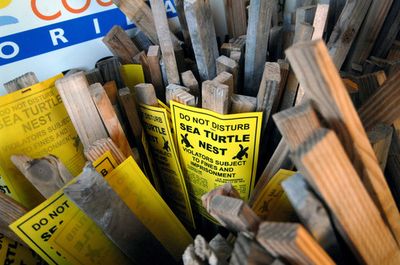 | | DEEMED UNNECESSARY, NEST MARKERS GO UNUSED |
As if to enshrine bureaucratic buffoonery, after mandating that no heavy beach maintenance equipment could be deployed until every nest was marked, the FDEP told Nova volunteers that since turtle nesting season was over by October 31st, there was no reason to expedite the procedure � or even complete it. Forcing Galt Mile residents to live with the beach hazard for over a month caused no loss of sleep in Tallahassee or West Palm Beach.
 Given the State�s disinterest in marking the nests after making that a precondition for maintaining the beach, Lovingsheimer�s initial concerns have since gained substantial credibility. Agency actions seemed less driven by their concerns for Sea Turtles than the pursuit of an opportunity to harass local beachfront communities - whether by malicious intent or benign neglect. Recently, other municipal officials have also expressed concern about the callous disregard evidenced by State Environmental Agency representatives. Some have suggested that if their local policy objectives continue to focus less on environmental protection than on capricious jurisdictional interference, a political conflict with certain State agency personnel may become unavoidable. Given the State�s disinterest in marking the nests after making that a precondition for maintaining the beach, Lovingsheimer�s initial concerns have since gained substantial credibility. Agency actions seemed less driven by their concerns for Sea Turtles than the pursuit of an opportunity to harass local beachfront communities - whether by malicious intent or benign neglect. Recently, other municipal officials have also expressed concern about the callous disregard evidenced by State Environmental Agency representatives. Some have suggested that if their local policy objectives continue to focus less on environmental protection than on capricious jurisdictional interference, a political conflict with certain State agency personnel may become unavoidable.
City Rescues Beach
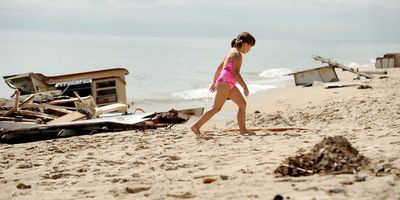 | | KIDS PLAYING IN DECOMPOSING WRECKAGE |
When the State finally gave a conditional green light to removing the beach hazards, Galt Mile officials contacted the Pompano Beach private contractor �Beach Raker� to arrange the demolition and extrication of the beached boat. After removing some debris, Beach Raker Operations Manager Bill O�Brien opted to take a shot at the jackpot. Apparently overconfident that the community would do anything to rid themselves of this dangerous eyesore, they quoted an unconscionable estimate of $10,800 - $2,800 for hauling away some boards and another eight grand to dump the remaining structure. Since the removal required a State permit, GMCA President Pio Ieraci asked the attendant State Agency representatives to assume responsibility for the cost. As if adhering to some �Catch-22� action policy, DEP field engineer Wesley Cich declared incisively, �That�s still to be determined� � Agency spin for �You must be joking.� Recognizing a dead end, Ieraci contacted City Commissioner Christine Teel, characterizing Justin Henry�s email as exemplary of the community�s disgust with the State�s deliberate foot-dragging. Commissioner Teel engaged City Manager George Gretsas to help resolve the beach waste and the ship wreck. Gretsas, in turn, contacted Parks and Recreation Assistant Director Terry Rynard and Director Phil Thornburgh.
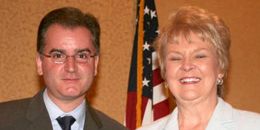 | | GEORGE GRETSAS AND COMMISSIONER CHRISTINE TEEL |
On October 7th, George Gretsas and Christine Teel had the City�s Marine Facilities Department contact a private derelict vessel company to remove the wreckage. The next day, they met on site with State Environmental Protection staffers and company representatives. Commissioner Teel and City Manager Gretsas, despite being out of their jurisdiction, double teamed the DEP officials and secured a special permit on the spot. The wreck was finally dispensed with � for $900 (less than 9% of the original bid) paid by the City of Fort Lauderdale!
This incident has crystallized a developing conflict between the City and certain bureaucrats in the State Environmental agencies. This confrontation is not unique, as other municipalities throughout the State have also been burnt by local DEP decisions that are inconsistent with stated Agency intentions. Whether the confusion resulted from some misdirected local agenda or seriously crippled communications, most residents and local officials hope that what happened doesn�t foreshadow future FDEP policy. Since most Fort Lauderdale and Galt Mile residents support many of the agency�s preservation and rescue objectives, a prospective conflict would elicit mixed emotions. Nevertheless, they share the belief that the harassment and/or expulsion of an ecosystem�s people aren�t prolific conservation methodologies.
 | | SEAS A LADY ABANDONNED ON GALT MILE BEACH |
Click To Top of Page
Mystery Bugs Bring Beach Ban

Bacterial Infestation  Closes Closes  Galt Mile Beach Galt Mile Beach
 February 8, 2008 - At 3 PM on February 8th, City of Fort Lauderdale Public Information Specialist Matt Little got some bad news. He grabbed his directory and picked up the phone. He would spend the afternoon calling every neighborhood contact on his directory list. A few minutes later, GMCA President Pio Ieraci received a call from Matt explaining that �Fort Lauderdale is closing the beach due to a bacterial infestation discovered by Broward�s Environmental Health Services unit.� He continued, �Tests revealed high levels of fecal coliform and enterococcus bacteria from Hallandale Beach to Pompano Beach. Until readings indicate that the threat has abated, the beaches will remain closed.� February 8, 2008 - At 3 PM on February 8th, City of Fort Lauderdale Public Information Specialist Matt Little got some bad news. He grabbed his directory and picked up the phone. He would spend the afternoon calling every neighborhood contact on his directory list. A few minutes later, GMCA President Pio Ieraci received a call from Matt explaining that �Fort Lauderdale is closing the beach due to a bacterial infestation discovered by Broward�s Environmental Health Services unit.� He continued, �Tests revealed high levels of fecal coliform and enterococcus bacteria from Hallandale Beach to Pompano Beach. Until readings indicate that the threat has abated, the beaches will remain closed.�
 Yesterday, Pompano Beach closed a 50-foot section of its public beach to swimmers after the Broward County Health Department issued a warning that unacceptable levels of fecal coliform and enterococcus bacteria had permeated their Northeast 16th Street beach. Ingestion by swimmers and surfers could result in severe stomach cramps and a wide range of other adverse gastrointestinal symptoms. Allergies to this bacterial onslaught, not uncommon, could seriously heighten the danger for those so afflicted. Yesterday, Pompano Beach closed a 50-foot section of its public beach to swimmers after the Broward County Health Department issued a warning that unacceptable levels of fecal coliform and enterococcus bacteria had permeated their Northeast 16th Street beach. Ingestion by swimmers and surfers could result in severe stomach cramps and a wide range of other adverse gastrointestinal symptoms. Allergies to this bacterial onslaught, not uncommon, could seriously heighten the danger for those so afflicted.
 | UNKNOWN SOURCE OF FECAL
COLIFORM & ENTEROCOCCUS |
Broward County Environmental Health Services Director Howard Rosen said the warning was based on samples of marine water taken Monday and Wednesday. The decision to alert beachgoers to the impending danger is made independently by each affected municipality. Rosen has been conducting tests for organic pollutants all week. On Friday morning he exclaimed, �This afternoon we should know the results of yesterday�s (Thursday�s) test, and we�ll continue to sample until it comes back OK.� It didn�t. By mid-afternoon, the City of Fort Lauderdale thought better of risking an epidemic and issued an official alert to get out of the water!
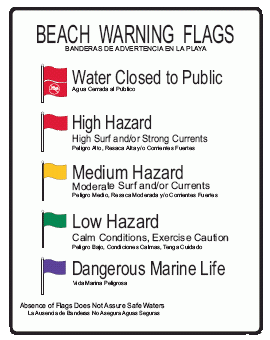 As of 2:52 PM on Friday, although the City�s Ocean Rescue web site was still painting a picture of an ideal beach day, closer scrutiny hinted at trouble. In describing Ocean Water Conditions, Ocean Rescue clinically admonished, �Moderate chop. Some Broward county beaches have tested high for bacteria.� To help notify residents about beach conditions, the City utilizes the Beach Flag Warning System along its public beaches and on the Ocean Rescue web site. The Green Flag displayed through Friday afternoon indicated, �Low Hazard: Conditions are calm; normal care and caution should be exercised.� The system�s boilerplate caveat took on special meaning in stating, �Remember that ocean conditions can change quickly.� and �The ocean is always potentially hazardous.� Upon deciding to pull the plug on ocean access, the City replaced the green flag with two red ones that mean: Closed to the Public. As of 2:52 PM on Friday, although the City�s Ocean Rescue web site was still painting a picture of an ideal beach day, closer scrutiny hinted at trouble. In describing Ocean Water Conditions, Ocean Rescue clinically admonished, �Moderate chop. Some Broward county beaches have tested high for bacteria.� To help notify residents about beach conditions, the City utilizes the Beach Flag Warning System along its public beaches and on the Ocean Rescue web site. The Green Flag displayed through Friday afternoon indicated, �Low Hazard: Conditions are calm; normal care and caution should be exercised.� The system�s boilerplate caveat took on special meaning in stating, �Remember that ocean conditions can change quickly.� and �The ocean is always potentially hazardous.� Upon deciding to pull the plug on ocean access, the City replaced the green flag with two red ones that mean: Closed to the Public.
At a loss to explain the mysterious bacterial influx, Rosen explained, �There are no septic tanks on the beach, and we usually associate this with rain events and there has not been any rain.� While Pompano Beach was first to react and close their beach, warnings were also issued at other beach sampling intersections, including the Commercial Boulevard Pier, Birch State Park, Sebastian Street, Bahia Mar and Hallandale Beach Boulevard. Municipal officials along Broward�s entire beachfront waited anxiously for Thursday�s test results. When Rosen saw no improvement, he notified Broward�s coastal municipalities.
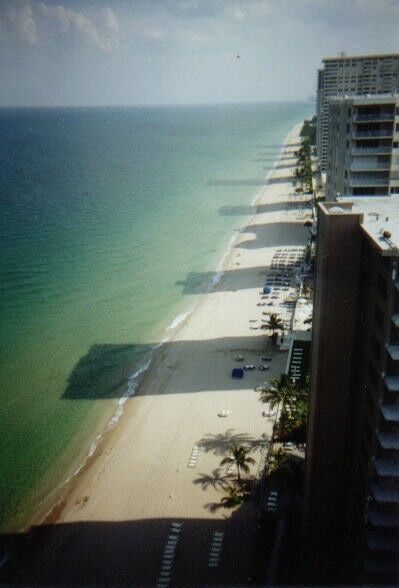 | | GALT MILE BEACH CLOSED FRIDAY |
City beach areas served by lifeguards and fixed display locations for the Beach Warning Flag system were quickly and efficiently restricted. However, areas such as the Galt Mile beach lack any official beach life-safety protection or threat notification vehicle. Last year, the Galt Mile Community Association investigated the prospect of installing the Beach Flag Warning system along its shoreline. Each Association would have had to install and maintain their own display - perhaps on the ocean side of their seawall. Upon learning that privately implementing the Flag Warning System would heighten association liability (and already sky-high insurance costs), project momentum ground to a halt.
 Reaching beach areas isolated from municipal oversight, such as the Galt Mile Beach, fell to the City�s Public Information office. After Matt Little contacted the GMCA President, Ieraci sent out email alerts to member associations describing the problem and repeating Little�s promise that tests would continue until the beach receives a clean bill of health. Reaching beach areas isolated from municipal oversight, such as the Galt Mile Beach, fell to the City�s Public Information office. After Matt Little contacted the GMCA President, Ieraci sent out email alerts to member associations describing the problem and repeating Little�s promise that tests would continue until the beach receives a clean bill of health.
 Concerned about the adverse tourism fallout, Fort Lauderdale did its own tests and reopened the beaches Friday afternoon. City spokesman Ted Lawson characterized the sudden bacterial spike as �unusual� and that the city wanted to verify the findings by retesting and submitting the samples to its own certified lab. Lawson explained, �We wanted to know for ourselves. It came back fine, so we opened the beach back up.� Given the City�s incentive, it may be propitious to confine the kids to the pool until all parties are on the same page. Click Here to check the State of Florida Department of Health current sampling results for Broward beaches. Concerned about the adverse tourism fallout, Fort Lauderdale did its own tests and reopened the beaches Friday afternoon. City spokesman Ted Lawson characterized the sudden bacterial spike as �unusual� and that the city wanted to verify the findings by retesting and submitting the samples to its own certified lab. Lawson explained, �We wanted to know for ourselves. It came back fine, so we opened the beach back up.� Given the City�s incentive, it may be propitious to confine the kids to the pool until all parties are on the same page. Click Here to check the State of Florida Department of Health current sampling results for Broward beaches.
For the current beach conditions, visit the City�s Ocean Rescue beach conditions web page or call the Beach Conditions Hotline at 954-828-4597 (updated daily). Public Information Specialist Matt Little can be reached at (954) 828-4732 or emailed at [email protected].
Ocean Safety Links

Click To Top of Page
New Obstacles Delay Beach Renourishment

Beach Honcho Higgins Plans Next Steps

 | | Brigadier General RANDAL R. CASTRO |
August 16, 2007 - Galt Milers have participated in a long and difficult fight for the promised renourishment of their critically eroded beaches. When opponents of the Broward Shore Protection Project organized an anti-renourishment effort at a 2002 public hearing in the Hollywood Beach Convention Center, more than 150 Galt Mile residents arrived by bus to demonstrate their overwhelming support for the beach rescue. In 2003, responding to politically motivated claims in Tallahassee that the local population opposed saving their own beaches, thousands of neighborhood residents signed petitions supporting the project. Thousands more sent emails and letters to the Governor and members of the Florida Cabinet. Brigadier General Randal R. Castro, Former South Atlantic Division Commander of the Army Corps of Engineers, confirmed that the plan was �economically justified, technically feasible, in compliance with environmental statutes, and in the overall public interest.� Environmentalist Roy Rogers of the Florida Audubon Society and Florida Community Trust reported to the Governor that �the entire project was safe, well-planned, and absolutely necessary.�
 | ENVIRONMENTALIST
ROY ROGERS |
Although the project�s Final Environmental Impact Statement earned the endorsement of every reputable environmental group and governmental agency, at a May 2003 Cabinet Meeting in Tallahassee, opponents aspired to exclude Fort Lauderdale�s beaches from participation. Abandoned by the mainstream environmental community, they again resorted to the transparently baseless claim that Broward�s beachfront property owners were adamantly against saving their shoreline.
 | | 2003 - 2004 FLORIDA CABINET |
They were expecting the Mayors, City and County Commissioners, Councilpersons and other local officials that spoke on behalf of saving our beaches. After rebuking these elected project supporters for �playing politics� and otherwise demeaning their motives, the anti-beach coalition insisted that they spoke for every beachfront property owner in Broward. However, they were unprepared for the contingent of beachfront homeowners from the Galt Ocean Mile who unanimously testified that saving local beaches was of paramount priority - for them and their neighbors. They were equally surprised when prominent environmentalist Roy Rogers of the Nature Conservancy and the Audubon Society along with other esteemed naturalists explained the need to repair the shoreline and opined that Broward�s plan was environmentally sound. As a result, the Cabinet voted unanimously to maintain Fort Lauderdale�s status as a renourishment target.
After hurricanes pounded coastal regions that suffered from critical tidal erosion, opponents publicly reversed themselves, agreeing that rescuing Broward�s beaches was an environmental necessity that enjoyed overwhelming local support. In concession, Broward Environmental officials agreed to devote 18 months for the purpose of monitoring the effects of the �Segment III� renourishment in south Broward. The information learned would be utilized to refine protective techniques applied to the subsequent Segment II renourishment from Fort Lauderdale to Pompano Beach.
 Following completion of the Segment III renourishment in March of 2006, monitors from Nova Southeast University Oceanographic Center and a coalition of outside engineers joined county scientists to begin examining the environmental effects of repairing the County�s shoreline from the Dade County line to John U. Lloyd State Park. During the 18-month monitoring period, Broward County planned on addressing truckloads of bureaucratic housekeeping required for project continuity. Following completion of the Segment III renourishment in March of 2006, monitors from Nova Southeast University Oceanographic Center and a coalition of outside engineers joined county scientists to begin examining the environmental effects of repairing the County�s shoreline from the Dade County line to John U. Lloyd State Park. During the 18-month monitoring period, Broward County planned on addressing truckloads of bureaucratic housekeeping required for project continuity.
 | STEPHEN HIGGINS
AT GMCA MEETING |
Stephen Higgins, Broward�s Beach Administrator, was assigned the unenviable responsibility of contending with any environmental, structural and financial pitfalls, expected and unexpected, that surface during the hiatus. Positioned on ground zero, he is the only official competent to authoritatively explain the project�s current status, evaluate consequences of unanticipated problems and approximate their influence on the project timetable.
 | | PORT EVERGLADES INLET SAND BYPASS |
Responding to a recent request for an update with respect to commencing the Segment II (Fort Lauderdale) phase of the project, Mr. Higgins sent documentation substantiating the financial and environmental aspects of the project � both of which impact the schedule. The May 2007 report summarizes the fiscal fallout from Segment III (the completed south Broward beaches), the outlook for Segment II (the Fort Lauderdale beaches) and discusses the Port Everglades Inlet Sand Bypassing Project � a separate but related adjunct to the County�s overall beach renourishment strategy.
Project funding is underwritten by a combination of municipal, County, State and federal resources allocated for this purpose. The release of this dedicated financing is contingent on the successful accomplishment of goals outlined in the County�s plan. As of May, 2007, Broward County received from the US Army Corps of Engineers a $2.8 million reimbursement for the federal share of preconstruction engineering and design costs for Segment III.
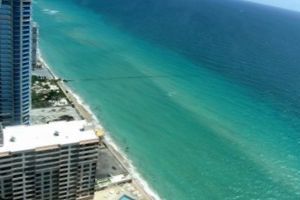 | | HOLLYWOOD BEACH BEFORE RENOURISHMENT |
The County has requested from the Corps of Engineers reimbursement of approximately $17 million for the federal share of Segment III beach and structure construction costs. These funds are subject to appropriation by Congress and apportionment and allocation by the Corps. While the Corps of Engineers currently only has available approximately $2 million for Broward�s reimbursement (subject to audit), the County has requested that Congress appropriate $6 million for FY 2008 to facilitate uninterrupted funding.
 | | HOLLYWOOD AFTER RENOURISHMENT |
The County has requested approximately $1.6 million more from the State of Florida to cover future Segment III monitoring expenses and engineering design costs for Segment II. These funds are contained in the Florida Department of Environmental Protection�s (FDEP) FY 2007-08 Legislative Budget Request.
Since the shorelines of Dania Beach, Hollywood, and Hallandale Beach have been restored, the participating Segment III municipalities have submitted estimates for their individual shares of the estimated costs. Pending realization of federal and state reimbursements, a final reconciliation will clarify their respective financial liabilities.
In contrast to past projects that were largely neglected once completed, the County�s strategy includes a maintenance component to ensure the ongoing health of the rehabilitated beaches, thereby postponing the need for (and expense of) future renourishments. Although sand naturally migrates south along the coast, intermittent special attention to certain �erosion hot spots� that evacuate at a heightened level could preclude the need for future full scale renourishments. Higgins reports that, �The County is investigating the feasibility of moving between 50,000 and 90,000 cubic yards of excess sand from the upland beach north of Port Everglades to a hot-spot location along south Hollywood and north Hallandale Beach.� Performing smaller, more frequent sand placements at erosion hot-spots only require what he calls �sands of opportunity,� avoiding additional pressure on dredge sites.
In mid-2007, Broward will also be performing a study of the applicability of erosion control structures in order to slow erosion along Segment III hot-spots. Higgins said, �The County is currently monitoring the equilibration of the beach fill to ascertain any impacts that might occur to the nearshore hardbottoms from migrating sand.�
 Upon conclusion of the 18-month monitoring period in September 2007, data accrued by biologists and engineers from Broward County, Nova Southeastern University, Coastal Planning and Engineering, Inc. and Olsen Associates, Inc. (a joint venture of coastal engineering consulting firms) will be collated and forwarded to the State. FDEP will prepare a report to the Governor and Cabinet detailing project impacts. Monitoring results will be used to craft permit conditions for the construction of Segment II beaches. Approximately $1.4 million of FDEP�s Broward County funding request is allocated for Segment II engineering, design, and environmental studies. Upon conclusion of the 18-month monitoring period in September 2007, data accrued by biologists and engineers from Broward County, Nova Southeastern University, Coastal Planning and Engineering, Inc. and Olsen Associates, Inc. (a joint venture of coastal engineering consulting firms) will be collated and forwarded to the State. FDEP will prepare a report to the Governor and Cabinet detailing project impacts. Monitoring results will be used to craft permit conditions for the construction of Segment II beaches. Approximately $1.4 million of FDEP�s Broward County funding request is allocated for Segment II engineering, design, and environmental studies.
 | | OUTFALL PIPE DISCHARGE |
Of substantial interest to some Galt Mile associations is the County�s concern about their antiquated outfall pipes. Higgins reports that �communications continue with property owners in buildings with drainage and/or air conditioning outfalls under or across the beach to inform them of the need to retrofit these systems such that they do not become buried by future nourishment or adversely impact the beach or public safety.� Steve Higgins met with the few Galt Mile Association members still dependent upon these outmoded structures, alerting them to commence investigating alternatives since the pipes will be rendered useless by the impending renourishment. Any building that ignores his admonition is likely to suffer loss of their air conditioning for months.
Buried in the report was the seemingly innocuous statement, �The County will be investigating the use of sand from other locations, including locations outside of the United States, for future nourishment of Segment II.� Accompanying the report was an email composed to address the original inquiry about the Segment II start date. Identifying its content as disappointing is a gross understatement. In opening, Higgins redundantly confirms the obvious.
�The specially-designed, DEP-required 18-month post-construction monitoring program to determine the impacts to the nearshore hardbottoms of Segment III will end in September. When the results have been reduced and interpreted, a report will be prepared and submitted to the DEP. DEP will digest the report and present it and their recommendations to the Governor and Cabinet as to the permitability of Segment II. We probably won�t know much for sure until late this year or early next.� To evaluate and diagnose 18 months of scientific data, FDEP would reasonably require at least several months. The stage is now set for a �Rolaids� moment.
 Higgins continues, �In the meanwhile, we are close to executing an amendment with our consultants to undertake several tasks in preparation for resuming the Segment II engineering/design/permitting. One important task is to find sand.� Every scrap of relevant documentation, from the Final Environmental Impact Statement to the plan that was permitted by the State, targets the waters off Deerfield Beach as a sand �borrow site� adequate for both Segment III and Segment II renourishments. In fact, the plan terms that particular patch of beach as �Segment I�. Why scavenge for sand in other locations? KABOOM - Thus drops the other shoe! Higgins continues, �In the meanwhile, we are close to executing an amendment with our consultants to undertake several tasks in preparation for resuming the Segment II engineering/design/permitting. One important task is to find sand.� Every scrap of relevant documentation, from the Final Environmental Impact Statement to the plan that was permitted by the State, targets the waters off Deerfield Beach as a sand �borrow site� adequate for both Segment III and Segment II renourishments. In fact, the plan terms that particular patch of beach as �Segment I�. Why scavenge for sand in other locations? KABOOM - Thus drops the other shoe!
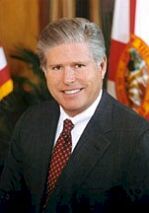 | FORMER CABINET MEMBER
TOM GALLAGHER |
�Borrow area No. 1, which has enough material with which to construct Segment II, now has a higher percentage of rock in it after removing sand for Segment III. We�ll need to investigate that. We�ll also look for additional sand offshore, but I�m not confident that we�ll find any significant new deposits. Accordingly, we will also be looking for more remote sources of domestic sand (e.g. offshore central FL and in the Gulf of Mexico) and for non-domestic sand, with emphasis on Bahamian aragonite. When we find the sand we�re going to use, if it�s different from the sand we had proposed to use in our previous plans, we will have to do some re-engineering of the project and redo some of the permitting.� Actually, when the project was undergoing Cabinet scrutiny, former Florida Chief Financial Officer and gubernatorial candidate Tom Gallagher also recommended that the project�s County supporters consider Bahamian sand as an alternative to the Deerfield Beach borrow site.
Wrapping up his correspondence with a flourish, Higgins said, �Finally, regulatory scrutiny of our reefs has recently ratcheted up due to the listing as federally �Threatened� of a couple of species of shallow-water hard coral, which is prolific offshore of Segment II.� With the President�s ex-governor brother safely sheltered from any political blowback, the Bush Administration has extended their enigmatic environmental policies to the State of Florida.
 | DIRECTOR APRIL GROMNICKI
OF AUDUBON SOCIETY |
The Bush administration and Congress have used the Everglades as a public relations flagship, promoting it as a national symbol of environmental recovery. However, on August 2nd, the White House threatened to veto the long-delayed Water Resources Development Act, a massive state-federal Everglades project that the Administration had adopted as proof of their commitment to the largest remaining subtropical wilderness in the United States. In what appears to be a case of kicking up the dust and then complaining that you can�t see, Administration delays to the project have driven up estimated land purchase costs from $15.4 billion in 2000 to $19.7 billion. Responding to the problem they were instrumental in creating, the White House contends that the bill has become too expensive. Director April Gromnicki of ecosystem restoration at the Audubon Society said, �If this is not authorized, it means more delays, more cost increases, less likelihood of success.�
 | DEPUTY ASSISTANT INTERIOR
SECRETARY TODD WILLENS |
Simultaneously, a mid-level Administration official recommended that UNESCO remove the Everglades from the endangered list. A unique rich tangle of sawgrass marshes, mangrove forests and rare species � the Everglades was added to the U.N. Educational, Scientific and Cultural Organization�s (UNESCO) list of the world�s most outstanding sites in 1979 and attributed endangered status in 1993, primarily due to pollution from urban growth, unrestricted agricultural runoff and severe damage from Hurricane Andrew in 1992. In 2000, Congress approved a 40-year recovery project for which the funding would be shared equally with the State. Not surprisingly, Florida taxpayers have paid the vast majority of the $7 billion already spent on the effort.
 | FLORIDA SENATOR
BILL NELSON |
Florida Senator Bill Nelson characterized the damaging recommendation as improper meddling by Deputy Assistant Interior Secretary Todd Willens since UNESCO is supposed to solicit input from the National Park Service and the World Conservation Union, or IUCN, a Swiss-based network that recommended keeping the Everglades on the endangered list. Its removal provides the Administration with a manufactured rationale for reneging on its commitment to support federal funding for Everglades rehabilitation.
 When UNESCO took environmental marching orders from Willens, a controversial irony was unwittingly exposed. The Interior Department�s No. 3 official served as policy director for ex-House Resources Chairman Richard Pombo, a California Republican and rancher who unsuccessfully tried to scale back the Endangered Species Act. Willens was also a recipient of Jack Abramoff�s largesse, joining a group of congressional staffers who visited the Mariana Islands on the disgraced lobbyist�s dime. When UNESCO took environmental marching orders from Willens, a controversial irony was unwittingly exposed. The Interior Department�s No. 3 official served as policy director for ex-House Resources Chairman Richard Pombo, a California Republican and rancher who unsuccessfully tried to scale back the Endangered Species Act. Willens was also a recipient of Jack Abramoff�s largesse, joining a group of congressional staffers who visited the Mariana Islands on the disgraced lobbyist�s dime.
 Keeping pace with federally engineered environmental moving targets for shallow-water hard coral and being subjected to a new formula governing the availability of sand off Deerfield Beach, Beach Administrator Higgins was forced to deliver the bad news. Consistent with his predisposition for conservative prognostication, Higgins wrote, �Realistically, I don�t see us beginning construction on Segment II until fall of 2009.� Keeping pace with federally engineered environmental moving targets for shallow-water hard coral and being subjected to a new formula governing the availability of sand off Deerfield Beach, Beach Administrator Higgins was forced to deliver the bad news. Consistent with his predisposition for conservative prognostication, Higgins wrote, �Realistically, I don�t see us beginning construction on Segment II until fall of 2009.�
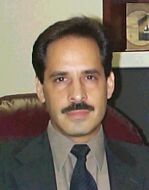 | GMCA PRESIDENT
PIO IERACI |
Understandably, GMCA President Pio Ieraci dashed off a concerned correspondence to the Chief of Broward�s Biological Resources Division, exclaiming, �2009! I feel somewhat ill. It will have taken almost 13 years for this project to materialize (Segment II). Is there ANYTHING we can do collectively to �speed up� this painfully slow process?� The consummate trooper, Higgins answered that upon locating a sand source, he would submit the appropriate state and federal permit modification requests. Having been pummeled with unexpected obstacles by project opponents at virtually every turn, Higgins also told Ieraci that he anticipates requiring additional support from the affected Galt Mile residents in the near future.
As Mr. Higgins prepares to mollify the latest federal obstacles threatening the beach project, we will have to patiently stand by, awaiting his cue to do what we do best � express our honest opinion about the importance of our beach to vested interests at every level of the political food chain. On the bright side, Steve Higgins has displayed a remarkable resilience when confronted by such obstacles during the past decade.
 | | Mayor Giulianti |
To date, the project�s progress is largely a reflection of his voluminous scientific acumen, sober penchant for diplomacy and a stoic fortitude that stiffens in proportion to the challenge confronted. While exhibiting patience is a painful proposition for those of us familiar with the project�s history, we are afforded solace in that we are assisting in a strategy created by a point man with the integrity, networking experience, intelligence and unrelenting commitment of Stephen Higgins. We could do worse than to faithfully follow the advice of the man who�s Biological Resources Division has successfully navigated the shifting political minefields in Broward, Tallahassee and Washington that surrounded the beach project. Skeptics need to take a quick trip to the beautifully widened beaches in Hollywood, Hallandale and Dania; close their eyes and imagine the waves lapping against the seawall � an IMAX moment! Alternatively, recalling how sections of Surf Avenue floated by Hollywood Mayor Mara Giulianti during 2004 Hurricanes Frances, Jeanne and Ivan will serve to stiffen a sagging resolve. More to come�
Click To Top of Page
Turtle Lighting Notice Controversy

City Clarifies Unintentional Threat

 May 4, 2007 - In mid-April, Fort Lauderdale�s Department of Building Services contacted oceanfront buildings within its jurisdiction. Accompanying a correspondence addressed to �property manager or owner� was a red, pink and white legal size Inspection Report generally used to support the building department�s contention that some ordinance(s) had been violated. The body of the notice containing ordinance and/or statute numbers, brief textual descriptions and the expected corrective actions all remained blank. Immediately below, in the five lines reserved for a description were two cryptic phrases, �6-51 Artificial Lighting Violation� and �Please See Attached�. Just above the Inspector�s name and identification number is the number of days available to correct the violation couched in the enabling legislation and the prescribed penalties. 14 days were allotted to cure the violation alluded to in the attached document. May 4, 2007 - In mid-April, Fort Lauderdale�s Department of Building Services contacted oceanfront buildings within its jurisdiction. Accompanying a correspondence addressed to �property manager or owner� was a red, pink and white legal size Inspection Report generally used to support the building department�s contention that some ordinance(s) had been violated. The body of the notice containing ordinance and/or statute numbers, brief textual descriptions and the expected corrective actions all remained blank. Immediately below, in the five lines reserved for a description were two cryptic phrases, �6-51 Artificial Lighting Violation� and �Please See Attached�. Just above the Inspector�s name and identification number is the number of days available to correct the violation couched in the enabling legislation and the prescribed penalties. 14 days were allotted to cure the violation alluded to in the attached document.
 Earlier, academicians from Nova Southeast University took an evening stroll along the Galt Mile shore. As they passed each building, they rolled videotape of their view from the beach. While the camera jockey captured the east side of every structure, an environmental peer scripted what they saw. They saw lights - bright and dim; directional and ambient; white, yellow, red, blue and green. Carriage lights, flood lights, spots, uplights, mushrooms, wall mounted, posted or suspended from every building they passed. Earlier, academicians from Nova Southeast University took an evening stroll along the Galt Mile shore. As they passed each building, they rolled videotape of their view from the beach. While the camera jockey captured the east side of every structure, an environmental peer scripted what they saw. They saw lights - bright and dim; directional and ambient; white, yellow, red, blue and green. Carriage lights, flood lights, spots, uplights, mushrooms, wall mounted, posted or suspended from every building they passed.
 They were sent by the Florida Fish and Wildlife Conservation Commission on behalf of Sea Turtles. Sea turtles are either endangered or threatened (the loggerhead is the only species that has a population high enough to be only threatened in Florida). They are protected under the Federal Endangered Species Act of 1973 and Florida�s Marine Turtle Protection Act (379.2431, Florida Statutes). The Florida Department of Environmental Protection and the Florida Fish and Wildlife Conservation Commission (FWC) together review permits for coastal construction under Chapter 62B, F.A.C. (Florida Administrative Code) that affects Marine Turtles. The state of Florida developed a model lighting ordinance (62B-55, F.A.C.) to guide local governments in creating lighting ordinances. They were sent by the Florida Fish and Wildlife Conservation Commission on behalf of Sea Turtles. Sea turtles are either endangered or threatened (the loggerhead is the only species that has a population high enough to be only threatened in Florida). They are protected under the Federal Endangered Species Act of 1973 and Florida�s Marine Turtle Protection Act (379.2431, Florida Statutes). The Florida Department of Environmental Protection and the Florida Fish and Wildlife Conservation Commission (FWC) together review permits for coastal construction under Chapter 62B, F.A.C. (Florida Administrative Code) that affects Marine Turtles. The state of Florida developed a model lighting ordinance (62B-55, F.A.C.) to guide local governments in creating lighting ordinances.
 | | TURTLE HATCHLING DEATH TRAP |
For millions of years, nesting female sea turtles have been laying their eggs on our beaches. Their hatchling turtles were guided to the ocean by an instinct to travel away from the dark silhouettes of dune vegetation and toward the moonlight-illuminated open ocean. In many highly populated coastal areas, artificial lights near the beach are brighter than the moonlit ocean, reversing the turtles� biological compass. Nesting females seeking the darkened shore instead head out to sea where they cannot lay their eggs. If they find the shore and successfully deposit their eggs, the disoriented hatchlings travel inland, toward the artificial lights, where they often die from dehydration or predation by fire ants and ghost crabs. They also become �road kill� on local thoroughfares.
 Broward County adopted Chapter 39, Article IX, Sec 39-107 in 1989. Ten years later, Pompano Beach followed their lead (Ords 99-18, 2000-64), Deerfield Beach in 2000 (Chapter 34, Article V, Sec 34-96), Hallandale Beach in 2001 (Ch. 6, Art. I), Lauderdale-by-the-Sea in 2002 and Fort Lauderdale in 2003 (Chapter 6, Article III). Fort Lauderdale�s official contact with the Florida Fish and Wildlife Conservation Commission is Al Lovingshimer (954) 828-5118 � a code inspector whose name graced the bottom of every violation Inspection Report. Broward County adopted Chapter 39, Article IX, Sec 39-107 in 1989. Ten years later, Pompano Beach followed their lead (Ords 99-18, 2000-64), Deerfield Beach in 2000 (Chapter 34, Article V, Sec 34-96), Hallandale Beach in 2001 (Ch. 6, Art. I), Lauderdale-by-the-Sea in 2002 and Fort Lauderdale in 2003 (Chapter 6, Article III). Fort Lauderdale�s official contact with the Florida Fish and Wildlife Conservation Commission is Al Lovingshimer (954) 828-5118 � a code inspector whose name graced the bottom of every violation Inspection Report.
 | | TURTLE HATCHLINGS LEAVING NEST |
Mr. Lovingshimer�s attached document introduced the issue to the addressee, �For the protection of threatened and endangered species of sea turtles, a lighting compliance survey of Fort Lauderdale Beach was recently conducted. During this inspection, violations on your property were identified as noted below.� It was followed by a thinly veiled threat, �Your cooperation in correcting these potential threats to threaten and endangered species of sea turtles in the time indicated on the accompanying �INSPECTION REPORT� is greatly appreciated and will avoid the necessity of further enforcement action.� Potential enforcement actions include a Chinese menu of three options. The first allows the City to fix the problem and charge any cost to the property owner. If determined by the Code Enforcement Board or a Special Magistrate that the violation exists, the property owner is fined $250 per day until remedied. The attendant debt becomes a lien on the property. A more drastic action is reserved for the City�s third option, wherein an arrest may be effectuated, a summons from the City Prosecutor served, and exposure to fines up to $500 per day joined by a jail sentence from 0 - 90 days. This disclaimer of sorts is designed to marshal the property owner�s undivided attention. The attached letter also describes as the �Source of Violation� every light on the property visible from the beach, including light emanating from the windows of unit owners. It ends with the admonition, �Please remind everyone to close blinds, shades etc.�
Lastly, a copy of the City ordinance governing lighting standards for existing development is attached (Chapter 6, Article III, Div. 2, Sec. 6-51). �It is the policy of the City of Fort Lauderdale that no artificial light shall illuminate any area of the incorporated beaches of Fort Lauderdale, Florida. To meet this intent, lighting of existing structures that can be seen from the beach shall be in compliance with the following:� The 3 following provisions describe how lights illuminating the beach for any purpose are to be mollified during the March 1st through October 31st nesting season.
Darkening the rear of every building will foment serious insurance and security repercussions. Trip and fall incidents on darkened association property will be unceremoniously dumped onto the City. The wholesale subrogation of medical damages, especially from elderly victims, will become a municipal budget line item. Unaddressed security consequences also threaten beachfront homeowners. Our sparsely illuminated beach areas have historically been security �black holes� to nervous residents. If half of every building is plunged into darkness for 8 months of the year, crime behind condominiums will become a growth industry. The anticipated �Galt Mile Security Patrol� will have to be trebled and fitted with night vision equipment.
Within 48 hours, twelve angry GMCA member associations contacted the neighborhood association with questions about the surprise violation notice. On April 26th, GMCA Officials Pio Ieraci and Eric Berkowitz met with Lovingshimer to ascertain how associations could best comply with the ordinance without creating on-site danger zones or sending their budgets into a tailspin. After exploring the intention of the ordinance and realistic options available to associations aspiring to comply, Mr. Lovingshimer agreed to address member concerns at the May 7th Presidents Council meeting.
 Fortunately, Mr. Lovingshimer is unwilling to test the downside of completely darkening peoples� homes. During a discussion about compliance with the municipal ordinance, Lovingshimer stressed the importance of finding a viable balance between residents� safety and improving the survivability rates of an endangered species. Through the judicious use of motion detectors, screens, shields, downlights and fixtures incorporating light-management techniques, compliance is achievable while minimizing some of the safety impacts. Since the ordinance was first passed, research has improved the lighting options available to address the problems of both people and turtles. Fortunately, Mr. Lovingshimer is unwilling to test the downside of completely darkening peoples� homes. During a discussion about compliance with the municipal ordinance, Lovingshimer stressed the importance of finding a viable balance between residents� safety and improving the survivability rates of an endangered species. Through the judicious use of motion detectors, screens, shields, downlights and fixtures incorporating light-management techniques, compliance is achievable while minimizing some of the safety impacts. Since the ordinance was first passed, research has improved the lighting options available to address the problems of both people and turtles.
 To reduce the effects of artificial lighting on sea turtles, it is first essential to understand how sea turtles perceive light in their environment. First, and most importantly, strategies to resolve lighting problems must recognize that man�s common notions of brightness and color do not apply, because sea turtles and humans perceive light quite differently. To reduce the effects of artificial lighting on sea turtles, it is first essential to understand how sea turtles perceive light in their environment. First, and most importantly, strategies to resolve lighting problems must recognize that man�s common notions of brightness and color do not apply, because sea turtles and humans perceive light quite differently.


 | | HOW COLOR (WAVELENGTH) OF LIGHT SOURCE IMPACTS TURTLE BEHAVIOR |
Both the color (wavelength) and relative brightness of light sources are important in the sea-finding capabilities of hatchling sea turtles (Witherington and Martin, 1996; Lohmann et al., 1997). Green turtles are strongly attracted to light in the near-ultraviolet to yellow region of the visible spectrum (360 to 600 nm) but are relatively indifferent to light in the yellow-orange to red region (630 to 700 nm; see diagram at right). Loggerhead turtles are also strongly attracted to short wavelength light, but unlike green turtles, have an aversion to bright light in the green-yellow to yellow spectrum (560 to 600 nm); loggerheads are only moderately attracted to longer wavelength light in the orange and red spectra. The relatively high sensitivity of turtles to short wavelengths is not surprising considering that they live in a medium, the ocean, which selectively filters out long wavelength colors.
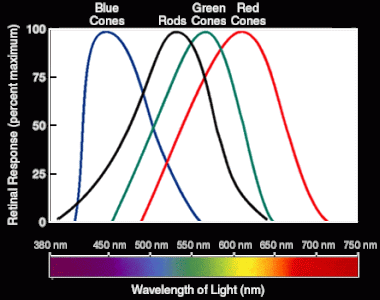 | | HOW COLOR (WAVELENGTH) OF LIGHT SOURCE IMPACTS HUMANS |
The relative attraction of hatchlings to different colors is a function of brightness. Relatively low intensities of ultraviolet to green light (short wavelengths) are needed to elicit an orientation response in loggerhead hatchlings, whereas much higher intensities of long wavelength light would be required to elicit a similar response (Witherington and Martin, 1996). Hatchlings can be attracted to even long wavelength red light at very high intensities.
Most light sources are composed of many wavelengths, each representing a different color. However, since we are unable to distinguish among the spectral components; we see only a single color. The same is true for sea turtles. Nevertheless, due to differences in spectral sensitivities, the color emitted by a particular light source may not appear the same to humans as to sea turtles. Similarly, two light sources appearing very similar in color to humans may appear dramatically different to sea turtles. This has important implications for effective light management. For example, a source emitting monochromatic (single wavelength) yellow light is unattractive or only weakly attractive to hatchlings. Yet, another source, which also appears yellow to humans but contains both green and red spectral components, can be highly attractive to hatchlings because of the green wavelengths present. Consequently, we cannot rely solely on color when determining whether or not a light is likely to attract hatchlings. A white light source (which is comprised of every spectral color) that's encased in a bulb with a yellow or red coating still emanates light with both long and short wavelengths. However, if the source is comprised purely of long wavelength yellow or red light, it will have a negligible impact on sea turtle behavior.
 | | TURTLES PERCEIVE LIGHT THRU CONE OF ACCEPTANCE |
In addition to their spectral sensitivity, hatchling sea turtles also are sensitive to the directional component of light (Witherington and Martin, 1996; Lohmann et al., 1997). As hatchlings assess the brightest direction, they integrate light through a broad, relatively flat cone of acceptance (See Diagram). For loggerhead turtles, the cone of acceptance is about 180� wide and only from about 10� to 30� above the ground. This implies that light reaching the hatchling from all sources combined (illuminance) is more important in influencing orientation than is the brightness of light emanating from a particular source (luminance). Furthermore, light near the horizon plays the greatest role in determining orientation direction. Thus, color, brightness, proximity to the beach, and broadcast characteristics combine to determine the relative attractiveness of a light source to a hatchling.
  Given the relentless financial burdens faced by every association during the past few years, ranging from storm related damage repairs, huge insurance increases, windstorm mitigation construction and the planned assessments required to rehabilitate any 30-year old structure, association members are financially shell-shocked. Sympathetic with the fiscal strain currently plaguing association residents, Lovingshimer made suggestions that were accommodatingly moderate. Some fixtures could be modified with screens costing between $20 and $40. Bollards, mushrooms and downlights fitted with special bulbs constitute an inexpensive replacement for some of the most offensive lighting violations. In fact, the Florida Fish and Game web site offers links to companies whose products have been approved as compliant turtle-safe lighting. Given the relentless financial burdens faced by every association during the past few years, ranging from storm related damage repairs, huge insurance increases, windstorm mitigation construction and the planned assessments required to rehabilitate any 30-year old structure, association members are financially shell-shocked. Sympathetic with the fiscal strain currently plaguing association residents, Lovingshimer made suggestions that were accommodatingly moderate. Some fixtures could be modified with screens costing between $20 and $40. Bollards, mushrooms and downlights fitted with special bulbs constitute an inexpensive replacement for some of the most offensive lighting violations. In fact, the Florida Fish and Game web site offers links to companies whose products have been approved as compliant turtle-safe lighting.
 More importantly, Lovingshimer exclaimed that compliance standards are conditional on improvement, not perfection. If each beachfront structure addressed the most egregious violations, Fish and Wildlife will have chalked up a major victory. Many of these adjustments simply require altering the direction of high intensity lamps. Carriage lights are correctable through the use of inexpensive semicircular deflector screens installed between the bulb and the fixture lens. Associations experiencing serious budgetary shortfalls can hand-fashion these products if necessary � although purchasing them for a few hundred dollars will better preserve aesthetic integrity. More importantly, Lovingshimer exclaimed that compliance standards are conditional on improvement, not perfection. If each beachfront structure addressed the most egregious violations, Fish and Wildlife will have chalked up a major victory. Many of these adjustments simply require altering the direction of high intensity lamps. Carriage lights are correctable through the use of inexpensive semicircular deflector screens installed between the bulb and the fixture lens. Associations experiencing serious budgetary shortfalls can hand-fashion these products if necessary � although purchasing them for a few hundred dollars will better preserve aesthetic integrity.
 Last year, MB Lighting Specialists, Inc. proprietor Michael Boiteau demonstrated some wildlife-safe lighting products at a GMCA Presidents Council meeting. Unfortunately, his presentation was prologue to a meeting convened primarily to address the crippling insurance crisis. As such, most attendees were looking past this issue to the more critical insurance update that followed. Following the blizzard of angry association telephone responses precipitated by Lovingshimer�s violation notices, Boiteau was again contacted by GMCA. He said that each association could comply with the regulations at a variety of price points. He agreed to provide any interested association with a spectrum of solutions ranging from less than $100 to several thousand dollars for high-end lighting strategies. Last year, MB Lighting Specialists, Inc. proprietor Michael Boiteau demonstrated some wildlife-safe lighting products at a GMCA Presidents Council meeting. Unfortunately, his presentation was prologue to a meeting convened primarily to address the crippling insurance crisis. As such, most attendees were looking past this issue to the more critical insurance update that followed. Following the blizzard of angry association telephone responses precipitated by Lovingshimer�s violation notices, Boiteau was again contacted by GMCA. He said that each association could comply with the regulations at a variety of price points. He agreed to provide any interested association with a spectrum of solutions ranging from less than $100 to several thousand dollars for high-end lighting strategies.
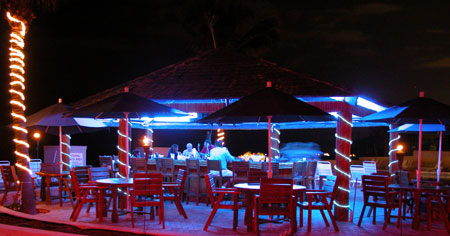 | | OCEAN MANOR CONDO-HOTEL DECORATIVE LIGHTING AT NIGHT |
At the May 7th Presidents Council event, Code Inspector Al Lovingshimer intends to convey that Florida Fish & Wildlife�s initiative requirements can be met without sacrificing safety, security or the association budget. When queried about the abbreviated compliance time frame described in the violation notice, Lovingshimer acknowledged that 14 days is unrealistic. �As long as we know that an effort to comply is underway, we will extend the time as needed. I will work with every GMCA member that requests assistance,� said Lovingshimer. Addressing the heavy-handed manner in which associations were notified, Lovingshimer said �We regret any confusion caused by the threatening tone of the notices, we simply wanted to improve the survival rates for hatchlings and their nesting mothers. It is unfortunate that half the boilerplate notice is devoted to non-compliance penalties. That was not the message we wanted to get across.� Understandably, the structures facing the block�s biggest challenges are the beachfront hotels and condo-hotels such as GMCA member Ocean Manor. Also affected by the notice, Galt Merchants Association member Ocean Sky Hotel was granted permission to attend the meeting.
Lovingshimer explained that a meeting about turtle-safe lighting was held in the Lauderdale-by-the-Sea Town Hall last year. Expressing frustration with the disappointing turnout, he admitted, �Since the Galt Mile Association has agreed to help us get the word out, this won�t happen again. We appreciate the opportunity to clarify that our objectives are limited to reasonable adjustments; we intend to avoid any security complications.�
 | INTERNATIONAL DARK SKY
OKed LIGHTING FIXTURES |
For example, Lovingshimer referred to that portion of some notices identifying the light from unit owner windows as sources of violation. �We don�t expect people to walk around their homes in the dark. If the association posts a reminder requesting that residents turn off their lights upon leaving the house and close the shades on windows overlooking the ocean, we will consider the association to be in compliance with that aspect of the notice.� He said the request might be added to an existing newsletter, posted on a bulletin board, placed on an association web site or sent out with the maintenance notice. As he stated, Lovingshimer isn�t looking for perfection, just improvement. Sounds reasonable!
More information regarding sea turtles and the local conservation program is available from the County�s Environmental Protection Department, Biological Resources Division (954) 519-1230 or www.broward.org/bio/seaturtle.htm. To elicit turtle info from the Florida Fish and Wildlife Conservation Commission, call (850) 922-4330 or MyFWC.com/seaturtle. To reach code inspector Al Lovingshimer, or whoever is currently Fort Lauderdale�s official contact with the Florida Fish and Wildlife Conservation Commission, call (954) 828-5118 or Code Compliance customer service at (954) 828-5207. The links below offer access to Turtle-Safe lighting informational websites, organizations that discuss relevant products and companies that sell them.

 Presidents Council Meeting Presidents Council Meeting 

May 9, 2007 - On May 7th, Fort Lauderdale Code Inspector Al Lovingshimer, accompanied by a host of environmental and lighting officials from the City of Fort Lauderdale and Broward County, illuminated participants about the plight of Marine Turtles and the measures required to prevent their extinction. Representatives from almost every GMCA member association were first introduced to Natural Resource Specialist Lou Fisher from the Biological Resources Division of Broward County�s Environmental Protection Department. Lou works with Broward Beach Administrator Stephen Higgins, a primary engineer of the Broward County Shore Protection Project.
 | BROWARD BIOLOGICAL RESOURCES DIV
STEPHEN HIGGINS AND LOU FISHER |
Fisher explained how artificial lighting disrupts the biological compass evolved by Sea Turtles over millions of years. He also described how various types of lighting affect Sea Turtle behavior. Fisher distinguished between light sources that, �while similar in appearance to humans, differ in the way they are perceived by Sea Turtles.� By way of example, he strongly recommended low pressure sodium bulbs that appear yellow. Other yellow lighting, depending on the wavelengths that comprise its net color, may present a danger to hatchlings by luring them inland where their chances for survival drop precipitously.
Lovingshimer introduced Fort Lauderdale Building Department Community Inspections Manager Catherine McCaffrey to attendees. Ms. McCaffrey apologized for the harsh correspondences that initially stirred community ire and created a good deal of confusion about the City�s intentions. She said that the boilerplate forms available for corresponding with potential scofflaws were inappropriate when aspiring to enlist support for a productive program. McCaffrey assured GMCA members that the snafu wouldn�t be repeated. She stated that new forms created for that purpose were already ordered and will replace the threatening documentation inadvertently sent to GMCA members.
 McCaffrey was joined by City officials from the Public Works Department. Facilities Manager Tom Terrell and Environmental Services� Kris McFadden stressed the importance of making reasonable efforts to reverse a trend that threatens Sea Turtles with extinction. When asked why this effort was necessary since environmental teams identify any nests on Broward beaches and move the eggs to safe nesting beaches, they clarified that the emergency nest transfers are temporary measures. While useful for delaying the species� demise, simply moving the eggs will never meet the recovery plan objectives envisioned by the Florida Fish and Wildlife Conservation Commission. McCaffrey was joined by City officials from the Public Works Department. Facilities Manager Tom Terrell and Environmental Services� Kris McFadden stressed the importance of making reasonable efforts to reverse a trend that threatens Sea Turtles with extinction. When asked why this effort was necessary since environmental teams identify any nests on Broward beaches and move the eggs to safe nesting beaches, they clarified that the emergency nest transfers are temporary measures. While useful for delaying the species� demise, simply moving the eggs will never meet the recovery plan objectives envisioned by the Florida Fish and Wildlife Conservation Commission.
 | | FALSE CRAWL BY ROCKPILE |
The statewide effort to move the eggs to protected beaches was instituted as an emergency measure. Marine turtle authorities agree that a successful species replenishment can only be achieved with an effective �Hands Off� policy, not by rescuing one egg at a time. Fisher interjected that �moving nests out of harm�s way only partially solves the problem and creates new ones.� Hatchlings from overlooked nests will continue to suffer disorientation from artificial beach lighting. Fisher continued, �Notwithstanding how skillfully the eggs are moved, transferred clutches of eggs have significantly poorer hatching rates. More importantly, moving the nests does nothing to prevent lighting from deterring nesting turtles and interfering with their orientation on the beach.� When nesting females find a beach unsuitable due to the lights or items blocking a potential nesting area (A.K.A. Coastal Armoring), they return to the sea in what is called a �false crawl.� This event represents a 100% loss of prospective hatchlings.
 | BEACH FURNITURE BLOCKS NEST ACCESS
A.K.A. "COASTAL ARMORING" CAUSES FALSE CRAWL |
Despite the efforts of the Turtle Teams, disorientation events are increasing at an alarming rate. Moving the eggs will simply postpone the ultimate loss of several Marine Turtle species. Preserving their nesting habitats affords Sea Turtles their only real opportunity for the numerical proliferation necessary to secure their statistical survival. Since all new beach construction must implement a Turtle-Safe lighting plan consequent to receiving a permit, new buildings are not anticipated to inflame the problem.
Lovingshimer emphasized that it is not necessary to sacrifice safety, security and peaceful enjoyment of our homes to accomplish the objectives denoted by the Florida Fish and Wildlife Conservation Commission. The adjustments required to mollify the effects of artificial lighting are inexpensive and effective. Code Inspector Lovingshimer closed with an invitation to any association interested in a free evaluation of their lighting requirements. �Feel free to contact me at 954-828-5118,� said Lovingshimer.
At that point, GMCA President Pio Ieraci introduced lighting specialist Michael Boiteau. Boiteau, proprietor of MB Lighting Specialists, Inc., demonstrated several examples of inexpensive equipment available to address the problem. �It isn�t necessary to change every fixture behind your homes. Many of the offending lamps can be adjusted with a sheild or a deflector. Others may simply require changing the bulb.� Boiteau also said that he would be glad to perform free evaluations for any interested building. He can be reached at 954-788-7658.
Turtle-Safe Lighting Links

Click To Top of Page
Galt Mile Outfall Pipes Meeting
Stephen Higgins  Discusses Plan Discusses Plan

 September 17, 2006 - When the Galt Ocean Mile was under development, the oceanfront luxury housing projects utilized structural technologies which were considered �cutting edge�. With time, these systems sank into obsolescence. When the diminished integrity of these aging structural elements presented safety threats or their growing inefficiency increased operational costs, Associations would adjust their budgets to include upgrades. Over the years, backup generators, elevators, fire safety systems, roofs and video security were modernized with second and third generation improvements. In certain cases, wholesale upgrades were motivated by unexpected environmental changes such as the serial hurricanes prompting the need for improved window and door protection. As plumbing risers fell prey to internal erosion, attendant leaks and floods were cured by the installation of replacement pipes. September 17, 2006 - When the Galt Ocean Mile was under development, the oceanfront luxury housing projects utilized structural technologies which were considered �cutting edge�. With time, these systems sank into obsolescence. When the diminished integrity of these aging structural elements presented safety threats or their growing inefficiency increased operational costs, Associations would adjust their budgets to include upgrades. Over the years, backup generators, elevators, fire safety systems, roofs and video security were modernized with second and third generation improvements. In certain cases, wholesale upgrades were motivated by unexpected environmental changes such as the serial hurricanes prompting the need for improved window and door protection. As plumbing risers fell prey to internal erosion, attendant leaks and floods were cured by the installation of replacement pipes.
 | | OUTFALL PIPE |
In South Florida, air conditioning is not an amenity; it is a necessity. All along the block, the original equipment used to provide cooling deteriorated from age and wear even as its underlying technology became obsolete. As these systems broke down, most associations opted to upgrade to newer, more efficient replacements. Following the one-time expense attached to the installation of one or more cooling water towers, operational and maintenance costs plummeted. As an added benefit, the owners occupying higher floors who were long deprived of adequate cooling were finally made comfortable. Facing other expenses or engineering obstacles, some associations left their original systems on life support, subjecting themselves to huge maintenance and repair bills while holding things together with truckloads of crazy glue.
 | | OUTFALL PIPE DISCHARGE |
These original systems required that every Galt Mile association vent its HVAC condensate and/or water utilized for heat exchange into the ocean through large outfall pipes that were buried under the beach. As tidal erosion washed away the sand, the exposed pipes became increasingly prominent tripping hazards and offensive eyesores. As these deteriorating systems were replaced by more efficient ones based on cooling towers, most associations removed these obsolete rusting safety hazards. Some did not. For a variety of reasons, five Galt Mile associations are still using them.
 | STEPHEN HIGGINS &
ILENE LIEBERMAN |
Several years ago, the Florida Department of Environmental Protection (DEP) contacted oceanfront buildings, alerting them to new permitting requirements for these structures. Conveying a laundry list of environmental concerns, any association insisting on maintaining these pipes had to submit accurate and current engineering and environmental feedback about the outflow composition, ambient water temperature and reams of ancillary data. After meeting with DEP officials, several engineers retained for this purpose reported that DEP�s wish list included ridding the coast of these dinosaurs. Evidently, they suffered bad experiences with similar structures in other parts of the State. While the Galt Mile pipes discharge innocuous condensate, stormwater runoff or well water subjected to heat-exchange, other pipes drain all manner of offensive materials into the ocean. Coral reef advocates claimed that the pipes were adversely affecting water quality and carving significant gullies into the beach and ocean bottoms. Testing by retained engineers and the Broward County Environmental Protection Department (EPD) dispelled these allegations as they apply to the Galt Mile outfall pipes.
 | | PLAZA EAST ROOF - ROOM FOR WATER TOWERS |
Last December, a decidedly hostile notice was received from DEP reaffirming their concerns. Several affected Galt Mile associations contacted the DEP Southeast District Office in West Palm Beach and communicated with Linda Horne, the District�s Environmental Administrator of Water Resources. Pending a successful outcome of the reef impact monitoring, Segment II (Fort Lauderdale) of the beach renourishment is scheduled to drop about 100 feet of additional sandy beach over the existing Galt Mile shoreline, completely covering any remaining outfall pipes. While the pipes could conceivably undergo an expensive 100 foot extension, the attendant construction would require a permit from the State. Florida DEP, whose approval would be required for such a permit, is strongly averse to the perpetuation of these pipes. Despite the absence of any real environmental indictment, it became apparent that their days were numbered.
 | FOUNTAINHEAD
MANAGER CARL ELLIS |
Stephen Higgins of the Broward County Environmental Protection Department�s (EPD) Biological Resource Division is the main architect of the Broward Beach Protection Project. A jurisdictional agreement between Florida DEP and Broward EPD has empowered Higgins to represent DEP in certain matters wherein they share mutual interests. In that he was wearing the hat of every environmental agency involved in this conundrum, Higgins agreed to act as liaison between the affected associations and the DEP. On September 11th, the Galt Mile Community Association sponsored a 6:45 PM special meeting at the Ocean Club Condominium to address the issue. Representatives of seven Galt Mile Associations with outflow pipes in varying states of functionality met with Mr. Higgins to formulate an effective plan of action.
 | PLAZA EAST PREXY
RICH LOARIE |
Co-Chaired by GMCA Vice President Pio Ieraci and Secretary Eric Berkowitz, the meeting began with every attending association describing the status of their existing outfall structures. Galt Ocean Club President Pio Ieraci said that with the installation of water towers on their roof, �the pipe behind Galt Ocean Club had been relegated to a non-functional remnant.� President P.D. Foster and Manager Herb Santiago of meeting host Ocean Club claimed two pipes that were currently operational. Accompanied by Treasurer John Toklucu and Director Ismet Baker, Plaza East President Rich Loarie described their two operational pipes as performing different functions. He stated, �Cool salt water from a well is discharged into the ocean after being warmed by an air conditioning heat exchange. The second pipe drains collected stormwater into the ocean.� Ocean Summit Director Russell Bailey said his association has one operational outfall pipe. Plaza South�s Andy Surdival stated that they had two operational pipes. Accompanied by Marlene Katkin, Fountainhead Manager Carl Ellis explained that since they recently installed a water tower, he anticipates that their one pipe will be rendered non-operational in about a month. Edgewater Arms also has a non-operational pipe.
 | | NEW FOUNTAINHEAD WATER TOWERS |
Beach Erosion Administrator Higgins explained that since the land below the mean high water line belongs to the State of Florida, DEP had significant jurisdictional standing in determining the fate of the outfall pipes. Since they represent an irresolvable obstacle to the Beach Protection Project, the pipes would have to go by the time that the project started up again in 2008. Higgins elaborated, �Other considerations aside, the DEP can hold the Beach Project hostage to the removal of these structures.� Rich Loarie asked Higgins about the underlying rationale for performing beach renourishment. Higgins responded, �While the beaches are a critically important recreational resource and provide a unique environmental habitat, their greatest value derives from the protection they provide to lives and property in coastal communities. They are our best defense against storm damage.�
 | STEPHEN HIGGINS
AT GMCA MEETING |
When asked by several attendees, Mr. Higgins discussed alternatives to outfall pipes. When Herb Santiago expressed interest in replacing the pipe�s discharge function with a well, Pio Ieraci, Carl Ellis and Eric Berkowitz all agreed that, given the cost and the potentially erratic performance of wells, water towers were clearly a preferable option. Carl Ellis explained that after Fountainhead performed an extensive study of their alternatives, they determined that the advantages of the water tower option were overwhelming. Eric Berkowitz explained that the 190-foot exfiltration well recently installed in Regency Tower was connected by a system of French drains to association catch basins, relieving the garage of stormwater floods suffered even during moderate rain events. Since Regency Tower has a rooftop water tower, the well need not contribute to any cooling function. Rich Loarie and Ismet Baker concurred, stating that Plaza East is favorable to installing water towers.
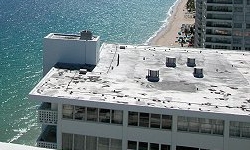 | | OCEAN SUMMIT ROOF - ROOM TO SPARE |
When Andy Surdival asked Higgins what Broward County would do if still faced with remaining outfall pipes when the project recommences, he responded, �The County would have to remove them prior to installing the sand.� He admonished that he couldn�t confirm whether or not the County would pass the cost to the Association. Since the existing pipes all extend past the mean high water line and are partially located on State-owned land, a DEP permit is required prior to their removal. Broward County�s direct or indirect participation in excising these outfall pipes will be an invaluable asset when contending with the mind-numbing DEP permit process. When asked about the cost of removing these structures, Higgins recounted an incident wherein the county removed old groins extending 150 into the ocean. He said, �The cost of removing 40 of these structures and hauling them away via dump trucks was $300,000.�
 | | OCEAN CLUB ROOF - NOT ENOUGH SPACE |
Since permits to extend these structures appear to be unattainable, every association relying on them for cooling or drainage must have an alternative in place by the time that Broward sees to their removal. According to manager Carl Ellis, it took about a year from their initial feasibility study before Fountainhead could install their water tower. While most Associations can safely install water towers on their roofs, two exceptions were considered. Due to their extreme weight when filled, they are generally situated directly above accessible building columns. Absent that configuration, either additional I-bar support must be constructed to redistribute the weight or the water towers must be relocated to ground level. Herb Santiago expressed Ocean Club�s unique dilemma. Since their roof is already covered with a basketball court and a swimming pool, installation of a water tower would have to be at ground level. Given that water towers are somewhat noisy, additional sound insulation would be required.
In conclusion, with Fountainhead�s impending outfall pipe deactivation next month, only Plaza East, Plaza South, Ocean Club and Ocean Summit face the beach renourishment removal deadline. While they are in varying stages of contending with this unavoidable requirement, Mr. Higgins conjectured that there is enough time to perform any preliminary studies, develop a scope of work and complete construction prior to commencement of the Segment II renourishment. On the bright side, it is conceivable that Broward County may actually remove any remaining pipes at that time. That is an enormous benefit to associations that ordinarily would be forced to navigate a difficult DEP permit process prior to an expensive extraction procedure. The unit owners of those associations facing the systems upgrade will realize a secondary benefit already enjoyed by their neighbors. Simply put, they will spend less money for cooler air!
Click To Top of Page
�Turtle Magic�
Enchantment on Call

 July 23, 2006 - On July 14th, Playa del Mar resident Phyllis Carter awoke to experience one of those surprise thrills unique to beachfront homeowners. Every Galt Mile resident has blankly gazed at the ocean horizon, awed by the natural beauty in our back yard. Despite the relative brevity of these intermittent �Discovery Channel� moments, they serve to remind many of us why we moved here to begin with. July 23, 2006 - On July 14th, Playa del Mar resident Phyllis Carter awoke to experience one of those surprise thrills unique to beachfront homeowners. Every Galt Mile resident has blankly gazed at the ocean horizon, awed by the natural beauty in our back yard. Despite the relative brevity of these intermittent �Discovery Channel� moments, they serve to remind many of us why we moved here to begin with.
Ms. Carter�s early morning rendezvous with one of the Galt Mile�s longtime native legacies inspired an email to friends and neighbors describing her witnessed incident. To underscore her delight, she entitled the email with a phrase lifted from the libretto of �The Music Man�. It reads as follows:
�A Beach Event Right Here in River City�
 | TURTLE TEAM ON GALT MILE BEACH BETWEEN
PLAYA DEL MAR AND REGENCY TOWER |
�This morning at 7 AM I noticed the turtle tracks in the sand on our beach and by the time I got my camera, a team of �turtle conservationists� were upon the scene to do their thing. They worked very carefully to locate the eggs, each creating a hole in the sand with their bare hands until the eggs were found. When that was determined, two remained while the others continued up the beach in search of more turtle tracks.
Each egg was gently removed and placed in one of those buckets in a bed of sand and my guess delivered to a sanctuary of some kind for protection. Such an amazing event. About midnight Tuesday and Wed nite I had seen people on the beach with flashlights and now the mystery is solved. They must have been on the look for turtles but this turtle outsmarted them and delivered in her own time, unobserved.
Then the team circled around the site repeatedly to disguise the tracks and excavation. So coooool! Felt like I was watching a NOVA special.�
Later,
Phyllis
 | TEAM PREPARES RESCUED EGGS FOR TRANSFER
VIEW FROM 24th FLOOR OF PLAYA DEL MAR |
Operating under the aegis of the Florida Fish and Wildlife Marine Turtle Program, �Turtle Teams� have several possible objectives. Some are licensed to protect the nests on site through an assortment of venues such as caging or, if necessary, move the eggs to beaches more appropriate as safe nesting sites. They consider an assortment of factors including coastal littering, beach furniture, nearby construction, seawalls (coastal armoring), and beach lighting that could be misinterpreted as moonlight and lure disoriented hatchlings away from the ocean.
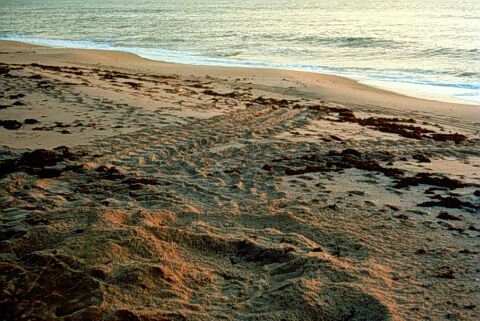 | | SEA TURTLE TRACKS TO AND FROM THE NEST |
Other authorized teams have permits to perform research surveys and gather data. The state of Florida, through the Florida Fish and Wildlife Conservation Commission's Fish and Wildlife Research Institute, coordinates two sea turtle monitoring programs: the Statewide Nesting Beach Survey and the Index Nesting Beach Survey. The Statewide Nesting Beach Survey (SNBS) program was initiated in 1979 under a cooperative agreement between the Florida Fish and Wildlife Conservation Commission (FWC) and the U.S. Fish and Wildlife Service. Its purpose is to document the total distribution, seasonality and abundance of sea turtle nesting in Florida. They track the nesting habits of five species listed as either threatened or endangered under the Endangered Species Act; the loggerhead (Caretta caretta), the green turtle (Chelonia mydas), the leatherback (Dermochelys coriacea), the hawksbill (Eretmochelys imbricata) and Kemp�s ridley (Lepidochelys kempii). The Index Nesting Beach Survey (INBS), a monitoring program performed in conjunction with SNBS, was established to measure seasonal productivity, allowing comparisons between beaches and between years.
The data from these surveys provided strong support for the beach renourishment currently underway in Broward County. Miles of vanishing Marine Turtle nesting habitat that fell prey to tidal erosion is being restored. Additionally, the Biological Resources Division of the Broward County Environmental Protection Department (EPD) carefully timed the project to avoid dredging and shore restoration activities during the sensitive nesting season.
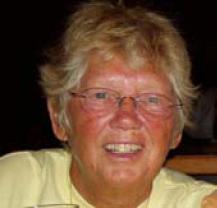 | | PHYLLIS CARTER - PLAYA DEL MAR |
After reading Phyllis Carter�s prosaic tribute to an event she characterized as �amazing�, I casually imparted her anecdote to several friends and neighbors. Universally, they smiled knowingly and agreed that �enchantment on call� was an unexpected benefit of life on the Galt Mile. I requested her permission to publish the email. Her response was couched in concern for the fate of our endangered carapace-covered neighbors. She wrote:
�It was such an event for me but old hat to many that I emailed it to on the Mile. I found it fascinating as did my family and friends up North. I am on turtle watch every morning but alas, my view is limited to our two buildings (Playa del Mar and Regency Tower � editor). I am sure that this is happening all along the coast line. Actually the eggs were laid in front of your building as the site was just past your first set of cabanas. I know they are a protected species but I�m not familiar with the laws governing them so it would be nice to mention that if you like.�
Thanks, Phyllis, I think you just did!
 Phyllis Carter is the editor of the Playa del Mar Newsletter. Along with Harriet Healy, Richard Solewin, Lance Shaw and a host of other contributing Playa del Mar residents, she created and now fuels Playa del Mar�s new vehicle for keeping her neighbors �in the know�. To view their handiwork, Click Here to see the Playa del Mar Newsletter on the Association�s web site! Phyllis Carter is the editor of the Playa del Mar Newsletter. Along with Harriet Healy, Richard Solewin, Lance Shaw and a host of other contributing Playa del Mar residents, she created and now fuels Playa del Mar�s new vehicle for keeping her neighbors �in the know�. To view their handiwork, Click Here to see the Playa del Mar Newsletter on the Association�s web site!
Click To Top of Page
Wilma Batters Broward Beaches 

Northern Beaches Slammed  Southern Beaches Skate Southern Beaches Skate
 | | OCEAN FRONT BUSINESSES SHOVEL BACK BEACH |
November 16, 2005 - The poor get poorer - the County�s most eroded shorelines lost the most beach to Wilma. Like everything else in Broward County, its beaches took a beating from Hurricane Wilma. The Broward County Beach Renourishment Project was planned around salvaging the shorelines of those communities most afflicted by tidal erosion. In keeping with the project�s priorities to address �the worst first�, the County�s devastated southern beaches were the first targets for rehabilitation. Dania, Hollywood and Hallandale Beaches were all but gone by the time that project opponents finally succumbed to public pressure and allowed the project to proceed. Segment III, ranging from the Broward/Dade county line to the John U. Lloyd Beach State Recreation area in Hollywood - just south of Port Everglades - was 90% complete by the time Wilma rolled in. The project stalled north of Franklin Street in Hollywood, near the Dania Pier. Construction of the erosion control structures at John U. Lloyd Beach State Park was scheduled to begin in November. Work on three rock groins designed to prolong the effects of the renourishment was already underway.
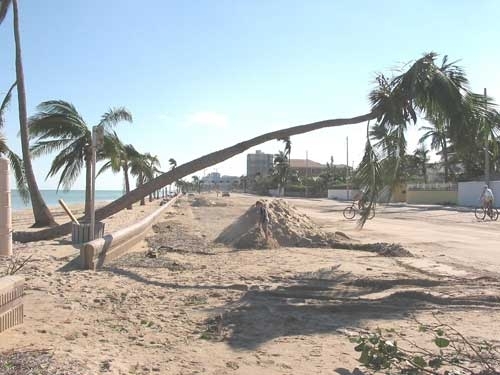 | | BEACH BLOWN OVER WAVE WALL ACROSS A1A |
The municipalities lining Broward�s southern shoreline were given new leases on life by their widened beaches. Hotels, resorts and hundreds of businesses whose lifeblood flows from the regions beaches were revived after years of an existence based on cloudy memories of when their beaches were world famous. In 2004, before the project started, each hurricane that hit Broward�s southern shore devastated the municipality behind the beach. Following Hurricane Frances, the world watched Surf Road just south of Dania Boulevard break up on television as Hollywood Mayor Mara Giulianti declared �Well, the situation is extremely dangerous because there is no beach to buffer us from the effects of the storm.� Frances also pushed all the remaining sand from Dania Beach into a parking lot across the street from the beach. 2005 was a different story. The widened beaches protected the properties and infrastructure in Dania, Hollywood and Hallandale from Katrina, Rita and now Wilma. Broward County�s beach renourishment administrator Steve Higgins said, �We really didn�t see a lot of erosion in the south end of the county.� The northern beaches weren�t as fortunate.
 | | INTERSECTION OF LAS OLAS & A1A COVERED WITH SAND |
Large stretches of the shoreline along the Segment II part of the project - Fort Lauderdale, Lauderdale-by-the-Sea, Pompano Beach and Hillsboro Beach - have experienced deterioration equal to that of the southern beaches prior to their renourishment. After Hurricane Wilma, Fort Lauderdale�s famed Ocean Highway, State Road A1A, was reminiscent of Surf Road in Hollywood after Hurricane Frances. In Deerfield Beach, Wilma blew huge segments of their beach onto and across Ocean Way, the street running along the ocean. When asked to evaluate the loss to their Beach, Deerfield�s Director of Parks and Recreation Vince Kendrick responded, �We�re trying to evaluate how much sand we�ve lost. We [bulldozed] 40 truckloads of sand over just three blocks.� Hillsboro and Pompano Beach suffered identical dilemmas. In addition to losing the sparse remnants of the north Broward coastline, exposed shorefront communities suffered heightened damage to their coastal properties and infrastructure. From Fort Lauderdale to Hillsboro Beach, the unprotected barrier island was literally covered in sand.
 | SALVAGED SAND PILED UP ALONG A1A BEING
RETURNED TO FORT LAUDERDALE BEACH |
Along the Galt Mile, sand and ocean flotsam filled swimming pools. Huge drifts covered parking decks and penetrated the lower levels in several condos. When some sixth floor Galt Ocean Club residents finally opened their balcony doors, they discovered large sand dunes covering their balcony floors. Galt Towers, Regency South, Royal Ambassador and many other Galt Mile Associations also reported large accumulations of sand covering balconies as high as the tenth floor. In the weeks following the storm, Fort Lauderdale cleanup crews removed hundreds of reconstituted sand dunes on Galt Ocean Drive and A1A. In contrast to the one-time protection provided by the Galt�s wider beach of the 1980s and early 1990s, our now-shrunken shoreline afforded a negligible cushion against Wilma�s storm surge. The two-year meteorological onslaught has whittled our beach to less than ten feet in several spots along the northern Galt Mile - at low tide. When the tide comes in, the beach disappears completely in these areas.
 | BEFORE BEACH RENOURISHMENT
WESTIN DIPLOMAT HOTEL'S BEACH |
In a monument to understatement, beach administrator Higgins described the damage to north Broward�s beaches, �Areas that were thin to start with got beaten up a little bit more. It chewed up the beaches as much as you�d expect in a serious storm.� Contrasting the damage sustained by Broward�s southern and northern beaches, Higgins said, �Beaches in Hallandale Beach, Hollywood and Dania Beach fared better because they are being widened as part of a $45 million renourishment project expected to end in January. However, wind and surf lashed sections of beach more in parts of Fort Lauderdale, Hillsboro Beach and Deerfield Beach, where erosion has eaten away the shoreline and left it more vulnerable to storms.�
 | AFTER BEACH RENOURISHMENT
WESTIN DIPLOMAT HOTEL'S BEACH |
At the May 13, 2003 Cabinet hearing that resulted in the County receiving the green light to salvage south Broward�s beaches (Segment III), opponents of the County�s Beach Restoration Project downplayed the predicted damage to properties left unprotected by tidal erosion, characterizing it as, �a scare tactic created by special interests.� Supported by federal, state and local environmental agencies, highly respected environmentalist Roy Rogers contradicted the anti-renourishment claims, stating that, �The State should anticipate billions of dollars in unnecessary incremental damage to the beaches and collateral damage to the municipalities they protect if they�re left in a critically eroded state.� Mr. Rogers has served as the Vice Chair of the Florida Audubon Society and Vice Chair of the Florida Community Trust. In addition, he�s chaired the Nature Conservancy and was the Governor�s appointee to the Environmental Regulation Committee. As if scripted in a three-act play, every word of Mr. Rogers� warning to the Cabinet came true. Although strange bedfellows, environmental experts and insurance officials agree that the projected $10 billion in Wilma-related damages would have been substantially less had the northern beaches benefited from the same protection afforded those in southern Broward.
 | FLORIDA CABINET - ATTORNEY GENERAL CHARLIE CRIST
SECRETARY OF AGRICULTURE CHARLES BRONSON
GOVERNOR JEB BUSH, CFO TOM GALLAGHER |
When environmental authorities told the Florida Cabinet that the unprotected Broward coastline from Fort Lauderdale through Hillsboro Beach invited the same catastrophic damage as the County�s southern beaches, the Cabinet agreed to extend the Project permit to include the northern coastline (Segment II). In a political compromise designed to expedite emergency renourishment of the County�s nearly non-existent southern beaches, the Cabinet agreed to an 18-month observation period following the completion of Segment III. The effects of the Segment III renourishment would be monitored to avoid �direct, secondary and long-term effects to nearshore hardbottom habitat� when renourishing the County�s northern beaches (Segment II). The Governor took note that the Army Corps of Engineers stated in their Environmental Impact Statement that the success of the project�s individual segments depended on the successful completion of the project as a whole. They warned that eliminating any part of the project would undermine the engineering basis for the project�s overall success.
 The $45 million price tag on the nearly completed Segment III project component is double projected costs. The original cost of rehabilitating the beaches in Hollywood, Hallandale Beach and Dania Beach was approximately $23 million. Certain vested interests enlisted the assistance of a few fringe environmental groups to intimidate specific Tallahassee bureaucrats. At first, they claimed to be beach residents representing the majority of people that lived along Broward�s shore. The $45 million price tag on the nearly completed Segment III project component is double projected costs. The original cost of rehabilitating the beaches in Hollywood, Hallandale Beach and Dania Beach was approximately $23 million. Certain vested interests enlisted the assistance of a few fringe environmental groups to intimidate specific Tallahassee bureaucrats. At first, they claimed to be beach residents representing the majority of people that lived along Broward�s shore.
 | REPRESENTATIVE
ELEANOR SOBEL |
This tactic backfired when thousands of barrier island residents and their municipal representatives demonstrated overwhelming support for the project. Their new tactic was simplicity itself. If they could deplete the resources earmarked for the project, they could increase the project�s burden on taxpayers, burning out public support. Despite the project�s acceptance by the mainstream environmental community as safe and �in the national interest,� opponents used the media to foment doubt about the project�s environmental safeguards. By loosing a virtual blizzard of baseless allegations, they systematically drained resources and delayed the project.
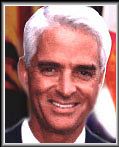 | ATTORNEY GENERAL
CHARLIE CRIST |
To fulfill his responsibility as Project coordinator and beach administrator, Steve Higgins had to scientifically discredit the continuous slew of �red herrings� drummed up by project opponents. �Somehow our project has gotten more scrutiny from agencies and activist groups than any project I�ve ever seen,� explained Mr. Higgins. Despite his having earned the backing of the environmental community, delays seemed to take on a life of their own. It wasn�t until Representative Eleanor Sobel (D-Hollywood), supported by almost every coastal municipal administration frustrated by the project�s plodding pace, asked Florida State Attorney General Charlie Crist to look into the legitimacy of the delays. Sensing that the underlying motives for their tactics were dangerously close to being uncovered, project opponents tried to elicit several questionable concessions from both State and County officials. Suspicions were aroused, for instance, when they asked the State to rezone all of Florida�s beachfront property. At the end of the day, this abuse of the system cost taxpayers $22 million extra and delayed the project for six years.
 | | BEACH FLORA ROOTS HOLD REMAINING SAND IN PLACE |
This data, however, doesn�t reflect the true cost of the politically motivated delays. According to insurance industry estimates, if the beaches in Hollywood, Hallandale Beach and Dania Beach were widened on schedule, the added protection would have spared those communities tens of millions of dollars in incremental storm damage, primarily on the barrier island. Since the original project timetable also anticipated Segment II�s completion well before 2004, the damage suffered by residents of Fort Lauderdale, Pompano Beach and Hillsboro Beach during the 2005 and 2006 hurricane seasons would have been similarly moderated. As such, the net cost of delaying the project is closer to $100 million.
We�ll soon enter the 18 month monitoring period. Some project opponents have stated that they intend to practice the same tactics when Segment II beaches become eligible for renourishment. Fort Lauderdale, Pompano Beach and Hillsboro Beach shorelines can be made whole at an estimated cost of $22 million if Segment II starts in 2008 as scheduled. That is, of course, unless Tallahassee allows the beach to again become a political football.
Click To Top of Page
County Celebrates Beach Renourishment

Grateful Pols Relieved that Delays are Over
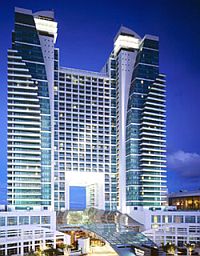 | | WESTIN DIPLOMAT RESORT & SPA |
May 9, 2005 - On May 6th, a long-awaited celebration took place in Hollywood. The immediate beneficiaries of the Broward County Shore Protection Project, the municipalities of Hollywood, Hallandale Beach and Dania Beach, joined Broward County in throwing a party to highlight the project�s commencement. The State of Florida was represented by the Department of Environmental Protection (FDEP) while the Army Corps of Engineers finally saw its six-year old environmental impact statement bear fruit. Civic and environmental groups that spent the past 5 years locked in a frustrating struggle to save Broward�s beaches also attended. A group of Galt Mile residents were invited to participate in the festivities. As much as anyone, they were responsible for the project�s implementation.
At 8:30 AM, Ocean Club President and GMCA Director Rose Guttman picked up Regency Tower residents Fern McBride, Iris and Joe Anastasi, Eric Berkowitz along with Kathy Freismuth of Regency South to arrive at the Westin Diplomat Resort at 3555 South Ocean Drive in Hollywood by 9:30. They were met at the hotel by Broward Beach Coalition Chairman and Galt Ocean Club President Pio Ieraci. Invited by County officials, the Galt Mile residents represent the nucleus of group that convinced the Florida Cabinet to include Fort Lauderdale in the critical project. The beachfront hotel was ideally suited to host this party. The 39 story, 998-room Resort & Spa is one of Starwood�s premier properties. Despite sporting an enormous list of amenities and accommodations of every stripe, the Hotel�s beach is arguably its single greatest asset. After navigating the cavernous lobby and wading through assorted media types and their equipment, a trip to the back patio revealed the reason for the hotel having been selected as the backdrop for this event, its skeletal beach. The thin strip of beach stands in stark contrast to the hotel�s impressive size and scope. The threat to Broward�s huge $billion tourism revenue engine is well represented by the imposing establishment�s bare bones beach.
|
|  | | Rose Guttman |
|  | | Pio Ieraci |
|  | | Fern McBride |
|  | | Iris Anastasi |
|  | | Joe Anastasi |
|  | | Eric Peter Berkowitz |
|
Galt Mile Representives at the Beach Project Kick-off
Not Shown - Kathy Freismuth, Not Attending - Ron Gresser
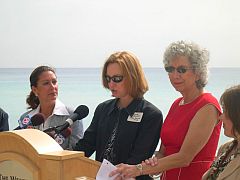 | HALLANDALE BEACH MAYOR JOY COOPER
BROWARD COUNTY MAYOR KRISTIN JACOBS
COUNTY COMMISSIONER SUE GUNZBERGER
HOLLYWOOD MAYOR MARA GIULIANTI
|
At 10 AM, Broward Mayor Kristin Jacobs stepped to the podium to initiate the proceedings. Joined by Hollywood�s District 6 County Commissioner Sue Gunzberger and officials from Hollywood, Hallandale Beach and Dania Beach, Jacobs ran through some of the obstacles that delayed the project for 5 years and effectively doubled its cost. A small group of self-serving political interests possessed of questionable environmental credentials succeeded in intimidating certain key state bureaucrats from proceeding apace with the project.  | | Colonel Robert M. Carpenter |
Jacobs imparted some of the harrowing experiences that its supporters had to endure prior to nursing the project through to its ultimately successful kick-off. Jacobs and Gunzberger described threats to the project on the local, State and national levels, including one that required the assistance of Senator Bill Nelson to successfully circumvent. They thanked Jacksonville District Commander and District Engineer Colonel Robert M. Carpenter of the U.S. Army Corps of Engineers for signing off on a final plan that was both comprehensive and protective of the environment. Jacobs gave kudos to Broward Director of Community Services Lori Flynt, Congresswoman Debbie Wasserman Schultz, Peggy Kaiser of Congressman E. Clay Shaw�s office and Jacqui Spier (standing in for Hollywood Statehouse Representative Eleanor Sobel) for playing integral parts in overcoming a plethora of obstacles.
Mayor Jacobs briefly touched on an interesting experiment that should kill two birds with one stone. When the Florida Cabinet approved the project permit in 2003, Florida CFO Tom Gallagher inquired about alternative sources of sand, either imported or manufactured. Broward County officials promised to investigate and test alternatives to incrementally depleting existing offshore borrow sites. Inasmuch, Jacobs described a combination of sand and glass, a mixture of silicas, that will be used to stretch renourishment resources. Discarded bottles that represent a disposal nightmare are ground to smooth sand-sized grains and used to dilute the astronomically expensive sand. A successful experiment demonstrated that people and Sea Turtles couldn�t distinguish between the pulverized Miller bottles and the $10 - $25 per cubic yard genuine article. Shells, coral and other silicates erode into the calcium carbonate sand that covers our beaches. Glass is made of sand, soda ash, limestone and other ingredients that are heated, melted, shaped and, if desired, colored. To replicate sand, different colored bottles could be blended into something close to the tan of South Florida sand and ground to an exact grain size.
 | | Sea Turtles OK with Glass Sand |
Last year, Beach Administrator Steve Higgins explained, �It provides a green solution to the disposal of what might otherwise be a waste product and it provides for the sustainability of our beaches, which is an important piece of our economic and environmental infrastructure. We think it�s possible, and we think the material that results will be practically indistinguishable from beach sand.� More importantly, a key adjunct to the renourishment project is the ongoing replacement of lost sand at certain critical areas, obviating the need to repeat another full scale renourishment in a decade. Fulfilling the Cabinet mandate, ground glass provides the sustainable resource without further depleting existing �borrow areas�. �It�s a serious problem,� Higgins said. �We�re going to have to maintain that beach. We can�t let it go critical like it has in the past. To do that, we�re going to have to place sand at various places along the beach on a fairly frequent basis.� Broward County recycling coordinator Peter Foye confirmed that the 13,000 tons of recyclable bottles generated annually wouldn't be adequate for a full scale renourishment. However, it would be perfect for emergency beach repairs resulting from storm damage or to provide continual small scale replacement at bypass areas.
 | HOLLYWOOD MAYOR MARA GIULIANTI
BROWARD COUNTY MAYOR KRISTIN JACOBS
COUNTY COMMISSIONER SUE GUNZBERGER
HALLANDALE BEACH MAYOR JOY COOPER
AND DANIA BEACH VICE MAYOR PAT FLURY |
Dania Beach�s Vice Mayor Pat Flury stated that she was, �excited and grateful for the renourishment of the County�s beaches.� Hallandale Beach Mayor Joy Cooper - whose town�s beaches are scheduled to receive the first renourishment - was accompanied by Vice Mayor William Julian, Commissioners Joe Gibbons, Dorothy Ross and Francine Schiller, the city�s Chief of Police and the head of the Parks Department. Obviously delighted that Hallandale's beaches will again be adequately enlarged for residents and visitors, she expressed relief that the project was finally underway. Hollywood Mayor Mara Giulianti, in addition to thanking Senator Nelson and Representative Sobel, paid a compliment to State Senator Steven Geller for helping to get the project moving. Referring to the televised news reports during Hurricanes Frances and Ivan in which she stood on the beach while huge chunks of Surf Avenue floated by behind her, Giulianti described the ordeal that Broward shoreline municipalities underwent as a �Hurricane Reality Show�. A channel 10 news clip of the Mayor exclaiming, �Well, the situation is extremely dangerous because there is no beach to buffer us from the effects of the storm,� apparently was viewed in Tallahassee. The next day, Governor Bush repeated the Mayor�s desperate call to action. Not surprisingly, the project suddenly grew legs. All three Mayors pledged to support an impending bypass project which will help preserve the County�s beaches. The project will allow the sand to move down the coast instead of losing it out to sea through tidal erosion.
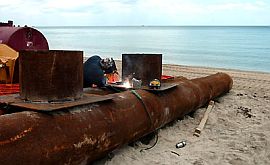 | | Worker welding 30-inch Pipe to Carry Sand to Beach |
The southern part of the project, Segment III, will renourish 6.2 miles of Broward County�s shoreline, from the Broward County line in Hallandale Beach to the John U. Lloyd Beach State Recreation area in Hollywood, just south of Port Everglades. It involves the placement of approximately 1.7 million cubic yards of sand on South Broward�s eroded beaches in Hallandale Beach, Hollywood and Dania Beach, widening their current width by up to 200 feet. Sand extracted by Hopper Dredges from North Broward borrow sites in Deerfield and Hillsboro is transported to pumpout moorings in south Hallandale which pump the sand through 30-inch pipes to the beach.  | | REMNANT OF WESTIN DIPLOMAT'S BEACH |
The project will quickly move north in 300-foot increments of shoreline until Sea Turtle Nesting Season, after which it will continue north to John U. Lloyd Beach State Recreation area. To avoid damaging coral reefs and other marine resources, the dredges will be constantly monitored as they follow designated corridors. To �lock-in� the sand and slow future erosion along the southern part of the project, a spur will be installed on the south jetty of the Port Everglades inlet and 2 T-head groins will be constructed at the northern end of the John U. Lloyd State Park beach. Segment III will be completed either by October 2005 or February 2006, depending on the speed with which the project moves north and when it is interrupted by Sea Turtle Nesting Season. Once complete, an 18-month monitoring period to evaluate the project�s impact on the marine environment will begin. If Segment III cannot be completed before Sea Turtle Nesting Season, the 18 month clock won�t start ticking until after its resumption and final completion in February. Pending a clean bill of health from marine and coastal ecology experts at Nova Southeastern University, the beaches in Fort Lauderdale and nearly non-existent beaches in adjacent communities to the north (Segment II) - such as the Galt Ocean Mile - will finally be renourished in late 2007 or early 2008.
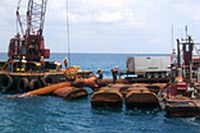 | | 2000 Feet of 30-Inch Pipe is Connected |
Also at the celebration was the County official responsible for most of the project�s heavy lifting, Steven Higgins. As Administrator of the Biological Resources Division of the Broward County Environmental Protection Department(EPD), Higgins started the ball rolling more than six years ago upon learning that the Florida Department of Environmental Protection considered Broward�s beaches to be �critically eroded�. Citing the dangers to people and property, Higgins contacted the Army Corps of Engineers to compose the �Broward County Shore Preservation Project�. He clearly demonstrated the economic dangers attendant to the beach erosion. The impending disappearance of world famous South Florida beaches would undermine the County�s (and the State�s) tax base. South Florida�s huge tourism industry and protection for billions of dollars in property value is contingent on the health of its beaches. After creating a viable plan to save the County�s beaches while protecting the environment, Higgins ran into a political minefield designed to sabotage the project.
Beach Administrator Higgins acknowledged that it was important to accommodate legitimate environmental concerns. Higgins addressed hundreds of environmental issues as framed by dozens of mainstream Environmental Agencies and groups. His Division has developed a mountain of authoritative scientific data, mitigation plans and redundant safeguards in support of the project�s successful outcome. Unfortunately, he has also had to respond to capricious requests designed only to delay the project and drain precious resources. Self-appointed �protectors of the environment� crawled out of the woodwork, intimating that the project would wreak havoc on the environment. Skittish politicians had official agencies look into the claims, all of which were addressed in detail. Higgins characterized his frustration at having been made to wade through this bureaucratic swamp by stating, �Somehow our project has gotten more scrutiny from agencies and activist groups than any project I�ve ever seen.� Despite the statement by every mainstream Environmental agency that delaying the project was the real threat to the environment, Tallahassee fell into a dilatory trance.
 | HOUSE SPEAKER ALAN BENSE, SENATE
PRESIDENT TOM LEE & GOVERNOR JEB BUSH
CONVENE SPECIAL SESSION IN TALLAHASSEE |
By July of 2004, the delays became so overtly political that Hollywood Statehouse Representative Eleanor Sobel asked Florida Attorney General Charlie Crist to investigate their source and intent. �It seems like it has been an issue for quite some time,� said Crist, �We�re just looking into the whole issue, and the delays; we�re going to see what�s going on.� While the spurious claims seemed to dissipate, the State continued its �sleepy� progress despite the County�s cry for help. Hurricane Frances was their �wake-up call�.  | | Mayor Giulianti |
As depicted by Hollywood Mayor Mara Giulianti, watching the ocean claim large sections of South Florida real estate on the nightly news while listening to reporters describe the danger to barrier island voters unnerved State officials. Governor Bush, Senate President Tom Lee and House Speaker Alan Bense called for a special session of the legislature to address Hurricane matters. State officials expeditiously compiled the 2004 Hurricane Recovery Plan for Florida�s Beach and Dune System. Although it acknowledges that Segment III should address the problems facing South Broward beaches, it recommends additional funds for the pre-Segment II monitoring effort and the subsequent Segment II (Fort Lauderdale) permit costs. State policy clearly conceded that the impact of coastal damage is directly connected to the health of the area�s protective beaches. The political see-saw again tilted in favor of rapid renourishment.
 | GMCA PRESIDENTS COUNCIL CHAIR PIO IERACI
CREDITS SUCCESSFUL COMMUNITY EFFORT
Broward County Commissioner SUE GUNZBERGER
Broward County Mayor KRISTIN JACOBS and
Hollywood Mayor MARA GIULIANTI |
 | Crist, Bronsen, Bush, Gallagher
THE FLORIDA CABINET |
Mayor Jacobs introduced Pio Ieraci, Chairman of the Galt Mile Community Association Presidents Council and the Broward Beach Coalition, who blamed the unnecessary doubling of project costs on the shadowy political coalition that haunted Mr. Higgins. In early 2002, neighborhood residents were invited to attend a public hearing to elicit their true feelings about losing their beach. Over a hundred Galt Mile residents attended the hearing at the Hollywood Beach Community Center to offset the false claim by a group of anti-beach vested interests that they �spoke for area residents.� While the event clarified that local support for the project was overwhelming, anti-beach proponents continued to exert pressure on state officials in Tallahassee to block participation by Fort Lauderdale in Segment II. In response to concerns by Broward officials about the anti-beach group again misrepresenting themselves as �community spokespersons�, a group of Galt Mile residents flew to Tallahassee in support of Fort Lauderdale�s inclusion into the overall project. Donned in red t-shirts displaying, �Save Broward Beaches� while addressing the Governor and the Cabinet, the group gave lie to the assertion that area residents opposed the project. On May 13, 2003, a vote by the Florida Cabinet to permit the Segment II (Fort Lauderdale) part of the plan following an 18-month �monitoring period� put the project back on track. Ieraci pointed out that �without the participation of these residents, the County�s effort would have been unrequited and futile.�
 | | 30-Inch Pipe Set to Carry Sand to Beach |
Mayor Jacobs thanked Project Manager Jackie Larson from the Beach and Ecosystem Management Section of FDEP�s Beach Erosion Control Program (BECP) and Florida Atlantic University for its watershed study of The Impact of Beach Restoration on the Economics of Florida Beaches. Broward�s Mayor finally announced that the pumpout moorings would be in place and ready to start feeding sand to the beach on May 7th, the next day. In a discussion with area residents, Steve Higgins confirmed that the first sand was scheduled to be pumped onto the hotel�s beach within a few days. When asked about the 18 month monitoring period that Fort Lauderdale�s barrier island residents would have to endure before being eligible for the protective renourishment, Higgins stated that he thought it was excessive. If the experts at Nova Southeastern University and the County can agree on an expedited review period without sacrificing diligent oversight, Galt Mile residents may dodge the complete elimination of their disappearing beach if hit by another 4-hurricane bullet. Alexander Dumas may have had a project like this in mind when he stated, �All human wisdom is summed up in two words - wait and hope.�
Higgins conveyed that Broward County set up a special web site to keep the community posted on the project�s progress. The site explains the technology behind the construction in �user-friendly� lay terminology, easily understandable by the average resident. The municipalities whose beaches are being salvaged naturally installed links from their official web sites to the Broward Beach renourishment page. The official Broward Beach renourishment site offers an up to the minute Weekly Update. An Online Beach Renourishment Brochure is a pictorial essay that was published by Broward County to explain the project to its residents. A Segment III Beach Renourishment Plan Map lays out the southern part of the project. The coolest part of the site is undoubtedly the access it provides to a live beachcam. The camera is mounted atop the Westin Diplomat Resort facing the beach to capture a current picture of the beach as it is rehabilitated. Residents who have been put through an emotional wringer awaiting the project start will stare at the pictures in disbelief. IT IS ACTUALLY HAPPENING! Check it out for yourself!
 Many thanks to Broward County photographer Scott Medvin for sending us copies of the pictures he took of the event. Many thanks to Broward County photographer Scott Medvin for sending us copies of the pictures he took of the event.
Click To Top of Page
South Broward Beaches to Soon See Sand

Hollywood and Hallandale Await Project Start
 | | BROWARD MAYOR KRISTIN JACOBS |
February 8, 2005 - �No one likes to see a project needed so much as this one delayed, but the delay has allowed us to address comprehensively the environmental issues.� Broward County Mayor Kristin Jacobs, whose one-year mayoral term she characterizes as �The Year of the Environment�, offered the statement as magnanimous punctuation to the end of a five-year exercise in delay, distortion and political maneuvering. The Broward County Shore Preservation Project is about to be implemented after a prolonged period of procrastination angst suffered by Beach communities along Broward�s critically eroded shoreline. Every required Federal, State and local permit has been obtained, a stringent environmental protection plan is in place and beachfront communities are relieved that the dilatory approval process is finally completed.
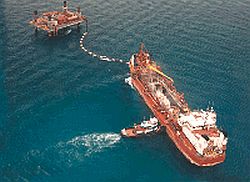 | | TRAILING SUCTION HOPPER DREDGE |
Broward County inked a $23 million deal with Great Lakes Dredge and Dock Co., the lowest of three bidders, to serve as the lead contractor for the long awaited beach renourishment project. Attention will first be paid to rehabilitating the meager remnant of beach in John U. Lloyd State Park and the fully eroded beaches outside the high-rises of Hallandale Beach and southern Hollywood. The Segment III section of the project, ranging from John U. Lloyd Beach State Recreation area for 6 miles through Dania, Hollywood Beach, and Hallandale Beach to the county line, is slated to receive 50 to 250 feet of new sand. The 1.5 million cubic yards of sand will be dredged from the Segment I part of the project - five offshore deposit sites along Deerfield Beach. Trailing suction hopper dredges will mine the sand which will then be hauled south and discharged through pipelines to the target beaches. Work is expected to start in April, following a 60-day review and mobilization period.
 | | GREAT LAKES DREDGE AT FIRE ISLAND |
Broward�s beach erosion administrator, Steve Higgins, supports the selection of Great Lakes owing to the company�s extensive world-wide experience as well as its familiarity with local factors learned during two previous Broward beach renourishments. They maintain the largest fleet of diversified beach restoration equipment in the United States. Owned by Vectura Holding Company LLC, a CitiCorp venture capital unit, Great Lakes is headquartered in suburban Chicago at Oak Brook, Illinois. Their domestic projects include Atlantic City Beach, Rockaway Beach, Fire Island (Gilgo Beach), Hilton Head, Captiva Island Beach, Venice Beach, San Diego Beaches, Dade County/Miami Beaches, Jupiter Island, Palm Beach, Boca Raton, Sanibel Island, Myrtle Beaches, Virginia Beach and dozens of others.  | | �RESUND FIXED LINK - MAN-MADE ISLAND |
They also deepened Boston Harbor, expanded Freeport Harbor, deepened San Juan Harbor, built the Marina Basin at the Doha Four Seasons Hotel in Qatar, rebuilt the berths in the Port of Oakland, built an island in the Baltic Sea (�resund Fixed Link) for the bridge and tunnel connecting Sweden and Denmark and recently completed the largest dredging and landfill project in America - the Pier 400 Dredging and Landfill Program in the Port of Los Angeles. Critics accurately point out that they�ve committed several gaffes while compiling their substantial references. In a �Captain Queeg-like� maneuver, they unwittingly dragged some dredge pipes across the seagrass in the Florida Keys National Marine Sanctuary. As beach preservation technology progressed, every company in the industry underwent a �learning curve�, as did the Army Corps of Engineers. Higgins noted that project safeguards inherent in the upcoming beach renourishment were specifically designed to avoid past mishaps. The protections were required by the dozens of Environmental agencies and groups that ultimately gave Broward�s project the green light.
 | | Mayor Giulianti |
Officials of the Segment III municipalities whose beaches are first in line for restoration have been holding their breath for five years as the project experienced delays resulting from the most intense scrutiny in the history of beach preservation projects. Mayor Mara Giulianti of Hollywood and Mayor Joy Cooper of Hallandale Beach are breathing a collective sigh of relief now that the beaches central to the lives and livelihoods of their residents will finally be reincarnated.  | | MAYOR JOY COOPER |
Along much of their neighboring shorelines, the ocean currently slaps against seawalls where some of the nation�s finest beaches used to attract millions of visitors. The return of their beaches is a welcome reprieve to these and other beach communities such as Dania. During the hyperactive hurricane season, the tiny remnant of Dania�s beach was unceremoniously dumped into an adjacent parking lot. Serendipitously, devastation experienced by beachfront communities during the season�s four-hurricane onslaught drew heightened concern from Tallahassee. The prospect of significant property damage and loss of life evolved from heated political �spin� into cold reality. A healthy beach is the only natural protection from serious weather events for coastal neighborhoods. As nightly media coverage of Florida�s coastal hurricane damage received national attention, bureaucratic foot dragging in Tallahassee slammed to a halt. Hallandale Beach Mayor Joy Cooper reflected the sentiments of area residents when stating, �All I can do is breathe a big sigh of relief. This puts the beach back in Hallandale Beach.�
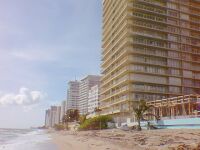 | | SHRINKING GALT MILE BEACH |
Broward�s remaining critically eroded beaches (Pompano, Lauderdale-by-the-Sea and Fort Lauderdale) have been mandated to await completion of the southern project segment before being eligible for badly needed restoration. The Broward County Department of Environmental Protection and the Army Corps of Engineers agree that the project�s ultimate success is contingent on the problem being addressed as a whole. The project is divided into �Segments� that support one another from an engineering standpoint. As each segment contributes to the overall stability of the shoreline, a positive result depends upon the segments being accomplished in concert. There are two reasons for the project�s segmentation - one practical and one political. Each step of the actual construction is structurally dependent upon the adequate completion of the previous step. Since construction errors carry an environmental price, scrupulous care and oversight are vested in Great Lakes� contractual responsibilities. The project�s progress - the construction timetable, is therefore parsed by these segments.
 | | CHAIRMAN PIO IERACI |
The political rationale for segmenting the effort is to accommodate a compromise implemented to expedite the project. Despite the overwhelming need for salvaging South Florida�s beaches, certain political interests have consistently attempted to delay or derail Broward�s beach project long after its acceptance by the mainstream environmental community as safe and �in the national interest.� To politically clear the way for starting construction, the State agreed to an 18 month questionably useful �observation period� to assess direct, secondary and long-term effects to nearshore hardbottom habitat associated with the project. Based upon the monitoring of these areas in Segment III, FDEP (Florida Department of Environmental Protection) would determine the likelihood for adverse impacts to the similar areas in Segment II (Pompano, Lauderdale-by-the-Sea and Fort Lauderdale), and recommend possible modifications and/or conditions to avoid or minimize impacts. However, the vast majority of gleaned data will be obvious within several months of Segment III�s completion. Many environmentalists feel that while a monitoring period will protect project integrity, an 18 month long delay is excessive. Pompano and Fort Lauderdale officials and civic leaders are concerned that the �monitoring period� could evolve into a political football, affording project opponents the opportunity to again burden the beach renourishment with dangerous and expensive delays (so far � original $26 million jumped to $41 million for Segment III, $30 million ballooned to $58 million for the overall project). Broward Beach Coalition Chair Pio Ieraci exhorted, �While the political interests that delayed the project for years have publicly exclaimed that they now favor saving the area�s beaches, we need to be vigilant in preventing the same scare tactics that added millions to project costs.� Ieraci continued, �Fort Lauderdale and Pompano are dependent on their beaches for survival. There�s too much at stake to permit a repeat of politically motivated irresponsible and dangerous delays.� We agree.
Click To Top of Page
Where�s the Beach 

Hurricane Frances Carries a Warning
 | | Mayor Giulianti |
Hollywood Mayor Mara Giulianti, comporting herself as a sensitively empathetic municipal guardian during a real life natural disaster, responded succinctly to her interviewer from channel 10, �Well, the situation is extremely dangerous because there is no beach to buffer us from the effects of the storm.� POINT TAKEN! Hurricane Frances was skirting its North Palm Beach landfall at about 4:30 PM Saturday afternoon as her live interview hit the air. The cameras caught sections of Surf Road just south of Dania Boulevard actually dissolving during the Mayor�s evaluation of the damages suffered along the vulnerable beach. The beaches in Hollywood disappeared several years ago, the victim of sustained tidal erosion. The condition is mirrored up and down the East Coast of Broward, as 21 of the 24 miles of the County�s beaches are critically eroded. In 1999, Broward County put the recovery process into motion, hoping to repair the deteriorating shoreline within the two - three year window that a safe, responsible beach renourishment would normally take. Every major environmental agency and organization took the opportunity to institute extensive protective measures and exigent monitoring requirements as the Broward County Department of Planning and Environmental Protection (DPEP), Biological Resources Division carefully steered the plan through its statutory paces in an effort to rescue the beach.
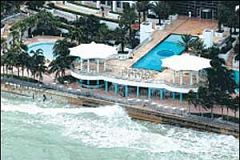 | Frances Pounding beachless sea wall of
Westin Diplomat Resort in Hollywood |
Despite receiving a positive General Reevaluation Report (GRR) and Final Environmental Impact Statement (FEIS) from the Army Corps of Engineers, the Joint Coastal Permits for Segment III (Hollywood) and Segment II (Fort Lauderdale) from the Florida Department of Environmental Protection and achieving complete conformity with the protective requirements stipulated by a veritable gauntlet of environmental agencies and interest groups, the plan�s dilatory pace has drawn the ire of thousands of heretofore patient residents of the Barrier Island. For years, County and City officials of beachfront communities have warned of the dangers inherent in the exposed, beachless shoreline. The beach not only protects people from the severity of hurricane events, it buffers $billions in upland property from the full catastrophic impact of �drop-ins� like Frances. Watching city crews using front loaders to relocate tons of displaced sand back to the paper thin beach reinforced Mayor Giulianti�s disappointment and impatience with the sluggish plodding progress suffered by the renourishment effort. �It's your first line of defense, It is vital that it is there.� Giulianti remarked.
Broward County�s beach erosion administrator, Steve Higgins, characterized the loss of beachfront as �potentially dangerous�. Higgins elaborated, �As you lose beach, you lose future storm protection, and you lose the recreational opportunities for visitors,� referring to the basis for Broward�s tourism tax base. �As the beach disappears you�re exposing property to damage, and there is about four billion dollars worth of property that could be vulnerable.� The fact that you may not own any of that property is irrelevant, we will all have to pay for it if damaged - the public portion in our taxes, the privately owned assets in our insurance premiums...which will skyrocket! As of Saturday, September 4th, it would be appropriate to add the cost of rehabilitating Surf Road to that figure. As Mayor Giulianti intimated, what�s next?
 | Sand & Debris in John U Lloyd Beach State Park
AFTER HURRICANE FRANCES |
Two days later (Monday, September 6th), Higgins toured the overall damage to the County�s shoreline. North Broward took the worst hit owing to Frances� nearby Palm Beach landfall. In Deerfield Beach, beach-stabilizing rock piles that are usually covered were completely exposed. Sand stripped from John U. Lloyd Beach State Park and Fort Lauderdale Beach was painstakingly collected from both sides of A1A using front-loading bobcats and deposited back to the now smaller beaches. Bob Fortier of the Fort Lauderdale Parks Department evaluated Frances� toll on the beach, �It�s terrible, we�ve lost 40 feet of shoreline, easy.� Fort Lauderdale Mayor Jim Naugle expressed a desire to expand the beach North of Sunrise Boulevard and add dunes. Fort Lauderdale is scheduled for beach renourishment in the second phase of the County�s renourishment project, after the desolated Hollywood beaches are revived. The majority of Dania�s Beach wound up in the adjacent parking lot - closing access for weeks.  | Sand that Frances Piled up on A1A Being Returned to
FORT LAUDERDALE BEACH |
Dania Beach City Manager Ivan Pato admonished, �There is hardly any beach left.� Higgins described Hallandale Beach as, �lower than it was and probably a little skinnier, too, but mostly lower�. Hallandale Beach City Manager Mike Good added, �The beach is usable but there are limited areas with sand.� At Hollywood Beach, which at high tide is devoid of sand, the sea walls took the full brunt of the hurricane�s storm surge. Hollywood residents watched the ocean wash over the Broadwalk and Surf Road all the way to A1A. In evaluating the Hurricane�s county-wide shoreline impact, Higgins said, �It was significant damage - but not surprising for the event. It underscores the need to keep a healthy beach because as you lose beach, you lose protection against future storms.�
The County�s rescue effort is slated for a November start date. Prior to that it was scheduled to start in July - and before that... May. Broward residents and local officials have good cause for exhibiting what has developed into a borderline paranoia regarding the County beaches� life expectancy. The project was originally expected to begin years ago. Despite the critical importance of the beach to Broward�s (and Florida�s) economy as well as playing a central role in every Broward resident�s (and millions of visiting tourists�) lifestyle, certain officials have chosen to pander to special interests whose stated intention was to delay, and hopefully derail, the rescue effort. The initial delays stemmed from what appeared to be environmental concerns. Although the County meticulously addressed every outstanding environmental issue to the satisfaction of every major environmental agency, the delays persisted. As it became clear that certain bureaucrats were playing politics with the County�s and the State�s well being, angry residents and their local representatives asked Florida Attorney General Charlie Crist to look into the chronic procrastination. The Attorney General�s stated intention to verify the legitimacy of the delays seems to have helped affirm the November start date.
Hurricane Frances crystallized the issue, offering a frighteningly graphic demonstration of the dangers that coastal communities confront when unprotected by a buffering beach. What little protection existed before Frances is now a memory. Years of unnecessary delays to Broward�s renourishment project have come home to roost! Without the beach to �run interference� against malevolent weather events, the potential for visitors like �Ivan� to be reclassified from �dangerous� to �lethal� increases exponentially.
Addressing the urgency to begin renourishment, Beach Erosion Administrator Higgins explained that the beach is the only protection for people, condominiums, businesses, roads and homes during a catastrophic weather event. Broward Beach Coalition spokesperson William Colletti echoed Higgins� concern. �This should be a wake-up call to federal regulators that beach renourishment is critical.� The Coalition, chaired by Galt Mile Community Association Presidents Council Chairman Pio Ieraci, is comprised of residents, businesses, employees, civic associations, government and environmentalists with a stake in preserving Broward�s beaches. Its membership includes residential and commercial property owners whose homes and livelihoods are at high risk from storm surge in addition to wind and rain every hurricane season. Frustrated by the frivolous delays to the beach restoration, Colletti exhorted, �We shouldn�t have to wait for evacuation routes to be eroded, hotels and people�s homes to fall into the ocean and for there to be no beach for turtles to nest on.� Speaking to the dangerous delays, Mayor Giulianti emphasized, �We have to have all of this done before next hurricane season,� adding optimistically, �which obviously it will be.� We hope she�s right!

Click on Graphic to View Full Size Plates for Segment II
Plates 6 & 7 Represent the Galt Ocean Mile

 | | GALT OCEAN MILE - PROJECTED CONSTRUCTION FOR SEGMENT II OF THE BROWARD BEACH RENOURISHMENT PROJECT |
Click To Top of Page
Delays and �Poison Pill� Bill
Plague Beach Project

 Broward Finally Secures Permit Broward Finally Secures Permit 
 The Broward County Department of Planning & Environmental Protection (DPEP) spent 5 years addressing the concerns of legitimate environmental groups as a statutory precursor to renourishing our disappearing Broward County beaches. Stephen Higgins, the Beach Erosion Administrator for the DPEP�s Biological Resources Division and the county�s beach renourishment director, ascribed the extensive delays to the inordinate amount of attention given the project by Federal and State Authorities. Despite widespread acceptance of the project by every major environmental group owing to Mr. Higgins� diligence in addressing virtually all of their concerns, certain fringe elements continue their commitment to derailing the project. They have a history of making completely irrelevant and unrealistic demands on Project Coordinators, such as their insistence that Florida beaches be completely rezoned prior to saving the beaches. By delaying the project through a continuous spate of frivolous demands, they can escalate the costs. �Somehow our project has gotten more scrutiny from agencies and activist groups than any project I�ve ever seen,� explained Mr. Higgins. Total project costs have almost doubled from $30 million to $59 million, in large part from unnecessary delays. The Broward County Department of Planning & Environmental Protection (DPEP) spent 5 years addressing the concerns of legitimate environmental groups as a statutory precursor to renourishing our disappearing Broward County beaches. Stephen Higgins, the Beach Erosion Administrator for the DPEP�s Biological Resources Division and the county�s beach renourishment director, ascribed the extensive delays to the inordinate amount of attention given the project by Federal and State Authorities. Despite widespread acceptance of the project by every major environmental group owing to Mr. Higgins� diligence in addressing virtually all of their concerns, certain fringe elements continue their commitment to derailing the project. They have a history of making completely irrelevant and unrealistic demands on Project Coordinators, such as their insistence that Florida beaches be completely rezoned prior to saving the beaches. By delaying the project through a continuous spate of frivolous demands, they can escalate the costs. �Somehow our project has gotten more scrutiny from agencies and activist groups than any project I�ve ever seen,� explained Mr. Higgins. Total project costs have almost doubled from $30 million to $59 million, in large part from unnecessary delays.
 | REPRESENTATIVE
ELEANOR SOBEL |
The latest delay resulted in the postponement of the July 1st start date for the restoration of the nearly non-existent Hollywood beaches. Angry residents and local officials are demanding an end to these capricious delays.  | ATTORNEY GENERAL
CHARLIE CRIST |
State Representative Eleanor Sobel (D-Hollywood), frustrated by the project�s plodding pace, asked Florida State Attorney General Charlie Crist to look into the legitimacy of the delays. He agreed, stating �It seems like it has been an issue for quite some time.� Joann Carrin, spokeswoman for Attorney General Crist, elaborated, �We�re just looking into the whole issue, and the delays; we�re going to see what's going on.� The underlying reasons for the beach renourishment are both safety-related and financial. Broward�s share of Florida�s $15 billion beach industry is $600 million. The beach also protects billions of dollars worth of property and tens of thousands of lives exposed to severe storm event damages. Stringing out the project leaves residents and property at risk, skyrockets the cost and undermines the tourism-driven local economy.
 | BRIGADIER GENERAL
RANDAL R. CASTRO |
On May 13th, exactly one year since Governor Bush and the Cabinet (including Attorney General Crist) voted unanimously to approve Broward County�s permit request for the entire project, we were notified by the Broward County Department of Planning and Environmental Protection that the Record of Decision (ROD) was received from Brigadier General Randal R. Castro, South Atlantic Division Commander of the Army Corps of Engineers.  | | COLONEL JAMES G. MAY |
In the Record of Decision (ROD) - the formal endorsement of the project by the Corps as having complied with every statute and concern raised by legitimate environmental authorities - he states, �I find that the plan recommended in the GRR (General Reevaluation Report) and FEIS (Final Environmental Impact Statement) by the District Engineer, Jacksonville District, U.S. Army Corps of Engineers (Corps), is economically justified, technically feasible, in compliance with environmental statutes, and in the overall public interest.� The Corps also asked that 52 additional concerns be addressed. They were.
This heightened focus on project delays seems to have been just what the doctor ordered; the final permit to proceed was received by the DPEP on July 19th. Once the permit is executed by Broward County and Colonel James G. May, the Commander and District Engineer of the Corps� Jacksonville District, the County can begin the bidding process for contractors, hopefully providing for a November project start date.
 Booby Trapped Beach Bill Booby Trapped Beach Bill 
A serious problem has surfaced in the United States Senate. It appears that we may have to repeat the entire approval process... from scratch. The Senate Environment and Public Works Committee buried a �poison pill� into a bill labeled the �Water Resources Development Act� (WRDA), S.2554. Section 3301 mandates a rewrite of the Army Corps of Engineers policy and guidance that imposes another bureaucratic layer of restrictions on beach nourishment. Without any public testimony or hearings on the issue, a proposed �Beach Nourishment Advisory Committee� would be created to oversee beach projects. This new committee would create an additional layer of reviews and regulations, adding to the time and cost of each and every project. Beach projects are the ONLY projects specifically targeted in the bill for this type of micro-management by the federal government. Incomprehensibly, the language used in the legislation was submitted by an organization that is fanatically opposed to beach nourishment.
 | | SENATE ENVIRONMENT AND PUBLIC WORKS COMMITTEE |
The �Beach Nourishment Advisory Committee� would enforce 10 specific revisions to the planning requirements imposed on the Army Corps of Engineers� only with regard to beach projects. Since every requirement is already enumerated in existing legislation, the need for another repetitive layer of governmental regulation is unclear. In addition, the committee will attempt to apply a standardized one-size-fits-all approach to many site- or state- specific conditions. For instance, Requirement #4 states that the Committee shall, �establish standards that ensure that sand deposited on replenished beaches features compatible grain size, shell content, and other geological characteristics of a natural beach�. Since every beach is different, the committee�s ultimate determination of what constitutes the generically correct grain size and shell content of a �natural beach� will be virtually useless. Site-specific considerations determine what sand characteristics are �compatible� from engineering and environmental perspectives. That decision needs to be made locally, on a beach by beach basis. This attempt to generalize standards (make the foot fit the shoe) is thematic in this legislation.
The American Shore and Beach Preservation Association (ASBPA), a longtime advocate of the nation�s beaches, has created a Position Paper on the proposed Beach Nourishment Advisory Committee that details the rationale for opposing its enactment. Most responsible beach communities would welcome a revision of the Corps� policies and procedures in order to
- streamline the project planning process;
- reduce unnecessary planning costs;
- promote regional and/or programmatic planning where appropriate; and
- assure that any short- and long-term environmental impacts of beach nourishment projects are benign.
 the �poison pill� that was unceremoniously dumped into the Senate�s WRDA bill, however, accomplishes NONE of these objectives. the �poison pill� that was unceremoniously dumped into the Senate�s WRDA bill, however, accomplishes NONE of these objectives.
Positioned in Senate Bill S.2554 under Title III�Flood and Coastal Storm Damage Reduction, Subtitle B--Coastal Storm Damage Reduction, Section 3301�Shore Protection and Beach Renourishment Projects, the section�s specific provisions are drawn from anecdotal �evidence� which ignores that the Corps already addresses each of the concerns raised in this provision. Without any public testimony, discussion, or any evidence of need, the legislation establishes an advisory committee that will not advise, but rather enforce the redundant requirements in 10 specific areas that are already addressed in existing legislation. In addition to lacking a provision to finance the costs of this committee (another visit to Unfunded Mandate-ville), the decisions of the advisory committee would apply to all existing draft feasibility studies and draft re-evaluation reports that have not yet been issued. This means that studies that have been produced under one set of procedures over a period of several years will have to be redone with the revised regulations, guidelines, and circulars. This retroactive application could effectively double feasibility costs and timetables for all existing projects. Nothing in the provision requires that advisory committee members have water resources planning expertise, nor does the provision include a representative of the Corps of Engineers. Should the unamended legislation be enacted, the cost of beach projects would increase substantially as will their impending timetables due to the responsible lead agencies having to slug their way through another unnecessary layer of redundant governmental regulations.
Please Take a Moment to Avoid a Nightmare
 | | Senator Bob Graham |
 | | Senator William Nelson |
The overt inadequacies and the surprise addition of this unsupported provision becloud the intentions of the Senators that allowed its inclusion. Motives aside, the American Shore and Beach Preservation Association (ASBPA) and the Florida Shore & Beach Preservation Association (FSBPA) strongly advocate that the establishment of a beach nourishment advisory committee is NOT the appropriate tactic to resolve concerns with the existing process and urge that it be removed from the bill prior to Senate passage.
The Galt Mile Community Association agrees and asks each of its members to contact their Senators and urge the removal of this section from the bill. The idea of re-experiencing the past 5 years of scrupulously performed feasibility studies to accommodate a suspicious and poorly conceived legislative midnight surprise passes from the ridiculous to the sublime. Please contact Senators Graham and Nelson by email and telephone to let them know that the WRDA bill must be improved through the removal of Section 3301 (Click and Scroll Down to 3301). (Senator Graham, incidentally, is a member of the Senate Environment and Public Works Committee.) As conscientious Florida officials, they are keenly aware of the importance of maintaining the beaches that underwrite our economy. If they receive a reasonable indication of our concerns, they will fight to excise this �Poison Pill�.
- Click Here to send an email to Senator Graham. Please follow-up with a phone call to Graham�s office: Bob Dobek with Senator Graham (202) 224-3041 - Local Tel # is: (305) 536-7293.
- Click Here to send an email to Senator Nelson. Please follow-up with a phone call to Nelson�s office: (202) 224-5274 - Local Tel # is: (305) 536-5999, 1 (888) 671-4091.
The Easy Way 
 If you don't have the time or inclination to compose an email, you can send one that has already been composed for this purpose! Using this contact will send emails to Senator Graham and Senator Nelson with one click. If you don't have the time or inclination to compose an email, you can send one that has already been composed for this purpose! Using this contact will send emails to Senator Graham and Senator Nelson with one click.
- Simply Click Here if you live on the Galt Mile (in the 33308 ZIP code).
- If you live anywhere else, please Click Here, then enter your ZIP code and click.
 The American Shore and Beach Preservation Association (ASBPA) has developed a Position Paper that clearly addresses the issues at stake. To read the text of the �Poison Pill�, along with detailed explanations refuting the efficacy of each provision, Click Here. The American Shore and Beach Preservation Association (ASBPA) has developed a Position Paper that clearly addresses the issues at stake. To read the text of the �Poison Pill�, along with detailed explanations refuting the efficacy of each provision, Click Here.
 To read the text of the �Poison Pill�, Click Here. (Scroll down to Section 3301 and click!) To read the text of the �Poison Pill�, Click Here. (Scroll down to Section 3301 and click!)
Click To Top of Page
Final Record of Decision

 A.C.E. Completes ROD! A.C.E. Completes ROD! 
 The US Army Corps of Engineers published its completed Final Environmental Impact Statement (FEIS) for the Broward County Shore Protection Project, Segments II and III, in the Federal Register on January 2, 2004. The 30-day statutory waiting period which affords the public an opportunity to offer comments on the FEIS ended on February 2nd. A compilation of the collected comments called the General Reevaluation Report (GRR) was generated and attached to the FEIS. Once these two documents were reviewed, the Corps issued a Record of Decision (ROD) that serves as the final verdict in judging the efficacy, viability and advisability of the target project. The US Army Corps of Engineers published its completed Final Environmental Impact Statement (FEIS) for the Broward County Shore Protection Project, Segments II and III, in the Federal Register on January 2, 2004. The 30-day statutory waiting period which affords the public an opportunity to offer comments on the FEIS ended on February 2nd. A compilation of the collected comments called the General Reevaluation Report (GRR) was generated and attached to the FEIS. Once these two documents were reviewed, the Corps issued a Record of Decision (ROD) that serves as the final verdict in judging the efficacy, viability and advisability of the target project.
 | | Brigadier General RANDAL R. CASTRO |
On May 13th, we received notification from the Broward County Department of Planning and Environmental Protection that the Record of Decision had been arrived at in the form of a letter from Brigadier General Randal R. Castro, South Atlantic Division Commander of the Army Corps of Engineers. The ROD is divided into 6 sections. The actual �Decision� opens the document. It reads as follows:
�We have reviewed the General Reevaluation Report (GRR) and Final Environmental Impact Statement (FEIS) on the Broward County Shore Protection Project, Segments II and III, Broward County, Florida. We have also reviewed all associated correspondence, including comments on the Draft Environmental Impact Statement (DEIS) and the FEIS. Based upon this review and the views of interested agencies and the concerned public, I find that the plan recommended in the GRR and FEIS by the District Engineer, Jacksonville District, U.S. Army Corps of Engineers (Corps), is economically justified, technically feasible, in compliance with environmental statutes, and in the overall public interest.�
The second section of the ROD is entitled, �Project Authority and the Need for Proposed Action�. This section explains the underlying authority that the Record of Decision and its supporting documentation is predicated on. It defines the problem as, �The coastline of Broward County is low-lying and vulnerable to storm event damages. Shoreline recession continues to be a problem along Broward County Beaches. The purpose of the GRR and FEIS was to evaluate alternatives to address these challenges and to recommend a comprehensive, cost-effective, and environmentally acceptable solution.�
Part 3, the �Alternatives and Recommended Plan�, outlines the aspects of the project. It describes the National Economic Development Plan (NED) that was recommended by the Corps� District Engineer and discusses several alternatives that were considered and declined. The NED covers 11.8 miles of the 24 miles of shoreline from Deerfield Beach through Hallandale and includes the following elements:
- Placement of 2.5 million cubic yards of material along 11.8 miles of Broward County's shoreline.
- Segment II (Hillsboro Inlet to Port Everglades), fill will be placed along beaches in Pompano Beach, Lauderdale-By-The-Sea and Fort Lauderdale.
- Segment III (Port Everglades to the south county line), fill will be placed along beaches in John U. Lloyd State Park, Dania Beach, Hollywood and Hallandale Beach.
- Fill will be obtained from five discrete offshore borrow areas located in the central and northern portion of the county.
- Development and implementation of an integrated pre- and post-construction monitoring plan was developed in close coordination with Federal and State resource agencies.
 Approximately 2.5 million cubic yards of sand would be placed for the initial construction with a total of 5.4 million cubic yards of sand needed for the life of the project. Approximately 2.5 million cubic yards of sand would be placed for the initial construction with a total of 5.4 million cubic yards of sand needed for the life of the project.
 | | Fort Lauderdale's Shrinking Ribbon of Beach |
Three approaches were considered in the GRR and FEIS; �no action�, structural alternatives and non-structural alternatives. �No action� achieved none of the planning objectives. The non-structural alternatives, in addition to not being economically feasible, do not address the loss of land (the existing beach) caused by long-term erosion. The structural alternative described in the NED is fiscally viable and achieves every planning objective.
The fourth part is �Public Coordination�. The month long �comment� period from the publication of the �Notice of Availability� of the FEIS in the Federal Register on January 2nd elicited numerous responses from Federal, State and local government agencies, property owners, environmental organizations, and individual stakeholders. Because no new substantive issues were raised in the FEIS that weren�t previously addressed in the DEIS, the coordination with agencies and interest groups relating to project impacts and adjunctive mitigation was already adequately provided for.
Part 5 of the Record of Decision addresses the �Factors Considered to Minimize Adverse Impacts� that may or may not surface. The most significant area of concern identified during project formulation focuses on the specific measures to offset impacts to near shore reefs and hard bottom communities. The Corps incorporated the recommendations of the U.S. Fish and Wildlife Service (USFWS), other mainstream environmental agencies, various interest groups and members of the public into the plan. The State of Florida Department of Environmental Protection (FDEP) has determined the project to be consistent with the existing Florida Coastal Management Program and, as such, issued a Joint Coastal Permit to Broward County on May 12, 2003 for both Segments II and III. To address Section 7 of the Endangered Species Act of 1973, the U.S. Fish and Wildlife Service (USFWS) expressed a Biological Opinion designed to protect Turtles and Manatees. It produced measures that were incorporated into the plan and approved by USFWS on October 10, 2002, in the Final Coordination Act Report (CAR). Those species under the purview of the National Marine and Fisheries Service (NMFS) were provided for previously in a March 10, 2000 correspondence with the NMFS.
 | | effects of severe tidal erosion will be reversed |
the 6th and final section of the rod is a �summary� that reads, �in view of the above, i find that the adverse impacts of the proposed action have been minimized, to the extent practicable, and the proposed action is consonant with national policy, statutes, and administrative directives. in consideration of all pertinent factors, the overall public interest will best be served by providing the improvements as described in the general reevaluation report and final environmental impact statement for the broward county shore protection project.� the document is dated 11 may, 2004 and signed by �randall r. castro, brigadier general, us army, commanding.�
that�s it - its official - the plan has the blessing of the u.s. army corps of engineers, all of the environmental watchdogs with authoritative standing and the people that live on the beach. broward county now carries the ball. they will implement the southern segment of the project first, monitor the effects for 18 months, and complete the northern portion when the southern portion receives a clean bill of health.
the remaining obstacles to the project�s ultimate implementation are two-fold. the vested interest lobby that has supported the disappearance of the beach is still working to bring this strange aspiration to fruition. The second, more ominous, threat emanates from the United States Congress. There is a movement afoot to withdraw support for environmental programs because of fiscal constraints. The Broward County Commission has sent a letter (Click Here to View Letter) to the relevant legislators requesting that they reject any attempt to withdraw support for salvaging the nation�s beaches. That aside, the legal underpinning for the fight to rescue our beach is in place and its renourishment is simply a matter of time!
Additional links to source information web sites:
Click To Top of Page
Federal Findings Favorable

A.C.E. Drafts Final Environmental Impact Statement
 The US Army Corps of Engineers, Jacksonville District, has completed the Final Environmental Impact Statement for Segments II and III of the Broward County Shore Protection Project. The proposed Broward County Shore Protection Project involves placement of approximately 2.5 million cubic yards of material along 11.8 miles of Broward County�s coastline. The Statement confirms that �The proposed Broward County Shore Protection Project will be in the National interest and can be constructed while protecting the environment from unacceptable impacts.� In summarizing the project's rationale, the Statement further elaborates, �Federal and County objectives include: The US Army Corps of Engineers, Jacksonville District, has completed the Final Environmental Impact Statement for Segments II and III of the Broward County Shore Protection Project. The proposed Broward County Shore Protection Project involves placement of approximately 2.5 million cubic yards of material along 11.8 miles of Broward County�s coastline. The Statement confirms that �The proposed Broward County Shore Protection Project will be in the National interest and can be constructed while protecting the environment from unacceptable impacts.� In summarizing the project's rationale, the Statement further elaborates, �Federal and County objectives include:
- the reduction of expected storm damages through beach nourishment and other project alternatives;
- reestablishing beaches as suitable recreational areas;
- maintaining suitable beach habitat for nesting sea turtles, invertebrate species and shorebirds; and
- maintaining commerce associated with beach recreation in Broward County.�
This is good news for the millions of South Florida residents and visitors that consider the beach, which is in imminent danger of disappearing, to be an integral part of their lives.
 | | PORT EVERGLADES |
A contingent of Galt Mile Residents attended a May 13th Florida Cabinet meeting (Item 19 on the Agenda) in a successful effort to include Fort Lauderdale in the permit required to advance the project. The Project was approved to be completed in to parts or "Segments". The Southern part, Segment III, extends from Port Everglades through John U. Lloyd State Park, Dania Beach, Hollywood (where the beaches are already gone) and Hallandale to the Broward County/Dade County line. Work on this segment is anticipated to start in June, 2004 and continue for six months to December. A Cabinet-mandated 18 month "observation period" to assess direct, secondary and long-term effects to nearshore hardbottom habitat associated with the proposed project will commence upon completion of Segment III.  | | HILLSBORO INLET |
Based upon the monitoring of these areas in Segment III, DEP would determine the likelihood for adverse impacts to the similar areas in Segment II, and recommend possible modifications and/or conditions to avoid or minimize impacts. The Segment II (Hillsboro Inlet to Port Everglades) fill will be placed along beaches in southern Pompano Beach, Lauderdale-By-The-Sea, and northern Fort Lauderdale. Segment II should subsequently start in June of 2006.
The Final Environmental Impact Statement addresses all of the concerns expressed by an assortment of official environmental watchdog agencies in response to the original Draft Environmental Impact Statement drawn in March, 2002. The Project has garnered the support of The Environmental Protection Agency (EPA), The Florida Department of Environmental Protection (FDEP), The Broward County Department of Planning and Environmental Protection (DPEP), The National Marine and Fisheries Service (NMFS), The Florida Audubon Society, The Army Corps of Engineers, Jacksonville District Regulatory Division (ACE), The U.S. Fish and Wildlife Service (USFWS), The Florida Communities Trust (FCT), The Florida Fish and Wildlife Conservation Commission (FFWCC) and The Nature Conservancy.
|
| | Timeline |
 |
| |
| Projected Date | Project Progress |
| |
| June 2004 | Commence Segment III (Port Everglades to Broward/Dade County Line) |
| |
| December 2004 | Complete Segment III - 18 Month Monitoring Period starts |
| |
| June 2006 | 18 Month Monitoring Period ends - Commence Segment II (Hillsboro Inlet to Port Everglades) |

 | | Broward County Shore Protection Project Segments II & III Beach Fill Limits |
The Florida Department of Environmental Protection (FDEP), Division of Recreation and Parks, and Florida Fish and Wildlife Conservation Commission (FFWCC) expressed concern regarding the negative impact of the construction of T-head groin upon sea turtle nesting success and hatchling behavior, and the potential public safety hazard to recreational beach users. Since initial consultation with the FDEP, the groin field at John U. Lloyd State Park was modified from eleven (11) T-head groins to three (3) groins: two T-head structures and one spur. Appropriate sea turtle protection measures will be implemented in Broward County to minimize impacts to sea turtle hatchlings. Of course, if the beaches are permitted to disappear, there will be NO NESTING HABITAT for sea turtles.
The FFWCC expressed concern that sand placement for the Broward County beach restoration project will result in the loss of nearshore hardbottom areas with dense coverage of marine macroalgae that has been identified as important foraging habitat for certain marine turtles. A mitigation monitoring plan has been developed and accepted by the FFWCC and FDEP that involves long-term monitoring of the mitigation reefs to determine the replacement habitat value compared to the natural nearshore hardbottom.
The National Marine Fisheries Services (NMFS) expressed concern that several issues related to project siting, impact assessment, mitigation proposals and economic analysis were not adequately addressed in the original Draft Environmental Impact Statement. Extensive interagency coordination and additional field investigations were conducted to address the issues raised by the NMFS. The NMFS has withdrawn their opposition to the project contingent upon the construction of 11.9 acres of mitigation reef and extensive project monitoring.
Every environmental impact raised by every mainstream environmental group has been thoroughly addressed and scrupulously responded to in this Final Impact Statement. It clearly demonstrates the Broward County plan to be safe and effective. It includes a comprehensive Cumulative Effects Assessment, a Biological Monitoring Program, turbidity monitoring, a Habitat Equivalency Analysis and a complete Nearshore Hardbottom Mitigation Plan and Shoreline Impact Analysis along with a Broward County Nearshore Hardbottom Fish Study.
There are, however, a small number of radical fringe groups that wouldn't mind seeing our beaches melt quietly into the sea. Some of these groups have political motives behind their opposition to save the beaches. Others have financial concerns. Most of them do not live here. They have a history of making completely irrelevant and unrealistic demands on Project Coordinators, such as their insistence that florida beaches be completely rezoned prior to saving the beaches. Their stated intention is to delay and/or derail the widely supported effort to rescue Broward's eroding beaches.
The Army Corps of Engineers is currently in the process of finalizing the documents and permits that will allow Broward County to begin the renourishment of our beaches. The Final Environmental Impact Statement was first made available for public review on January 2, 2004. This review will be completed by February 2, 2004. During this month-long process, the Broward County community has the right to comment on the plan. Once the comments are all received, the Corps will issue a final Record of Decision.
This is your opportunity to be heard!

Write...Fax...Email by February 2, 2004 

Please exhibit your support for the plan to save our beaches. For more information and/or to demonstrate your support, contact Ms. Terri Jordan, U.S. Army Corps of Engineers, Planning Division, P.O. Box 4970, Jacksonville, Florida 32232-0019, phone (904) 232-1817 or facsimile 232-3442. Ms. Jordan Can be reached by email at [email protected] or by Clicking Here. Tell her that you support the Broward County Shore Protection Project to save our beach! Comments must be received within 30 days of publication of the Final Environmental Impact Statement in the Federal Register... That's February 2. Don't procrastinate...please act now as we are currently one hurricane away from the beach disappearing forever!
 If you are pressed for time or can't find the words to express your concern, simply fill in your name and E-Mail address and press SEND in the form below. Your message will be sent to Ms. Terri Jordan, U.S. Army Corps of Engineers, Planning Division. Please feel free to read the included text. To send a different message, use the E-Mail links above. If you are pressed for time or can't find the words to express your concern, simply fill in your name and E-Mail address and press SEND in the form below. Your message will be sent to Ms. Terri Jordan, U.S. Army Corps of Engineers, Planning Division. Please feel free to read the included text. To send a different message, use the E-Mail links above.
 If you prefer, you can copy and paste the message below into your favorite email program! If you prefer, you can copy and paste the message below into your favorite email program!
Click To Top of Page
Victory on the Beach

Galt Mile Contingent Addresses Governor and Cabinet
Pio Ieraci, Chairman of the Galt Mile Community Association�s Presidents Council, led a contingent of eight Galt Mile residents to Tallahassee in support of rescuing Fort Lauderdale�s disappearing beaches. As a result, the Broward County Shore Preservation Project finally received the long awaited green light from the Governor and the Florida Cabinet at the scheduled May 13th Cabinet meeting. Rose Guttman, Fern McBride, Kathleen Freismuth, Iris and Joe Anastasi, Ron Gresser, and Eric Peter Berkowitz met the Governor and the Cabinet wearing red tee shirts emblazoned with "Save Broward Beaches" in response to the unwarranted delays encountered by the project in Tallahassee.
Former Director Steve Somerville of the Broward County Department of Planning and Environmental Protection (DPEP) described to the Cabinet members the county's plan to safely replace sand on Broward beaches lost to tidal erosion, tropical storms, and hurricanes. The project is scheduled to address severely eroded beaches in segments according to the degree of shoreline shrinkage. Somerville assured Governor Bush that Hollywood Beach, the Segment III (3) portion of the project, would start receiving sand within six months to rebuild its devastated beach.
 | | Commissioner Jim Scott |
Time was equally allocated to the proponents and opponents of the project to present their final arguments to Attorney General Charlie Crist, Chief Financial Officer Tom Gallagher, Commissioner of Agriculture Charles Bronson, and Governor Jeb Bush. The Cabinet Members, having been briefed by their aides who met with the concerned parties the previous week, strictly enforced the imposed time constraints. After Steve Somerville summarized the salient aspects of the County's intentions, Broward County Commissioner Jim Scott, Hollywood Representative Eleanor Sobel, and Fort Lauderdale City Commissioner Christine Teel all voiced strong support for the project�s implementation.
 | | Secretary David Struhs |
Pio Ieraci, who also chairs the Broward Beach Coalition, hosted an effective presentation advocating the inclusion of the Fort Lauderdale, Segment II (2), renourishment into the overall project. After explaining the need to address Fort Lauderdale�s eroded beaches, Mr. Ieraci introduced highly respected environmentalist Roy Rogers to the Cabinet. Mr. Rogers has served as the Vice Chair of the Florida Audubon Society and Vice Chair of the Florida Community Trust. In addition, he Chairs the Nature Conservancy and is the Governor's appointee to the Environmental Regulation Committee. Rogers� portrayal of the entire project as safe, well-planned, and absolutely necessary offset claims to the contrary by project opponents. Mr. Ieraci then directed the Governor�s attention to the red tee shirted Galt Mile residents standing in the audience and introduced Eric Berkowitz as their representative. Mr. Berkowitz alerted the Cabinet to the depth of the community�s concern about losing it�s beach. David B. Struhs, Secretary of the Florida Department of Environmental Protection, exclaimed his appreciation to Mr. Berkowitz for the clear demonstration of support for the project by the Galt Mile residents.
Governor Bush and the Cabinet voted unanimously to approve, with certain conditions, Broward County�s permit request for the entire project. The Hollywood Segment would proceed immediately. This segment would be monitored for eighteen months to assure its anticipated outcome and use any data gathered from this oversight to refine the process as applied to the Fort Lauderdale segment. The next hurdle for County officials and concerned residents is to gain the required Federal support for the project.
Click To Top of Page
Broward Beaches Face the Music
Governor and Cabinet Members to finally decide on Beach Rescue Effort
 | | CFO Tom Gallagher |
The future of Broward County lies squarely in the hands of The Governor and the Cabinet. After months of delays and deferrals, some as a result of miscues that would befit an episode of the original Saturday Night Live (See Above), a final decision about the long-awaited beach renourishment is at hand. On May 13th (at 9 AM) Governor Jeb Bush, Attorney General Charlie Crist, Chief Financial Officer Tom Gallagher, and Agriculture Commissioner Charles Bronson will either rescue Fort Lauderdale�s disappearing shoreline or relegate the continued existence of Broward County�s beaches to the mercy of the next hurricane. While most casual observers would naturally assume that the State of Florida would never allow the beaches that underpin the State�s economy to disappear, the natives of Fort Lauderdale, Hollywood, Pompano, and the rest of Broward County are rightfully concerned. Even though the mainstream environmental community staunchly supports saving the beaches, the State government has given inordinate attention to several radical interest groups that have successfully delayed a project designed to accomplish this.
 | Attorney General
Charlie Crist |
 | | Secretary Charles Bronson |
The Broward Beach Coalition, comprised of leaders of the environmental community, the business community, local government, and concerned citizens, was formed to respond to the overt attempt by lobbyists to sabotage the project for certain business interests. The Coalition has created a Web Site that addresses the legitimate concerns of the inhabitants of Fort Lauderdale and Broward County. Coalition environmentalists have written a letter supporting the beach renourishment project that every concerned resident and visitor can easily lend their name to. Please Click Here to go to the Broward Beach Coalition Web Site. Once there, feel free to peruse the factors that make this issue critically important. You can also send that pre-written letter of support for the project to the Governor and Cabinet members with one click (as many of your neighbors already have)!
These are some of the Environmental Groups that have given their approval to the Broward County Beach Renourishment Project:
Lobbyists exist to exploit the fact that politicians are susceptible to pressure. The most effective pressure resulting from an issue, however, comes from the affected community. Now is the time to send a message to the Governor and the Cabinet that we expect them to approve this completely safe, environmentally sound, and fully funded project to rescue the beach. Even if you have already sent a letter of support, signed a petition, or sent an e-mail during this campaign, clicking off one more letter (at the Broward Beach Coalition Web Site) is critically important. Long after the lobbyists return to Los Angeles, Cleveland, Boston, and the Bahamas, we will still be here. The question is, will our beach still be here? Answer that question by going to the Broward Beach Coalition Web Site to vote �YES� with a simple click...it will only take about 20 seconds and the results will be enjoyed by our great grandchildren!
A contingency of local politicians, neighborhood associations, environmentalists, and concerned citizens will attend the May 13th Cabinet meeting in Tallahassee to represent our interests in this critical agenda. GMCA Presidents Council Chairman Pio Ieraci had previously accompanied this collection of Mayors, Vice Mayors, County and City Commissioners, business and civic leaders, and environmental activists on a punishing series of fruitless round trips to Tallahassee only to learn that the issue had been deferred or postponed. As a result of the disappointing January 28th deferral of the Beach Rescue Agenda item, an understanding was arrived at that guaranteed its consideration at the May 13th Cabinet meeting. Even so, Mr. Ieraci�s fingers will remain crossed.
To get more information about the Broward County Beach Renourishment Project and/or assist in supporting this important effort, call the Broward Beach Coalition at (866) 658-9818 or contact them by e-mail at [email protected]. Please send an email to the Governor and the members of the Cabinet before they pass judgement on the Beach. It WILL make a BIG difference!
Now Its Your Turn 
The Broward County Shore Preservation Project is scheduled to proceed in two segments. Segment III (3), to the south, is designed to repair Hollywood�s last gasp coastline (waves lap against seawalls where tourists and locals used to frolic). Segment II (2) attends to the roughly 5 miles of beach running from Lauderdale-By-The-Sea to Fort Lauderdale Beach. The project�s overall success depends upon the segments being accomplished in concert. Addressing Segments II (2) or III (3) alone is akin to fixing three of four broken legs on a chair. The Broward County Department of Environmental Protection and the Army Corps of Engineers agree that the project�s ultimate success is contingent on the problem being addressed as a whole. Each segment contributes to the overall stability of the shoreline.
Some bureaucrats, in an effort to compromise with the opponents of this project, have suggested that the Fort Lauderdale component of the project be �postponed�. This �compromise� is unacceptable. To ignore the scientific necessity, the inevitable financial devastation to the tax base, and the demands of millions of South Florida residents is unconscionable. Sacrificing Fort Lauderdale is not only unacceptable, it will disable the entire project.
The Governor and the Cabinet need to be made aware of our concern. Please take a moment to send an E-Mail to Governor Bush and Cabinet members Attorney General Charlie Crist, Chief Financial Officer Tom Gallagher, and Commissioner of Agriculture Charles Bronson. Inform them that the Broward County Shore Preservation Project should be implemented immediately and in its entirety. Indicate that you support commencing the Fort Lauderdale Segment II (2) renourishment ON SCHEDULE.
Click Here to E-Mail Governor Jeb Bush
Click Here to E-Mail Attorney General Charlie Crist
Click Here to E-Mail Chief Financial Officer Tom Gallagher
Click Here to E-Mail Commissioner of Agriculture Charles Bronson
 If you are pressed for time or can�t find the words to express your concern, simply fill in your name and E-Mail address and press SEND in the form below. Your message will be sent to the Governor and all the Cabinet Members. Please feel free to read the included text. To send a different message, use the E-Mail links above. If you are pressed for time or can�t find the words to express your concern, simply fill in your name and E-Mail address and press SEND in the form below. Your message will be sent to the Governor and all the Cabinet Members. Please feel free to read the included text. To send a different message, use the E-Mail links above.
 BTW - This is a different message than the one posted earlier on this site, so even if you contacted the Governor previously...PLEASE DO IT AGAIN! BTW - This is a different message than the one posted earlier on this site, so even if you contacted the Governor previously...PLEASE DO IT AGAIN!
 Please take a moment...ITS IMPORTANT! We only have until May 13th to alert the Governor and the Cabinet to our concerns. Please take a moment...ITS IMPORTANT! We only have until May 13th to alert the Governor and the Cabinet to our concerns.

Click To Top of Page
Governor & Cabinet Defer on Broward Beach
Coalition chairman Pio Ieraci explains urgent need to officials
 | | GOVERNOR JEB BUSH |
Tallahassee – Governor Jeb Bush and the Florida Cabinet were scheduled to consider advancing the Broward County Beach Renourishment Project on January 28, 2003. Due to a statutory gaffe, the agenda had to be postponed. A conflict between Florida law and the Florida Constitution forced the Governor and the Cabinet members to defer consideration of the Broward Beach Renourishment Project until the Florida Legislature changes the law to reflect the composition of the new cabinet.
Florida voters approved a constitutional amendment reducing the size of the Florida Cabinet from seven to four members. The law, which was not changed by the amendment, requires five votes to approve certain actions. Governor Bush will propose legislation to change the law when the legislature convenes in March.
 | | CHAIRMAN PIO IERACI |
“Like all Floridians, the Broward Beach Coalition values the statutes of the State of Florida, and respects the decision by the Governor and Cabinet to defer a decision on the Broward County Beach Renourishment Project,” Broward Beach Coalition Chairman Pio Ieraci said. “We are grateful that the Cabinet took the time today to learn more about the need to preserve and renourish Broward�s beaches to protect public safety, enhance tourism, create jobs and grow business. We look forward to returning to expand on our position once the legislature has passed legislation to reconcile the law with the Constitution of the State of Florida."
Although the Governor and Cabinet deferred the decision on the Broward Beach issue, representatives in favor of the beach project were allowed to explain the need for moving the project forward to the Governor and Cabinet. “The beaches protect our community and the infrastructure of Broward County. The County’s plan allows for the protection of Broward County’s community and the protection of the environment. We will continue to ask you to protect our livelihoods, our families, our homes, and our businesses and approve the Broward Beach Renourishment Project,” Ieraci testified.
Representing the Broward Beach Coalition and speaking on behalf of the Broward Beach community included Pio Ieraci, Chairman of the Galt Mile Community Association�s Presidents Council, Christopher Pollock, President of the Greater Fort Lauderdale Lodging and Hospitality Association, Fort Lauderdale Assistant City Manager Bud Bentley, Hollywood Commissioner Keith Wasserstrom, Richard Sala, Executive Director of the Hollywood Beach Community Redevelopment Agency, George Zinkler, President of the Hollywood Beach Business Association, and Irwin Oster, Immediate Past President of the Hollywood Beach Civic Association.

  | | FLORIDA CABINET |
The Florida Cabinet was scheduled to consider The Broward County Beach Renourishment Projecton on April 8, 2003 and a meeting of the Cabinet Aides was scheduled for April 2, 2003. The project was deferred again until May 13, 2003. The City of Deerfield Beach requested the deferral to accomodate a conflict in it�s Mayor�s schedule. The Deerfield Beach City Commission had scheduled a meeting on the same date as the April 8th Cabinet meeting. The Cabinet�s Agenda for May 13th will carry the renourishment project as will the May 7th meeting of the Cabinet Aides. The Cabinet Aides review the issues to be considered by the Governor and the Cabinet members for the purpose of accruing data and formulating recommendations.
 The Broward Beach Coalition The Broward Beach Coalition 
 The threat to our beaches has united concerned citizens, government, business, workers, and the environmental community in a partnership designed to alert our representatives to the disquiet precipitated by this impending disaster. The Broward Beach Coalition is a grass roots cross section of community interests that have conjoined to convey our concerns to the Governor and the Cabinet before they adjudicate this issue absent community input. The threat to our beaches has united concerned citizens, government, business, workers, and the environmental community in a partnership designed to alert our representatives to the disquiet precipitated by this impending disaster. The Broward Beach Coalition is a grass roots cross section of community interests that have conjoined to convey our concerns to the Governor and the Cabinet before they adjudicate this issue absent community input.
 Unfortunately, when an issue (such as the beach disappearing) generates a heightened degree of concern in a community, it attracts the attention of political opportunists. The Coalition's intention is to dispel the unfounded speculations that have been promulgated in order to delay or derail this crucial project. Every claim made by the project�s opponents has been scientifically refuted or addressed in detail. Unfortunately, when an issue (such as the beach disappearing) generates a heightened degree of concern in a community, it attracts the attention of political opportunists. The Coalition's intention is to dispel the unfounded speculations that have been promulgated in order to delay or derail this crucial project. Every claim made by the project�s opponents has been scientifically refuted or addressed in detail.
 This week the Coalition welcomed Linda Gill, Vice President of the Gill Hotels Company and Governor Bush�s appointee to the Florida Commission on Tourism, as Co-Chair to the Coalition's Board. Environmental activist Roy Rogers has also joined the Broward Beach Coalition as an outspoken advocate. Mr. Rogers has served as the Vice Chair of the Florida Audubon Society and Vice Chair of the Florida Community Trust. In addition, he Chairs the Nature Conservancy and is the Governor�s appointee to the Environmental Regulation Committee. This week the Coalition welcomed Linda Gill, Vice President of the Gill Hotels Company and Governor Bush�s appointee to the Florida Commission on Tourism, as Co-Chair to the Coalition's Board. Environmental activist Roy Rogers has also joined the Broward Beach Coalition as an outspoken advocate. Mr. Rogers has served as the Vice Chair of the Florida Audubon Society and Vice Chair of the Florida Community Trust. In addition, he Chairs the Nature Conservancy and is the Governor�s appointee to the Environmental Regulation Committee.
The Broward Beach Coalition launched a new web site http://www.browardbeaches.com as part of its campaign to shine light on this controversy by putting the issues involved in perspective. The information available is always fresh and authoritative. You can sign on to their contact list in order to be kept abreast of breaking news and participate in letting Tallahassee know how you feel! Click Here to check it out! After all�you've got a dog in this fight!
 THE GALT MILE NEEDS YOU! THE GALT MILE NEEDS YOU!
Shore Protection Project
The Galt Mile Community Association has been looking after the interests of our community for decades. We feel that we now face the most serious threat to our neighborhood and homes in recent history! The beach that is the focus of our lifestyle and the foundation of our TAX BASE is disappearing. The Broward County Department of Environmental Protection and the Army Corps of Engineers have developed a plan to renourish the beach that has passed muster with every MAJOR ENVIRONMENTAL GROUP (including the US Fish and Wildlife Service, the National Marine Fisheries Service, the Environmental Protection Agency, the US Army Corps of Engineers, Jacksonville District Regulatory Division, the Florida Department of Environmental Protection, the Florida Fish and Wildlife Conservation Commission, the Broward County Department of Planning & Environmental Protection, etc.) and every GOVERNMENTAL INQUIRY! The plan is meticulously stringent in terms of protecting EVERY ASPECT OF THE ENVIRONMENT. The sea turtles, the coral reefs, and the native fish that populate our shoreline have been scrupulously provided for. THE PLAN IS COMPLETELY FUNDED AND READY TO BE IMPLEMENTED!
 THE BOTTOM LINE: Every issue has its inherent pros and cons. The legitimate concerns of the environmental community had to be addressed. They rightfully insisted that the sea turtles and the coral reefs be protected from the exigencies of dredging and filling. THIS WAS DONE! The plan avoids disrupting the coral reefs and adds miles of additional beach that sea turtles utilize to lay eggs. As previously stated, the environmental community negotiated a SAFE EFFECTIVE PLAN. (For an in-depth analysis and the historical underpinnings of this issue CLICK HERE!) THE BOTTOM LINE: Every issue has its inherent pros and cons. The legitimate concerns of the environmental community had to be addressed. They rightfully insisted that the sea turtles and the coral reefs be protected from the exigencies of dredging and filling. THIS WAS DONE! The plan avoids disrupting the coral reefs and adds miles of additional beach that sea turtles utilize to lay eggs. As previously stated, the environmental community negotiated a SAFE EFFECTIVE PLAN. (For an in-depth analysis and the historical underpinnings of this issue CLICK HERE!)
 HOWEVER...as in every group, the environmental community has a strong middle and the radical fringe! The only obstacle that remains to the rescue of our beach is this radical group of politically vested interests that, having lost EVERY SCIENTIFIC ARGUMENT, is trying to raise the costs involved by senselessly delaying the project! Every year the beach shrinks, it is more expensive to restore it. The funds are allocated, the scientific protections demanded by the mainstream environmental community are in place, and local support for the project is overwhelming! The Governor and his cabinet have postponed a Tuesday, January 28th meeting until March to ascertain the extent of that support. THAT MEANS US! HOWEVER...as in every group, the environmental community has a strong middle and the radical fringe! The only obstacle that remains to the rescue of our beach is this radical group of politically vested interests that, having lost EVERY SCIENTIFIC ARGUMENT, is trying to raise the costs involved by senselessly delaying the project! Every year the beach shrinks, it is more expensive to restore it. The funds are allocated, the scientific protections demanded by the mainstream environmental community are in place, and local support for the project is overwhelming! The Governor and his cabinet have postponed a Tuesday, January 28th meeting until March to ascertain the extent of that support. THAT MEANS US!
The GMCA Plan of Action
  A representative of the Galt Mile Community Association is bringing a petition of support for this project to this important Cabinet meeting (see above). If we can demonstrate our concern for our beach with a substantial number of signatures of residents, THE PROJECT WILL CONTINUE UNABATED. Please care enough to WRITE YOUR NAME and stand up for saving OUR BEACH. PLEASE...SIGN THE PETITION that is posted in your building office or at your security desk (ask for it!). A representative of the Galt Mile Community Association is bringing a petition of support for this project to this important Cabinet meeting (see above). If we can demonstrate our concern for our beach with a substantial number of signatures of residents, THE PROJECT WILL CONTINUE UNABATED. Please care enough to WRITE YOUR NAME and stand up for saving OUR BEACH. PLEASE...SIGN THE PETITION that is posted in your building office or at your security desk (ask for it!).
 The petitions are an important part of this campaign. They should be supported by DIRECT CONTACT as well. Please locate the �Letters of Support� in your building lobby or office. Attached to the "Letter of Support" is a "Contact List" containing the addresses, telephone numbers, FAX numbers, and E-Mail addresses of the various Cabinet Members and the Governor. Simply separate the �Letter of Support�, choose a �target� from the �Contact List�, sign your name at the bottom, and mail it in! Nothing To It!!! The petitions are an important part of this campaign. They should be supported by DIRECT CONTACT as well. Please locate the �Letters of Support� in your building lobby or office. Attached to the "Letter of Support" is a "Contact List" containing the addresses, telephone numbers, FAX numbers, and E-Mail addresses of the various Cabinet Members and the Governor. Simply separate the �Letter of Support�, choose a �target� from the �Contact List�, sign your name at the bottom, and mail it in! Nothing To It!!!
ALSO...our representative�s words will carry more meaning if they are accompanied by a blizzard of positive supportive E-mails from our residents to the Governor and the Cabinet members.
 

Galt Mile Needs YOU!

Please Sign...Write...Send E-Mails...NOW!

 Please take a moment RIGHT NOW to send E-mails to the Governor and the various Cabinet members and administrative personnel that need to know that we support the Broward County Shore Preservation Project. Following below is a list of these politicians and functionaries. Simply click on their E-Mail addresses and tell them that YOU ARE IN FAVOR OF THE BROWARD COUNTY SHORE PRESERVATION PROJECT CONTINUING WITHOUT DELAY! In Fort Lauderdale the beach is our spiritual center, our Tax Base, and the single greatest protection against life-threatening storms and hurricanes. Please send out as many as you can while you watch TV, while doing the laundry, or while gabbing on the phone! IT WILL MAKE A HUGE DIFFERENCE...THANKS! Please take a moment RIGHT NOW to send E-mails to the Governor and the various Cabinet members and administrative personnel that need to know that we support the Broward County Shore Preservation Project. Following below is a list of these politicians and functionaries. Simply click on their E-Mail addresses and tell them that YOU ARE IN FAVOR OF THE BROWARD COUNTY SHORE PRESERVATION PROJECT CONTINUING WITHOUT DELAY! In Fort Lauderdale the beach is our spiritual center, our Tax Base, and the single greatest protection against life-threatening storms and hurricanes. Please send out as many as you can while you watch TV, while doing the laundry, or while gabbing on the phone! IT WILL MAKE A HUGE DIFFERENCE...THANKS!
You can also go to the Report Card section of this site to have easy access to ALL of our elected officials.
Please understand that this is not simply an issue of �diminished lifestyle�. The ramafications of our beach disappearing are staggering. The beach not only frames a wonderful �environment� in which our families live and thrive, it provides the financial wherewithall that supports our schools, maintains the civic necessities that nourish our neighborhoods, and is the single greatest protection for our coastal infrastructure from the ravages of storms and hurricanes! Click Here for VERIFICATION of this statement!
Multi-Mail The Cabinet!

 LOOK...If you're not predisposed to send e-mails to all the addresses below...Just Click Here to send an E-Mail to Governor Bush, Commissioner Gallagher, Attorney General Crist, and Commissioner Bronson...all at once! Just Click Here and express your support for the Broward County Shore Preservation Project...Send it off...the E-mail will go to all four Cabinet Members, Senator Atwater, and Mayor Naugle! LOOK...If you're not predisposed to send e-mails to all the addresses below...Just Click Here to send an E-Mail to Governor Bush, Commissioner Gallagher, Attorney General Crist, and Commissioner Bronson...all at once! Just Click Here and express your support for the Broward County Shore Preservation Project...Send it off...the E-mail will go to all four Cabinet Members, Senator Atwater, and Mayor Naugle!
 The same �Multiple E-mails� can be sent to the Cabinet Staff of the various Cabinet members. Please Click Here to send E-Mails to all the appropriate Cabinet Staff personnel. Please send this second E-mail as well. With these two E-mails your voice will be heard in twenty different venues! What a deal...GRAB IT! The same �Multiple E-mails� can be sent to the Cabinet Staff of the various Cabinet members. Please Click Here to send E-Mails to all the appropriate Cabinet Staff personnel. Please send this second E-mail as well. With these two E-mails your voice will be heard in twenty different venues! What a deal...GRAB IT!
 If you want to help but either don't know what to write, don't have the time to write, or don't know how to send an E-mail, simply type your name and your E-mail address into the form below and click "Send" to contact all the Cabinet Members and their staffs. If you make a mistake in entering your name or E-Mail address, press "Reset" and make the correction. If you want to alter, replace, or personalize the text of the �Message�, go right ahead! If you want to help but either don't know what to write, don't have the time to write, or don't know how to send an E-mail, simply type your name and your E-mail address into the form below and click "Send" to contact all the Cabinet Members and their staffs. If you make a mistake in entering your name or E-Mail address, press "Reset" and make the correction. If you want to alter, replace, or personalize the text of the �Message�, go right ahead!
 If your E-Mail program doesn't support Multiple Mail (most of them do)...GET A DIFFERENT E-MAIL PROGRAM! They're FREE...(i.e. Hotmail.Com)! Until you do, send as many of the individual E-Mails below as possible by clicking on the E-Mail addresses. There�s a lot at stake! Thanks! If your E-Mail program doesn't support Multiple Mail (most of them do)...GET A DIFFERENT E-MAIL PROGRAM! They're FREE...(i.e. Hotmail.Com)! Until you do, send as many of the individual E-Mails below as possible by clicking on the E-Mail addresses. There�s a lot at stake! Thanks!
Governor Jeb Bush, 210 The Capitol, Tallahassee, FL 32399
Write: PL 05 The Capitol, Tallahassee, FL 32399-0001
Phone: (850) 488-4441, 850/488/7146, FAX: (850) 487-0801
E-mail: [email protected] or [email protected]
Cabinet Staff:
Colleen Castille Phone: (850) 488-5152, FAX: (850) 488-9578
E-mail: [email protected]
Stephanie Culp FAX: (850) 488-5152
E-mail: [email protected] or [email protected]
Sherry Slattery FAX: (850) 488-5152
E-mail: [email protected]
Treasurer Tom Gallagher, Office of Cabinet Affairs, LL 27, The Capitol, Tallahassee, Florida 32399-0309 Phone: (850) 413-2825,(850) 413-3106, FAX: (850) 488-7265
E-mail: [email protected]
Cabinet Staff: 200 East Gaines Street Tallahassee, FL 32399-0309
E-mail: [email protected]
Kevin Stanfield Phone: (850) 413-3106, FAX: (954) 413-2828
E-mail: [email protected]
Gail Robinson Phone: (850) 413-2825, FAX: (850) 488-7265
E-mail: [email protected]
Agriculture Commissioner Charles H. Bronson, LL28 The Capitol, Tallahassee FL 32399
FAX: (850) 414-9778
E-mail: [email protected] or [email protected]
Cabinet Staff: Michele Myers FAX: (850) 410-6747
E-mail: [email protected]
Attorney General Charlie Crist, PL01 The Capitol, Tallahassee, FL 32399-1050 OR
Cabinet Affairs - Office of the Attorney General (Monesia T. Brown, Director) The Capitol, Tallahassee, FL 32399-1050
Tel: (850) 245-0145, FAX: (850) 487-2564
E-mail: [email protected]
Cabinet Staff: Kent Perez Tel: (850) 488-5152
E-mail: [email protected]
Diana Sawaya-Crane Tel: (850) 487-1963
E-mail: [email protected]
Diane Moulton FAX: (850) 245-0184
E-mail: [email protected]
Florida Senator Jeffrey H. "Jeff" Atwater FAX: (561) 842-6240
E-mail: [email protected]
Fort Lauderdale Mayor Jim Naugle
E-mail: [email protected]
Click to Top of Page
 Update: Stephen Higgins Update: Stephen Higgins
Shore Protection Project
 Stephen Higgins, the Beach Erosion Administrator for the Broward County Department of Planning and Environmental Protection (DPEP), Biological Resources Division, addressed a meeting of the Galt Mile Community Association�s Presidents Council on October 7, 2002 at the Ocean Club Condominium. Rose Guttman (President of the Ocean Club), Pio Ieraci (Presidents Council Chairman), and Robert Rozema (Galt Mile Community Association President) hosted Mr. Higgins for the purpose of providing Council members with an update to the Broward County Shore Protection Project. Stephen Higgins, the Beach Erosion Administrator for the Broward County Department of Planning and Environmental Protection (DPEP), Biological Resources Division, addressed a meeting of the Galt Mile Community Association�s Presidents Council on October 7, 2002 at the Ocean Club Condominium. Rose Guttman (President of the Ocean Club), Pio Ieraci (Presidents Council Chairman), and Robert Rozema (Galt Mile Community Association President) hosted Mr. Higgins for the purpose of providing Council members with an update to the Broward County Shore Protection Project.
Mr. Higgins advised the Council that the Galt Mile Community Association and the residents of the Galt Ocean Mile community played an important part in advancing the project in the face of significant organized opposition by certain political interests. In particular, the National Environmental Policy Act (NEPA) requirements warranted a public meeting in consideration of the Draft Environmental Impact Statement (DEIS) developed by Broward County. Because there was insufficient public notification of this event, the only organized response to the Impact Statement would have been by a radical outside interest group representing themselves as beach residents whose intent was to derail the project. Two busloads of 100+ Galt Mile residents attended the meeting in support of the project. Hundreds more wrote letters affirming support. NEPA actually received over 900 comments in response to the DEIS coordination, about evenly split pro and con. This demonstration of "community will" effectively offset the months-long organized effort to topple the project and usurp the final opportunity to rescue the beach! The Galt Mile community effort helped put the Project back on track.
Ongoing negotiations with an assortment of environmental, civic, and governmental agencies have yielded substantial progress in addressing their concerns. Permits have been secured from the Florida Department of Environmental Protection (FDEP) and are in process by the U.S. Army Corps of Engineers (ACE). In that it is a Federal project administered by Broward County, input from an assortment of Federal regulatory and resources agencies (i.e. the Environmental Protection Agency (EPA), the National Marine Fisheries Service, the U.S. Fish and Wildlife Service, etc.) is necessary to achieve the maximum Federal and State contributions to a clean, long-lasting beach with attractive and productive marine environmental enhancements. Consideration for the sections north and south of Port Everglades are scheduled to transpire over the next two years. The Hollywood-Hallandale Beach segments of the Shore Protection Project should commence in the spring of 2003 and continue through the summer into early autumn. The renourishment will wend its way north, breaking for Sea Turtle season, to the Galt Mile community by November 2003. 200' sections of beach would be closed for a few days at a time as the project progressed. Completion is anticipated by March 2004.
Mr. Higgins also spoke to the concerns voiced by the Presidents of some Associations using outfall pipes that extend from their buildings into the shallow beach. The impending widening of the beach threatens to cover the terminus of the shorter versions of this pipe. He recommended that each affected building management check the size and current necessity of its pipe and contact his office for information and assistance. Since the ultimate length of the pipe will be contingent on the eventual size of the beach abutting each building, Mr. Higgins volunteered his good offices to address the subjective data needed for drains, wells, pipe lengthening, or alternative outfall system contingencies for individual Associations. While the cost ancillary to this adjustment isn't astronomical, the fact that it occurs in the midst of a neighborhood-wide renovation effort magnifies the fiscal pain wrought of any possible additional assessment. Then again, the beach is at stake...what choice do we have?
The contact information for Beach Administrator Stephen H. Higgins� office at the Broward County Department of Planning and Environmental Protection (DPEP), Biological Resources Division is 218 S.W. 1st Avenue, Fort Lauderdale, Florida 33301 Phone: (954) 519-1265, Fax: (954) 519-1412. The E-mail address is [email protected]. To read the entire history of the Shore Protection Project, Click Here.
Click To Top of Page
To GMCA HOME
To ISSUES INDEX
To FIRE SAFETY
To EMERGENCY ROOM
To CITY OF FORT LAUDERDALE PAGE
To FORT LAUDERDALE BUDGET CRISIS PAGE
To BROWARD COUNTY PAGE
To BROWARD COUNTY PROPERTY APPRAISER PAGE
To TALLAHASSEE POLITICS PAGE
To AUTOMATED EXTERNAL DEFIBRILLATOR PAGE
To CALYPSO GASWORKS PAGE
To 32nd STREET ALLEY PAGE
To FLPD CRIME STATISTICS
To GOVERNANCE
To REPORT CARD
To LAWS & STATUTES
To GOVERNMENT LINKS
Click To Top of Page
|

